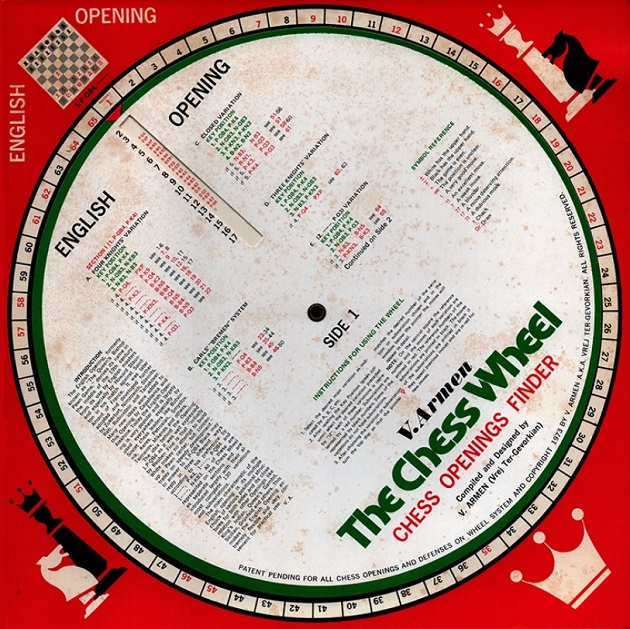
Edward Winter

A miscellany of older items from Chess Notes, together with some of our other writings (most notably from Kingpin).
C.N. 5 mentioned that opposite page 272 of P. Feenstra Kuiper’s Hundert Jahre Schachturniere there is a photograph of Emanuel Lasker on the beach up to his head in sand (Scheveningen in 1927).
In Nicolas Giffard’s La fabuleuse histoire des champions d'échecs (Paris, 1978) Fischer appears flaked out over a bench, recovering from an arduous jog, and Petrosian sits in shorts (and in colour) reading a newspaper in a haystack.
(6)
In the Giffard work referred to in C.N. 6 the third part is entitled ‘The Reign of Lasker’; it begins with the birth of Morphy.
Giffard is full of surprises, but the absence of any index is not one of them. The diagrams are bigger than anything you have seen apart from a tournament demonstration board and lend the book an air of high vulgarity. The text is not very informative and not very accurate. Anecdotes are employed as a space-filling substitute for facts. No writer reporting them will ever care for the accuracy of either facts or anecdotes. (Are we alone in feeling that the real disease of anecdotizing is based on the unpleasant assumption that the reader will not actually care if he is being spun a yarn?)
It is not easy to take seriously a work tracing the history of chess champions which sticks colour pictures of Polugayevsky and Petrosian in between the sections allegedly dealing with Pillsbury and Schlechter. Opposite a page concerning the epic Capablanca-Alekhine match of 1927 is a full-page colour portrait of the author’s friend and preface writer Aldo Haïk, the 1972 French champion. Mistakes abound, as usual especially in the early chapters. A treasure house of misconceptions.
(212)
‘Probably the strongest player who never won anything’ is how Heidenfeld describes Philipp Hirschfeld (1840-96) in Golombek’s The Encyclopedia of Chess (London, 1977). Hirschfeld never played in a tournament and either lost or drew all of his matches. Some idea of his skill, though, is given by this defeat of Adolf Anderssen:
Philipp Hirschfeld – Adolf Anderssen
Berlin, July 1860
Evans Gambit Accepted
1 e4 e5 2 Nf3 Nc6 3 Bc4 Bc5 4 b4 Bxb4 5 c3 Ba5 6 d4 exd4 7 O-O dxc3 8 Qb3 Qf6 9 e5 Qg6 10 Nxc3 Bxc3 11 Qxc3 Nge7 12 Ng5 Nd8 13 Be3 h6 14 Nh3 b6 15 Nf4 Qc6 16 Qb3 Ne6 17 Nxe6 fxe6 18 Rfd1 Qe4 19 Rd4 Qxe5 20 Rad1 Nf5
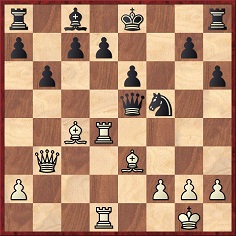
21 Bxe6 Nxd4 22 Bf7+ Kf8 23 Bxd4 Qf5 24 Bd5 c6 25 Qa3+ Ke8 26 Re1+ Kd8 27 Qe7+ Kc7 28 Be5+ Kb7 29 Bxc6+ Kxc6 30 Qd6+ Kb7 31 Qd5+ Ka6 32 Re4 b5 33 a4 Rb8 34 axb5+ Rxb5 35 Ra4+ Kb6 36 Qd6+ Resigns.
Just to repeat, Anderssen was Black.
Source: Adolf Anderssen by H. von Gottschall, page 190.
(3)
Michael Squires (Blackwell, England) wonders whether any of Anderssen’s victories in the encounter with Hirschfeld are extant. The standard collections give none. He also points out that Golombek’s book suggests that the ‘match’ took place in 1861, while other sources say 1860.
Granville Whatmough (Preston, England) quotes from Amenities and Background of Chess-Play by William Ewart Napier:
‘Philipp Hirschfeld, chief of the inveterately unsung, is now for the first time in our anthology fetched from that rich limbo which is the shame and byproduct of reckless hero worship. He was born about 1840, on the Baltic in Prussia. Dr Max Lange in 1859 selected this youth as co-editor of the Deutsche Schachzeitung. It was Hirschfeld’s great good fortune to gain distinction as an academician, a chess master and a magnate in commerce. He settled in London, where he became promoter and patron of the game which he had graced as a player.’
(114)
C.N. 3 (see page 28 of Chess Explorations) mentioned that in Golombek’s Encyclopedia Wolfgang Heidenfeld described Hirschfeld as ‘probably the strongest player who never won anything’. A discussion of the matter on pages 86-87 of the new Renette/Zavatarelli book (C.N. 10940) concludes that Heidenfeld’s suggestion is ‘likely refuted’.
(10944)
An endnote on page 257 of Chess Explorations in relation to C.N. 114:
Although there were games between Anderssen and Hirschfeld in the 1861 Deutsche Schachzeitung, they were dated 1860.
‘Briefly, in an endgame the solver is fighting against material odds; in a problem he is fighting against time.’ (D.J. Morgan, BCM, June 1963, page 182).
George Jelliss (Rugby, England) points out that the first paragraph of Chapter 1 of The Enjoyment of Chess Problems by Kenneth S. Howard (first edition Bell, 1943 and fourth edition Dover, 1967) ends with the sentence, ‘In an endgame the solver is fighting against material odds; in a problem he is fighting against time.
Mr Jelliss comments:
‘I doubt if this is the earliest occurrence of the saying. I also doubt if it is true. The threat of mate in either type of composition will always wonderfully concentrate the mind of the beleaguered party to respond decisively.’
(79 & 390)
Who was the strongest player ever to finish a tournament with no points? Our nomination is Tjeerd van Scheltinga, who scored a duck at Amsterdam, 1936. (1-2 Euwe, Fine 5 points; 3 Alekhine, 4½ points; 4-6 van den Bosch, Grünfeld, Landau 3½ points; 7 Kmoch 3 points; 8 van Scheltinga 0 points. In fairness to the Dutchman it must be said that the seven losses were all hard-fought. Alekhine, for example, required 79 moves to win.
(219)
Has any reader come to grips with the Russian language by means of A Chessplayer’s Guide to Russian by Hanon W. Russell (privately printed, 1972)? We were put off by Black’s P-QR3 being translated as algebraic ...a3 on page 3, to say nothing of the very first sentence: ‘A noun is a word that describes a person, place or thing.’ Sounds more like an adjective to us.
(230)
We composed the following little piece of play not as a study or problem but simply as a poser:

White to move
Find the fastest mating line.
(243)
As mentioned in C.N. 370, the composition is far easier to solve once it is revealed that there is a mate in four.
‘One of the quietest in the whole of chess history, both in this country and elsewhere’ is how P.W. Sergeant describes the year 1893 in his fact-packed book A Century of British Chess (page 219). It was indeed a year of a handful of minor matches and tournaments. No wonder the journalists of the day had so much time and space for the three p’s: poetry, polemics and pap.
(246)
From page 9 of the 10 December 1913 edition of the Brooklyn Daily Eagle:

Roy Turnbull Black – Mario Schroeder
Brooklyn Chess Club Championship, 9 December 1913
Centre Counter Game
1 e4 d5 2 exd5 Qxd5 3 Nc3 Qa5 4 Bc4 Nf6 5 d3 Bg4 6 Ne2 c6 7 O-O e6 8 Bd2 Qc7 9 f3 Bf5 10 Ng3 Bg6 11 f4 Bd6 12 Nce4 Bxe4 13 dxe4 Bc5+ 14 Kh1 Nbd7 15 Qe2 h5 16 b4 h4 17 Nf5 exf5 18 bxc5 Nxe4 19 Bc3 O-O-O 20 Bxg7 Rh7 21 Bd4

21...Ng3+ 22 hxg3 hxg3+ 23 Kg1 Rdh8 24 Bxh8 Qd8
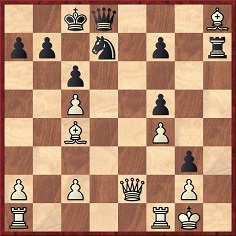
25 Bf6 Nxf6 26 Be6+ fxe6 27 Qxe6+ Nd7 28 Rfe1 Qh4 29 Kf1 Qg4 30 Kg1 Qh4 31 Kf1 Qh1+ 32 Ke2 Qxg2+ 33 Kd3 Rh2 34 Re2 Qf3+ 35 Re3 Qxf4 36 Rae1 g2 37 Qxd7+ Resigns.
C.N. 311 gave the game with notes from page 273 of The Year Book of Chess, 1914, which included remarks by Yates. He called 21...Ng3+ ‘An ingenious sacrifice, the effect of which, however, was almost impossible of calculation under a time limit, and for that reason it should not have been made.’
It is the kind of game for which a computer-check is particularly likely to offer surprises.
John Roycroft (London) raises the following interesting topic:
‘We, the serious chess world, could do with a kind of “third world” literature, independent of the disadvantages of Western journalism-cum-illiteracy and equally independent of the disadvantages of East European censorship-cum-controls. Western commentators tend to scoff at, say, USSR chess literature, because the latter's defects are obvious. But the commentators overlook the great values often (far from always!) to be found once the glaring defects (kow-towing to Marx and Lenin, avoidance of “censored” names, glorification of Soviet achievements) are eliminated. Let me take concrete cases. G.A. Nadareishvili has just had a new book “The Study Through the Eyes of Grandmasters" published in the USSR. I first heard of this project from him in 1976. He has worked on it, laboured on it, with incredible conscientiousness, for some six years. This is not unusual. Filipp S. Bondarenko has laboured for much longer to produce the first two volumes of a history of the endgame study. Against great odds (those imposed by the rulers of his own country) he has compiled a most worthy work that no-one has been commercially stupid enough to attempt in the West. But if we could combine the dedication of these authors with the access to libraries and freedom to travel that we take for granted in the West, what wonders would we not achieve. It would put C.N. out of business ... Over-generalizing dangerously, one might say that “we" have the research facilities and the freedom, “they" have the desire for scrupulous accuracy and the necessary level of chess skill. It makes one weep.’
(371)
Can there be a more slickly produced chess magazine than this organ of the United States Chess Federation? The production standards are excellent. As for the contents, polls apparently show that its readers prefer packaged feature articles to blanket coverage of chess news, with the result that tournament reports tend to be arbitrary and sketchy. But who is to say that this emphasis is necessarily wrong?
In any case, when a topical event captures the magazine’s imagination, the results are impressive. The reaction to Euwe’s death may not have been quick, but it led to an outstanding issue in April 1982, far the best tribute to appear in any magazine in the world, we suspect. Of the regular articles, ‘Ask the Masters’ is usually entertaining (a format that might be taken up with advantage by the British magazines), while the instructional features also maintain a good standard.
On the minus side, Chess Life’s attitude to the literature of the game is slovenly. Its catalogue loves everything (one loses count of the titles that are a must for every library ...) while the book reviews in the magazine itself are – one must be frank – frequently hideous. Before praising (rightly, but for the wrong reasons, if that is clear ...) A Picture History of Chess, the reviewer writes that ‘Mr Wilson’s idea (of compiling a picture history of chess) is pretty much of a sow’s ear’. Before stating his approval of The Chess Endgame Study another critic starts up: ‘I share with many practical players – and even one well-known grandmaster chess columnist – a distaste for the composed study/problem/endgame genre of chess.’ This disarming honesty is supposed to impress us, but a truly honest critic would have sent his review copy of the book to Pal Benko or somebody else properly qualified to make an intelligent assessment.
Worst of all is the reviewers’ pitiful quirk of ending their prose on a note of chummy illiteracy. Two examples:
‘Hey! Wanna see a two-mover?’ (Jim Marfia)
‘Anyone wanna help me write a chess book.’ (Jeffrey Kastner)
Neither sentence means anything. Chess Life, a good magazine, desperately needs to revise its choice of reviewers and, dare we say it, go rather more up-market.
(496)
The magazine went in the opposite direction, and especially during the period 1985-88. (C.N. 496 was written in 1983.)
On 17 February 2002 Dale Brandreth (Yorklyn, DE, USA) wrote to us:
‘As far as Evans and Parr are concerned, I think what it basically comes down to is that both have some sort of delusions that they know something of chess history, whereas in truth they both know very little. Thus the only real defense they have is scurrilous attacks on those who point out their absurd errors. Schiller belongs to the same slovenly group.
Nothing would surprise me about the USCF. Although I have known some good people in lesser positions there over the years, the people who have the power there are generally little better than guttersniping thieves out to enrich themselves at the expense of the USCF. Note their constant turnover. The publication has been a sorry rag for years and every time they start to improve it, some of their idiotic people ruin it again.’
R.F. Bradley (Donaghadee, Northern Ireland) sends the following from page 167 of the April 1935 BCM:
‘“Will there ever come a day” asks Clarence S. Howell, annotating a game beginning with 1 P-Q4 P-Q4 2 P-QB4, “when this absurdly dull opening is barred? The QP openings have taken all the romance out of chess. The nonsense of it all is that there are 13 ways to play against 1 P-Q4, all of which are good enough to draw. Against 1 P-K4 I do not know (and I believe no master knows) of a certain way to draw.”’
(663)
Three unusual finishes:
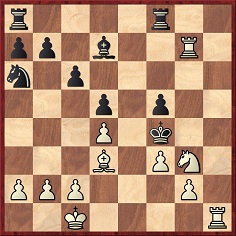
H. von Gottschall-C. Walbrodt, Kiel, 1 September 1893
White, to move, found the quickest conclusion: 26 Kd2, with three ways of mating on the following move.
Source: tournament book, pages 42-43.
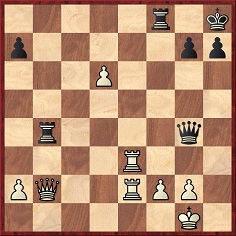
J.R. Capablanca-J. Grommer, New York, 2 July 1913
White exploited his opponent’s back-rank weakness by 39 Re8 Rf4 40 Qb8 Kg8 41 Qb3+ Kh8 42 Rxf8+ Rxf8 43 Qf7 Qc8 44 Qxf8+ Resigns.
Source: American Chess Bulletin, August 1913, page 171.
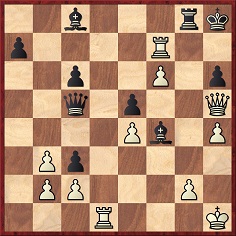
A. Brinckmann-R. Keller, Bad Oeynhausen, 18 July 1939
White administered the coup de grâce as follows: 27 Rd8 Rxd8 28 Rh7+ Resigns. It is mate in two. A rare double rook sacrifice.
Source: Lachaga tournament book, pages 38-39,
(CHESS, 1985)
In the third position there is a forced mate in six with both 27 Rd8 and 27 Rh7+.
C.N. 107 highly praised the weekly chess column by Gordon Pollard (Wallingford, England) in the Abingdon Herald (also referred to as the ‘Herald series’). Below is an example (column dated 17 August 1978) which he sent us:
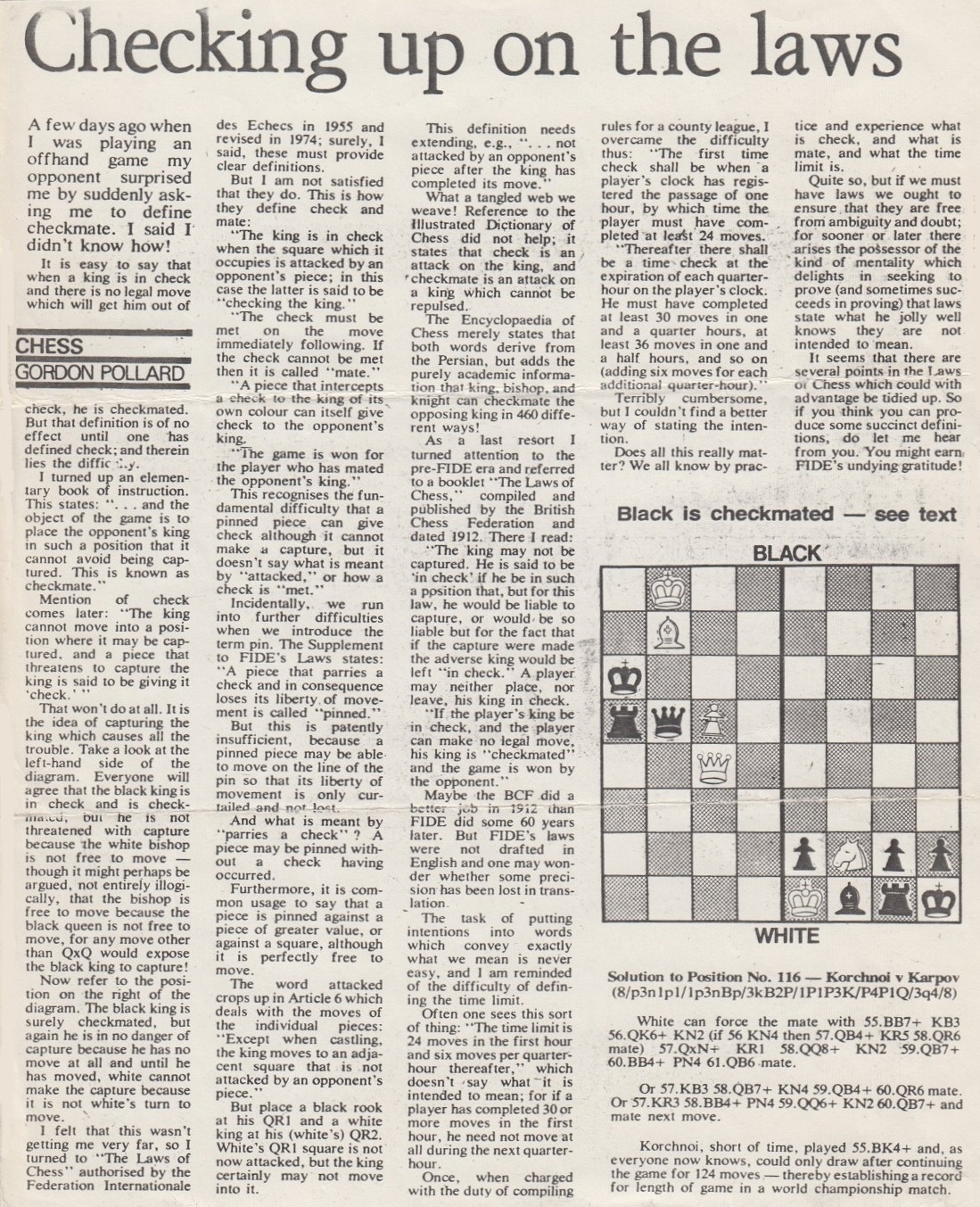
In C.N. 107 we wrote:
His chess column in the Abingdon Herald is truly outstanding, and the newspaper itself is to be congratulated on recognizing excellence and devoting to chess a very substantial amount of space.
A reader informs us:
‘You will be surprised to learn that in 1967 Fischer played in an Interzonal held in Sussex. I gleaned this from Idle Passion by Alexander Cockburn (page 178). Did they play the Bognor-Indian? On page 131 of the same work we are told of the “tournament circuit: run-down seaside towns in England, such as Bournemouth or Hastings”.
Idle Passion is indeed a curious book about – well, we are not altogether sure what it is about. A sentence we once noted down from it:
‘Lasker is interesting not so much on the pathobiographical level as on the sociocultural one.’ (Page 55)
It is made up of the kind of prose where it would appear that nouns, adjectives, verbs, etc. were all inserted separately by a different member of the committee, so it comes as a surprise to learn that Alexander Cockburn was single-handedly responsible for all parts of speech. In fact, it turns out to be one of those unlikeable books in which a writer slaps between two covers everything he thinks he knows about chess plus a little bit lifted from the local public library and then tries to give the whole a special, spurious slant – in this case presumably psychoanalysis. The trouble is that Mr Cockburn simply does not know enough about chess to write anything worthwhile; it is bad enough to wade through endless factual inaccuracies, but it is infuriating to find these mistakes then used as the basis of character analysis. On page 61 we read that Capablanca ‘rarely played outside tournaments and matches’. Quite untrue, naturally, since the Cuban was one of the most active players of simultaneous games. But too late. Deep-seated reasons for Capa’s ‘laziness’ are already under Mr Cockburn’s penetrating microscope. Thinking of Reuben Fine’s efforts in this field, we are impelled to ask why it is that writers on chess psychology always get their facts topsy-turvy. Now there’s a real question for the analyst.
Following publication of a position involving Leonard Walls in C.N. 207 (see also C.N. 5328), Paul Timson (Whalley, England) contributed the following, in C.N. 359:

The Poole v Lewis game: 1 Nf3 d5 2 g3 Nf6 3 Bg2 c5 4 d4 Nc6 5 O-O Bf5 6 dxc5 e6 7 c4 Bxc5 8 cxd5 Nxd5 9 Qb3 Qe7 10 Nc3 Nxc3 11 Qxc3 O-O 12 Bg5 f6 13 Be3 Bb4 14 Qc4 Rac8 15 a3 Bd6 16 Rac1 Qf7 17 Nd4 Nxd4 18 Qxd4 Be5 19 Qxa7 Bxb2 20 Rxc8 Rxc8 21 Bxb7 Rd8 22 Qb6 Rb8 23 Qxb2 Rxb7 24 Qd2 Rd7 25 Qc3 Rc7 26 Qb4 Rb7 27 Qa5 Qd7 28 Rc1 Bh3 29 Qd2 Qa4 30 Qd6 Rd7 31 Rc8+ Kf7 32 Qf8+ Kg6 33 Qe8+ Kf5 34 Qh5+ g5 35 Qxh3+ g4 36 Qh5+ Resigns.
A notable remark by Walls at move 26:
‘As every chess player knows, the kind of play which is in the lower strata is [sic] designated as “Mucking Abart” becomes “Manoeuvring for position” as the Master Class is approached.’


As mentioned in Chess and Poetry, precise sources for the Walls material contributed by Paul Timson are sought, i.e. beyond the fact that the obituary was published in the Middlesex Chessletter.
A letter from Tony Gillam (Nottingham, England) starts:
‘I very nearly wrote to you concerning items in one of last year’s Chess Notes, in particular the strange, primitive comments about book prices. It is best not to comment upon things you know little about. By all means write about it from the consumer’s point of view but assume that the publisher knows his work best.’
Since this magazine has never discussed the subject of book prices we assume that our correspondent will re-direct his remarks as appropriate.
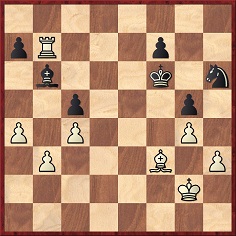
D. Benedek (blindfold)-A. Schweiger, Pécska, 1 January 1905
The game continued: 35 b4 cxb4 36 Rxb6+ axb6 37 c5 bxc5 38 a5, etc.
Source (position only): Wiener Schachzeitung, November-December 1906, page 398.
(353)
On page 24 of Larry Evans’ The Chess Beat Al Horowitz is quoted:
‘Chess is a great game. No matter how good one is, there is always somebody better. No matter how bad one is, there is always somebody worse.’
What other game can match that?
(402)
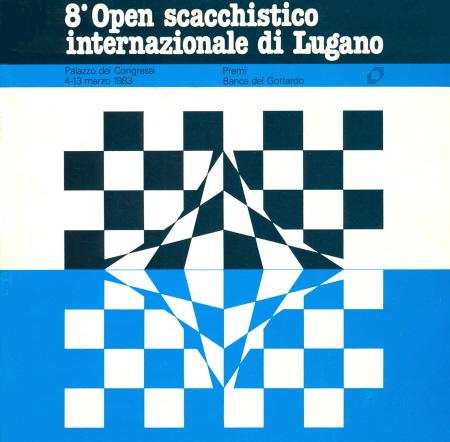
Switzerland being a notoriously small country, we decided to nip along to the Lugano Open tournament.
By train it turned out to be a six-hour nip, but the journey was well worth it. The eventual winner, Seirawan, impressed by his cool approach, quite apart from the fact that he was one of the few masters whose clothes did not appear to have been put on with a hay-fork. Gheorghiu still has a total aversion to sitting down; he has the air of a Mediterranean barber who has decided there must be more to life than haircuts. Hort squares up to the chess board in the manner of a wicket-keeper, often seeming to rest his chin on d1 (especially if he is White ...). One noted too, without being able to conjure up a satisfying psychological or sociological explanation, that pipe and cigar smokers are to be found only amongst the lower ranks, in the secondary tournament. With the masters it is cigarettes or nothing. Spectators were generally few in number – almost everyone was playing – but amongst those jostling for position behind the railings were a goodly number of dogs and babies (to the extent that either has the habit of jostling). The whole congress was played out in a relaxed, liberal atmosphere.
Of course, it is generally the little things that remain in the mind after such an event. Lugano must be one of the most beautiful places in Europe; the tournament was tenaciously fought out, making it an irresistible combination for the casual visitor.
(439)
So far, most Edition Olms reprints have been of German-language works, a notable and most welcome exception being The Sixth American Chess Congress New York 1889 by W. Steinitz. An exceedingly rare work, Steinitz annotates in it all 432 (!) games played, and the result is a beautiful volume.
Out of the 20 competitors in this double-round tourney, one almost unknown figure fascinated us: MacLeod. As noted on page 50 of Chernev’s Wonders and Curiosities of Chess MacLeod holds to this day the unenviable record of the most games lost in a single tournament – 31. However, as the Preface to this reprint says, MacLeod was only 16 at the time. (Gaige confirms this in his Catalog with a reference that N.W. MacLeod was born in 1872. Afterword: see, however, C.N. 479 below.) And yet we note in Sunnucks’ Encyclopaedia, under the heading ‘Canada’ that N.W. MacLeod had already been champion of that country in 1886 and 1888. Clearly he was quite a prodigy, despite those 31 losses, but what became of him after 1889? It is eerie to think that, theoretically, he could still be alive today ...
At New York he did himself a grave disservice by his choice of openings (1 e4 e5 2 c3, for example, with embarrassing regularity as White). Nevertheless, of his six wins several were of high quality. In the first round [i.e. first cycle] he defeated D.M. Martínez in what Steinitz called ‘a remarkably fine game’; in the second his victory over Gossip received the following praise from the world champion: ‘The ending after queening his pawn is played with surprising ingenuity by the youthful competitor. It was given as a study in various chess columns, and it quite deserved the distinction.’ Later in the tournament MacLeod also took the scalp of Blackburne, after fending off a perilous Danish Gambit attack.
The only reference we have to hand of MacLeod after this date is an extraordinary defeat of Emanuel Lasker in a simultaneous exhibition in Quebec in 1892. Extraordinary, because it must surely be the only game Lasker ever played in which he struggled on in vain when two queens down. (See page 45 of the third Chess Player collection of Lasker’s games.)
(441)
Below is a potted biography of Nicholas Menelaus MacLeod which Jeremy Gaige (Philadelphia, PA, USA) sent us later in 1983 (C.N. 479):

See also Emanuel Lasker Miscellanea.
One of the most spectacular moves of Berlin, 1897 was played, against Marco, by the obscure player Johannes Metger, in the 17th round on 1 October. Because the game ended in a draw (after 62 moves) and no doubt because Metger was little-known, Black’s ingenious 15th move has never received the attention it deserves.
(White: Marco) 1 e4 e5 2 Nf3 Nc6 3 Bb5 Nf6 4 O-O Nxe4 5 d4 Be7 6 Re1 Nd6 7 Ba4 e4 8 Ne5 O-O 9 Nc3 Nf5 10 Nxc6 dxc6 11 d5 cxd5 12 Qxd5 Nd6 13 Nxe4 Be6 14 Qh5 Nxe4 15 Rxe4

... and now Metger found the terrific move 15...Bg4. Of course, the bishop is untouchable either way (16 Rxg4 Qd1 mate or 18 Qxg4 f5); White played 16 Qa5.
(453)
On 23 March 1983 Antenne 2, the second French television channel, transmitted a truly fine film on chess, Moeurs en direct: jouer sa vie by Gilles Carle and Camille Coudari, a production of the Office National du Film du Canada and Radio-Canada.
A subtle, artistic treatment of the game, this film included much interview material (not all specially shot) involving Karpov, Fischer, Euwe (one sentence), Fine, Timman, Ljubojević, etc. Karpov spoke in a way suggesting that he had been away at a rehearsal camp for the previous three weeks; the Fischer of the late 1960s and early 1970s scowled and snapped suspiciously when trapped by a reporter and – of course – gave little away in his replies, but at least they were an improvization. Reuben Fine has an endearing habit of chuckling in mid-sentence as he contemplates the bons mots he intends to deliver; in the end, however, all one catches is the chuckle. Arrabal’s contribution was quite simply unwatchable. By contrast, the researcher, Camille Coudari, proved himself a natural performer, many of his extemporaneous observations being remarkably acute.
The programme was graced with much archive material of the old-timers and, whilst full of imaginative visual effects, did not shirk the technical aspects of the game. Coudari’s exposé of hypermodernism was excellent. Keep an eye open for this film; it is thoroughly enjoyable.
Addition on 1 August 2010: Jean-Pierre Rhéaume (Montreal, Canada) comments that Moeurs en direct was merely the name of the French television programme/series and was not part of the title of the film itself (Jouer sa vie).
Addition on 11 November 2018: C.N. 11091 pointed out that the film can be viewed on-line under its English title, The Great Chess Movie.
The book catalogues prepared by Dale Brandreth are of enthralling interest, crammed as they are with acute observations on the titles listed. For example:
‘The Chess Wheel, V. Armen, English Opening. Similar to the circular slide rule. 65 variations. More a novelty than anything else. Rather humorous in that the author has boldly printed on the device that “patent pending for all chess openings and defenses on the wheel system”. What sublime effrontery and ignorance. Did he invent all these lines? No, of course not. Yet he has the gall to try to patent them. The chess world does not lack its buffoons either.’
(472)
Paul Calhoun (West Hartford, CT, USA) writes that the criticism is unfair, and he has sent us a PDF file which presents The Chess Wheel and includes commendations.

(12111)
An ultra-sharp attack from a match between Romania and Latvia:
Ion Gudju – Karl Karlovich Behting
Paris, 1924
Greco Counter-Gambit
1 e4 e5 2 Nf3 f5 3 Bc4 fxe4 4 Nxe5 Qg5 5 Nf7 Qxg2 6 Rf1 d5 7 Bxd5 Nf6 8 Nxh8 Bh3 9 Bc4 Nc6 10 c3 Ne5 11 d4 O-O-O 12 Be2 Nf3+ 13 Bxf3 Qxf1+ 13 Kd2 Qxf2+ 14 Be2 e3+ 16 Kc2 Bf5+ 17 Kb3 Be6+ 18 c4 Bc5 19 d5

19...Nxd5 20 Bg4 Nf4 21 Bxe6+ Nxe6 22 Qg4 Qf6 23 Nc3 Kb8 24 Ne4 Qd4 25 a3 Qd3+ 26 Ka2 Qxc4+ 27 b3 Rd2+ 28 Bb2 Rxb2+ 29 Kxb2 Bd4+ 30 Kb1 Qxb3+ 31 Kc1 Bb2+ 32 Kb1 Bxa3 mate.
Source: Primera Olimpíada de Ajedrez, page 113.
(CHESS, 1985)
‘Fred Lazard (1883-1949) [sic] the most all-around chessmaster of his time ...’
Source: page 119 of Dictionary of Modern Chess by Byrne J. Horton (New York, 1959)
(512)
Another indispensable entry in Horton’s Dictionary of Modern Chess:
‘HIPPOPHOBIA: A term sometimes applied to chessplayers who dread the presence of knights on the chessboard ... Chessplayers who are afflicted with hippophobia are known to take great risks so as to eliminate their opponents’ knights.’
Horton names no names.
We also like the entry ‘MIDSUMMER MADNESS’: ‘An expression used by the editor of The Field when he referred to Steinitz’s 20th move (20...P-KN4) as “midsummer madness”. No further explanatory comment was given. The game was played between Blackburne and Steinitz in a Vienna tournament.’
It is hard to know what to make of this drivel. But of course the whole affair is devoid of importance, ‘midsummer madness’ being no more worth knowing than ‘hippophobia’.
If our thinking is not too tortuous, Horton makes Sunnucks look like Murray.
(530)
The April 1983 Chess Life (pages 12-13) contains an interview with the former world champion Boris Spassky which concludes with the following, perhaps surprising, quote:
‘Personally, I think the best chessplayer of all time was Capablanca – especially because he was very lazy, and I am lazy too. So I can understand him very easily. But he was a real genius.’
Leaving aside the doubtful logic of this, we imagine nonetheless that Spassky feels duty bound to make such jaunty remarks; if nothing else, it makes good copy for journalists, and such remarks can be truly informative.
This led us to reflect what a shame it is that the great masters of the past gave infrequent interviews and scarcely any press conferences. How one would have loved the chance to interrogate Morphy. Nowadays Karpov gives almost as many interviews as he plays games, and has learned to perfection the requisite skills. The Edmondson book mentioned in C.N. 509 [Chess Scandals] gives a three-page transcript of a press conference in Baguio City. To the assembled newshounds Karpov showed himself to be charming, unassuming, discreet, reasonable and diplomatic in best Sebastian Coe fashion. None of the above adjectives is particularly appropriate for Korchnoi, who acts more like a human being, relishing his new-found freedom of speech.
(540)
Michael McDowell (Newtownards, Northern Ireland) reminds us of the following from the introduction to the 22nd round in the New York, 1924 book (presumably written by Helms):
‘And so Alekhine remained undisputed third with a score that would have made him the winner of the tournament, barring the presence of Dr Lasker and Capablanca!’
There’s no arguing with that.
(546)
Another example of this theme, from page 4 of The Monte Carlo Tournament of 1903 by Emil Kemény (1860-1925), which has been reprinted by Edition Olms:
‘Had Dr Tarrasch scored 1½ points less – as could have been very readily the case – Maróczy would have won the first prize, and the victory would have been considered a fairly decisive one ...’
(623)
From Albrecht Buschke (New York, NY, USA):
‘A beautiful reprint of the Karlsbad 1929 tournament book was published a few years ago, long before the Olms edition, by Dale A. Brandreth. To avoid such unnecessary duplications of “reprints” there should be a clearing house for reprint publishers. Lasker’s Common Sense in Chess (since not copyrighted) was reprinted again and again by one obscure publisher after the other, one adding misprints to the misprints of his predecessors until, finally, almost simultaneously, Tartan books (McKay) and Dover published so-called reprints – Tartan with all the mistakes accumulated by previous pirate reprinters, Dover in the bowdlerized version by Fred Reinfeld.’
(590)
An invitation to heresy: are there any famous games that readers consider grossly over-rated? Personally – and it is hard to get more heretical than this – we have never been much taken with the Réti-Bogoljubow brilliancy-prize game at New York, 1924.
(614)
Are we alone in being surprised at the brilliancy-prize award to Polugayevsky against Torre in the recent [1984] London Phillips and Drew tournament? Was there much more to it than routine crash-bang?
(810)
From the Summer 1955 Chess Reader, in which Ken Whyld reviewed Tartakower and du Mont’s 100 Master Games of Modern Chess:
‘It is curious to see once more the game Golombek-Brown, in which White wins by means of a neat but obvious piece sacrifice. From the excessive number of times it has been published, future generations must think it highly esteemed in our day.’
(1338)
From an article ‘Chess in Fiction’ by Stewart Reuben in the October [1984] CHESS:
‘Auto da Fé by Elias Canetti, the 1981 Nobel Prize Winner for Literature, is a real curiosity. One of the main characters is called Fischer. He dreams of being World Chess Champion, buying new suits from the best tailors and building a giant palace with real castles, knights and pawns. So what?, I hear you ask. The book was written in 1935 long before Bobby Fischer was even born! It may be possible to reduce the coincidence slightly. It is true Fischer was extremely concerned about his clothes at one stage of his career. But he always denied that he said much of what Allen Ginsberg [sic – Ralph Ginzburg] reported in his interview with Fischer. Perhaps Ginsberg [sic] knew of Auto da Fé and fooled the world. Still, an extraordinary coincidence.’
(621)
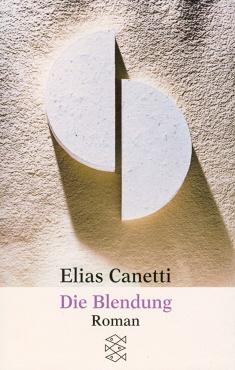
The chessplaying Fischerle/Fischer coincidence in Elias Canetti’s 1935 novel Die Blendung (published in English in the 1940s under the titles Auto-da-Fé and The Tower of Babel) is too well known to be discussed here, but when and by whom was the coincidence first pointed out, and did Canetti ever comment on it?
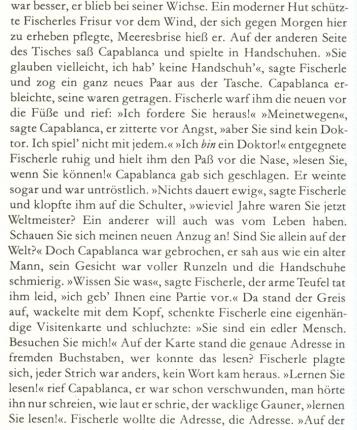
Above is an excerpt from page 380 of the 2005 Fischer Taschenbuch Verlag edition, while the passage below comes from page 200 of Auto-da-Fé:

(5507)
1 e4 e5 2 Nf3 Nc6 3 Bc4 Bc5 4 c3 Nf6 5 O-O Nxe4 6 Bd5 Nxf2 7 Rxf2 Bxf2+ 8 Kxf2 Ne7 9 Qb3 O-O 10 Be4 d5 11 Bc2 e4 12 Ne1 Ng6 13 c4 d4 14 Qg3 f5 15 Kg1 c5 (The ‘perfect’ centre.)
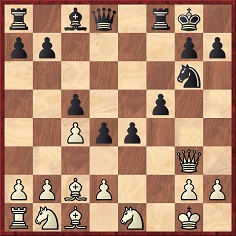
16 d3 f4 17 Qf2 e3 18 Qf3 Qh4 19 Qd5+ Kh8 20 Nf3 Qf2+ 21 Kh1 Nh4 22 Qg5 Bh3 23 White resigns.
Source: tournament book, pages 254-255.
(684)
‘Who was the greatest player ever?’ was a question Joseph Platz once (1963) asked Gligorić. The answer was Morphy (Chess Memoirs by Platz, page 133).
From the book we take this game:
Joseph Platz – L. Noderer
Hartford, 1966
French Defence
1 e4 e6 2 d4 d5 3 Nd2 c5 4 exd5 exd5 5 Ngf3 c4 6 c3 Nf6 7 Be2 Bd6 8 O-O Qc7 9 b3 cxb3 10 Qxb3 O-O 11 c4 dxc4 12 Nxc4 Be6 13 Qd3 Bxc4 14 Qxc4 Nc6 15 Be3 Ng4 16 d5 Bxh2+ 17 Kh1 Nxe3 18 fxe3 Na5 19 Qa4 Bd6 20 Bd3 b6 21 Bxh7+ Kxh7 22 Qh4+ Kg8 23 Ng5 Qc2 24 e4 Resigns.
(690)
Rule XII from the New York, 1889 tournament book:
‘... Consultation and analyzing moves on a chess board during the adjournments are strictly prohibited, and any competitor proved guilty of the same shall be expelled from the tournament by a three-fourths vote of the Jury.’
(705)
Adriano Chicco (Genoa, Italy) sends a game from pages 216-217 of the Revista Scacchistica Italiana, August 1901. Girolamo Tassinari’s play is typically sharp and rather ahead of its time (exploitation of the opponent’s weaknesses) and, indeed, the annotator remarks that the game seems as if it were played yesterday.
Girolamo Tassinari – Arnous de Rivière
Paris (Café de la Régence), 3 September 1853
Giuoco Piano
1 e4 e5 2 Bc4 Bc5 3 Nf3 Nc6 4 c3 Nf6 5 O-O d6 6 d4 exd4 7 cxd4 Bb6 8 Nc3 O-O 9 h3 Ne7 10 Bg5 c6 11 e5 Ne8 12 d5 dxe5 13 Nxe5 Nd6 14 dxc6 Nxc4 15 Nxc4 (Position rather than material.) 15...Qxd1 16 Raxd1 Nxc6 17 Nxb6 axb6 18 a3 Be6 19 Be3 Bc4 20 Rfe1 b5 21 Ne4 Bb3 22 Rd7 Na5 23 Nd6 Bd5 24 Bc5 Rfb8 25 Bb6 Nc4 26 Nxc4 Bxc4 27 Ree7 (Nimzowitsch’s seventh rank.) Ra6 28 Rxb7 Kf8 29 Bc5 Rxb7 30 Re6+ Resigns.
(712)
Europe Echecs (April 1984) reports the death of François Le Lionnais on 13 March. Even if his Dictionnaire des échecs – much praised – was in our view a disappointing work, Le Lionnais stands out as one of the most stylish French chess writers ever. What a pity, though, that the French language has contributed so little of any worth to the literature of the game.
(724)
We thank J.J. Walsh (Dublin) for sending a collection of curiosities, quotes, quizzes, etc. that he has assembled. Our favourite item was a six-page spread of aphorisms and general observations on the game. For example:
‘Rook endings a pawn up are generally drawn – but rook endings a pawn down are usually lost.’
‘The most attractive combinations are usually just one tempo short of being sound.’
‘The popular press believes that chess congresses are composed exclusively of child prodigies and octogenarians.’
‘Players indicate an increasing maturity at the game by not automatically making the en passant capture.’
‘Players with the greatest theoretical opening knowledge are most likely to get into time-trouble.’
‘The weakest players in a tournament are generally first to enquire about the prizes.’
‘Annotations attempt to prove that a game had only one logical sequence.’
Mr Walsh also repeats the old story about Capablanca having the tournament hall cleared of spectators before resigning to Marshall at Havana, 1913. But is there any more truth to it than there is in the old yarn about Alekhine ‘smashing up his hotel furniture’ at Carlsbad, 1923?!
Another item about the same two masters requires slight amendment. We read:
‘Capablanca and Alekhine, two outstanding world champions and contemporaries, had curiously similar careers. Each was born during the month of November – Capablanca 1888 and Alekhine 1892 – and both died at the same age, 53 years, also in the same month, March – Capablanca in 1942, Alekhine 1946.
A further coincidence was the fact that four years after Capablanca’s birth in Havana a world championship match Chigorin v Steinitz was held in that city, while four years after Alekhine’s birth in Moscow, Lasker played a world title match with Steinitz there.’
All perfectly true, except the point that Alekhine was not born in November. (Correct date 19 October (old style), 31 October (new style).) We suspect that the source of Mr Walsh’s misinformation was an article in the July 1976 CHESS (page 316) by a notoriously undependable old hack.
(775)
The first quotation in C.N. 775 serves as a reminder of the following from Seirawan by Vincent McCambridge (Players Press), page 47:
‘Korchnoi is renowned as the world’s best endgame player – Yasser once told me that, in blitz, Korchnoi wins all endgames equal or slightly inferior for him. “With a huge endgame edge”, said Yasser, “I can generally draw him!”’
A methodically annotated collection of the American’s games, Y.S. being described by the author as the most exciting chess figure since Fischer. US chess figure may or may not have been meant. The notes are objective (Seirawan is not portrayed as an unerring genius effortlessly disposing of morons), which only adds to the mystery of why McCambridge gives a single Seirawan loss – to himself. The game is not even well annotated.
(816)
From the 1935 BCM, page 364, a review of Reinfeld’s book on Cambridge Springs, 1904:
‘It is a curious fact that the particular move of the Queen’s Gambit Declined, which has earned for it the name of the Cambridge Springs Variation, has so as far as we can see no reference as such in this book.’
See also page 192 of the May 1984 issue of the same journal.
(779)
The BCM quote in C.N. 779 must be based on a series of complete oversights. Parley Long (Cambridge, OH, USA) sends photocopies from Reinfeld’s book of Cambridge Springs, 1904. 6...Qa5 was played several times.
(794)
‘Pressure on space is cruel’, writes the diplomatic magazine editor when declining to publish a would-be contributor’s precious prose. Cruelty is at its peak if the offering is mere peripheral matter, i.e. not hard chess news. It is considered self-evident that subscribers to a general chess magazine will, above all else, want to know what is going on now.
How true this is may be open to doubt. And what in any case is ‘chess news’? Tournament and match results? If so, down as far as which level? National championships, county ... state ...? Of course the editor is caught either way. Either he will be accused of skimpy news coverage or else of heavy-handed blanket treatment. Should he be writing just for present-day readers, or trying to produce a journal of permanent record?
In general there is probably far too much emphasis on minor players, especially from the magazine’s own country, at the expense of the really top players, as used to be the case. As previously noted in this magazine, our ignorance about the careers of the real ‘greats’ of today is deep indeed.
Editors will doubtless reply that the days are gone when they could consecrate three or four pages to the retelling of every dull detail of the life of some particularly philanthropic, if non-chessplaying, patron of the game. Nonetheless, space is not always well used. One growing trend we perceive is the interminable personal report on a tournament by a participant, by dint of which what would have been a couple of columns is suddenly transformed into several pages.
If well done, the personal report is fascinating and even indispensable, but there are grave dangers not only of distorting the amount of space left over for other events but even of distorting the ‘main event’ itself. Paris, 1983 was a major success for Jim Plaskett, but you would hardly guess as much from Tim Harding’s report in the July 1983 CHESS. He made himself the star. And pity poor Sax, who scored a tremendous triumph at Lugano, 1984; John Nunn’s report in the May 1984 BCM (four pages) barely mentioned him.
But news is not just results. Deaths of major figures are often passed over with degrading brevity, and it is not simply a matter of information not being available. Europe Echecs rarely has obituaries, although François Le Lionnais was accorded eight large pages. CHESS seldom gives more than a line or two, and sometimes, as in the case of Wolfgang Heidenfeld, not even that. To be noticed by Chess Life one must be either American or a world champion.
We have mentioned previously the way new books, events and trends in the publishing industry etc., are given scant attention, the BCM being (as with obituaries) an honourable exception. But are not deaths and books just as much news as minor tournament results?
These random thoughts, which readers are free to contradict in future issues of C.N., may be seen in the context of a new magazine which, though so far only at issue zero (i.e. the ‘free introduction’ issue), shows considerable promise.
New in Chess goes some way towards our ideal of a truly international magazine (or, as the introduction puts it: ‘We do hope to fulfil a need, felt by many inhabitants of the chess world for a truly international medium, that passes the borders, so often visible in the rest of the world’). It does, nevertheless, have a certain Anglo-Dutch bias (the magazine appears in English and Dutch language versions) which might suitably be reduced even further. Although introductory issues are liable to be misleading, the start is promising indeed, despite the absence of book reviews, obituaries, features on specific phases of the game, endgame studies, problems, etc.
There is a risk that New in Chess, like Brady’s Chessworld, will prove too luxuriously produced to keep going; not only is plushness expensive, but it normally means a lengthy printing process which costs the journal a certain topicality and freshness.
The only serious fault in New in Chess is its standard of English and proof-reading. A note by Korchnoi after 1 e4 reads: ‘I have spent about ten minutes in thought here. My partner works a lot into chess to counter all modern variations. He was certainly prepared to everything, I used to play in the past: Open Spanish, Sicilian, French ...’ (page 10). An article by Wim Andriessen has dates incorrectly printed. And how about the following jewel in a report on the Reykjavik Open: ‘When Reshevsky received his prize he got a scanding applause with kept on for minutes’. Sic, sic, sic.
The highlight of issue zero is a most extraordinary interview with Botvinnik. Our eye homed in on a quote, ‘Capablanca was a genius, the greatest genius in the whole history of chess’, and we at once felt well-disposed to the former world champion, ‘Mr Soviet Chess’. But the rest of the material makes Botvinnik a difficult man to like, the interview being a supreme example of high bitchery.
Karpov is ‘an exploiter of other people’s ideas. His ability to use these ideas is not at issue, but he himself is about as fertile as a woman who has been sterilized’. Portisch and Polugayevsky ‘have no talent for real research’. Balashov ‘is dull-witted. When he comes into unknown territory he is as defenseless as a kitten’. Karpov ’cannot just force Roshal, who writes all his books for him, to develop a new chess idea for him’. Kasparov’s games ‘are the only ones I still play over’. I hardly talk to the grandmasters here anymore. Nor to the Chess Federation of the USSR’.
The magazine quotes Spassky’s reaction: ‘It is typical of Botvinnik, that he wants to destroy chess, after giving up his own career as an active chess player.’
Certainly Botvinnik adopts a most surprising anti-Soviet stance, and even makes a point of mentioning the dreaded Korchnoi: ‘Of the top chess players of the moment I would like to mention two names: Korchnoi and Kasparov.’ He even permits himself an analysis of Karpov’s divorce: ‘It was not a real divorce. She just left him. When two people are not in love they separate automatically.’
Up until a few years ago Botvinnik was a dull case for historians, psychologists, etc., but his recent writings and interviews reveal an unknown, or neglected, side of his character. The interview is an amazing document, and a memorable scoop for New in Chess. News indeed.
(825)
See too C.N. 8192.
George H. Hudd (South Croydon, England) informs us that a recent biography of Arthur Ransome claims that he played chess with Lenin. Our correspondent goes on to ask who is or was the best player among Heads of State.
(833)
The title above is, perhaps, rather misleading since we are not concerned here with the value of chess history per se, but rather with the practical question of what it has to offer to the average player, the mass of ordinary chess enthusiasts. And ‘history’ we are going to interpret in its loosest sense. Although purists might be shocked by such a pragmatic approach, it has to be recognized that no-one has a duty to be impassioned by the game’s heritage. What, then, does a study of the past offer the average congress entrant? We are almost tempted to suggest more than a study of the present.
It is illogical of a budding 1984 amateur to believe that he should study exclusively, or even principally, the great masters of 1984. Why Karpov more than Botvinnik? And why Botvinnik more than Lasker? Indeed, if one is going to concentrate on a particular champion, why not pick one whose complete career can be studied?
There are probably three main reasons why chess ‘fans’ are reluctant to look back into even the most recent past. The first is a matter of simple actuality, of being interested in hot news. Nothing could be more natural – not that it is a taste we particularly share personally – but it is far from clear that what is interesting for its topicality is also the best practical means of improving one’s game. What will offer more to the student: the bulletin of the 1984 National Championship or the tournament book of New York, 1924?
The second reason is a feeling that because chess is more popular today, the standard of the best players will also be better. Here too illogicality reigns. As previously discussed in Chess Notes, the quality of play of the top few bears no relation to how popular the game is, or how well people play it, at the bottom end. An analogy with music clarifies the point: there has been a vast ‘democratization’ of music with opportunities for the young that were undreamed of by previous generations. Yet another Mozart has never been produced, even though he has been there for two centuries for everybody to learn from.
Let us imagine, however, that one rejects the view of Botvinnik that Capablanca was the ‘greatest ever’ and believes ‘the moderns’ to be better. Would even that be any justification for neglecting the patrimony? What a mighty conceit on the part of a modestly graded player to assume himself capable of learning more from Karpov than from Capablanca because of the former’s ‘discernible’ superiority.
The third reason – and here we hope readers will not groan – is the current misguided obsession with opening theory. As Leonard Barden wrote in the Financial Times of 4 August 1984, 'some theoretical books convey the impression that serious analysis only began with the launch of Chess Informant in the 1960s’. Study the moderns – and not necessarily even the best of them – and your play will soar as you instantly grasp the intricacies of the openings; study Steinitz and you waste your time on nonsense such as 3...d6 in the López, which no-one has seen for decades.
Here also is a foolish conceit; the notion that opening innovations (perhaps at move 15 or 20) by (we choose a name at random) Walter Browne have the remotest relevance to the games of the regular club player. Might it not be better to study 3...d6 after all and catch your opponent unawares? By concentrating on modern games for the sake of opening theory one misses out on the problem-solving intellectual exercise that chess is supposed to constitute, and which is intended to bring pleasure. The opening is, or ought to be, too interesting to be skipped.
Far from seeing the past as a desert, we would point out an important, if obvious, reason why it might be viewed as even more important for study than the present: there is more of it – perhaps a century and a half of the richest terrain. And not only the games, but also the grand literary productions. Alekhine’s writing was of such quality that it is almost unbelievable that he does not merit automatic pride of place on players’ bookshelves. A good question for club night: ‘Hands up those who have read Steinitz? Or Tarrasch ...’ But then, neither will be much help on the latest Sicilian wrinkles.
(834)
Michael McDowell (Westcliff-on-sea, England) offers the following four-non-mover composed by A. Rautanen, 30 Shakkiprobleemaa, 1929:
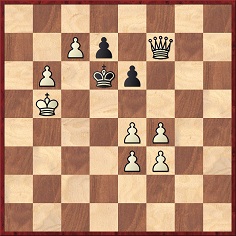
White mates without moving
The composition was quoted in a lecture entitled ‘One good turn ....’
(865)
The solution is given at the end of this Chess Jottings article.
We always welcome readership reaction, even if – especially since – much of it is contradictory. C.N. has been called ‘over-serious’ and ‘the funniest chess magazine I’ve ever read’ (!). We are still reeling from a single postal delivery that brought letters informing us that we were a) ‘incredibly naive’ and b) ‘a cynical expletive deleted’. Too many/not enough games/problems are other remarks difficult to reconcile. The ‘Batsford business’, our fil rouge over what seem like decades, has drawn forth a variety of reactions. Most readers have professed themselves in agreement with our views, some even being ‘gripped by the saga’. The May 1984 Chess Life, however, praised C.N. ‘lengthy vendettas with publishers notwithstanding’. The notion that it might be worthwhile for a journal with no book-selling ties to scrutinize chess publishers’ activities was not considered.
(871)
The view of Martin Amis, in The Observer, 23 December 1984:
‘Of course one shouldn’t forget that the game of chess, for all its radiance, artistry and deep fascination, is essentially a trivial pursuit. It is without content. Thus the “history” of chess is of no more intrinsic interest than the history of punting or thumb-twiddling or nose-picking. But it does have a history, and so books about it will continue to appear. The subject already has the peaceful glow of scholastic futility. One of the great things about chess is its refusal, not its readiness, to serve as a paradigm for anything else, as Freudians, Marxists et al. have frustratingly found. Chess is what it is and not another thing, it is only a game.’
(902)
Despite Nimzowitsch’s well-known dislike of tobacco, page 87 of Visiting Mrs Nabokov by Martin Amis (London, 1993) affirmed that ‘Nimzowitsch used to smoke an especially noxious cigar’.
We have now found a much older and more extensive version of the alleged Nimzowitsch observation discussed in C.N.s 3197 and 3200. From pages xiv-xv of Chess Openings by James Mason (London, 1897):
‘A threat or menace of exchange, or of occupation of some important point, is often far more effective than its actual execution. For example, in the Ruy López impending BxKt causes the defender much uneasiness. He is, to some extent, obliged to confound the possible with the probable; while yet at the same time in serious doubt as to what may really happen.
Consequently, when you are attacking a piece or pawn that will keep; when you cannot be prevented from occupying some point of vantage, from which your adversary may be anxious to dislodge you; when you can check now or later, with at least equal effect; in these and all such circumstances – be cautious. Do not play a good move too soon. For when you do play it, the worst of it becomes known to your antagonist, who, then free from all doubt or apprehension as to its future happening, is enabled to order his attack or defence accordingly. Therefore reserve it reasonably, thus stretching him on the rack of expectation, while you calmly proceed in development, or otherwise advance the general interests of your position.’
(3257)
In Visiting Mrs Nabokov the article by Martin Amis, on pages 83-93, was entitled ‘Chess: Kasparov v. Karpov’. It originally appeared under the title ‘The Masters and the Mafia’ on pages of 17-18 of the Observer Review, 27 July 1986.
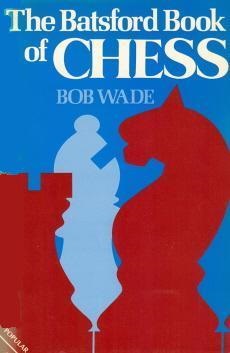
A good beginners’ work is The Batsford Book of Chess by Bob Wade, a revised edition of Playing Chess, that neatly produced if floppy paperback of a decade ago. Whereas Levy and O’Connell would appear to have written Instant Chess in a weekend, Wade’s book represents the culmination – and the accumulation – of a lifetime’s teaching experience.
A valiant attempt has been made to keep the new format version as well illustrated as Floppy; however, too many of the photographs of the chess personalities are of poor quality or too dark. The one on page 89 is particularly shady:
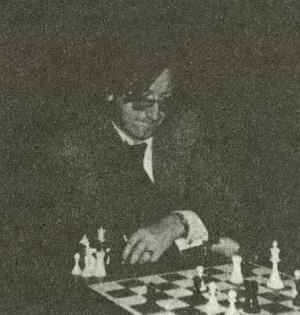
Reliable as Wade is on all technical aspects of chess, there is a most unhappy slovenliness on other matters of detail. A remark on page 20 about the possibility of publishers having to speed up the ‘inevitable change’ from descriptive to algebraic notation hardly strikes the reader as a 1984-type observation. One’s worst fears are confirmed on page 133 when the author fails to record Euwe’s death, which has occurred in between the two editions.
There is no justification for the statement on page 70 that Edward Lasker (in 1912) was an American. He had never even visited the New World at that time. Little care has been taken over name spellings towards the end of the book: ‘Kieseritsky’ (pages 111 and 112), ‘MacDonnell’ (pages 121 and 122), ‘Federation International des Echecs’ (page 155), ‘Jaque’ (page 158), ‘Bleyavsky’ (page 159), ‘Nenarakov’ (page 160), and ‘Nimozowitsch’ (page 160). Even the back cover misspells the name Hartston and the title of Golombek’s Encyclopedia.
Other rough edges include a reference on page 102 to a bibliography on page 158 which does not exist, the incorrect implication on page 122 that the ‘Immortal Game’ was played in the London, 1851 ‘even’ [sic], and the inclusion on pages 147-152 of the discredited Adams-Torre game.
Such defects could so easily have been avoided. They tarnish an otherwise well-written book.
(927)
A later (1991) edition was equally lax. See Kingpin, Autumn 1993, page 37.
Colin McGuigan (Newtownards, Northern Ireland) offers a couple of good’uns from David Spanier’s Total Chess:
Page 72: ‘One of the minor absurdities of FIDE is that while the Soviet Union has only one vote, the British Isles have four! England, Scotland, Wales and the Channel Islands.’
Page 73: ‘The Soviet Union’s own contribution ... was to send players out to the Third World, to give simuls and exhibitions and lectures. Taimanov ... went to Indonesia, Suetin to Nigeria, Kondratiev to Zimbabwe, Geller to Ireland and so on.’
(951)
The minutes of the 1984 FIDE Congress reveal that the British Grandmaster Michael Stean was censured for participating in last year’s South African Open Championship. To add to his sins, he won and settled the proceeds of his participation ‘on trust for the benefit of black chessplayers in South Africa’. A recent South African Chessplayer has a lengthy article lamenting FIDE’s reaction and even criticizing one familiar British figure for hypocrisy and vote-catching. We look forward to reading the British chess press’s accounts of the dispute.
(971)
We are grateful to Jerome Bibuld (Port Chester, NY, USA) for a large amount of documentation relating to South African chess, though it is not possible to go into the details of such matters in these pages. On the specific topic mentioned in C.N. 971 our correspondent informs us that as of 11 August 1985 ‘Black chess’ had seen none of the money referred to.
As far as we are aware, the entire affair has been passed over in silence by the British chess press.
(1163)
From Harold Edwin Price (Johannesburg, South Africa):
‘It was something of a shock to read in C.N. 1163 the scandalous and totally untrue allegation by Mr Jerome Bibuld that as of 11 August 1985 “Black” chess in South Africa had seen nothing of the money left in trust by International Grandmaster Michael Stean after he won the 1984 S.A. Open. I am the trustee of that fund. Mr Bibuld’s statement may have caused my reputation considerable damage, and Mr Stean a certain amount of anxiety. It is most regrettable that you have seen fit to give such a disgusting and slanderous (if not, in fact, actionable!) allegation a very broad audience without, apparently, making any serious attempt to investigate its validity.
The simple and easily verifiable facts are these:
1) The interest on the Trust had amounted to about R280 by mid-1985.
2) By August 1985, R216 had been disbursed to various recipients. The grants related to three separate tournaments during the period. (During the subsequent ten months a further R194 has been distributed.)
3) Thus far, not a single request to the fund for assistance has gone unsatisfied.
4) Every cent has gone to “Black” chess – as mandated by the Trust.’
(1184)
Mr Bibuld informs us that he had a debate with Mr Price in Hollywood on 11 August 1985 which was attended by all members of the USCF Policy Board (except Myron Lieberman):
‘During the debate the issue of the Stean “gift” was raised, and I declared that the money had found no takers in the “Black” community (using the broader definition of “Black”, that is, all whom Mr Price etc. would call “non-white”). Further, I declared outright that the money had been returned to the Oude Meester Chess Foundation (whence it had come). Mr Price took much umbrage at my remarks, just as he did in C.N. 1184, enlightening all present with the information that the Oude Meester Chess Foundation (of which he was a member, as then President of the SACF) had entrusted the money to him and that he had set up an escrow bank account (in his own name). Mr Price said nothing about accrued interest or about “R216 [that] had been disbursed to various recipients”. Did he forget to mention this telling point during our debate, in which he was trying to gain support by the Policy Board of the USCF for apartheid chess? I don’t think so, because I recall his saying that the money was waiting for the proper parties to claim it.’
(1297)
An item on page 266 of Kings, Commoners and Knaves:
On page 9 of The Moscow Challenge Raymond Keene wrote that it was ‘staggering’ that Steinitz had an ‘abysmal’ tournament record in his period as world champion (1886-94). The truth is that Steinitz did not play in a single tournament during the period under consideration.
(976)
On page 256 of the June 1985 BCM Mr Keene made the astounding claim that ‘in calling Steinitz’s tournament record “abysmal” he was criticising it on the grounds of lack of activity’. By that logic, we pointed out on page 305 of the July 1985 issue, given that Fischer has played in no tournaments since 1970 his tournament record since then could be labelled ‘abysmal’.
For further details see Cuttings.
With a major musical and a prestige film about chess, the game is doing well for general publicity.
La Diagonale du Fou (Dangerous Moves) concerns a world championship match between an ageing Petrosian/Karpov figure and a dynamic dissident apparently based on Korchnoi/Fischer. Although without a fraction of the wit, charm and depth of the musical ‘CHESS’, it is enjoyable and gripping enough for an outsider’s view.
The fine photography shows that Geneva is as photogenic as ever, but the film also illustrates how difficult it is to ensure realism when presenting chess to a wide public. The moves are played at such speed that one might think it a match for the world blitz title, while the idea of the world’s top two players informing each other when a move gives check is also difficult to accept. There is ample opportunity to get to know the audience, which appears glued to the same seats throughout the match. The challenger has a bizarre second who, though capable of instantly spotting a mate in seven, does not know the name of the opening that begins 1 e4 e5 2 Nf3 Nc6 3 c3. Perhaps he was preoccupied with writing an illicit book on the match.
(1014)
C.N. 1726 reported that we had jotted down this position from the 1984 film La Diagonale du Fou/Dangerous Moves:
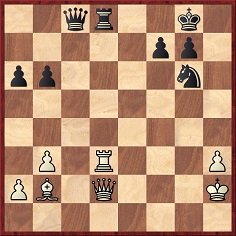
Black played 1...Qxh3+
The closing credits stated that Nicolas Giffard had created the games shown in the film.
In C.N. 1838 the late Jack O’Keefe pointed out that, with colours reversed, the position was almost identical to one published on page 134 of Chess Review, June 1938 (H.S. Hoit v Amateur, ‘a recent game’):

As mentioned on page 5 of Kings, Commoners and Knaves, the Hoit ending was also on page 33 of Combinations The Heart of Chess by Irving Chernev (New York, 1960) and on pages 133-134 of The Fireside Book of Chess by I. Chernev and F. Reinfeld (New York, 1949). The former work gave no details beyond ‘Hoit-Amateur’, and the introductory note read:
‘Chess can be brutal! Black’s king and queen are forced to move to the sixth rank, where a vicious knight lies in wait, poised for the kill.’
The first comment in The Fireside Book of Chess:
‘From a game Hoit-Amateur at New York, in 1938. The winning combination is so elegant that it gives the impression of being a composed ending. Only unique and felicitous chance can produce such exquisite possibilities in practical play.’
The conclusion was given too, without even Hoit’s name, on pages 133-134 of Reinfeld’s The Secret of Tactical Chess (New York, 1958), billed as ‘one of the most beautiful examples of double attack ever conceived on the chessboard’.
The starting-point in all three books was the position after 1 Qe3 Rxd6.
About Howard S. Hoit information is sought beyond what appeared on page 200 of the October 1942 Chess Review:

Above all, can the full score of Hoit’s brilliancy be found?
(9559)
We regret to learn from Dale Brandreth (Yorklyn, DE, USA) that he will probably be forced to cut back drastically his publishing plans:
‘I am getting more discouraged all the time, and am coming round to the view that what the chess world really deserves is a lot more openings books by Batsford. Hooper and I could have written ten trashy books on some opening or other in the time we took to do The Unknown Capablanca and might have made some money as well. Well ... live and learn.’
(1008)
The above was written in 1985. Subsequently, Dr Brandreth nonetheless published a series of excellent books on chess history, under the imprint Caissa Editions.
Colin McGuigan (Newtownards, Northern Ireland) sends a couple of extracts from the first two issues of Etero Scacco Problemi, printed in Italian and ‘English’:
It want be a push to the search of unexplored possibility of the chess board and its inhabitantes; a creative push; an incentive to rediscover the Chess as only play and not as science.
So, in every issue there are original articles but also pages of “pure madness of chess”.
We hope that E.S.P. be a push for greater “chess crazy”. (A thousand apologies for the judicious!).’
The question of correct language is not just one of vague aesthetic importance; what counts is whether precise thoughts are precisely phrased. To take another example, New in Chess continues to publish in its English edition sentences whose meaning is far from obvious. Occasionally too, insufficient knowledge of the language leads to unnecessary complications and embarrassment. In the July 1985 issue the Editor-in-Chief, Jan Timman, appears to misunderstand (in the context of the Moscow doings of February 1985) the actual meaning of the word ‘termination’.
Nevertheless New in Chess is already established as one of the best general interest magazines, and one can only hope that its excellent production standards won’t lead to cash-flow difficulties. Its coverage of top master tournaments is particularly fine, even if sometimes a single event is allowed to swamp an entire issue. The practical difficulties of producing parallel Dutch and English editions cannot be underestimated, which makes the lively editorial team’s achievement so far all the more remarkable.
(1036)
One of the most interesting aspects of New in Chess is the detailed interviews that have appeared in recent numbers [in 1985], e.g. Spassky (June), Kasparov (July), Schmid (August) and Timman (September). However the most memorable was a moving, though badly written, article by Mischa de Vreede, who has paid several visits to Jan Hein Donner, the victim of a stroke two years ago and now confined to a nursing home. The article/interview, in the August New in Chess, is a desperately sad report on a wonderful personality.
(1056)
The issue of Donner’s forename(s) was discussed in C.N.s 8299, 8304 and 8312.
From Ed Tassinari (Scarsdale, NY, USA):
‘In New in Chess (April 1985) Tim Krabbé in “Record Inventory” cites among the longest games an arranged draw (Rogoff-Williams, Stockholm, 1969, 221 moves). Yet, writing in the Australian Chess Championship Yearbook 1971-1972, R. Jamieson, in an article on the 1971 World Junior Championship, Athens, mentions a 224-move game ending in stalemate in the final round between Rosenberg (Scotland) and Haigh (Wales). Was this another bogus game à la Rogoff v Williams? Interesting also that both games took place in the World Junior Championship event.’
Incidentally, on the same page (53) of New in Chess, the famous ultra-short game Combe-Hasenfuss is given. However, according to R.N. Coles – who was there – the opening was 1 c4 c5 2 d4. Source: BCM 1973, page 44.)
(1064)
A letter to Robert B. Long, the Editor of the Chess Gazette, which, of course, was not published:
Geneva, 2 July 1985
Dear Mr Long,
I was intrigued by your remark in issue 37 of the Chess Gazette that it now seems to you that Chess Notes is ‘being written by the same three people in the guise of collective genius’.
In fact, the latest number (22) publishes contributions from David Hooper, Brian Reilly, Warren Goldman, Anthony Saidy, John Nunn, Ken Whyld, John Roycroft, Hugh Myers, Leonard Barden, Bernard Cafferty, Paul Buswell, Dale Brandreth and G.H. Diggle.
Which three did you have in mind?
Yours sincerely,
Edward Winter
(1074)
A discrepancy which is not of momentous importance, but which readers may be able to clear up swiftly, concerns the size of Mikhail Chigorin. Most sources suggest that he was little short of a giant, but on page 22 of Chess Characters G.H. Diggle reports that at Hastings, 1895 W.H. Watts ‘had expected Chigorin to be a great burly Russian, but found him in fact a small jerky man, no bigger than Steinitz ...’ Is there a photograph which puts the matter beyond doubt?
(1106)
An endnote on page 269 of Chess Explorations:
On page 29 of his first volume of best games, Tartakower called Chigorin ‘the Russian giant’, not necesarily a reference to physical size.
From J.H. Duke (Melbourne, Australia):
‘In the second issue of Lasker & His Contemporaries there is a photograph of the participants in the Cambridge Springs tournament of 1904 in front of the Rider Hotel. Chigorin, standing in the front row, certainly appears to be a small man. The giant of the field is Marco, who towers over everyone else.’
Who has been the tallest master? The late J.H. Donner would be a popular nomination, but on pages 10-11 of the October 1955 issue of CHESS there is a photograph in which he is standing alongside a distinctly taller Filip.
(1878)
The description of Pillsbury in C.N. 3141 as a short man prompts us to quote a brief item entitled ‘The Height of Players’ from Sunday States, as given on page 500 of the American Chess Magazine, June 1899:
‘Are chessplayers tall men? Generally speaking, we should say not. If the average height of masters were to be ascertained it would be below five feet seven inches. Considering the stature of the past and present masters, we think the average would be about five feet six inches. Paul Morphy was a small man, and we are told that as he sat before Meek in their game of the American tournament they were referred to as David and Goliath. Meek remarked that if Morphy didn’t give him a chance he would put the little fellow in his pocket. Harrwitz was a little man; Paulsen was not large; Zukertort was small; Steinitz is very short; Pillsbury, Lasker, Weiss, Tarrasch, Walbrodt, Charousek are all little men; Gunsberg, Mason, Schlechter are far from large. Of the tall players Blackburne, Chigorin, Showalter, Mackenzie, Pollock, Burn, Marco, Schiffers, Maróczy are of the minority.’
C.N. 1106 quoted W.H. Watts’ description of Chigorin as ‘a small jerky man’. See pages 192-193 of Chess Explorations. In an article on Hastings, 1895 in Saturday Review, 31 August 1895 (see pages 359-362 of Jacques N. Pope’s monograph) Pillsbury called Walbrodt ‘a very small man also, the smallest of all the competitors’.
Pillsbury’s remark is confirmed by other descriptions and photographs, with one exception: in the Dresden, 1892 photograph on page 56 of A Picture History of Chess by F. Wilson the player identified as Walbrodt appears taller even than Blackburne.
Below, courtesy of the Cleveland Public Library, is a photograph of B. Hönlinger and W. Schönmann taken at the Congress of the German Chess Union in Vienna in 1926, from page 227 of the August 1926 Deutsche Schachzeitung:
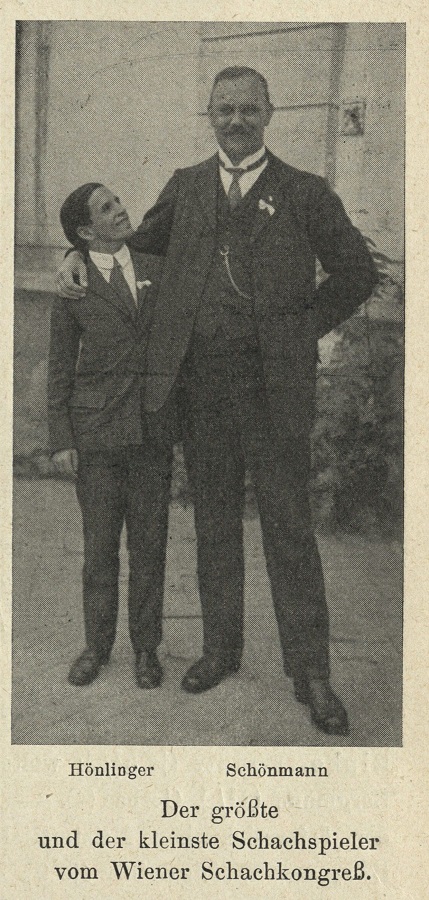
(3146)
One of the tallest of the older masters was Paul Lipke. From page 34 of the October 1894 Chess Monthly:
‘Socially, Herr Lipke is of pleasing, gentlemanly manners; good-looking …; head and shoulders above the average amateur at chess, and also in height, he measures 195 centimetres in his stockings.’
The magazine stated, moreover, that Lipke was ‘one of the best living blindfold players’ and had given exhibitions on eight and ten boards.
(3171)
An addition to our list of tall chessplayers is Willem Jan Muhring. Stefan Muellenbruck (Trier, Germany) quotes from page 98 of Meesterlijk geschut by W.J. Muhring and J. Roelfs (Amsterdam, 1955):
‘Muhring is precies 1.98 m lang en derhalve een indrukwekkende figuur.’
(3185)
The following quote comes from an article by Hans Kmoch and Fred Reinfeld on pages 9-11 of the January 1951 Chess Review:
‘… Tarrasch was given short shrift by Mijnheer te Kolsté of Holland in the Baden-Baden tournament held in 1925. Te Kolsté had turned up as a rather inadequate substitute for Dr Max Euwe. Approximately seven feet tall, weighing 250 pounds and with hands the size of a chessboard, te Kolsté presented a formidable appearance. His accomplishments were by no means so formidable, and te Kolsté represented little more than a bye in the tournament. For example, during his game with te Kolsté, Tartakower spent most of the time chatting with Alekhine, and, at one point, seeing that te Kolsté had made a move, Tartakower interrupted the conversation with the remark: “Excuse me, I have to see whether my opponent has left his queen en prise.” And, sure enough, he had done just that.’
Whether Jan Willem te Kolsté (1874-1936) was really about 2.13 metres tall we are unable to say, but the well-known group photograph taken at Baden-Baden, 1925 does not give that impression. As regards the Tartakower game, it may be thought that a more likely, and less derisive, comment would be (after 16…Qe7), ‘Excuse me, I have to see whether my opponent has left his queen to be trapped’.
(3308)
See too our feature articles on Max Euwe and William William, as well as the Factfinder references to Carl Walbrodt.
At Budapest, 1926 Alekhine’s Defence was played 15 times, and the Queen’s Indian Defence 24, much more than any other openings in the tournament. Why? (For example, there were six French Defences, one Caro-Kann and nine Sicilians, so Alekhine’s Defence all but outnumbered the other semi-open defences combined.)
(1135)
As recorded on page 27 of Dale Brandreth’s edition of the Kemeri-Riga, 1939 tournament book, the Ruy López was played in that event only once in the 120 games. It will be surprising if a reader can quote a comparable case concerning this most popular of openings.
(1607)
As mentioned on page 260 of Chess Explorations, C.N. 593 quoted Fine’s observation in Lessons from My Games (page 152) concerning AVRO, 1938: ‘It is curious that not a single player dared to try a Sicilian in the whole tournament.’
Ken Whyld (Caistor, England) writes:
‘Soviet Chess by R. Wade. A few years ago in casual conversation with Wade I asked him how much embarrassment had been caused to him by the printer jumbling up what he had written about Boleslavsky and Bondarevsky and putting them under one heading (page 171) “Isaac Bondarevsky”. He looked startled and said, “None”. I could only conclude that the book had not had the volume of sales it surely merits, otherwise surely someone must have picked it up.’
(1148)
Another pair sometimes confused are Chajes and Jaffe; both were born in Russia but became active in US circles around the second decade of this century. Even so, it was rather much for Miguel Sánchez (page 239 of volume II of Capablanca, Leyenda y Realidad) to write about ‘Chaffes’.
In the circumstances, it is surprising that Kasparov and Karpov are not muddled more often. One jumble appeared on page 16 of the Daily Telegraph of 20 September 1986, where B.H. Wood reported on game 18 of the third K-K match under the headline ‘Lost chance bodes ill for Karpov’:
‘The 18th game of the world chess championship match in Leningrad was adjourned last night in an obscure position where Gary Kasparov has what advantage there is.
If Anatoly Karpov loses, it will be a double tragedy for him, for he turned down an opportunity to draw by perpetual check. After that, he lost a little ground.’
It was Kasparov, not Karpov, who could have forced the draw. And it would have been a draw by repetition of position, not perpetuai check. Karpov eventually won the game.
(1546)
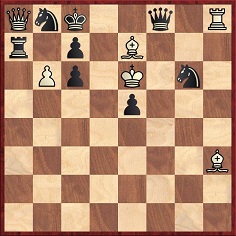
Mate in one move
Solution: There needs to be a white square in the bottom right-hand corner. Turning the board 90 degrees in one direction allows 1 Kd4 mate and, in the other, 1 fxg8(N) mate.
This problem by Alapin was published on page 88 of the March-April 1916 Wiener Schachzeitung, together with two easier mate-in-one positions (based respectively on the familiar tricks of the en passant rule and nine black pawns).
(1158 & 1195)
A footnote on page 3 of Kings, Commoners and Knaves:
A problem by W. Langstaff in which White has nine moves and mates in one after the removal of any one of them was given on page 554 of The Social Chess Quarterly, July 1935.
The ‘Christmas Puzzle’ hereunder, by J.C.J. Wainwright, appeared on page 262 of the December 1917 American Chess Bulletin:
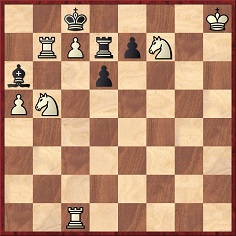
‘White mates in one move’
The solution was given on page 50 of the February 1918 issue. It must be Black’s move; whatever he plays, White then mates in one move.
(Kings, Commoners and Knaves, page 3)
The first paragraph of C.N. 1160:
Chess Openings – Your Choice! by Stewart Reuben (Oxford, 1985) is one of the most peculiarly written books we have seen, no mean accolade. On the whole it merits a welcome for the practical assistance it offers the relatively weak player, and it is undoubtedly a work into which the author has put much. Nonetheless, we would be hard put to quote any other title which has so much wisdom and fatuity side by side. Just as one is admiring his presentation, S.R. suddenly goes berserk for a sentence or paragraph before the book resumes its normal respectable course.
Many examples were then given, the first being from pages 4-5, where Reuben offered for consideration ‘an alternative definition’ of the opening: ‘The opening is the stage of the game where at least one of the two players has seen the actual position on the board before.’ [For further details see Book Notes.]
Below is a later item (C.N. 1650), which considered Reuben as a chess magazine columnist:
C.N. 1160 illustrated how Mr Stewart Reuben’s judgements are often erratic. Further proof of this is provided by his new series of ‘Viewpoint’ articles in the BCM. The June 1988 issue has an especially memorable example (elegantly entitled ‘Who Dun It?’).
‘The editor has asked me to write on the subject of collaborations in chess writing. Well, you can understand why he shirked the topic, can’t you? Who wants to be the subject of a libel suit or to be shunned by ones [sic] peers?’
Eyewash, because the BCM editor would in any case have to assume responsibility for a contributor’s libel, but at least the illogicality of this jaunty introduction serves to distract attention from the ‘ones’ and, for that matter, from the equally erudite ‘each others’ which graces the following paragraph.
The BCM’s star stylist informs us, with regard to his book Chess Openings – Your Choice!, that ‘... it took George Botterill to point out a glaring fault in an innovation I recommend. That was in his review of the book in the New Statesman. Now, that is what I call a review in depth!’ Now, that is what we call useful information: no identification of the blunder to enable readers to write a pencil correction in their copies.
Next on the bill is a shallow reference to Euwe’s literary collaborations, notable only for Mr Reuben’s ignorance of the entire subject (including, of course, Lodewijk Prins’ authoritative observations in C.N. 1529). The following is Mr Reuben’s full contribution: ‘Many of Dr Euwe’s works are thought to be primarily the work of his collaborators. However, one doubts such an honourable gentleman failed to give the material at least a cursory glance.’
The next stunning revelation from the BCM’s colourful columnist: ‘An English writer complained to me recently of the number of errors in a book he was reading for the first time. It did not seem to occur to him that having his name on the dust-jacket as a co-author carried the responsibility of at least reading the book in proof form.’ It is unlikely that many will have been electrified by this further phut of non-facts, limply justified in the very last paragraph of the article: ‘You will be disappointed that I have allowed certain practices to remain shrouded in anonymity but David Anderton (BCM’s lawyer) wouldn’t have allowed more frank confessions anyway.’
More evidence of a Stewart Reuben in peak form: ‘Kasparov and Keene came in for a great deal of stick because Batsford Chess Openings contained no references to their own analysis. It seemed obvious to Ray that, where a variation was unattributed, it came from one of the two co-authors. But nothing will now persuade some authorities that these Ks had anything to do with the book.’ It is possible that even Mr Reuben, on a good day, would admit that nobody in the world has ever claimed that ‘these Ks’ had nothing to do with Batsford Chess Openings.
And so it goes on. ‘The section on Psychology in one book received an excellent review. I happen to know it was written by a 120 strength player.’ Or again: ‘Another English grandmaster regretted lending his name to a work of inferior quality ...’
‘It is impossible to believe Fischer had much to do with most of the books which carry his name’, pontificates the BCM’s guest guesser, wrongly implying that countless different book titles are in question. One sentence later he drops the entire subject with a lame ‘who cares how such a great work [My 60 Memorable Games] came about?’, but not before sharing some more rock-solid information regarding Fischer’s book: ‘It is said he recorded his views on a tape recorder.’
Mr Reuben’s approach is contagious and irresistible, and we confess to having caught the bug. So here goes. Well, it is said in some circles that a certain British chess periodical, formerly a respected journal of record, has recently given a monthly column to a foolish and ill-informed writer. Some people, including three active players with a rating of over 2430 and one who has just achieved his second GM norm, are even claiming that the only reason he was given the job was that he holds a post in the national ruling body which owns the magazine. It is now openly rumoured that his engagement is just one more in a grave series of misjudgements by editor X of magazine Y.
An Answer to a Correspondent on page 215 of the May 1933 BCM:
‘Best thanks for obtaining two new subscribers to the BCM. If everyone helped as you have done we should soon double our circulation.’
A comment curiously similar to the one quoted in C.N. 1186 appeared on page 11 of the October 1947 CHESS. A reader enquired whether that magazine had passed the 10,000 circulation mark, and the Editor replied:
‘No, we are still a few hundred short of that nice tidy figure – if every reader would persuade one friend to enrol as a subscriber, we’d soon be hundreds past it ...’
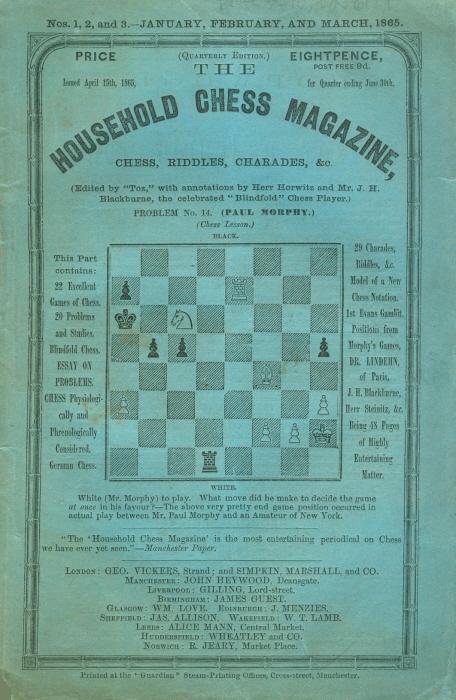
From Gordon Pollard (Wallingford, England):
‘Among the chess literature I have collected over the years is a tattered copy of the Household Chess Magazine, the quarterly edition, issued 15 April 1865, of a monthly magazine which was first published in January 1865. The 48 pages, price 8d, are said to contain “... Twenty-two very carefully selected games of Chess, 20 first-class problems and studies in diagrams, many interesting Charades and Riddles, and much other entertaining and entirely original matter ... edited by ‘Toz’, with annotations by Herr Horwitz and Mr J.H. Blackburne the celebrated Blindfold Chess Player”. The annotations are very brief.Toz contributes articles on How to Play at Chess, Chess Notation (to avoid confusion he suggests alternative names – Tower, General, Marshal – for the Q-side pieces), Chess Physiologically and Phrenologically Considered, and lots of Charades and Riddles. I find his flowery phraseology amusing.
The Blackburne games which he gives I cannot find in Graham. On the assumption that they may be new to you I have transcribed them and enclose the scores.
The advertisements are interesting too. T.H. Hopwood of Manchester offers “Ivory Cement for repairing Chessmen, Chinaware, and Chimney Ornaments”. Further down the page T.H. Hopwood not only supplies haberdashery of every description including “hosiery, gloves, wool shirts, drawers, paper collars and wristbands”, but also makes to order the “new double action Chess Marker made in brass to fasten to the sides of the chessboard; registers by one movement Winners and Losers at the same time, also Drawn Games, price 1s 6d”. On another page is announced “Hopwood’s Patent Reaching Tongs for removing articles out of reach of the hand”. According to Gaige, “Toz” was Thomas Henry Hopwood.
There is a note that “The Proprietor will be glad to treat with a respectable party who would be desirous of joining with him in the continuance of this Magazine which is in a very fair train for becoming a popular periodical”. On the last page is a “Notice to Subscribers and the Public: The Editor much regrets that urgent engagements in another quarter will prevent him continuing the magazine monthly during the summer months, at which period however chess is not so generally pursued as an evening’s amusement. He therefore proposes to issue it until September in quarterly parts”. But at the bottom of the page someone has added the laconic note “Finis”, so one can only suppose that those urgent engagements in another quarter prevented the magazine ever appearing again.
I have never come across any reference to the Household Chess Magazine; Diggle did not mention it in his BCM article on nineteenth-century chess periodicals (December 1980 and January 1981 issues). Perhaps it is a rare item.
Nor can I find any information about Hopwood. I wonder whether you know anything of him ...’
Two of the games our correspondent kindly sent us were played in Manchester between Blackburne and Horwitz. Nor are they in the the Oxford Encyclopedia of Chess Games. Jeremy Gaige records that Hopwood was born on 20 August 1828 in Manchester, England, his death date being unknown.
A footnote on page 139 of P.W. Sergeant’s A Century of British Chess states that the Household Chess Magazine seems to be ‘the sole authority’ for a supposed match at Manchester between Blackburne and Horwitz. It ‘publishes two of the games, but no match-result’. In the second and concluding part of his article ‘British Chess Periodicals’ (BCM, 1942, page 197) Sergeant writes: ‘This magazine for some reason only ran for three months, January-March, 1865.’ In the following issue of the BCM (page 229) T.R. Dawson contributed a letter in which he reported that Blackburne was assistant Editor of the Household Chess Magazine for issue one, ‘but then retired’.
(1188)
From Ken Whyld (Caistor, England):
‘The Household Chess Magazine is nearly always found as a collected set of the three monthly issues, which suggests that the monthly sales verged on the non-existent. Like others I have accepted that “Toz” was Hopwood, but it is strange that the address of ”Toz” was given as 42 Brunswick Road, Liverpool, while that of T.H. Hopwood is stated to be 110 Stretford Road, Manchester.’
(1239)
We are grateful to the Liverpool Record Office and the Central Library Manchester for information about Thomas Henry Hopwood. Between 1852 and 1902 Manchester area directories list him under a number of addresses and a variety of professions (hosier and smallware dealer; secretary to the Patent Atmospheric Marine Salvage Co. (Ltd.); accountant, auditor and shorthand writer; hosier etc.; accountant and patentee; accountant).
The Liverpool Directory of 1865 has no reference to him at 42 Brunswick Road, but the 1868 edition lists Thomas H. Hopwood, salvage agent, of Marsh & Hopwood, 38 Meville Place. The address for Marsh & Hopwood, National Marine Salvage Co. is given as 42 Duke Street. It can thus be seen that Hopwood (common links: marine salvage and inventions) did indeed have Liverpool and Manchester connections.
We are able to reveal when he died. In the 1890s he wrote a number of letters to the BCM from 29 Percival Street, Cheetham, Manchester. The same address appeared in an advertisement for ‘The “Toz” Chess Diagram and Game Recorder Combined’ in the 1893 book Liverpool Chess Club – A Short Sketch ... 1837-1893. The Probate Indexes have the following entry in 1902: Hopwood, Thomas Henry, of 29 Percival Street, Cheetham, Manchester, accountant, died 29 April 1902. Probate Manchester 7 June, to Ellen Maria Hibbitt (wife of Frederick Hibbitt). Effects £105. 10s. 2d.
(1408)
On pages 303-304 of Capablanca, Leyenda y Realidad volume two, Sánchez reports that some of Capa’s friends asked him for help in arranging to send a Cuban team to ‘the Tournament of Nations at Folkestone, in the United States’. There follows a page of detail about how problems over Alekhine’s blocking of Capa at Pasadena put a stop to any Cuban presence in Folkestone, since the two competitions were being organized by the same group. A splendid addition to our dubious geography file.
It is a while since there have been additions to this file, but Frank Mur (Oakland, CA, USA) offers a good one, from page 118 of Horowitz’s From Morphy to Fischer:
‘... Keres, who had become a Soviet citizen perforce when the Balkan States were annexed in 1940 ...’
(1919)
Endings with curious balances of material are always interesting. An example is below:
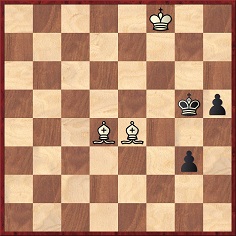
This position arose after White’s 72nd move in Carls-Brinckmann, Hamburg, 22 July 1921 (page 86 of the tournament book). Two bishops against two pawns must be extremely rare. Play continued 72...h4 73 Bg2 Kg4 74 Bc6 (Two question marks. The book gives 74 Kf7 h3 75 Bc6 h2 76 Bg2, or 75...g2 76 Bf2.) 74...Kh3 75 Be5 Kh2 76 Kf7 h3 77 Bd7 Kg2 78 Kg6 h2 79 Bc6+ Kg1 80 Bd4+ Kf1 81 Bb5+ Drawn.
(1220)
René Olthof (Rosmalen, the Netherlands) reports that his favourite example of a curious balance of material is to be found on pages 199-200 of the Batsford book Sicilian: Lasker-Pelikan. It is indeed remarkable: rook, bishop and knight versus queen and pawn. The diagram below shows the position after 56 moves. A draw was agreed after White’s 85th move, and only after some fascinating winning attempts by White (Zhelnin-Semeniuk, RSFSR Championship, 1976):
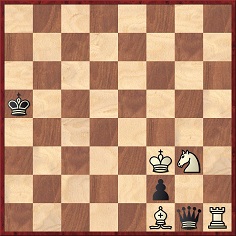
White to move
(1256)
Ed Tassinari (Scarsdale, NY, USA) submits this game:
Paavo Voltti – Jussi Kanervo
Championship tournament of Lapua, 1934
Owen’s Defence
1 e4 b6 2 d4 Bb7 3 Bd3 e6 4 Nc3 Bb4 5 Ne2 Qh4 6 O-O Bd6 7 Ng3 h5 8 f4 c5 9 Nb5 Ke7 10 e5 Bxe5 11 dxe5 a6 12 Nc7 Nh6 13 Nxa8 Ng4 14 Rf3 Qxh2+ 15 Kf1 h4 16 Bf5 hxg3 17 Qd6+ Ke8 18 Qxb8+ Bc8 19 Qxc8+ Ke7 20 Qxh8 Qxh8 21 Bxg4 Qh1+ 22 Ke2 Qxg2+ 23 Kd3 c4+ 24 Kc3 Qg1 25 Be3 Qxa1 26 Nxb6 g2 27 Bc5+ Kd8 28 Rh3 Qe1+ 29 Kxc4 Qf1+ 30 Kc3 g1Q 31 Rh8+ Kc7 32 Na8+ Kb7 33 Bxg1 Qxg1 34 Bf3+ Ka7 35 Kd3 Qf1+ 36 Ke3 Qc1+ 37 Kd3 Qxf4 38 Bh1 Qxe5

39 b4 g5 40 Rd8 d5 41 Rd7+ Kxa8 42 Rxf7 Qg3+ 43 Rf3 Qg1 44 Rf8+ Ka7 45 Rf7+ Kb6 46 Rf6 Qxh1 47 White resigns.
Source: Suomen Shakki 4/1945, page 131.
In the same spirit, we give a fascinating game which concluded with a configuration of extreme rarity:
H. Treer – Hans Fahrni
Correspondence tournament, 1927-29
Dutch Defence
1 Nf3 e6 2 c4 f5 3 g3 c6 4 Bg2 Nf6 5 O-O Be7 6 Nc3 d5 7 d4 Nbd7 8 b3 Bd6 9 Qc2 O-O 10 cxd5 Nxd5 11 Bb2 N7f6 12 Na4 Qe7 13 Rac1 Ne4 14 Rfd1 Nxf2 15 Kxf2 f4 16 Re1 fxg3+ 17 Kg1 gxh2+ 18 Kh1 Bg3 19 e4 Bxe1 20 exd5 Bg3 21 dxc6 e5 22 Qc4+ Kh8 23 Nxe5 bxc6 24 Nc5 Bf5 25 Nxc6 Qe3 26 Rf1 Rae8 27 Bc1
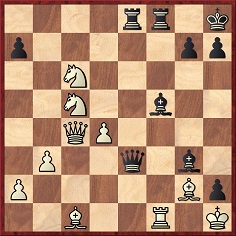
27…Qg1+ 28 Rxg1 hxg1(Q)+ 29 Kxg1 Re1+ 30 Qf1 h5 31 Qxe1 Bxe1 32 Ne7 Bh7 33 Ne6 Re8 34 Bg5 Bb4 35 Nc6 Rxe6 36 Nxb4 Bb1 37 Kf2 Rb6 38 Be7 a5 39 Nc6 a4 40 Nb4 axb3 41 axb3 g5 42 Bf3 g4 43 Bd1 Kg7 44 Nd5 Re6 45 Bh4 Rd6 46 Nf4 Ba2 47 Be7 Rd7 48 Bc5 Kh6 49 Kg3 Rf7 50 Bc2 Kg5 51 Ne6+ Kf6 52 Nd8 Rc7 53 Kf4 h4 54 Kxg4 Rg7+ 55 Kxh4 Rg2 56 Be4 Rg8 57 Nc6 Bxb3 58 d5 Ba2 59 Be7+ Kf7 60 Bg5 Re8 61 Bf3 Re1 62 d6 Ke8 63 Nb8 Be6 64 d7+ Bxd7 65 Bh5+ Kf8 66 Nxd7+

66…Kg8 67 Bf6 Rg1 68 Bd4 Rg2 69 Bf3 Rh2+ 70 Kg3 Rd2 71 Bd5+ Kh7 72 Nf8+ Kh6 73 Be3+ Resigns.
Source: Wiener Schachzeitung, July 1929, pages 214-216.
(2417)
For the record, a few little-known details about Capablanca’s first biographer, José Antonio Gelabert y Barruete. He was born in Havana in 1893 and died there on 16 February 1969. He was a barrister (abogado) by profession. His private chess clock was the one used in the 1921 Lasker-Capablanca match.
(Details taken from obituary in the 1/1970 issue of Jaque Mate, pages 45-46.)
(1224)
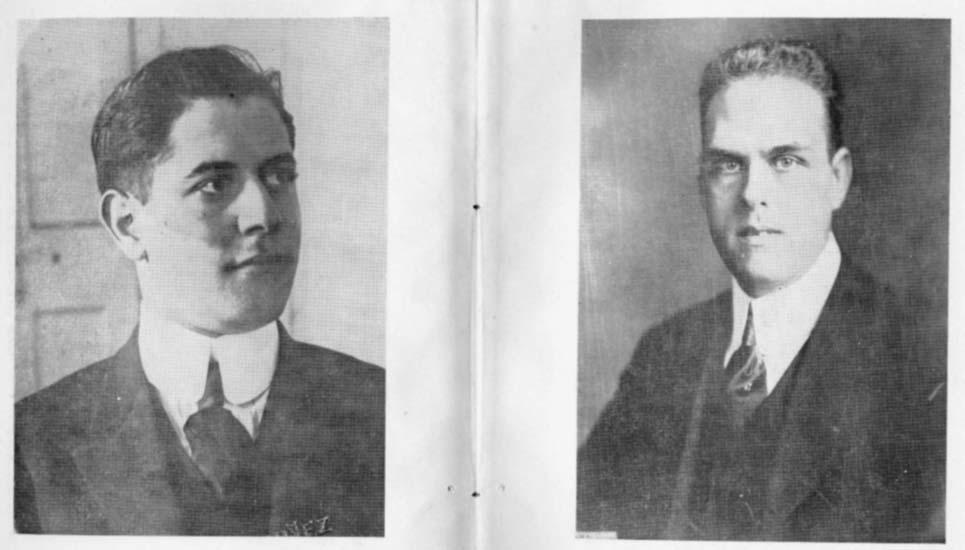
The first comprehensive biographical games collection about José Raúl Capablanca (left) was by José Antonio Gelabert (right). It was entitled Glorias del Tablero “Capablanca” (Havana, 1923), and the photographs above appeared in the slightly different second edition, published in 1924.
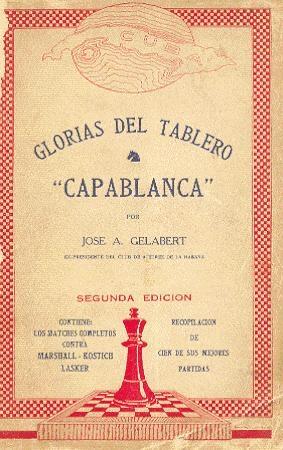
(4232)
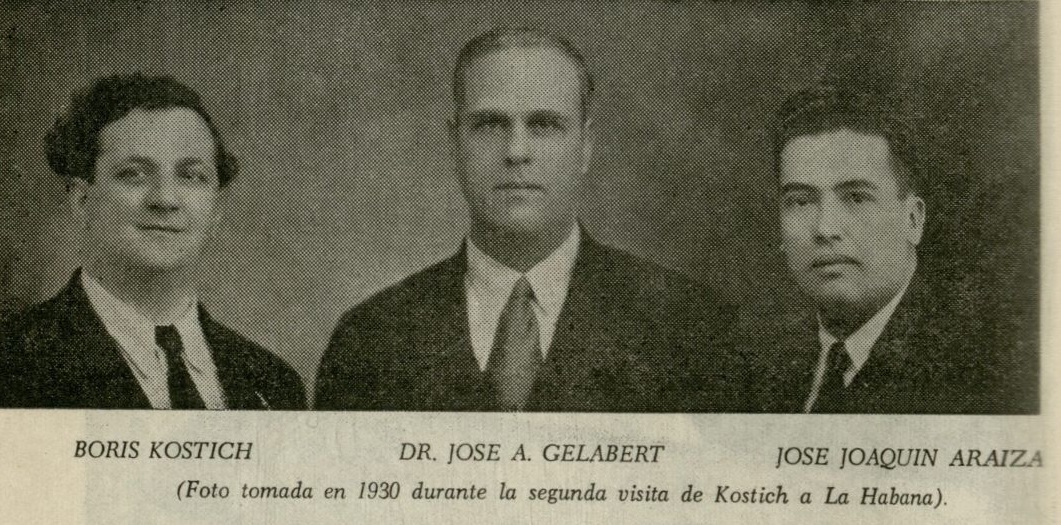
This picture was published at the start of an article by José A. Gelabert, ‘Recuerdos del Match Capablanca vs. Kostich’, on pages 72-76 of Ajedrez, December 1963. See page 94 of our book on Capablanca.
(11609)
From opposite page 158 of Homenaje a José Raúl Capablanca (Havana, 1943):
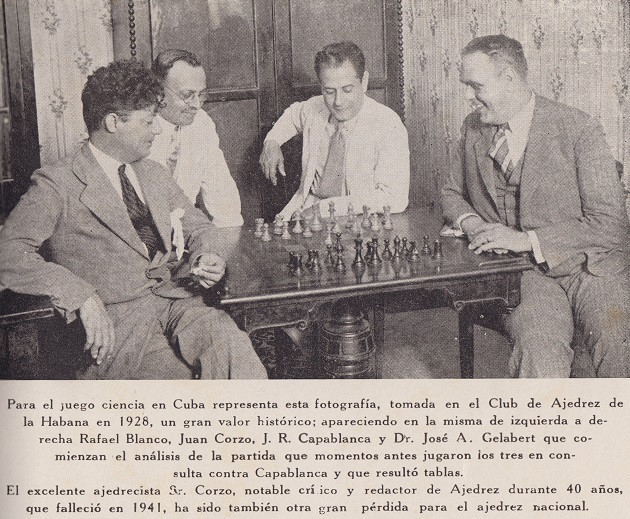
Another version, from our archives:
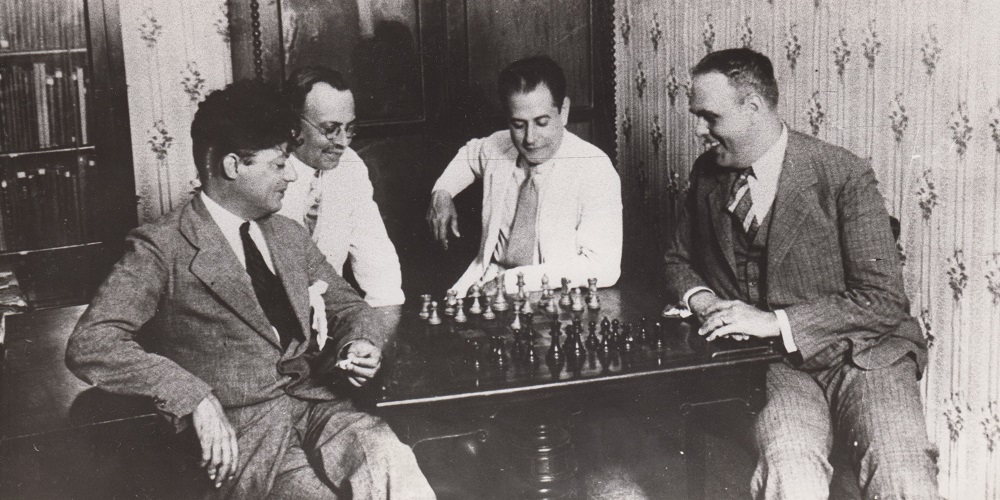
A group photograph (Capablanca v Kostić match, Havana, 1919) opposite page 80 of Glorias del Tablero “Capablanca” by J.A. Gelabert (Havana, 1923):
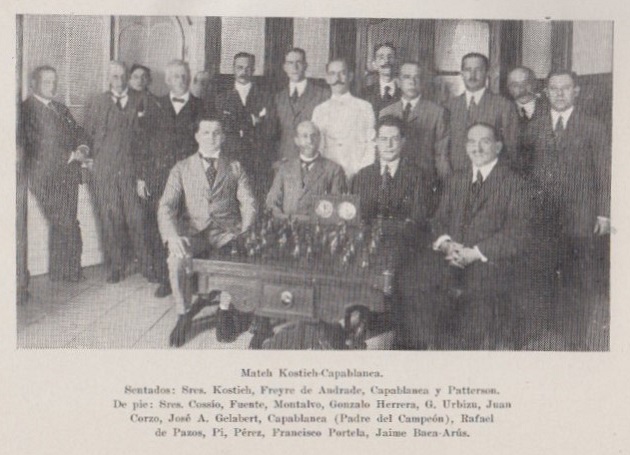
(11690)
Yandy Rojas Barrios (Cárdenas, Cuba) sends this portrait of Gelabert, from page 101 of Capablanca-Magazine, 31 May 1913:
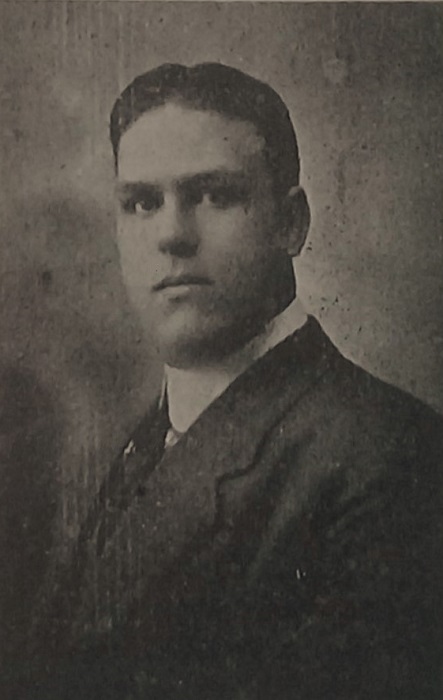
(11904)
Mr Rojas Barrios has also provided a photograph (Havana, 1960) of José Antonio Gelabert and Paul Keres, with Eduardo Heras León (1940-2023) in the background:
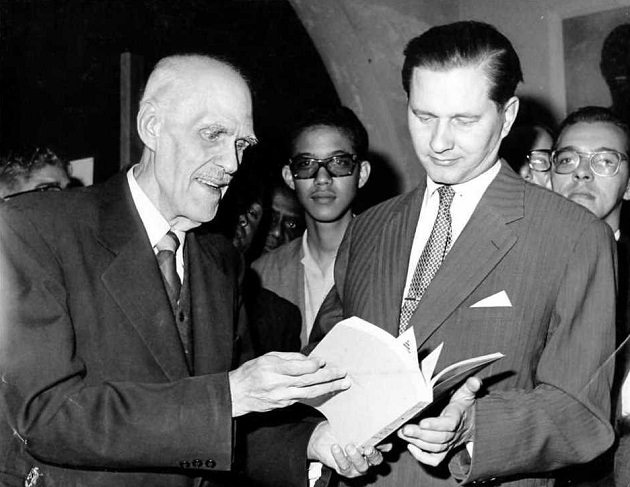
(11273)
We are most grateful to Pavle Bidev (Igalo, Yugoslavia) for sending his manuscript ‘Did Chess Originate in China or India?’, for which he has so far been unable to find a publisher ... An example of Professor Bidev’s writings may be found on pages 295-298 of the 1978 BCM.
(1248)
The case of Dr A. Olland, who died during a game, is well known. At a lightning tournament in the British Chess Federation Congress, Edinburgh, 1926, James Marshall collapsed and died (BCM, September 1926, pages 406 and 417). ‘The tournament was at once abandoned and the rooms closed until the evening as a mark of respect.’ For another case, see page 44 of the November 1974 CHESS (anonymous reader’s letter).
See also C.N. 11553.
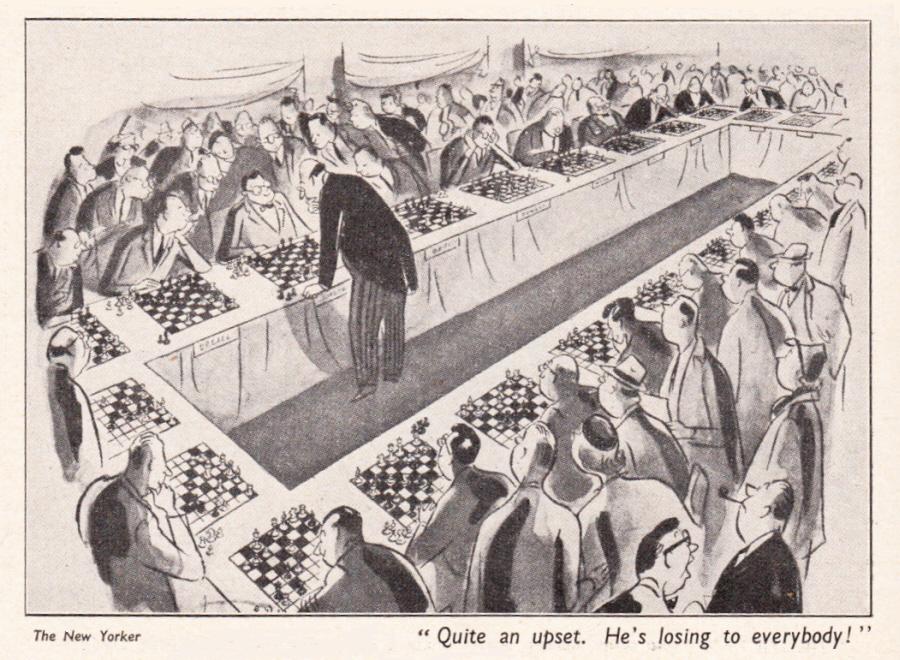
CHESS, January 1952, page 70
C.N. 8350 invited readers to submit the scores of simultaneous games in which they were involved.
From Bent Kølvig (Rødovre, Denmark):
Gideon Ståhlberg – Bent Kølvig
Copenhagen, 25 January 1952 (50 boards)
King’s Indian Defence
1 c4 Nf6 2 d4 g6 3 Nc3 Bg7 4 e4 d6 5 Nf3 O-O 6 Be2 Nbd7 7 O-O e5 8 Re1 Re8 9 d5 Nc5 10 Bf1 a5 11 g3 Bd7 12 Bg2 Qc8 13 a3 a4 14 Nh4 b6 15 f3 Nb3 16 Rb1 c5 17 Be3 Rf8 18 Bf1 Ne8 19 Bd3 Nd4 20 Bc2 Qa6 21 Bd3 Nc7 22 Ng2 b5 23 Bxd4 exd4 24 Nxb5 Nxb5 25 cxb5 Bxb5 26 Bxb5 Qxb5 27 f4 c4 28 Rc1 Rac8 29 e5 d3 30 Ne3 dxe5 31 fxe5 Bxe5 32 White resigns.
A clock simultaneous display in which Larsen scored +6 –3 =1:
Bent Kølvig – Bent Larsen
Copenhagen, 6 June 1957 (10 boards)
Benoni Defence
1 d4 Nf6 2 c4 c5 3 d5 e6 4 Nc3 exd5 5 cxd5 d6 6 e4 g6 7 Be2 Bg7 8 Nf3 O-O 9 Nd2 Ne8 10 O-O Nd7 11 f4 Rb8 12 a4 f5 13 exf5 gxf5 14 Nc4 Nb6 15 Ne3 Nf6 16 a5 Na8 17 Bd3 Ng4 18 Nxg4 fxg4 19 Be3 Nc7 20 Qc2 Qh4 21 Ne4 Ne8 22 Rab1 Bf5 23 Nxc5 Bxd3 24 Nxd3 Qh5 25 f5 Rxf5 26 Nf4 Qg5 27 Bxa7 Ra8 28 Ne6 Rxf1+ 29 Rxf1 Qxd5 30 Nxg7 Nxg7 31 Qf2 h5 32 Kh1 Re8 33 Bd4 Qe6 34 b4 Qe7 35 b5 Ne6 36 Qa2 Qd7 37 Qd5 Re7 38 a6 bxa6 39 bxa6 Rf7 40 Qa8+ Nd8 41 Rxf7 Kxf7 42 Qd5+ Qe6 43 Qxe6+ Nxe6 44 Bb6 Resigns.
Walter Shawn Browne – Bent Kølvig
Copenhagen, 3 July 1968 (28 boards)
Sicilian Defence
1 e4 c5 2 Nf3 e6 3 Nc3 a6 4 d4 cxd4 5 Nxd4 Qc7 6 Bd3 Nf6 7 O-O b5 8 Re1 Bb7 9 Bg5 b4 10 Na4 Qa5 11 Bxf6 gxf6 12 b3 Nc6 13 Nxc6 Bxc6 14 Nb2 Rg8 15 Nc4 Qc5 16 Qf3 f5 17 Qe3 Qxe3 18 Rxe3 Bc5 19 Rh3 fxe4 20 Bf1 d5 21 Ne3 Rg7 22 Kh1 a5 23 Rd1 a4 24 Rc1 Kd7 25 c3 axb3 26 axb3 bxc3 27 Rxc3 Bxe3 28 fxe3 Ra1 29 White resigns.
From Charles Milton Ling (Vienna):
David Bronstein – Charles Milton Ling
Vienna, 8 October 1967 (36 boards)
Sicilian Defence
1 e4 c5 2 Nc3 Nc6 3 Nf3 d6 4 d4 cxd4 5 Nxd4 Nf6 6 Bc4 Bd7 7 O-O g6 8 Bb3 Bg7 9 Bg5 h6 10 Be3 O-O 11 h3 Na5 12 f4 Nxb3 13 axb3 e5 14 Nf3 Bc6 15 fxe5 Nxe4 16 Nxe4 Bxe4 17 exd6 Bxb2 18 Bxh6 Qb6+ 19 Kh1 Rfd8 20 Ng5 Rxd6 21 Qb1 Bxg2+ 22 Kxg2 Rd2+ 23 Kh1 Be5 24 Nf3 Qe6 25 Kg1 Re2 26 Qd1 Bc3 27 Qd3 Qb6+ 28 Kh1 Qe6 29 Ng5 Qe5 30 Nf3 Qe6 31 Ng5 Drawn.
Victor Korchnoi – Charles Milton Ling
Vienna, 20 May 1970 (39 boards)
Queen’s Gambit Declined
1 d4 Nf6 2 c4 e6 3 Nc3 d5 4 Bg5 Be7 5 e3 O-O 6 Nf3 h6 7 Bxf6 Bxf6 8 Qb3 c6 9 O-O-O a5 10 cxd5 cxd5 11 Kb1 Bd7 12 e4 a4 13 Qc2 Qa5 14 exd5 exd5 15 Ne5 a3 16 Nxd7 Nxd7 17 Bb5 Nb6 18 Qf5 Qb4 19 Rd2 Bxd4 20 White resigns.
Philip Jurgens (Ottawa, Canada) supplies a photograph taken during his game against Spassky (1 e4 e6 2 d4 d5 3 Nc3 Bb4 4 e5 c5 5 a3 Bxc3 6 bxc3 Ne7 7 Nf3 Nbc6 8 a4 Qa5 9 Bd2 c4 10 h4 Bd7 11 h5 O-O-O 12 h6 gxh6 13 Rxh6 Rdg8 14 g3 Rg6 15 Rh5 Nf5 16 Bh3 Nce7 17 Ng5 Be8 18 Rxh7 Rh6 19 Rxh8 Rxh8 20 Kf1 Bxa4 21 Qc1 b5 22 Kg2 Rf8 23 Bg4 Qc7 24 Qa3 Rg8 25 Qb2 Rg7 26 Rh1 Ng6 27 Bh5 Nfe7 28 Qc1 Qd8 Drawn) in a simultaneous exhibition at the Bayshore Mall in Ottawa on 2 October 1995:
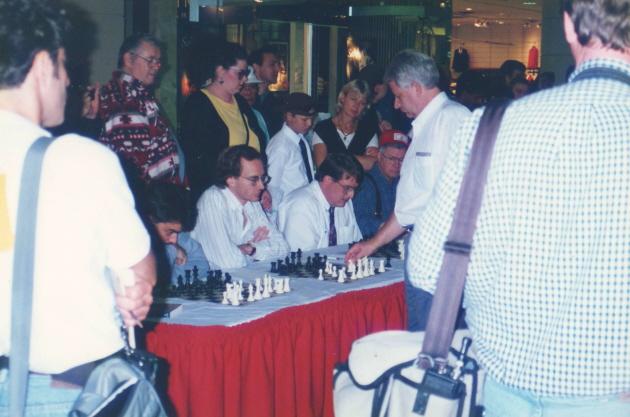
Mr Jurgens mentions that a report on the display on pages 42-44 of En Passant, December 1995 gave two games: Spassky’s draw with Herb Langer and his only loss, to Robert Inkol.
John Roycroft refers to his encounter, at the age 18, with Szabó in a 19-board display at the Gambit Chess Rooms, 4 Budge Row, London:
László Szabó – Arthur John Roycroft
London, 10 January 1948
Nimzo-Indian Defence
1 d4 Nf6 2 c4 e6 3 Nc3 Bb4 4 a3 Bxc3+ 5 bxc3 c5 6 e3 d5 7 cxd5 Nxd5 8 c4 Nf6 9 Nf3 O-O 10 Bd3 b6 11 O-O Bb7 12 Bb2 Nbd7 13 Qe2 Be4 14 Bxe4 Nxe4 15 Rfd1 Qc7 16 d5 exd5 17 cxd5 Qd6 18 Ne1 Rfe8 19 f3 Nef6 20 e4 Rac8 21 Rac1 h6 22 Qc4 Ne5 23 Bxe5 Qxe5 24 Nd3 Qb8 25 e5 b5 26 Qa2 c4 27 exf6 cxd3 28 Rxc8 Rxc8 29 Qb3 Qb6+ 30 Kh1 Qd4 31 h3 d2 32 Qb1 Qe3 33 d6 Rc1 34 d7 Rxd1+ 35 Qxd1 Qe1+ 36 Kh2 Qe5+ 37 Kg1 Qd4+ 38 Kf1 Qxd7 39 fxg7 Qd3+ 40 Kf2 Kxg7 41 f4 f5 42 Qa1+ Kf7 43 Qd1 Ke6 44 g4 fxg4 45 hxg4 Kd5 46 g5 Ke4 47 gxh6 Kxf4 48 h7 Qg3+ 49 Ke2 Qe3+ 50 Kf1 Qf3+ 51 Qxf3+ Kxf3 52 White resigns.
Our correspondent included the game, together with a photograph of the occasion, in his article ‘London Chess Haunts of the 1940s and 1950s’ on pages 30-33 of CHESS, May 1995.
At the end of C.N. 1264 John Nunn expressed a wish to see translations of ‘the many excellent foreign-language books which would be wholly new to British readers’.
A good example, we believe, is Le Maître de l’Attaque, an autobiographical games collection by V. Soultanbéieff (the accent is frequently forgotten). Published at the beginning of the 1950s, it has everything: an interesting personality relates a successful career which contained a remarkably high number of ‘brilliant’ games; good annotations and plenty of general comment. What more could one ask? The author sets the tone in the Introduction: ‘Jeu de position et de froid calcul soit, mais jeu de combinaisons de fantaisie créatrice avant tout!’ On page 25 there is a classic example of rook half-pins reminiscent of 27 Rd4!! in Capablanca-Tholfsen, Brooklyn, 1924; on page 94 a fine strategic achievement with a ‘tragi-comic’ finish in which Black’s remaining pieces are all trapped. A curiosity is the ending of Soultanbéieff’s game against William Winter (Black) at Ramsgate, 1929. Here is V.S.’s account (on page 187):

‘The former British champion is a pawn ahead but his pieces are out of play. White takes advantage of this to force an elegant draw: 41 f4! exf4 42 Rb3! threatening to win the rook by 43 Rf3. (43...Kh4 44 Rxf4+ Kh5 45 f3!) Drawn, on Black’s proposal. For if 42...Kh4 43 Rb4! Rh5 (forced) 44 f3! and now 44...Kg5 45 Rb6 and 44...g5 45 Ra4 offer nothing. An amusing position! As soon as the game was over, Capablanca, who was playing alongside, came rushing up to me: “But you could have won!", he said, firmly making the move 43 Rf3. “Ah, if it had been my move!", I replied with a sigh ...’
(1333)
P.C. Wood (Hastings, England) informs us that he is working on an English translation of Le Maître de l’Attaque, although he has not yet found a publisher.
(1349)
A book we strongly recommend is W.A. Whyatt’s Chess Problems by Bob Meadley (Belmore, 1979), published as a limited edition by Chess in Australia. Bill Whyatt (born 1914) was one of the country’s greatest problem composers. He lived virtually as a hermit, and the biographical section is a tour de force which makes skilful use of correspondence – honest and revealing except when Whyatt was being self-deprecatory. ‘Inside’ views of the problem world are uncommon.
Here is an ingenious three-mover by Whyatt which was published in the Weekly Times of 22 September 1954:
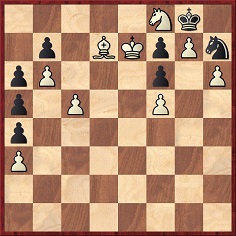
Whyatt’s end was tragic; in 1976 he took his own life.
(1339)
The solution is 1 Bc6. To quote from page 103 of the book:
‘You will see that there is mate in two if Black moves first; for if, in the set position, 1...Ng5, 2 Be8, and the knight must move to allow the mate. Therefore White has to find a waiting move. The pawn on b6 camouflages it, for after 1...PxB you will note that the pawn cannot queen and fulfil the contract. A delightful problem that will please both the beginner and the expert.’
(1347)
The gestation of the Saavedra study was documented in an article entitled ‘Wie was Saavedra?’ by J. Selman Jr. on pages 239-244 of the November 1940 issue of the Tijdschrift van den Koninklijken Nederlandschen Schaakbond. Thanks to a detailed summary in chapter 7 of Chess Curiosities by T. Krabbé it is now widely known how a position from an 1875 Fenton v Potter match-game was (incorrectly) recalled by Georges Barbier in the Glasgow Weekly Citizen of 27 April 1895, and then slightly changed the following week and called a draw for Black after 6 c8(Q). On 25 May 1895 Barbier gave the celebrated winning move found by Saavedra: 6 c8(R).
One sidelight of the affair seems to have been overlooked: the Fenton v Potter position was the basis for another endgame study which also gained fame in 1895. Following the death of George C. Heywood on 8 March 1895, the April issue of the BCM (pages 182-183) published the composition below, which Heywood had ‘regarded as his masterpiece’ in the realm of endgame studies:
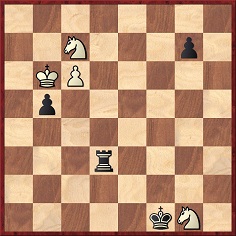
White to play and win
Solution: 1 Nd5 Rxd5 (or i) below) 2 c7 Rd6+ (or ii) below) 3 Kxb5 Rd5+ 4 Kb4 Rd4+ 5 Kc3 Rd1 (or iii) below) 6 Kc2 and 7 c8(Q).
i) 1...Ra3 2 Kb7 Ra1 3 Nc3 Rc1 4 Nge2. 1...Rd4 (or 1...Rd2) 2 c7 Rc4 (or 2...Rc2) 3 Ne3+.
ii) 2...Rg5 3 Nf3 Rg3 (or 3...Rf5) 4 c8(Q) Rxf3 5 Qg4 Rf7 6 Qd1+ Kf2 7 Qc2+ king moves to the eighth rank 8 Qb1+ king moves to the seventh rank 9 Qa2+ or 9 Qg6+.
iii) 5...Rg4 6 Nh3 Rg3+ 7 Kd2 Rxh3 8 c8(Q) Rg3 9 Qf8+ Kg1 10 Ke2 Rg2+ 11 Ke1 Kh2 (or 11...Kh1; ‘If here or at the 13th move the rooks plays away, then it or pawn must speedily fall.’) 12 Qh8+ Kg1 13 Qh3 g6 14 Qe3+ Kh2 (or 14...Kh1) 15 Qh6+ Kg1 16 Qh3 g5 17 Qf3 Kh2 18 Qh5+ Kg1 19 Qh3 g4 20 Qe3+ Kh2 21 Kf1.
By coincidence, the deaths of Heywood and Potter were announced on the same page (page 180) of the April 1895 BCM. Publication of Heywood’s study, the heading to which stated ‘Suggested by an Ending from actual play between Messrs Potter and Fenton’, may well have prompted Barbier’s attempt later the same month to recall the 1875 position.
(Kingpin, 1996)
Forever young
Games by three forgotten players who died prematurely about a century ago.
N.N. – Nikolai Egorovich Mitropolsky
St Petersburg, 1890
(Remove Black’s f-pawn.)
1 e4 c5 2 Qh5+ g6 3 Qxc5 Nc6 4 c3 e5 5 Qe3 Bh6 6 Qf3 Nf6 7 Na3 d5 8 Bb5 Bg4 9 Qg3 Bf4 10 Bxc6+ bxc6 11 Qd3 Nxe4 12 g3 Qb6 13 Qf1
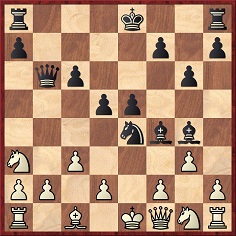
13...Qxb2 14 Qa6 Bxd2+ 15 Kf1 O-O 16 f3 Bxf3 17 Bxb2 Bg4+ 18 Nf3 Rxf3+ 19 Kg2 Rf2+ 20 Kg1 Bh3 21 Qxc6 Rf1+ 22 Rxf1 Be3+ 23 Rf2 Bxf2 mate.
Source: Deutsche Schachzeitung, July 1890, pages 205-206.
Nikolai Egorovich Mitropolsky died on 29 August the following year, about a fortnight before his 25th birthday.
Henry Holwell Cole – Norman Willem van Lennep
Occasion? (Match game, probably London, 1896)
Falkbeer Counter-Gambit
1 e4 e5 2 f4 d5 3 exd5 e4 4 Nc3 Nf6 5 Bc4 Nbd7 6 Qe2 Bd6 7 d3 O-O 8 dxe4 Bb4 9 Kf1 Bxc3 10 bxc3 Re8 11 e5 Nb6 12 Bb5 c6 13 dxc6 bxc6 14 Bxc6 Ng4 15 Nf3 Be6 16 Nd2 Nc4 17 Bxe8 Nce3+ 18 Kg1
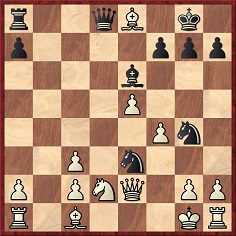
18...Nd1 19 Nf3 Nxc3 20 Qd2 Qb6+ 21 Nd4 Ne2+ 22 Kf1 Nxd4 23 h3 Bc4+ 24 Ke1 Ne3 25 Ba4 Nef5 26 c3 Ne6 27 Bc2 Ng3 28 Rb1 Qc5 29 Qe3 Nxh1 30 f5 Qe7 31 f6 Qc5 32 g4 Rd8 33 fxg7 Nf4 34 Be4 Qxe5 35 Bd2 Re8 36 Bxh1 Qxe3+ 37 Bxe3 Rxe3+ 38 White resigns.
Source: BCM, May 1896, pages 209-210.
The death of Norman Willem van Lennep occurred in September of the following year; he was in his mid-twenties.
The third player, Arved Heinrichsen, died aged 23 in Vilnius on 23 August 1900, a victim of tuberculosis.
Arved Heinrichsen – Habil Gazalch
Alexandria, January 1898
Queen’s Gambit Declined
1 d4 d5 2 c4 e6 3 Nc3 Nf6 4 Bf4 Bd6 5 Bg3 O-O 6 c5 Bxg3 7 hxg3 Re8 8 f4 Nc6 9 Nf3 b6 10 cxb6 axb6 11 Qc2 Na5 12 e4 h6 13 e5 Nd7 14 b4 Nb7 15 Bb5 Qe7 16 Ng5 Qxb4 17 Rxh6 Kf8
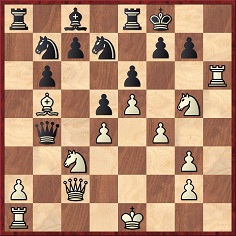
18 Qh7 Qxc3+ 19 Ke2 Qb2+ 20 Kf3 Ra3+ 21 Kg4 Qxa1 and White announced a neat mate in seven: 22 Qh8+ Ke7 23 Rxe6+ fxe6 24 Qxg7+ Kd8 25 Nf7+ Ke7 26 Nd6+ Kd8 27 Nxb7+ Bxb7 28 Qxd7 mate.
Source: Schachjahrbuch für 1899, II. Theil, by L. Bachmann, pages 111-112.
(Kingpin, 1997)
Spanish chess books are renowned for their misprints, but the title page of Joyas del Ajedrez Postal (1930-1947) by E.J. Marchisotti (Buenos Aires, 1952) has an appropriate misquotation of Keats: ‘A think of beauty, is a joy for ever.’
(Kingpin, 1997)
The December 1977 Badmaster column reported that R.P. Michell had once said that he had never succeeded in producing a presentable game. [See Chess Pie, 1922, page 35.]
(1337)
Another example:
‘With typical droll modesty he said that he had a unique record for one who had played successfully in the Gastineau Cup for some time: he never won a single game of which he could be mildly proud.’
Source: obituary of E.G.R. Cordingley in the February 1963 BCM, pages 46-47.
(1481)
‘I don’t think I have ever played a really good game, and maybe I shouldn’t want to either, because it doesn’t cause real pleasure.’
J.H. Donner in Schaakbulletin 75/76 (March 1974), given on page 193 of his book The King (Alkmaar, 1997).
When presenting the above quotes, we mentioned in a footnote on page 379 of Kings, Commoners and Knaves that Sir George Thomas had made a similar remark:
‘I have never played a game that completely satisfied me.’
For that Thomas remark The Best Chess Games.
From Jeremy Gaige (Philadelphia, PA, USA):
‘How is Tartakower’s first name spelled? Savielly in his BCM obituary, on the dust jacket of My Best Games, 1905-1930, etc. Saviely, according to the Higher Criticism (The Oxford Companion to Chess and Chess: the Records), and Xavier in the French sources (he did die in France as a French citizen?). And in that case, is his name spelled Tartacouver? As it is, half my archives now have Savielly and the other half Saviely.’
T.’s signature appears on page 5 of the January-February 1907 Wiener Schachzeitung: ‘Savielly Tartakower’, a spelling he was still using at London, 1922 (see page 95 of Fred Wilson’s A Picture History of Chess). The Dictionnaire des échecs favoured Tartakover, as did R.N. Coles. We would welcome information on how T. himself wrote his name in the last phase of his life.
Another question: should the way a person spells his name automatically be followed? We write ‘Janowsky’ because that is how J. himself signed his name (see the BCM 1980, page 339), but [most other people use] Janowski. A further complication arises when somebody chooses to change the spelling himself, as did Alekhine. (Perhaps Janowsky did too – if so, details would be appreciated.) Should the way somebody was spelling his name at the end of his life be taken as the ‘proper’ spelling for his whole career? ...
Categorical judgements are rarely possible ...
(1342)
Rob Verhoeven (The Hague, the Netherlands) comments on Janowsky/Janowski’s signature.
‘To me it is very clearly Janowski. The y is an i with a horizontal finish and then downwards. The v is a w, but Janowski signs the s very close, and therefore unclearly, to the w, so that it looks as if the letters are different. La Stratégie always used the spelling Janowski.’

(1702)
John Owen (Avon, CT, USA) sends us a copy of a letter, in French, written to him by Tartakower on 28 January 1956 (i.e. eight days before Tartakower’s death). The signature is ‘Dr. S.G. Tartakower’.
(1703)
The Tartakower letter was reproduced in C.N. 5211.
From Ken Whyld (concerning C.N. 1702):
‘Janowski’s signature no. 4 looks spurious to me. The J is quite unlike the others. I have no doubt that Janowski is correct, but may well not have been consistent.’
(1777)
Hanon Russell (Milford, CT, USA) informs us that his archive collection (C.N. 1790) contains many specimens of the signatures of Janowsky and Tartakower.
Janowsky: ‘An examination of 21 signatures from the New York 1924 original scoresheets (item 2633 in the Russell Collection) shows nine clearly as “Janowski”, four clearly as “Janowsky” and eight illegible, although were I to guess, I would say that most of the eight illegible signatures probably were of the “Janowski” variety.’
Tartakower: ‘Of almost three dozen original signatures examined, not a single instance was found where he deviated from Tartakower. They cover a time-span from 1923 to the end of 1926. In addition, I refer you to Item 1206 in my collection: despite my phonetic entry, first-hand examination of this business card reveals a “w”, not a “v”. Conclusive? If not, close to it.’
(1866)
A further contribution from Jeremy Gaige:
‘The spelling of people’s names seems to be determined by: 1) geography, 2) the [name] owner’s personal preference, and 3) the preference of those who write about him or her.
1) Geography: I am not surprised, for example, that Tartakower spelled his name that way in the 1920s, when he was living in Vienna (or should I say Wien?). By 1932, however, he was residing in Paris, spent the years of World War II in England, then returned to France, and died in Paris in 1956.
2) Personal preference: Hanon Russell’s approach is certainly the right one, but I think he is wrong to conclude that his samples “from 1923 to the end of 1926” offer close-to-conclusive evidence of how Tartakower spelled his name during the course of the nearly 69 years of his life. It would, therefore, be interesting to know how Tartakower spelled his name in the last decade of his life. (Personal preference is often determined by geography: Milan Vukčević (JUG) has become Vukcevich (USA). When, if ever, did Wilhelm Steinitz become William Steinitz? More fundamentally, in such cases, how does one define “nationality”? Steinitz was born in Prague when it was part of the Austro-Hungarian Empire, but it is now the capital of CSR; he spent many years in England, then became a citizen of the USA and died there.)
3) Preference of those who write about him:
– Tartakower: My Best Games of Chess; The Oxford Companion to Chess; all German references that I have seen;
– Tartakover: Dictionnaire des échecs; Sunnucks’ Encyclopaedia; Şah de la A la Z; Chess: An Annotated Bibliography; Gaige’s Chess Personalia (though with no great confidence: the more knowledge, the less certainty).
How, I wonder, was his name spelled in his French newspaper obituaries?
I submit that No. 3 is at once the most pervasive but the least valid influence (which is seen more clearly – and less defensibly – in place names). I will not labor this point since it has already been covered (see C.N. 571 and C.N. 604).’
In answer to Mr Gaige’s question, when Tartakower’s death was briefly reported in Le Monde of 8 February 1956 (page 6), the spelling used was ‘Xavier Tartakower’.
(1873)
Ken Whyld sends us the following specimens of Janowsky’s name from a letter (Vienna, 12 November 1896). The first is the heading to a game-score included in the document and the second is the closing signature.

K.W. comments that the autograph ‘demolishes my suspicion about the one you gave last year (see C.N.s 1702 and 1777). He must have changed his style’.
(1874)
See also Janowsky Jottings and Over and Out.
Kingpin uses impiety and parody to hew down the conventions of publishing, even including mock testimonials on its front cover (‘Leaves my game shiny, manageable, natural looking’, ‘Just thick enough to stop my table wobbling’). Many top British players contribute game annotations and articles, a memorably acerbic example of the latter being Tony Miles’s ‘Has Karpov Lost His Marbles?’ in issue 9. This form of satire (good jokes making serious points) is, we believe, the way ahead for Kingpin; certainly, there is plenty in British chess circles to be satirical about.
(1415)
A brief item on page 105 of the May-June 1927 American Chess Bulletin:
‘There was a time when it “paid” to compose chess problems and have them published. In the Irish Chess Chronicle for 15 December 1887 we find this interesting announcement:
“From this date every composer whose original problem appears in our pages will receive 2s 6d at once on publication; tourney and other such special problems of course excepted.”
Contrast the above with an extract from the current issue of the Chess Amateur:
“Recently a well-known German chess column notified problemists who had been receiving reprints that in future they would have to pay.”’
(1533)
The following paragraph appeared on page 97 of the March 1897 BCM:
‘The Anglo-American Cable Chess Match. Curious Anagram by Rev. Roger J. White. – English players: “Atkins, Bellingham, Blackburne, Blake, Cole, Jackson, Jacobs, Lawrence, Locock, Mills.”
Anagram: “Look back, beckon, call all back! Man rejoices; noble J. Bull’s crack English team wins!”
The above was composed anterior to the match.’
England won the match by 5½ points to 4½.
Perhaps C.N. readers can invent some examples of their own. The laws of libel and good taste should be respected – anagrams cannot be edited ...
(1545)
Bob Meadley (Narromine, NSW, Australia) raises the subject of chess publications of which copies can no longer be found:
‘The Gawler Chess Journal 1894 is gone forever; so also, it seems, is a publication by A.L. Henniques, The Games of the Intercolonial Chess Match – Melbourne versus New South Wales played by Electric Telegraph on November 9th 1870 and published by him in 1871, 8vo, 12 pages. It may be wondered if van der Linde noted it in a German Library for his Geschichte und Litteratur [sic] des Schachspiels (see volume 2, page 91).’
(1637)
Another example is Libre dels jochs partitis dels schachs en nombre de 100 by Francesch Vicent (Valencia, 1495). See The Companion’s entry on Vicent.
(1686)
Tom Testa (Alameda, CA, USA) raises the subject of the longest-serving newspaper chess columnist, informing us that George Koltanowski has been writing for the San Francisco Chronicle since 10 May 1947. Although the column appeared weekly at first, since about November 1947 it has enjoyed an unbroken run as a daily feature. Our correspondent has been able to verify these facts with Koltanowski.
See, however, Chess Records.
(1644)
Inaccuracy, superficiality and bias are the hallmarks of many chess columnists, but it is unlikely that anybody (even David Spanier in the Daily Telegraph) embraces all three characteristics to quite the same degree as Patrick Séry in the Parisian weekly magazine L’Evénement du jeudi.
(1645)
A walk-over.
(1646)
There has been confusion about the exact death-date of Mikhail Yudovich (senior). See, for instance, pages 147-148 of the April 1988 BCM. Božidar Kažić (Belgrade, Yugoslavia) sends us a copy of a letter he received from the deceased’s wife:
‘After we returned to Moscow [from holiday – B.K.] he started to work with his full force, as usual. On 19 September we celebrated the birthday of Boris [their son – B.K.] and at the table he became ill. Doctors came and they fought for three hours to save him, but without success (heart attack). And so we lost our dear pater familias and your best friend, who loved you so much because of your goodness and honesty.’
(1707)
An ad hoc quiz question: who wrote Modern Chess Strategy?
Obvious answers are Edward Lasker and Ludĕk Pachman. At a pinch it could also be Tartakower (because of his 1932 collection of Bernstein’s games, Moderne Schachstrategie).
We have in mind another Modern Chess Strategy, published anonymously by the Daily Express with the subtitle ‘33 master games by master minds’. The games, like the book itself, are undated. Betts’s Bibliography (page 271) says that the editor of the book was Paley-Hughes, the publication date being 1932, although the source of this information is not clear.
Further details are requested. More generally, we should be interested to know of other cases of anonymous authorship of twentieth-century books.
(1743)
C.N. 12148 shows that the Daily Express announced on 17 January 1931 that Modern Chess Strategy had just been published. The obituary of W.A. Paley-Hughes on pages 131-132 of the March 1937 BCM did not mention it.
B.H. Wood of Sutton Coldfield died on 4 April. He edited for over half a century, and during its first decade the magazine may well have been the best in the world.
(1863)
See too Rebuttals.
Richard Forster (Winterthur, Switzerland) submits the following position, which appeared in Informator No. 49, with annotations by Krogius:

Belik v Igonin, USSR, 1990
It is stated that White won by 1 Nb4 c4+ 2 Ka3 d3 3 Bxc4 bxc4 4 Na2+ Kd1 5 Nc3+ Kc1 6 Ka2 d2 7 Ka1 d1(Q) 8 Na2 mate.
In reply to a query from us, John Roycroft states that he believes the position to be a study by V. Pachman, published in 1935 in Československý Šach. Confirmation is sought, as well as an explanation of the game version given by Informator.
(2086)
We now have the 1935 Československý Šach and can confirm that the position claimed by Informator No. 49 to be from a game between Belik and Igonin was the mirror-image (i.e. with the white king on g3 instead of b3) of a study by V. Pachman(n) published on page 72 of the April-May 1935 issue of the Czech magazine:
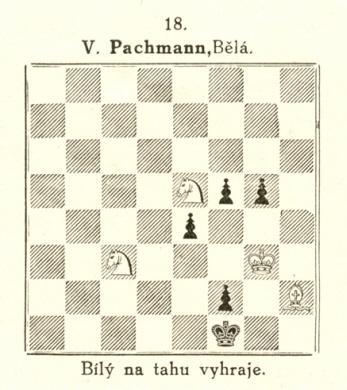
(2107)
Dr P.C. Wason (Goring-on-Thames, England) sends the following extract from Metamagical Themas by Douglas R. Hofstadter (London, 1985), pages 208-209:
‘A brilliant chess move, once the game is over and can be viewed in retrospect, can be seen as logical – as “the correct thing to do in that situation”. But brilliant moves do not originate from the kind of logical analysis that occurs after the game; there is no time during the game to check out all the logical consequences of a move. Good chess moves spring from the organization of a good chess mind: a set of perceptions arranged in such a way that certain kinds of ideas leap to mind when certain subtle patterns or cues are present. This way that perceptions have of triggering old and buried memories underlies skill in any type of human activity, not only chess. It’s just that in chess the skill is particularly deceptive, because after the fact, it can all be justified by logical analysis, a fact that seems to hint that the original idea came from logic.
Writing lovely melodies is another one of those deceptive arts. To the mathematically inclined, notes seem like numbers and melodies like number patterns. Therefore all the beauty of a melody seems as if it ought to be describable in some simple mathematical way. But so far, no formula has produced even a single good melody. Of course, you can look back at any melody and write a formula that will produce it and variations on it. But that is retrospective, not prospective. Lovely chess moves and lovely melodies (and lovely theorems in mathematics, etc.) have this in common: every one has idiosyncratic nuances that seem logical a posteriori but that are not easy to anticipate a priori. To the mathematical mind, chess-playing skill and melody-writing skill and theorem-discovering skill seem obviously formalizable, but the truth turns out to be tantalizingly more complex than that. Too many subtle balances are involved.’
(1498)
Ken Whyld (Caistor, England) comments:
‘This touches on a matter which is completely ignored in most creative and sporting activities. What the great performers say afterwards is not what motivated them at the moment of truth, and never can be. Chess students are perhaps the most easily deceived because they believe chess to be entirely logical. But at a high level there are so many other factors which can never be captured in words. So what we get is a verbal justification for a move, and we can never know what really triggered it. Behind that insight lies, for me, the real importance of computer research into chess.’
(1571)
Can a reader reassure us about the correct forename of the Austrian writer Dr J. Hannak? His practice in books and magazine articles was to use the initial only. The BCM obituary (January 1974, page 5) gives Jacques. However, writing from New York City on 5 September 1945 (to the BCM, October 1945, page 239) he signed his name ‘John J. Hannak’.
(1528)
Ed Tassinari (Scarsdale, NY, USA) informs us that page 4 of the March 1947 Chess Review contains a letter from Hannak in Vienna. He signed his name ‘John J. Hannak’.
(1574)
Establishing that an apparently new opening move is a genuine ‘theoretical novelty’ is a perilous affair. As Alekhine wrote on page 16 of the English edition of his book on New York, 1924:
‘In these days one can hardly make such a claim for, sooner or later, some person will come forward and prove black on white that he used this move decades ago in some class C tournament or perchance in a coffee house game and hence demand parental recognition.’
The Argentine Variation is 1 d4 d5 2 c4 e6 3 Nf3 Nd7 4 Nc3 Ngf6 5 Bg5 c6 6 e3 Qa5 7 Nd2 Bb4 8 Qc2 O-O 9 Bh4. A different order of moves is possible, but the above is how play went in the seventh match-game between Capablanca and Alekhine at Buenos Aires in 1927. Some comments on White’s ninth move:
Strangely, the ‘instant’ commentators were less categorical. Becker wrote on page 286 of the October 1927 Wiener Schachzeitung:
‘This rarely played move is, according to Dr Tartakower’s nomenclature, a prophylactic retreat’ (ein Präventivrückzug).
Soultanbéieff said on page 743 of the October 1927 issue of L’Echiquier:
‘9 Bh4! Is this inspiration or the fruit of painstaking preparation? But has not the world champion stated that he does not prepare for tournaments, that he does not study theory and that he does not need to cram his head with the infinite number of variations which the throng of theorists is forever launching onto the chess “market”, for he is certain at the board to find the best move in each position?’
On page 512 of the December 1927 BCM, J.H.Blake noted with regard to 9 Bh4 c5:
‘The ninth move on each side was played in the Györ Tournament (1924) in a game between Havasi and Astalos [sic – Asztalos] ...’
It needs to be pointed out that Maróczy played 9 Bh4 over 20 years before the Buenos Aires match. One of Daly’s handwritten game-scores sent to us by Richard Lappin (Jamaica Plain, MD USA) – i.e. not in the Lyman/Dann book – is the following:
Géza Maróczy – Harlow Bussey Daly
Boston, 4 April 1906
Queen’s Gambit Declined
1 d4 d5 2 c4 e6 3 Nc3 Nf6 4 Bg5 Nbd7 5 e3 c6 6 Nf3 Qa5 7 Nd2 Bb4 8 Qc2 O-O 9 Bh4 Ne4 10 Ndxe4 dxe4 11 Be2 e5 12 O-O f5 13 c5 exd4 14 exd4 Nf6 15 Bc4+ Kh8 16 Ne2 Bd2 17 Rad1 Bh6 18 f3 Bd7 19 Bxf6 exf3 20 Be5 fxe2 21 Qxe2 Bg5 22 a3 Rae8 23 Qd3 Bf6 24 Bd6 Be7 25 Bg3 Bg5 26 Rde1 Qd2 27 Rxe8 Rxe8 28 Qxd2 Bxd2 29 Be5 Be3+ 30 Kh1 h6 31 h3 Kh7 32 g4 f4 33 Kg2 Be6 34 Bxe6 Rxe6 35 Kf3 g5 36 Ke4 Kg6 37 b4 Kf7 38 a4 a6 39 b5 axb5 40 axb5 Re8 41 bxc6 bxc6 42 Rb1 Bf2 43 Kf5 Bh4 44 d5 cxd5 45 c6 f3 46 Rb7+ Re7 47 Rb1 f2 48 c7 Re8 49 Rf1 Rc8 50 Bd6 Ke8 51 Ke6 d4 52 Be5 d3 53 Kd6 Ra8 54 Kc6 Rc8 55 Rd1 Ke7 56 Kb7 Resigns.
This fine game may not have appeared in print before.
(1536)
The Maróczy game was played at the Boston Chess Club, the master’s score being +15 –5 =4 (American Chess Bulletin, May 1906, page 85).
(1600)
C.N. 1626 reproduced in full our exchange of correspondence in April 1988 with Mr Jonathan Tisdall. A curious sideline illustrates how he conducted himself:
J.T. to E.W. (undated):
‘In closing, I would like a copy of the Schultz newsletter, in particular as I have mislaid his address.’
E.W. to J.T. (19 April 1988):
‘Under separate cover I am sending you a copy of the newsletter you request. It is curious that an American journalist who boasts about his proficiency should be unaware that Mr Schultz’s address is published on the title page of Chess Life every month.’
J.T. to E.W. (22 April 1988):
‘Finally, for your final snide remark: I do not receive CL, except on the rare occasions I write for it, when I simply file it.’
E.W. to J.T. (30 April 1988):
‘Since you say that you never bother to read Chess Life, let me inform you that its title page has been describing you as a “Contributing Editor” for the past two years.’
We heard no more from Mr Tisdall.
The following game is to be found on pages 10-11 of Chernev’s 1000 Best Short Games of Chess, as well as pages 96-97 of Chess Traps, Pitfalls and Swindles by Horowitz and Reinfeld:
N.N. – Beis
Germany, 1940
Falkbeer Counter-Gambit
1 e4 e5 2 f4 d5 3 Nf3 dxe4 4 Nxe5 Nc6 5 Bb5 Nf6 6 Nxc6 bxc6 7 Bxc6+ Bd7 8 Bxa8 Bg4 (‘Boom! There goes the Queen and the game’ – Chernev.)
However, in Chess Life & Review, August 1978 (page 438) a reader, Don Reckseen, pointed out that White could keep going with 9 Bxe4 Bxd1 10 Bc6+, followed by 11 Kxd1. Confirming this, John Peters gave the line 9...Qe7 10 d3 and said that instead of 8 Bxa8 White could have achieved approximate equality with 8 Bxd7+ Qxd7 9 d3. We note that page 8 of Falkbeer Counter Gambit edited by Colin Leach says that the moves up to 8...Bg4 also occurred in a game Tartakower v Gruber, Vienna, 1919.
(1656)
Nigel Freeman (Berkhamsted, England):
‘With all the money the Grandmasters’ Association appears to have raised from its tournaments, why hasn’t some been spent on getting out good tournaments for each tournament? Surely one of the participants or an outside grandmaster or two could provide us (and the players) with works which would give the events long-lasting fame. When was the last tournament book published in England by any major publisher? The Chequers books are the only ones that come to mind since Pergamon did London, 1980. (Batsford did do the USSR v Rest of the World match.) Prior to that (RHM apart) I can only think of Batsford’s two in the 1973 post-Fischer boom.’
(1691)
‘Where? When?’, ask C.W. Pritchett and M.D. Thornton on page 61 of Scotland’s Chess Centenary Book with regard to the following game between Mackenzie and Hammond. ‘Little is known about this game. It is not even absolutely certain that it was played by “Captain” Mackenzie.’ Can readers provide further information?
Mackenzie – Hammond
Occasion?
Petroff Defence
1 e4 e5 2 Nf3 Nf6 3 Nxe5 d6 4 Nf3 Nxe4 5 d4 d5 6 Bd3 Bd6 7 O-O O-O 8 c4 c6 9 cxd5 cxd5 10 Nc3 Nxc3 11 bxc3 Bg4 12 Rb1 Qc7 13 h3 Bh5 14 Bxh7+ Kxh7 .15 Ng5+ Kg6 16 g4 Bf4 17 Rxb7 Qxb7 18 Bxf4 Rh8 19 Qd3+ Kf6 20 Re1 Bg6
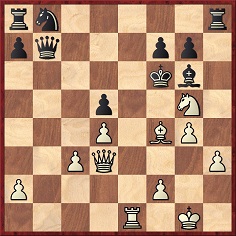
21 Nh7+ Rxh7 22 g5 mate.
(1721)
From page 309 of Kings, Commoners and Knaves:
The game was given on page 75 of Ellis’ 1895 book Chess Sparks with the heading ‘Played before 1876 ... G.H. Mackenzie v Hammond’. Jacques N. Pope (Ann Arbor, MI, USA) has informed us that the game was published in the chess column of The Albion on 21 April 1866, although no venue was stipulated. We have now also seen that it appeared on pages 78-79 of the Chess World, 1866, with the heading ‘played at the Boston Chess Club’.
A contribution from John Hilbert (Amherst, NY, USA) dated 6 June 2022:
‘The Mackenzie v Hammond game also appears on pages 85-86 of Social Chess by James Mason (London, 1900), as well as in Stanley’s column, Turf, Field and Farm, 15 December 1866. Stanley identifies it as “Game Played at the Boston Chess Club”. This, however, was reprinted from the Chess World. The position after 13…Bh5, and to the game’s conclusion, was reprinted 20 years later in the Brooklyn Union, 4 July 1886. Both these latter sources are available at the Chess Archaeology website. Mackenzie appears to have been in regular correspondence with Staunton during the period 1865-67. I traced over 35 of his games appearing in the Chess World. I found no reference to Mackenzie visiting Boston in 1866. Much later in his life, Mackenzie said that he had visited Boston over 20 times, and yet I could find reference in contemporary sources to fewer than half of these trips. Mackenzie thought highly of the Boston player, and the two were closely connected as early as 1864. I have some reason to believe that Reichhelm and Hammond may have been the men who helped Mackenzie, perhaps providing funds after his release from military prison in the spring of 1865, but I have no direct proof that that was the case.’
Pages 21-23 of Le Lionnais’s book Les prix de beauté aux échecs reports on a competition organized in 1908 by the Hampstead and Highgate Express to find the best invented game, pointing out that the standard was well below that of genuine brilliancy prize games.
Can readers point out any truly brilliant invented games?
(1772)
For readers who do not have Le Lionnais’s book Les prix de beauté aux échecs, Ed Tassinari points out that Irving Chernev gave the scores of invented games in the February 1955 Chess Review.
(1881)
A game with some pretty play, but how sound was it?
João Caldas Vianna – A. Silvestre
Rio de Janiero, February 1900
Evans Gambit Accepted
1 e4 e5 2 Nf3 Nc6 3 Bc4 Bc5 4 b4 Bxb4 5 c3 Ba5 6 d4 exd4 7 O-O d6 8 Qb3 Qf6 9 e5 dxe5 10 Re1 Bd7 11 Bg5 Qf5 12 Nxe5 Nxe5 13 f4 f6 14 Qxb7 Rd8 15 fxe5 fxg5 16 Rf1 Qxe5 17 Nd2 Ne7 18 Rae1 Qc5 19 Bf7+ Kf8 20 Bg6+ Bf5 21 Bxf5 Nxf5 22 Ne4 Qb6 23 Rxf5+ Kg8
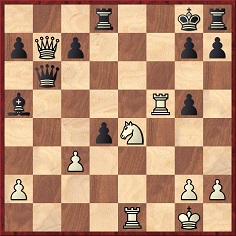
24 Nd6 dxc3+ 25 Kh1 h6 26 Qd5+ Kh7 27 Qe4 Kg8 28 Qe6+ Kh7 29 Rf6 Rhf8 30 Qf5+ Kg8 31 Rxf8+ Rxf8 32 Qxf8+ Kxf8 33 Re8 mate.
Source: American Chess Bulletin, January 1922, page 13.
Not the least attractive point of 24 Nd6 is the threat of 25 Qd5 mate. In the American Chess Bulletin, C.S. Howell claimed that Black would lose a piece after 24...Qxb7 25 Nxb7, but Lasker’s Manual of Chess (pages 141-142) said that Black should have parried with 24 Qxb7 25 Nxb7 Bxc3 26 Nxd8 Bxe1 27 Re5 Bb4.
(1852)
Our endnote on page 259 of Chess Explorations:
The venue and date of this game were not available when C.N. 1852 was written. We have since found them on page 179 of the June 1900 Deutsche Schachzeitung.Ståhlberg annotated the game on pages 37-39 of the February 1931 Tidskrift för Schack. Instead of Lasker’s 26 Nxd8 he proposed, with analysis, 26 Re7.
The following are the last two paragraphs of the final C.N. item of the magazine’s run (1982-89). It was dated 3 December 1989:
Although decades are artificial historical divisions, it is tempting to offer a few general thoughts on chess in the 1980s. The balance-sheet, we feel, is decidedly mixed. On the negative side are mainly ‘literary’ matters. For English-language chess books, at least, there are far fewer commercial publishers than in the 1970s. A sizeable share of the remaining market is being hogged by a clique. Production standards have fallen. Illiteracy has risen. Scandalmongers populate even ‘prestigious’ journals. Many outlets lack independence. Careless mistakes abound. To state the obvious, everybody errs from time to time, but as Capablanca wrote in My Chess Career (in the context of annotators), ‘even the best are not exempt from mistakes, but while they make them few and far between the others do so continuously’. A wretched development is the journalist-cum-politician, who seeks not truth but power. Increased financial stakes have meant increased ruthlessness, to say nothing of unequal shares. Rational, in-depth discussion is a rarity. Chess history remains a very poor, neglected relation.
It is a relief to turn to the plus side. In Kasparov and Karpov, we are privileged to have, in their prime, two of the game’s finest-ever practitioners. The top players meet more regularly over the board than did most of the greats of yesteryear. At almost all playing levels, there seems to be unprecedented chess activity. The Third World has made significant advances. Whatever the inequalities, masters who devote their lives to the game have a better chance than before of earning the decent living they deserve. The Polgár sisters continue to perform wonderfully, breaking down sexist barriers simply by playing strong moves. Chess computers are now winning games from masters. Data-processing equipment is transforming the dissemination of chess information and can put some order into the game’s archives (collation of old games, indexing of sources, etc.). At their best, game annotations are deeper and franker than in the past. The means exist for topical reports, whatever their value, to travel faster than ever. ‘Pulsating’ is certainly the word to describe the Chess World of the 1980s – the best of times and the worst of times.
(1933)
Who was the first player to give a simultaneous exhibition at sea? According to page 296 of the 14 April 1936 issue of CHESS:
‘Did you know ... that the first simultaneous display on board ship was given by Dr Tartakower on the Massilia in the Mediterranean, 1931? Also he is the only person to have given a simultaneous exhibition in an aeroplane – between Budapest and Barcelona in 1929.’
However, some years later (November, 1944, page 19) the same magazine quoted from the May-June 1944 Iowa Chess Correspondent the reminiscences of Norman W. Bingham, a boyhood friend of Pillsbury’s. The two crossed the Atlantic together in 1899:
‘... Pillsbury played a dozen blindfold simultaneous games against various passengers, winning them all handily. The tables were in the smoking room and Pillsbury sat with me on deck, talking about early school days. Stewards from the smoking room flitted back and forth with paper memoranda to communicate the moves from the various tables. I tried to get Harry to tell me how he did it, but he couldn’t; and I don’t believe he knew himself. He said he didn’t carry a picture of the various tables in his mind and he didn’t memorize the moves. He seemed to just know, when told what the move had been on one table, what he wanted to do. At any rate, if he was able to tell me how he did it, he successfully refrained ...’
Pages 356 and 373 of K. Landsberger’s 1993 book on Steinitz mention small displays by Steinitz during Atlantic crossings, in 1897 and 1898.
(1947)
Epifanio Nieto (Madrid) points out that the 1907 New York State tournament was played on board S.S. Alexandria, plying between Charlotte, NY and Quebec. The event was won by Finn.
Source: American Chess Bulletin, August 1907, page 146.
(2058)
José Pérez Mendoza – Henneberg
On board the König Frederick August, 4 May 1912
Ruy López
1 e4 e5 2 Nf3 Nc6 3 Bb5 a6 4 Ba4 Nf6 5 O-O b5 6 Bb3 d6 7 Ng5 d5 8 exd5 Nxd5 9 Nxf7 Kxf7 10 Qf3+ Ke6 11 Nc3 Ne7 12 d4 c6 13 Re1 Kd6 14 Nxd5 Nxd5 15 Rxe5 Be6 16 Bf4 Nxf4 17 Qxf4 Bxb3
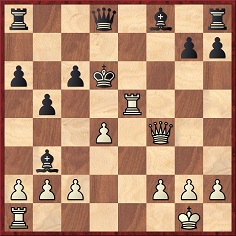
18 Rd5+ Kxd5 19 Qe5+ Kc4 20 axb3+ Kb4 21 Qe1 mate.
Source: El Ajedrez en la Argentina by J. Pérez Mendoza, pages 363-364.
(2083)
See pages 111-113 and 260-261 of Kings, Commoners and Knaves for two other games played on board ship.
One of the longest books in recent years is Le Guide des échecs by Nicolas Giffard and Alain Biénabe. Its 1,592 pages cover most aspects of chess and include about 500 pages by Mr Biénabe on problems and studies. One defect immediately stands out: published in 1993, the book is badly out of date. For example, the item on the Grandmasters’ Association (pages 887-888) is unaware of the departure, back in 1991, of Bessel Kok. (Over the years, the GMA seems to have endured more resignations than Colonel Moreau.)
It soon becomes clear that any pseudo-fact, apocryphal anecdote or unplayed game that has been published in an easily accessible source is liable to be snitched and repeated by Mr Giffard. In the section on miniature games, for instance, he attributes a spurious skirmish to Napoleon, still believes that the Gibaud v Lazard game occurred, and trims a 32-move Capablanca game into an 11-move miniature. In the ‘History of the Chess Champions’ part, he unwisely lifts whole wodges from his own 1978 book La fabuleuse histoire des champions d’échecs. Many mistakes thus recur, even regarding such plain matters as Marshall’s introduction of his Ruy López gambit. In his earlier volume Mr Giffard showed no awareness of chess research undertaken before 1978. In Le Guide des échecs he disregards all research carried out before and after that date. His Bible, frequently quoted in both books, remains Harold Schonberg’s Grandmasters of Chess
(1964)
Regarding a subsequent edition of the book (Paris, 2009) see C.N. 6392.
The final paragraph of C.N. 1966 (see above) referred to contradictory versions of a game between Morphy and Maurian. We have now found the score in a nineteenth-century source: it was the first of three Morphy games ‘recently published for the first time in the New Orleans Times-Democrat’ which appeared on pages 90-91 of the 15 March 1887 issue of the Brooklyn Chess Chronicle. The date indicated (9 May 1864) corresponds to Lawson’s, and the conclusion is given as 30...Bxf2+ ‘and Black wins’.
The third of these games is relevant to a matter raised by John T. Campbell (Arlington, VA, USA), who asks us about the accuracy of the following passage on page 76 of Blackmar-Diemer Gambit by Eric Schiller (Coraopolis, 1986):
‘In an article “Paul Morphy – Spiritual Father of the Blackmar-Diemer Gambit” Diemer makes reference to the game Morphy-Blackmar, New Orleans 1866, which saw [1 d4 d5 2 e4 e6] 3 Nh3!?. Now this is a move in true gambit style. After 3...dxe4 4 Bc4 Nf6 5 O-O b6 7 6 f3 e3 7 Bxe3 Be7 White has reestablished material equilibrium.’
We have no knowledge of Morphy playing Blackmar, but page 91 of the Brooklyn Chess Chronicle of 15 March 1887 has a queen’s knight odds game between Morphy and C.A. Maurian, played at New Orleans in 1866, which followed the same line as far as 7 Bxe3 Be7. At move six a note says: ‘As the New Orleans Times-Democrat remarks, the position is now very similar to one that occurs in the Blackmar Gambit.’ The Chronicle gives the opening moves as 1 e4 d5 2 d4 e6, but 1 e4 e6 2 d4 d5 3 Nh3 is the order in later sources.
(2044)
Tom V. Purser (Headland, AL, USA) reports that on pages 14-15 of issue 31 of his periodical Blackmar-Diemer Gambit World (May 1988) he and Anders Tejler discussed the question raised in C.N. 2044, concluding that the erroneous idea of a game between Morphy and Blackmar arose from a faulty reading by Eric Schiller of page 164 of E.J. Diemer’s (reprinted) book Das moderne Blackmar-Diemer Gambit (Heidelberg, 1976).
Gary Lane (Brussels) writes:
‘I am currently engaged in writing a book on the Blackmar-Diemer Gambit and should like to verify a claim on pages 8-9 of Blackmar-Diemer Gambit (Chess Digest, Dallas, 1977 edition) by Ken Smith and John Jacobs that one of Armand Edward Blackmar’s musical compositions “later became a part of the musical score to the Clark Gable-Vivien Leigh film version of Gone with the Wind”.’
(2063)
We are grateful to the publishers McFarland & Company Inc. (Jefferson, NC, USA) for contacting a number of their film music authors in an attempt to establish a connection between A.E. Blackmar and Gone with the Wind. So far, nothing has been found. Ken Smith (Dallas, TX, USA) informs us that he does not remember the source of the information that he gave in his 1977 book Blackmar-Diemer Gambit.
(2119)
See too Chess and Music.
The 1991 paperback Power Chess by Paul Keres is ‘only’ an edited compilation of the great Estonian master’s articles in Chess Life and Chess Life & Review, yet it contains considerably more instruction and entertainment than most recent European books. A detailed biography of Steinitz by Kurt Landsberger is often poorly written and edited, and even contains incongruous phrases like ‘which in turn makes the birth of Wilhelm in May 1837 unlikely but conceivable’ (page 4).
In 1992 Inside Chess brought out Impact of Genius by R.E. Fauber, a dire 390-page work subtitled ‘500 Years of Grandmaster Chess’. Factual errors abound, anecdotes are invented, sound logic is scarce. A sample of Mr Fauber’s choice prose, taken, virtually at random, from page 238:
‘Only François Philidor, Emanuel Lasker, and Ignaz Kolisch rival Max Euwe as the most important chess players of all time. That is to say that their accomplishments made them truly eminent in fields other than chess. Philidor was the Richard Rodgers of his day. Lasker made a single but key contribution to the development of 20th century mathematics. Kolisch was rich.’
(Kingpin, 1993)
Antonio Rico (1908-88) has recently been the subject of a short but interesting monograph by Pablo Morán, published by the Federación Asturiana de Ajedrez. A strong player, Rico won the Gijón tournament of 1945 a point and a half ahead of Alekhine and Medina. The game that follows, played ten years later, is subtitled ‘the most beautiful attacking game’:
Antonio Rico – Francisco Ballbé Anglada
Gijón, 8 August 1955
King’s Indian Defence
1 e4 d6 2 c4 g6 3 d4 Bg7 4 Nc3 Nf6 5 h3 O-O 6 Be3 Nbd7 7 Nf3 e5 8 dxe5 Nxe5 9 Be2 Re8 10 Qd2 Be6 11 Nxe5 dxe5 12 O-O-O Nd7 13 g4 c6 14 h4 a6 15 h5 b5 16 hxg6 fxg6 17 Qe1 Qa5 18 Qf1 b4 19 Nb1 Nf6 20 Qg2 Qxa2 21 g5 Bxc4 22 gxf6 Bxe2
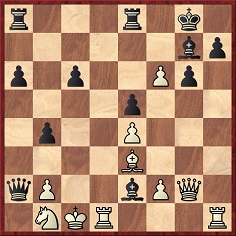
23 Rxh7 Qc4+ 24 Nc3 bxc3 25 Rxg7+ Kf8 26 Bc5+ Qxc5 27 Rg8+ Kf7 28 Qxg6+ Ke6 29 f7+ Resigns.
(Kingpin, 1993)
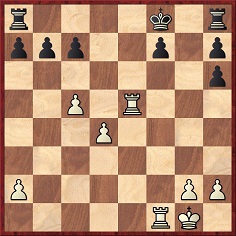
O.E. Michaelis-E.L. Whitehouse, Occasion?
Black to move
In this position, from a game in which White gave queen’s knight odds, play continued: 1...Re8 2 Ref5 Re7 3 a4 Rg8 4 g3 Rg6 5 a5 Ra6 6 d5 Rxa5 7 d6 Rd7 8 c6 Rxd6 9 cxb7 Resigns.
Source: Columbia Chess Chronicle, 1 December 1889, page 121.
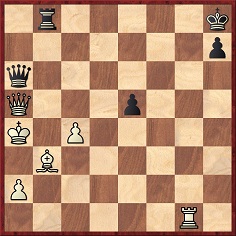
S. Auerbach-Dr W. Lemberg, 24 April 1911
Black to move
1...Qc6+ 2 Qb5 Rxb5 (Black should have played 2...Ra8+ 3 Kb4 Qd6+ 4 Kc3 Qd4+ 5 Kc2 Qxg1 6 Qxe5+ Qg7, with a considerable advantage.) 3 Rg8+ Kxg8 4 cxb5+ Resigns.
Source: Deutsches Wochenschach, 14 May 1911, page 190.
(Kingpin, 1995)
Hanon Russell of Milford, CT, USA has a collection of thousands of chess documents representing all periods. Its importance for serious historical research is immeasurable, but here we publish, with his kind permission, some lighter fare: masters’ comments on each other in correspondence.
a) Letter from Alekhine to Norbert Lederer, 15 February 1924 (item 1365 in the Russell Collection):
‘... I consider Mr Bogoljubow a “non-gentleman”, a man from whom anything can be expected at any moment ... Mr Bogoljubow has, in every tournament in which we’ve participated (growing worse each time), brought with him such an atmosphere of hate, envy and reckless, malignant delight which doubtless disturbed me in developing my full strength.’
b) Letter from Bogoljubow to Capablanca, 7 December 1926 (item 78):
‘Apart from the fact that, for instance, Nimzowitsch is very hostile to me and lately has not missed any opportunity to harm me, I cannot expect fair treatment at the hands of Alekhine, Spielmann or Vidmar. ... As far as Nimzowitsch is concerned, you know as well as I do that he, notwithstanding his fairly good results, is hardly a real grandmaster, so that I am really surprised that people make such a ridiculous fuss over him of late.’
c) Open letter from Emanuel Lasker, April/May 1927 (item 581); see too Lasker Speaks Out (1926):
On Capablanca: ‘I think not badly of him; he has great faults, as I shall presently explain, and also great virtues, for instance, his word is reliable even where others would falter; but he insists on misunderstanding my motives ...
[Capablanca] looks upon argument as a personal affair. He uses invective, sometimes direct, sometimes covered by a thin veil of inference. He assumes that his opponents, and possibly men generally, are actuated by highly selfish motives. At least, that has been my invariable experience with him for 16 years.
His great fault, from a chessic point of view, is lack of self-discernment. He is, without doubt, a chess master of exceeding merit and rightly belongs in the series of chess champions which starts with Philidor. Yet he is fearsome as if he mistrusted his own powers.
And that has grown on him and threatens to clog the wheels of his own evolution.
... Capablanca is passionately angered by every kind of opposition. That is a great danger to him, too. The genius of chess has been kind and generous to Capablanca, but if he insists on his present ways he will stand still while others advance and in the end cut only a poor figure in the gallery of champions.’
(1999)
The remark by Lasker ‘I think not badly of him ...’ was also quoted in C.N. 1922, which referred to reports (see C.N. 1444) that he had also stated regarding the Cuban, ‘his word is his bond’.
W.G. Povarov (Moscow) writes:
‘What is known about Boncourt, who may be considered the world’s number two player in La Bourdonnais’ time? Moreover, when Saint-Amant challenged him to a match in 1837 Boncourt defeated him. The last chess that Boncourt played was, to my knowledge, against Kieseritzky in January 1840, after which he disappeared from the pages of chess history. What happened to him?’
In an article on Saint-Amant in the BCM of October 1933 (page 406), G.H. Diggle wrote of Boncourt as follows:
‘... a retired Government clerk whom Walker describes as “The Nestor of the Café de la Regence”. Boncourt was a fine and chivalrous player; though an older man even than Deschapelles, he cared nothing for reputation, but played even with all comers and retained his great skill right up to his death in 1840. Boncourt’s style was “the correct, rather than the brilliant”, and has even been compared with that of Buckle. In 1836 Boncourt made even games with Szén; in 1839 he played three games with Walker, winning two and drawing the third; and the veteran held his own against Kieseritzky within a month of his death.
With Boncourt Saint-Amant played a long series of games extending over several years, and according to Walker, Boncourt stood at the end with a majority of three. Delannoy tells us that Boncourt established a long lead at the start, but that finally “perseverance, intellect and imagination triumphed over the older player, and during the last year of their contests the ancient Professor acknowledged his conqueror”.’
(2002)
See C.N. 7553.
C.N. 2012 invited readers’ proposals regarding old publications that deserved to be reprinted, and in C.N. 2056 Colin Russ (Herne Bay, England) wrote:
‘A problemist’s instinctive reply is: the A.C. White Series. One or two were reprinted (by Hippocrene Books), but most are collector’s items. The Good Companion Two-Mover is one lovely collection that comes to mind.’
W. John Lutes is the author of a number of monographs covering such openings as the Cunningham Gambit, the Danish Gambit, the McCutcheon Variation in the French Defence, the Anderssen Counter-Attack in the Scandinavian Defence and the Sicilian Defence, O’Kelly Variation. All feature awesome historical research.
(2020)
A. Nelson – A. Freundlich
Handicap Tourney, New York, 1918-19
(Odds of pawn and two moves; remove Black’s f-pawn.)
1 e4 ... 2 d4 c5 3 Nf3 cxd4 4 Nxd4 Nc6 5 Be3 Nf6 6 Nd2 Qa5 7 c3 e6 8 Be2 Be7 9 O-O O-O 10 f4 a6 11 e5 Nd5 12 Nc4 Qc7 13 f5 b5 14 fxe6 bxc4 15 Rxf8+ Bxf8 16 Bxc4 Nxe3 17 e7+ Nxc4 18 e8(Q) N6xe5 19 Nf5 Bb7
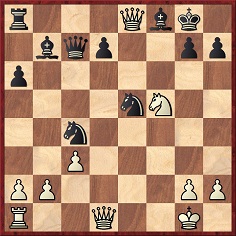
20 Qeh5 Qb6+ 21 Kh1 Qxb2 22 Qhe2 Qxc3 23 Rc1 Qh3 24 Rxc4 Qxf5 25 Rh4 Rc8 26 Rh5 Qf4 27 Qb2 Ng4 28 Qdb1 Be4 29 Qe1 Rc2 30 Qb3+ d5 31 White resigns.
Source: BCM, May 1919, page 170.
An endgame featuring two queens against one is Réti v Rubinstein, Marienbad, 1925. Queens were exchanged at move 16, but three promotions on moves 52-54 led to this position:
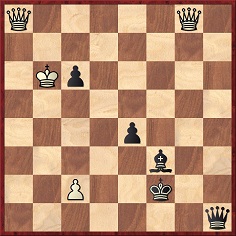
Play continued: 54...e3 55 Qa4 e2 56 Qd4+ Kf1 57 Qd3 Kf2 58 Qd2 Qb1+ 59 Kc7 c5 60 Qb3 Qxb3 61 cxb3 Kf1 62 Qd3 Kf2 63 Qc2 Kf1 64 Qc4 Kf2 65 Qxc5+ Kf1 66 Qc4 Kf2 67 Qd4+ Kf1 68 Qd3 Kf2 69 Qd2 Kf1 70 Qd3 Kf2 71 Qd4+ Kf1 72 Qc4 Kf2 73 Qc5+ Kf1 74 Qc4 Kf2 75 Qd4+ Kf1 76 Qd3 Kf2 77 Qd2 Kf1 78 Qe3 Bg2 Drawn.
(2025)
A recent specimen is Kasparov v Lautier, Linares, 1994.
(2042)
Which chess personalties’ names are most commonly misspelt? Prominent examples are William Hartston, Alexander McDonnell, Lionel Kieseritzky and Lord Lyttelton, frequently given as ‘Hartson’, ‘MacDonnell’, ‘Kieseritsky’, ‘Lyttleton’, and other uncaring variants.
(2040)
A footnote on page 275 of Kings, Commoners and Knaves added that Trompowsky’s name is often misspelt.
Page 159 of the July-August 1915 American Chess Bulletin presented a composition by A.J. Fink of San Francisco that was described as ‘the most humorous position that has ever been set upon a chessboard’:
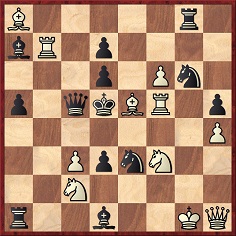
White to move and mate in five moves
Solution: 1 c4+ Nxc4+ 2 Bd4+ Ne5+ 3 Ng5+ Bf3+ 4 Rb1+ Rxa8 5 Qxf3 mate. Other lines include: 1...Qxc4 2 Rb5+ Ke6 3 Ng5+ Kxf5 4 Be4+ Qxe4 5 Qxe4 mate.
(2048)
Finding Bobby Fischer, Chess interviews by Dirk Jan ten Geuzendam. New in Chess, 1994
British chess periodicals tend to shun original set-piece interviews with eminent personalities, unless it is the personalities who shun interviews with British chess periodicals. Nonetheless, the potential of the format has been repeatedly demonstrated by Dirk Jan ten Geuzendam in New in Chess, and the magazine has marked its first decade of publication by producing a compendium of his most memorable encounters. They provide a significant insight into the lives and opinions of an impressive array of the world’s leading players, including Botvinnik, Smyslov and Spassky. Between them, Kasparov and Karpov are interviewed a total of ten times. Unlike other less gifted exponents of the deceptively difficult art of interviewing, Dirk Jan ten Geuzendam (whom Nigel Short, in the Spring 1992 Kingpin, called his favourite chess writer) brings to the task painstaking preparation, wide knowledge and sharp intelligence. He manages all this self-effacingly, leaving the interviewee alone in the limelight, and although a difficult ball is occasionally lobbed in, the overall tone is amiable and enthusiastic.
The title is derived from the roving reporter’s encounter with Fischer at Sveti Stefan in September 1992, related on pages 241-247 under the quote ‘I’m not going to give you an interview’. Fischer is described as ‘an essentially kind and innocent person, who can suddenly lash out when he is overcome by monomaniacal obsession. But who can also be endearingly engaging.’ During their meeting the American was even induced to give examples of alleged game-fixing; it was a well-merited scoop for New in Chess, even if the account falls well short of Seirawan’s in the match book No Regrets.
Despite some printing errors and unnatural turns of phrase, Finding Bobby Fischer is beautifully produced. Occasional footnotes prove helpful, although a few factual inaccuracies have been left hanging. Did Botvinnik really say (page 36) that Capablanca wrote My Chess Career before, rather than after, the First World War?; did Gligorić (page 84) really call Aneurin Bevan ‘the leader of the Labour party in England’?; and did Najdorf (born in 1910) really claim (page 105) that he was ‘a young man of 17 or 18 years old’ when he discussed with Alekhine the latter’s brilliancy against Böök at Margate, 1938?
Mercurial chess politics are widely featured, and this book will prove particularly valuable to any future chronicler of how Garry Kasparov’s vehemence on numerous issues has evolved, revolved and dissolved.
(Kingpin, 1995)
Regarding Dirk Jan ten Geuzendam’s later conduct, see Brad Darrach and the Dark Side of Bobby Fischer.
There are few Reshevsky games like the following one:
Samuel Reshevsky (simultaneous) – H.H. Ryan
Tulsa, 1931
Ruy López
1 e4 e5 2 Nf3 Nc6 3 Bb5 Nf6 4 O-O Be7 5 Qe2 d6 6 h3 O-O 7 Bxc6 bxc6 8 d4 exd4 9 Nxd4 Bb7 10 Nc3 a5 11 Bf4 (‘Amazed at this reply I began to suspect a trap and as Mr Reshevsky’s speed brought him back to my board so quickly, I played safely’ – H.H. Ryan.) 11...Qd7 12 Rad1 (‘It now becomes apparent that Mr Reshevsky has been oblivious to his fatal error for two successive moves.’) 12...Ba6 13 Qf3 Bxf1 14 Kxf1 Rfe8 15 Nf5 Rab8 16 b3 Qc8 17 Bg5 Bd8 18 Bh6 g6 19 Nd4 d5 20 Nxc6 (‘This corner of the board seems to be a sort of “Jinx” to the single player.’) 20...Qa6+ 21 Kg1 Qxc6 22 exd5 Qd7 23 Bf4 Nh5 24 Bh2 f5 25 d6 Qe6 26 Kh1 f4 27 Nd5 cxd6 28 Bxf4 Nxf4 29 Qxf4 Qe5 30 Qc4 Kg7 31 f4 Qe2 32 Qc3+ Kg8 33 Rg1 Bh4 34 Qxa5 (‘Again the “Jinx”.’) 34...Rb5 35 White resigns.
Source: The Gambit, August-September-October 1931, page 66.
(Kingpin, 1995)
A remark by Euwe on page 253 of Terence Tiller’s Chess Treasury of the Air:
‘During my chess career, I have made quite a few oversights. In fact, I have probably made more silly blunders than any other world champion.’
Page 123 of the American Chess Magazine, September 1899, quoted a remark by Steinitz in the Glasgow Weekly Herald:
‘No great player blundered oftener than I have done. I was champion of the world for 28 years because I was 20 ahead of my time. I played on certain principles, which neither Zukertort nor anyone else of his time understood. The players of today, such as Lasker, Tarrasch, Pillsbury, Schlechter and others have adopted my principles, and as is only natural they have improved upon what I began, and that is the whole secret of the matter.’
(Kingpin, 1995)
Chess manuals quote few examples of the staircase manoeuvre from actual play. An example is the following, taken from pages 7-8 of the January 1929 American Chess Bulletin:
Erling Tholfsen – Horace Ransom Bigelow
Marshall Chess Club Championship, New York, 12 January 1929
Ruy López
1 e4 e5 2 Nf3 Nc6 3 Bb5 d6 4 d4 Bd7 5 Nc3 Nf6 6 O-O Be7 7 Re1 exd4 8 Nxd4 Nxd4 9 Qxd4 Bxb5 10 Nxb5 a6 11 Nc3 O-O 12 Bg5 Nd7 13 Bxe7 Qxe7 14 Rad1 Nf6 15 e5 Rfe8 16 f4 Ng4 17 Nd5 Qd8 18 h3 Nh6 19 Qc3 c6 20 Ne3 d5 21 g4 f6 22 Qb3 fxe5 23 Nxd5 cxd5 24 Rxd5 Qh4 25 Rdxe5+ Kf8

26 Qb4+ Kf7 27 Qc4+ Kf8 28 Qc5+ Kf7 29 Qd5+ Kf8 30 Qd6+ Re7 31 Qxe7+ Resigns.
(2050)
Steven Wagner (Urbana, IL, USA) sends the following game, taken from page 11 of the 3/1964 issue of Schach-Echo:
István Polgár – Jindřich Trapl
Budva, 1963
Queen’s Gambit Declined
1 d4 d5 2 c4 e6 3 Nc3 c5 4 cxd5 cxd4 5 Qxd4 Nc6 6 Qd1 exd5 7 e3 Nf6 8 Be2 Bb4 9 Bd2 O-O 10 Nf3 Re8 11 O-O Bg4 12 Qb3 d4 13 Nb1 Bd6 14 Qxb7 Rc8 15 Rc1 Rc7 16 Qb5 dxe3 17 fxe3 Bxf3 18 Bxf3 Nd4 19 Qf1 Rxc1 20 Qxc1 Nxf3+ 21 gxf3 Qb8 22 f4 Bxf4 23 exf4 Qb6+ 24 Kh1 Qb7+ 25 Kg1 Re2 26 Qf1
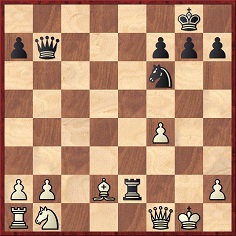
26...Qb6+ 27 Kh1 Qc6+ 28 Kg1 Qc5+ 29 Kh1 Qd5+ 30 Kg1 Qd4+ 31 Kh1 Qe4+ and Black won. The magazine gives the line 32 Kg1 Ng4 33 Nc3 Qd4+.
Zoltán Blázsik (Szeged, Hungary) informs us that White in this game, played in the World Students’ Team Championship, was István Polgár. He is not known to be related to his celebrated namesakes.
(2065)
A familiar example of the staircase manoeuvre is the game Mojżesz Leopoldowicz Łowcki v Savielly Tartakower, Jurata, 1937; see, for instance, pages 322-323 of the first edition of the Oxford Companion to Chess.
On pages 47-48 of Instant Chess David Levy and Kevin J. O’Connell (Oxford, 1984) made a mess of a Tartakower position (from his game against Łowcki at Jurata, 1937, although the co-authors did not say so).
How interesting to find the selfsame mess (down to virtually identical notes) on page 127 of Chernev and Reinfeld’s The Fireside Book of Chess (New York, 1949).
(1357)
Published at the end of 1994 by Games & Puzzles: The Encyclopedia of Chess Variants by D.B. Pritchard. In a 384-page hardback the author offers alphabetically-organized entries on an astonishing array of games deviating from the ‘normal’ chess rules. What a pleasure to see a writer showing such mastery of a broad field.
John Nunn’s Best Games (London, 1995; a 320-page paperback) has already been eulogized by many critics, and deservedly so. C.N. has frequently had harsh words for Batsford’s productions, but here is a superlative autobiographical games collection whose hallmarks are depth, clarity and common sense.
Also recommended are two beautifully produced hardbacks (256 pages each) from New in Chess. Dirk Jan ten Geuzendam’s Finding Bobby Fischer is an anthology of interviews with leading chess figures which have been published in the Dutch magazine over the past decade. Chess the Adventurous Way by Jan Timman presents 80 of his games, annotated in characteristically brilliant style.
(2078)
Carlo Cappello (Milan, Italy) refers to Chapter 2 of Tartakower’s Bréviaire des échecs, which mentions an hypothesis ‘put forward in 1931 by a distinguished Russian amateur L. Isaïeff’ suggesting a relationship between the move of the knight and magic squares. More information on this hypothesis is requested. During its first few years (i.e. starting in 1846) the Deutsche Schachzeitung had well over a hundred pages on the general subject.
Awani Kumar (Uttarkashi, India) raises the subject of the knight’s tour (whereby a knight visits each square once only). He draws attention to widely varying figures suggested for the number of possibilities (e.g. Your First Move by A. Sokolsky, page 15; The Complete Book of Chess by I.A. Horowitz and P. Rothenberg, page 183; The Even More Complete Chess Addict by M. Fox and R. James, pages 277-278).
(2098)
The ending with bishop, knight and king against a lone king is explained in countless books and is even described as ‘the most difficult Mate in Chess’ by Frank J. Marshall and J.C.H. Macbeth on page 117 of Chess Step by Step (New York, 1924). But when has the endgame occurred in actual play? Offhand we can think of only one example:
Wilhelm Hanstein – Carl Mayet
Berlin, 1 November 1837
King’s Gambit Accepted
1 e4 e5 2 f4 exf4 3 Nf3 g5 4 Bc4 Bg7 5 h4 h6 6 d4 d6 7 c3 g4 8 Bxf4 gxf3 9 Qxf3 Qe7 10 Nd2 Be6 11 e5 Bxc4 12 Qxb7 dxe5 13 Nxc4 exf4+ 14 Kf2 Qd8 15 Qxa8 Ne7 16 Qe4 O-O 17 Rae1 Nd5 18 g3 fxg3+ 19 Kxg3 Nf6 20 Qf5 Nc6 21 Rhg1 Ne7 22 Qf3 h5 23 Rgf1 Ng6 24 Ne5 Ng4 25 Nxg6 fxg6 26 Qc6 Bf6 27 Re6 Bxh4+ 28 Kh3 Bf6 29 Rfe1 Kg7 30 d5 Nf2+ 31 Kg2 Nd3 32 R1e4 g5 33 Kh2 Nf4 34 Re8 Rxe8 35 Rxe8 Qd6 36 Qxd6 cxd6 37 Ra8 Nxd5 38 Rxa7+ Kg6 39 a4 Be5+ 40 Kg1 h4 41 a5 h3 42 a6 h2+ 43 Kh1 g4 44 Ra8 Nc7 45 Rg8+ Kf7 46 Rxg4 Nxa6 47 Rg2 Ke6 48 Rc2 Kd5 49 b3 Kc5 50 Kg2 Nc7 51 Rc1 Nd5 52 c4 Nf4+ 53 Kf3 Kb4 54 Rb1 Nd3 55 Kg2 Nc5 56 Kh1 Nxb3 57 c5 dxc5 58 Re1 Bd4 59 Kxh2 c4 60 Kg2 c3 61 Kf3 c2 62 Ke4 Kc3 63 Rh1 c1(Q) 64 Rxc1+ Nxc1 ‘and Black won with knight and bishop against the solitary king’.
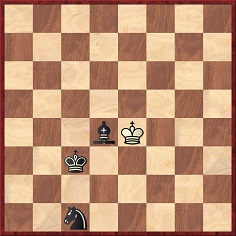
Source: Deutsche Schachzeitung, June 1858, pages 240-242.
(2121)
Ulrich Schimke (Göttingen, Germany) has checked the Tascbase databank, containing 146,000 games, and found 25 endings with bishop, knight and king against a lone king. The earliest is Flesch v Bárczay, Budapest, 1965, and the set includes a blindfold game Ljubojević v J. Polgar, Monaco, 1994. Only one of the 25 games was drawn (Lengyel v Loginov, Budapest, 1993).
(2129)
Carl-Eric Erlandsson is another reader who has examined his database (Chess Assistant) for specimens of endings with bishop, knight and king against a lone king. It took 19 seconds for him to learn that there were 55 such games out of 400,000, i.e. one game in every 7,273.
(2136)
Jonathan Manley (Ilford, England) asks if there are any instances of money depicting chess, apart from the well-known Estonian banknotes featuring Paul Keres.
One case comes to mind. Schachfirma Fruth, Unterhaching, Germany is selling ‘emergency money’ from the early 1920s, during which period of hyperinflation German towns and villages were entitled to print their own currency.The banknotes included six chess series with 18 different chess motifs, including a portrait of Anderssen.
(2127)
We take this opportunity to remind readers that Jonathan Manley is the editor of Kingpin, a much-praised magazine which treats all aspects of chess with wit, candour and irreverence. Over the years, it has achieved many scoops, demonstrating a commitment to truth and openness that is woefully lacking in ‘standard’ pusillanimous chess journals.
... We must, however, declare a ‘personal interest’, as a regular contributor to Kingpin.
(2128)
The latest issue (No. 33) of the English magazine Kingpin has just appeared and is probably the finest of the entire run, with a better-than-ever mix of pure chess, burlesque, painstaking research, lacerating topical commentary and uncompromising book reviews.
Chess Horizons described Kingpin as ‘unquestionably the funniest chess magazine in the world’, yet despite all the jokes, which are of every kind imaginable, there is an underlying seriousness of purpose, founded on a commitment to truth, accuracy and plain speaking. The main targets of denunciation and ridicule are all the proper ones, and over the years Kingpin has achieved numerous scoops on important matters which other editors have neglected to broach publicly.
(2478)
A rare case of a master finding himself on the sharp end of Legall’s trap:
V. Sjöberg – Siegbert Tarrasch (simultaneous?)
Skifarp [modern spelling: Skivarp], 24 May 1911
Dutch Defence, Staunton Gambit
1 d4 f5 2 e4 fxe4 3 Nc3 Nf6 4 f3 c5 5 d5 e5 6 dxe6 d5 7 fxe4 d4 8 e5 Nd5 9 Ne4 Bxe6 10 Nf3 Nc6 11 Bd3 Bg4 12 O-O Nxe5
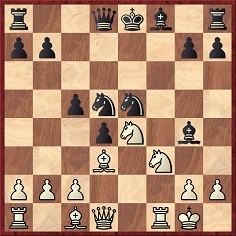
13 Nxe5 Bxd1 14 Bb5+ Ke7 15 Bg5+ Ke6 16 Bxd8 Kxe5 17 Ng5 Bh5 18 Rae1+ Ne3 19 Bc7+ Bd6 20 Ba5 Raf8 21 Rxe3+ dxe3 22 Bc3+ Kd5 23 Bxg7 Bxh2+ 24 Kxh2 Rxf1 25 Bxf1 Rg8 26 Nxh7 Rxg7 27 Nf6+ Ke5 28 Nxh5 Rf7 29 Ng3 Kf4 30 Bd3 a6 31 a4 Rc7 32 b3 Rc6 33 Ne2+ Kg4 34 Kg1 Rf6 35 Be4 Rf7 36 Nc3 b6 37 Bf3+ Kf4 38 Nd5+ Ke5 39 Nxe3 Resigns.
Source: Tidskrift för Schack, September-October 1911, pages 155-156, which contained brief notes by the winner.
(2133)
Steinitz called the following ‘an instructive and beautifully terminated game’.
Hermann Neustadtl – O. Valenta
Prague, September 1889
Steinitz Gambit
1 e4 e5 2 Nc3 Nc6 3 f4 exf4 4 d4 Qh4+ 5 Ke2 d5 6 exd5 Bg4+ 7 Nf3 O-O-O 8 dxc6 Bc5 9 cxb7+ Kb8 10 Nb5 a6 11 c3 axb5 12 Kd3 Bf5+ 13 Kd2 Qg4 14 Ke2 Nf6 15 Kf2 Ne4+ 16 Kg1 Ng5 17 Bxb5 Rxd4 18 cxd4 Bxd4+ 19 Kf1
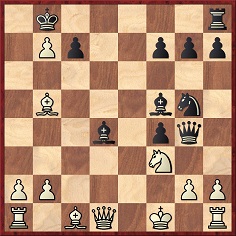
19...Qxg2+ 20 White resigns. (‘We do not remember having seen a finer two-move combination in actual play, and considering that it was forecalculated, we may say that Herr Valenta, who has hitherto been unknown to fame, certainly deserves a reputation in future’ – Steinitz.)
Source: International Chess Magazine, October 1889, pages 312-313.
Steinitz’s magazine inverted the names of the two players. Although this error was corrected on page 349 of the November 1889 issue, J.H. Ellis repeated it on page 127 of his anthology Chess Sparks (London, 1895). On the other hand, the brilliancy was duly credited to Valenta in various editions of the American anthology The Golden Treasury of Chess.
We have seen a few other games (not wins) by Valenta. Who was he?
(2134)
Jan Kalendovský (Brno, Czech Republic) sends extensive biographical information on Otakar Valenta (1859-1917), together with a number of games. From the latter we pick the following:
O. Valenta – Hermann Neustadtl
Prague, 1883
French Defence
1 e4 e6 2 d4 d5 3 exd5 exd5 4 Nf3 Nf6 5 Ne5 Bd6 6 Bg5 Qe7 7 f4 h6 8 Bh4 Bxe5 9 fxe5 Qb4+ 10 c3 Qxb2 11 exf6 Qxa1 12 fxg7 Rg8 13 Bb5+ c6 14 Qe2+ Be6 15 O-O cxb5 16 Qxb5+ Nd7 17 Qb4 f6 18 Bxf6 Nxf6 19 Rxf6 Bf7 20 Qxb7 Rxg7 21 Qxa8+ Ke7 22 Rf1 Qxa2 23 Qb7+ Kd8 24 Rf2 Qa1 25 Rf6 Ke8 26 Rc6 Kf8 27 Ra6 Resigns.
Source: Zlatá Praha, 28 July 1893.
(2174)
Wanted: cases where masters have spurned obvious moves. An example follows:
Victor Soultanbéieff – J. Kornreich
Ghent, October 1930
Queen’s Indian Defence
1 d4 Nf6 2 Nf3 e6 3 c4 b6 4 g3 Bb7 5 Bg2 Be7 6 Nc3 Ne4 7 Qc2 Nxc3 8 bxc3 Nc6 9 O-O O-O 10 Ne5 Na5 11 Bxb7 Nxb7 12 Rd1 d6 13 Nc6 Qd7 14 Qe4 Bf6 15 Qf3 Qc8 16 g4 h6 17 Bxh6 Nd8 18 Qxf6 gxf6 19 Ne7+ Kh7
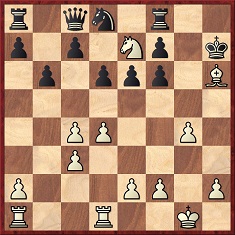
20 Bxf8 (Soultanbéieff rewards this move with two exclamation marks and writes: ‘The point of the combination, whereas the weak move 20 Nxc8? would lose a piece after 20...Kxh6 21 Ne7 Re8. White is now threatening mate by Rd3-h3, and to avoid it Black has no option but to return the queen, with a decisive loss of material.’) 20...Nb7 21 Nxc8 Rxc8 22 Be7 Kg6 23 f4 Re8 24 f5+ Kg7 25 fxe6 Rxe7 26 exf7 Kxf7 27 Rf1 Kg6 28 Rf2 c5 29 Raf1 Rf7 30 Rf5 Na5 31 g5 Nxc4 32 Rxf6+ Rxf6 33 gxf6 Kf7 34 e4 Nd2 35 Rf4 Nc4 36 h4 Resigns.
Source: L’Echiquier, December 1930, pages 1060-1061.
(2137)
C.N. 2137 raised the topic of obvious moves which masters chose not to play. Below is an (unsuccessful) example from W.H.K. Pollock, whose play contained many witty touches. He was Black against G.A. MacDonnell, and the game was played in London in July 1887:
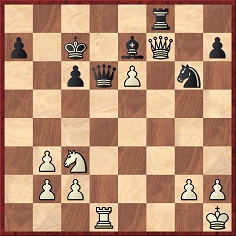
23 Rxd6 Kxd6 24 Ne4+ Ke5 25 Qg7+ Kxe4 26 g3 Bc5 27 Qxh7 Rf6 28 h4 Ke3 29 h5 Ne5 30 e7 Rf1+ 31 Kg2 Rf2+ 32 Kh3 Rf1 33 Qd3+ and wins. White’s strange 33rd move is another illustration of this theme.
Source: Pollock Memories by F.F. Rowland (Dublin, 1899), page 43.
(2305)
An intriguing game, taken from pages 111-112 of Schachjahrbuch für 1915/16 by L. Bachmann (Ansbach, 1917):
Gyula Breyer and Arthur Havasi – Lajos Asztalos and
Zsigmond Barász
Budapest, 13 February 1915
Queen’s Pawn Game
1 d4 d5 2 Nc3 f5 3 Bg5 Nf6 4 Bxf6 exf6 5 Nh3 c6 6 e3 Bd6 7 Bd3 O-O 8 Qf3 g6 9 Ne2 Be6 10 Nhf4 Qe7 11 h4 Bf7 12 g4 fxg4 13 Qxg4 Kh8 14 h5 gxh5 15 Qf5 Be8 16 O-O-O Bxf4 17 Nxf4 Na6 18 Rxh5 Bxh5 19 Qxh5 Qg7 20 Ng6+ Kg8 21 Rg1 hxg6
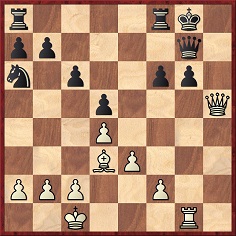
22 Bxg6 (Bachmann’s book gives this move two exclamation marks, and it does indeed seem stronger than 22 Rxg6.) 22…Rfd8 23 Bh7+ Kf8 24 Rxg7 Kxg7 25 Qg6+ Kh8 26 Qh6 Resigns.
(2676)
We have now noted that the Breyer consultation game was admiringly annotated by Tarrasch on pages 92-93 of the May-July 1915 Tidskrift för Schack. In particular, he regarded 22 Bxg6 as ‘very fine’.
(2706)
A game which we gave in CHESS in 1985 was reproduced on page 49 of Kings, Commoners and Knaves:
Three times White has the opportunity to capture the queen with check and three times he declines.
Fernando Visier Segovia – Juan Rafael Betancort Curbelo
Spanish Championship, Reus, 1968
Sicilian Defence1 e4 c5 2 Nf3 d6 3 d4 cxd4 4 Nxd4 Nf6 5 Nc3 a6 6 Bc4 e6 7 Bb3 Be7 8 Be3 O-O 9 Qe2 Bd7 10 O-O-O b5 11 a3 Qc7 12 Kb1 Nc6 13 g4 Rac8 14 f4 e5 15 Nxc6 Bxc6 16 g5 Nxe4 17 Nxe4 Bxe4 18 Rhg1 exf4 19 Bxf4 Bg6 20 h4 Rfe8 21 h5 Bxg5 22 hxg6 Rxe2 23 gxf7+ Kh8 24 Bxd6 Qc6 25 Rxg5 Rxc2 26 Be5 Rc1+ 27 Ka2 Qh6 28 Rxg7 Qxg7
29 Rxc1 Rf8 30 Rg1 Rxf7 31 Bxf7 Resigns.
Source: Campeones y campeonatos de España de ajedrez by P. Morán, pages 334-335.) Morán described it as ‘one of the most beautiful games played in Spain’.
Vaclav Kautský – J. Knapp
Prague, 28 April 1911
French Defence
1 e4 e6 2 d4 d5 3 Nc3 Nf6 4 e5 Nfd7 5 f4 c5 6 Nf3 f6 7 Be2 Nb6 8 O-O cxd4 9 Nb5 Bc5 10 Nfxd4 a6 11 exf6 axb5 12 fxg7 Rg8 13 Bxb5+ Ke7 14 f5 Kd6 15 f6 N6d7 16 b4 Bb6 17 c3 e5 18 Kh1 Nxf6 19 Bg5 Bg4 20 Qe1 Nbd7 21 g3 Rxg7
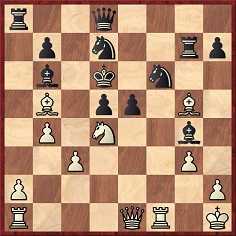
22 Rxf6+ Nxf6 23 Qxe5+ and mate in three more moves.
Source: Časopis Československých Šachistů, September 1924, pages 138-139.
(2143)
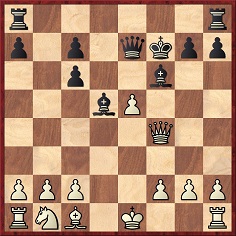
E. Sonnenschein-N.N., Czechoslovakia, Date?
This position appeared on page 236 of CHESS, 14 March 1938 and makes a good quiz question: how can White save his e-pawn, relieve the pin on the e-file and win the bishop at f6?
The ingenious solution is: 1 c4 Bxg2 2 Rg1 Bh3 3 Rg3 Bd7 4 Re3 ‘and the miracle has happened’.
(2145)
Alan McGowan (Waterloo, Canada) mentions that pages 293-295 of the October 1936 Wiener Schachzeitung gave the score of Porges v H. Sonneschein (a Döry Defence, i.e. 1 d4 Nf6 2 Nf3 Ne4) played in Vienna on 12 October 1936. We can add that a game between a player named Sonnenschein (no initial indicated) and Schara, from a tournament in Vienna in June 1928, appeared on pages 275-276 of the September 1928 issue of Arbeiter-Schachzeitung, but a connection with the E. Sonnenschein mentioned in C.N. 2145 remains to be demonstrated.
(2633)
N.N. – W.M. de Visser
Manhattan Chess Club, New York, date?
Ruy López
1 e4 e5 2 Nf3 Nc6 3 Bb5 a6 4 Ba4 Nf6 5 O-O Nxe4 6 d4 Be7 7 Re1 f5 8 dxe5 O-O 9 Bb3+ Kh8 10 Bf4 g5 11 Be3 g4 12 Nd4 Nxe5 13 Nxf5 Rxf5 14 Bd4 d5 15 f4 gxf3 16 gxf3 Rg5+ 17 Kh1 Bf6 18 fxe4 Bh3 19 Rg1 Ng4 20 Nc3 c5 21 Bxc5 Qc7 22 Rxg4 Bxg4 23 Qf1 Bxc3 24 bxc3 Qxc5 25 Qf6+ Rg7 26 Rf1 Rg8 27 h3
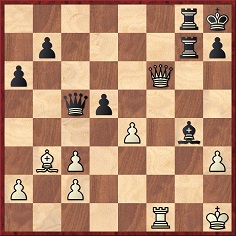
27...Bf3+ 28 Kh2 Qd6+ 29 Qxd6 Rg2+ 30 Kh1 Rf2 mate.
Source: Brooklyn Chess Chronicle, 15 March 1887, page 94.
(2155)
Wanted: published nominations for the best-ever chess book. Three are given below:
i) ‘Signor C. Salvioli has reclaimed the birthright of chess literature for Italy. Without exception the first volume of his Teoria e Pratice [del giuoco] degli Scacchi as a collection of games alone is the most valuable chess book extant in any language’. W. Steinitz, on page 83 of the March 1885 issue of the International Chess Magazine.
ii) On page 151 of Instructions to Young Chess-players by H. Golombek (London, 1958) Réti’s Modern Ideas in Chess was described as ‘the best book ever written on chess’.
iii) ‘Without question, Chess Fundamentals, by Capablanca.’ M. Botvinnik, interviewed on page 26 of Chess Life, March 1984.
(2165)
René Olthof (Rosmalen, the Netherlands) contributes the following game:
Andrey Kharlov – Alexander Vaulin
Petrov Memorial Tournament, St Petersburg, 1998
Sicilian Defence
1 e4 c5 2 Nc3 Nc6 3 Nf3 Nd4 4 Bc4 Nxf3 5 gxf3 a6 6 d4 b5 7 Bd5 Ra7 8 Bf4 e6 9 Bb8 Rc7 10 Ba8
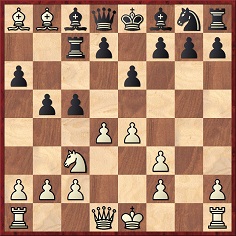
10…cxd4 11 Bxc7 Qxc7 12 Qxd4 Qb8 13 Bd5 b4 14 Na4 exd5 15 exd5 Bd6 16 O-O-O Ne7 17 Qxg7 Be5 18 Qg4 d6 19 Qc4 O-O 20 f4 Bf6 21 b3 a5 22 Rhe1 Bf5 23 Re2 Ng6 24 Rg1 Kh8 25 Rd2 Re8 26 f3 Qa7 27 Rgd1 Qe3 28 Qa6 Nxf4 29 White resigns.
Source: Shakhmatny Peterburg, 1998/1-2, page 9.
‘White bishops on a8 and b8 after 10 moves must surely be unique’, comments Mr Olthof.
(2205)
Miss C. – Miss M.
Kennington, circa 1848
Evans Gambit Declined
1 e4 e5 2 Nf3 Nc6 3 Bc4 Bc5 4 b4 d5 5 Bxd5 Nxb4 6 Nxe5 Nxd5 7 exd5 Bd4 8 Qh5 Qf6 9 O-O Bxa1 10 c3 Bf5 11 f4 Bxb1

12 Ba3 Bxc3 13 dxc3 Bxa2 14 c4 Ne7 15 Bb2 O-O 16 Bd4 Bxc4 17 Nxc4 Qxd4+ and Black won.
The score was published on pages 23-24 of the 1848 Chess Player’s Chronicle, which commented:
‘This promising little game recently played by two young Members of the Ladies’ Chess Club at Kennington, has, at least, the advantage of novelty to recommend it, since, if we mistake not, it is the only one in which the opponents were of the softer sex which has ever been published.’
(2447)
Josef Kvíčala – Moritz Porges
Prague, 27 March 1890
Queen’s Gambit Declined
1 c4 e6 2 e3 Nf6 3 a3 d5 4 d4 c5 5 Nf3 Nc6 6 dxc5 Bxc5 7 b4 Bd6 8 Bb2 O-O 9 Nc3 a6 10 cxd5 exd5 11 Bd3 Bg4 12 O-O Bxf3 13 gxf3 Nh5 14 f4 Qh4 15 Nxd5 Rad8 16 Kh1 Bb8
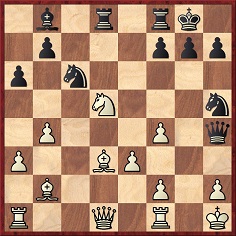
17 Rg1 Rxd5 18 Qxh5 Qxh5 19 Rxg7+ Kh8 20 Rxh7+ Kg8 21 Rg1+ Resigns.
Source: Časopis Českých Šachistů, November-December 1917, pages 160-161.
(Kingpin, 1998)
A miscellany of rook endings with a brutal finish:
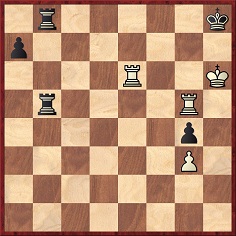
Andreaschek-Zehetmayer, Vienna, 1904
1...R8b6 2 Rxb6 Rxg5 3 Rb7 Rg8 4 Rh7 mate.
Source: Wiener Schachzeitung, Supplementheft, 1912, page 399.
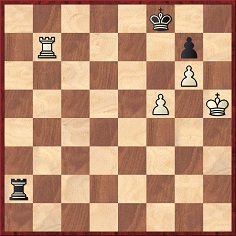
From a skittle game in London between unnamed opponents.
Play continued 1 Rb8+ Ke7 2 Rb7+ Kf6 3 Rf7+ Ke5 4 Rxg7 Kf4 and White resigned.
Source: BCM, September 1906, page 373.

A position by George S. Carr, constructed circa 1894
White wins with 1 h3.
Source: BCM, March 1907, page 105.
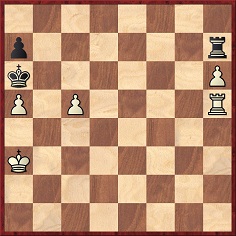
The players of this game are unidentified
1 c6 Rxh6 2 c7 Rc6 3 Rh6 and wins.
Source: American Chess Bulletin, July-August 1931, page 129. The Bulletin’s source, the Stratford Express, said that Alekhine had praised the charm of this ending.
(Kingpin, 1998)
From CHESS (14 February 1939, page 209):
‘Herr Bredwalt was passionately devoted to chess. He decreed that, after his death, a set of chessmen should be made from his bones. The request was duly carried out, so Herr Bredwalt will play chess for maybe a century or more yet.’
The item was inevitably headed ‘Chess in his bones!’
(Chess Café, 1998)
Jean Hébert (Richelieu, Canada) sends a number of Alekhine games from Le Pion of 1924 which are not in the new Skinner/Verhoeven book on Alekhine. One of them (Alekhine’s win as White against A. Lambert in a blindfold exhibition in Montreal on 1 December 1923) has a strange symmetrical opening: 1 d4 d5 2 Nf3 Nf6 3 Bf4 Bf5 4 e3 e6 5 Bd3 Bd6 6 Bxf5 Bxf4 7 Bxe6 Bxe3 8 Bxf7+ Kxf7 9 fxe3.
(Kingpin, 1998)
An endnote on pages 257-258 of Chess Explorations in connection with a game between Heftye and Mieses (C.N. 127):
On the subject of symmetry, C.N. 1341 quoted the game J.M. Hanham-F.D. Rosebault, New York, 1909: 1 e4 e5 2 d3 d6 3 c3 c6 4 Nf3 Nf6 5 Nbd2 Nbd7 6 Be2 Be7 7 O-O O-O 8 Re1 Re8 9 Nf1 Nf8 10 Ng3 Ng6 11 Bf1 Bf8 12 h3 h6 13 Qc2 Qc7 14 Be3 Be6 15 d4 d5 16 dxe5 Nxe4. Black eventually won.
C.N. 1488 referred to the case of Rotlewi-Eljaschoff (Elyashov), St Petersburg Hauptturnier, 1909, as given on page 17 of Chess Kaleidoscope by Karpov and Gik, but in C.N. 1507 François Zutter (Founex, Switzerland) pointed out that according to the tournament book the game began 1 e4 e5 2 Nf3 Nc6 3 Nc3 Nf6 (and not 1 e4 e5 2 Nf3 Nf6 3 Nc3 Nc6, as suggested by Karpov and Gik). Imperfect symmetry also occurred in Schwarz Marco, Vienna, 1890 (C.N. 601).
See too C.N. 8867.
For the full score of Hanham v Rosebault, see our feature article on the latter.
The game below was published on pages 153-154 of the International Chess Magazine, May 1890, page 153:
Walter Irving Kennard – E.P. Wires
Correspondence game
Steinitz Gambit
1 e4 e5 2 Nc3 Nc6 3 f4 exf4 4 d4 Qh4+ 5 Ke2 d5 6 exd5 Bg4+ 7 Nf3 Qe7+ 8 Kf2 Bxf3 9 Kxf3 Nd8 10 Bb5+ c6 11 dxc6 bxc6 12 Bxc6+ Nxc6 13 Re1 Nxd4+ 14 Qxd4 Qxe1

15 Bxf4 (‘The initiation of a brilliant, ingenious and quite original combination, which reflects the highest credit on Mr Kennard’s analytical powers.’ – Steinitz.) 15…Qe6 16 Re1 Qxe1 17 Qa4+ Kd8 18 Qa5+ Ke8 19 Qb5+ Ke7 20 Qc5+ Kf6 21 Qg5+ Ke6 22 Qd5+ Resigns.
The second game comes from page 28 of the November 1905 issue of Lasker’s Chess Magazine, which commented: ‘The combination, inaugurated by the sacrifice of the bishop on the 13th move of White, appears to be as sound as undoubtedly it is original’.
1 e4 e5 2 f4 Nf6 3 fxe5 Nxe4 4 Nf3 d5 5 d4 Bb4+ 6 c3 Ba5 7 Bd3 O-O 8 O-O f6 9 Qb3 Kh8 10 exf6 Nxf6 11 Bg5 Bb6 12 Ne5 Be6
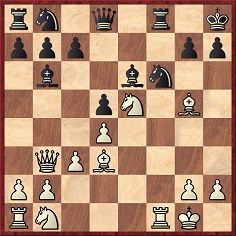
13 Bxh7 Kxh7 14 Qc2+ Kg8 15 Ng6 Rf7 16 Rf4 Qd6 17 Rh4 Nh7 (An imperfectly played game, to be sure. Here, for instance, White could win quickly with 18 Rxh7.) 18 Ne7+ Rxe7 19 Qxh7+ Kf8 20 Nd2 Bg8 21 Qf5+ Ke8 22 Rh8 Qe6 23 Rxg8+ Qxg8 24 Qc8+ Kf7 25 Rf1+ Kg6 26 Qf5+ Kh5 27 g4 mate.
(Kingpin, 1998)
Wanted: information about the origins of the ‘Noah’s Ark Trap’ in the Ruy López. So far the oldest specimen we have found is G. MacDonnell v J. Wisker, London, 1876 (Deutsche Schachzeitung, June 1876, pages 172-173), which began 1 e4 e5 2 Nf3 Nc6 3 Bb5 a6 4 Ba4 Nf6 5 O-O d6 6 d4 b5 7 Bb3 Nxd4 8 Nxd4 exd4 9 Bg5 (‘Naturally White should not capture the d-pawn owing to 9…c5! and 10…c4.’).
Annotating a game on pages 355-356 of the August 1895 BCM, James Mason wrote after 1 e4 e5 2 Nf3 Nc6 3 Bc4 Bc5 4 Qe2 d6 5 c3 Nge7 6 a4 ‘Simply by way of episode; or, reminiscent of Noah and his Ark!’, but when the name was first used for the Ruy López trap remains to be discovered.
(2206)
About 20 years ago we saw a game involving Josef Noa (1856-1903) which featured the trap and were struck by the Noa/Noah connection. Now, however, it is proving impossible to locate the game in question. Can any readers help?
(3042)
Dirk Gruijters (Leiden, the Netherlands) and Dennis Leong (Naperville, IL, USA) suggest that the game in question may have been Noa v Steinitz, London, 16 June 1883, in which there was an opportunity for the Noah’s Ark Trap to arise. The game began 1 e4 e5 2 Nf3 Nc6 3 Bb5 a6 4 Ba4 Nge7 5 d4 exd4 6 Nxd4 Nxd4 7 Qxd4 b5 8 Bb3 d6. White now played 9 c4, which the tournament book (page 97) gave a question mark with the comment ‘9 c3 is much preferable’.
(3045)
See also other references to the trap in the Factfinder.
Claiming that old games are ‘unknown’ can be risky, but the score below seems absent from the various Anderssen collections:
Count Conrad Woldemar Vitzthum von Eckstädt – Adolf
Anderssen
Leipzig, 1855
Scotch Gambit
1 e4 e5 2 Nf3 Nc6 3 d4 exd4 4 Bc4 Bc5 5 Ng5 Nh6 6 Qh5 (Known as the Vitzthum Attack.) 6…Qe7 7 f4 d6 8 h3 Na5 9 Bd3 Nf5 10 Nxf7 g6 11 Qe2 Ng3 12 Qf3 Nxh1 13 Nxh8
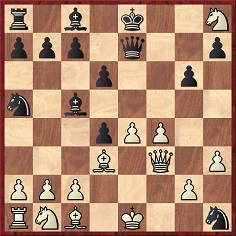
13…Qh4+ 14 Kd1 Nf2+ 15 Ke2 Nxd3 16 Qxd3 Be6 17 Qb5+ Nc6 18 Qxb7 d3+ 19 cxd3 Nd4+ 20 Kd1 Bg4+ 21 hxg4 Qh1+ 22 White resigns.
Source: Šach, September-October 1939, pages 148-149.
(2211)
Ed Tassinari (Scarsdale, NY, USA) points out that the game was subsequently annotated by L. Prins in Master Chess (starting on page 46), with a note that in 1938 the Leipziger Zeitung had announced the discovery of a number of Anderssen games played in 1855. The date of Vitzthum v Anderssen was given as 5 April 1855.
(2242)
The problem below, which may appeal to those who like ‘natural’ positions, is a three-mover by Důras which was originally published in Zlatá Praha on 7 May 1919:

(2213)
Page 273 of the December 1912 American Chess Bulletin reported that William Bayard Rice (1895-1953) had his first problem published in the Chess Amateur ‘before he had contested a single game of chess over the board – truly a unique instance’.
(2214)
Christopher Fordham-Hall (Bournemouth, England) asks whether there has ever been a patron saint of chess.
We can do no better than quote Adriano Chicco’s words on page 356 of the November 1954 BCM:
‘… I suggest that the patron saint of all players, and therefore of chess-players, is St Francis of Sales, who, in the Introduction to a Devoted Life, Part III, Ch. 31, included chess among permitted games. We are reminded, too, that in Spain in 1936, the chess section of a religious club of Granada elected as its patron St Genadio, Bishop of Astoria in 899, who is said to have often played chess with Alfonso III (El Ajedrez Español, 1936, page 140).
Of St Francis Xavier it is said that one day, while sailing to Malavar, he began to play chess with a soldier of doubtful character in order to befriend and to convert him (Rosignoli, Societatis Jesus, Il Giuoco di Fortuna, Modena, 1703, page 187).
The Catholic Church, after the penalties of the first centuries, looked with favour on chess, if played without money stakes (see my article, “Chess and the Church” in L’Italia Scacchistica, 1938, pages 161-181).’
(2215)
Giving the above item on page 142 of A Chess Omnibus, we added this footnote:
Another candidate is Teresa d’Avila (see page 506 of the Dizionario Enciclopedico degli Scacchi by A. Chicco and G. Porreca, as well as page 14 of the January 1955 BCM).
An addition to C.N. 2215 comes from page 4 of The Observer, 13 August 1922:
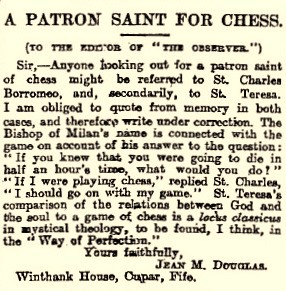
(9071)
A quote from Wolfgang Heidenfeld’s 1955 book Chess Springbok (page 27):
‘Of all the countries I have visited outside the Iron Curtain, Holland is by far the most chess-conscious. Players of all classes and standards take their chess seriously and are always ready for more. A visiting chess master will find no difficulty in either having a small weekend tournament arranged for him, in the course of which he may meet three or four Dutch masters, or encountering individual opponents of master strength in match games.’
After recalling major chess events held in the Netherlands over the previous two decades, Heidenfeld wrote:
‘How puny in comparison is the record of Great Britain, not to mention such countries as Belgium and France where Cinderella, not Caissa, is the patron saint of chess.’
The reference to Caissa as the patron saint of chess, as opposed to the goddess, brings to mind a poem by Alfred Kreymborg, ‘Chess Players’, on pages 120-124 of Blood of Things (New York, 1920). It began:
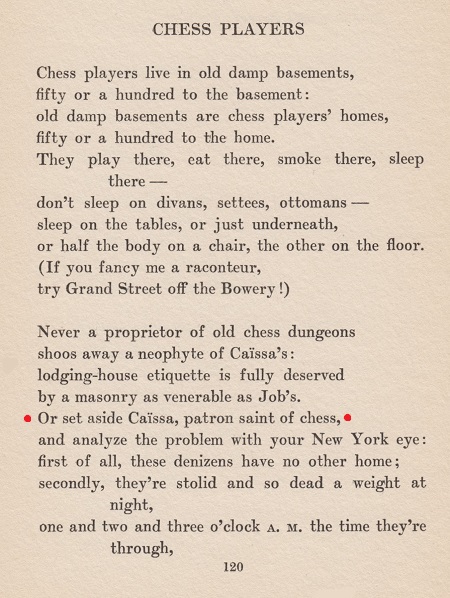
(10654)
‘A remarkable and instructive example of a game drawn under circumstances that rendered it apparently impossible’ was the description of the final phase of the encounter below, published on pages 166-168 of the Chess Player’s Chronicle, 1846:
Wilhelm Hanstein – Tassilo von Heydebrand und der Lasa
Occasion? (circa 1846)
Scotch Gambit
1 e4 e5 2 Nf3 Nc6 3 d4 exd4 4 Bc4 Bc5 5 c3 d3 6 b4 Bb6 7 a4 a6 8 O-O d6 9 Qxd3 Nge7 10 Bf4 O-O 11 Nbd2 Ng6 12 Bg3 Kh8 13 Rfe1 f5 14 exf5 Bxf5 15 Ne4 Nce7 16 Rad1 h6 17 h3 Qd7 18 a5 Ba7 19 Kh2 Rad8 20 Bxa6 bxa6 21 Qxa6 Bxe4 22 Rxe4 Qc6 23 Qxc6 Nxc6 24 Rc4 Nge5 25 Nxe5 Nxe5 26 Rxc7 Bxf2 27 b5 Bxg3+ 28 Kxg3 Rc8 29 Rxc8 Rxc8 30 Rxd6 Rxc3+ 31 Kf4 Nf7 32 Rd7 Rc4+ 33 Ke3 Rc5 34 Rxf7 Rxb5 35 a6 Ra5 36 a7 Kh7
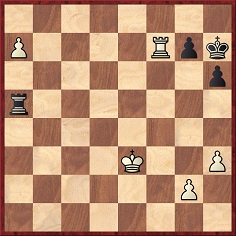
37 Kd4 Kg6 38 Rb7 Kf6 39 Kc4 g5 40 Kb4 Ra1 41 Kb5 Kf5 42 Rf7+ Kg6 43 Rd7 Kf5 44 g3 h5 45 Kb6 Ke4 46 Kb7 Kf3 47 Rd3+ Kg2 48 Rd5 g4 49 Rxh5 gxh3 50 g4 Kg3 51 g5 Rb1+ 52 Kc6 Rc1+ 53 Kd6 Ra1 54 Rh7 h2 55 g6 Ra6+ 56 Ke5 Rxa7 57 g7 Rxg7 58 Rxg7+ Kf2 Drawn.
(2222)
After reproducing the above score on pages 69-70 of A Chess Omnibus, we added this game, one of two played simultaneously and blindfold by Harrwitz:
Daniel Harrwitz – Smith and Bogle
Glasgow, 1848
Evans Gambit Accepted
1 e4 e5 2 Nf3 Nc6 3 Bc4 Bc5 4 b4 Bxb4 5 c3 Ba5 6 O-O Bb6 7 d4 exd4 8 cxd4 d6 9 Bb2 Nf6 10 d5 Na5 11 Bd3 O-O 12 Nbd2 c5 13 Qc2 h6 14 h3 Qe7 15 Rae1 Nh5 16 e5 Bc7 17 Re4 dxe5 18 Nxe5 Qd6 19 f4 Bf5 20 g4 Bxe4 21 Nxe4 Qxd5 22 gxh5 b6 23 Ng3 Rad8 24 Rd1 Qe6 25 Kh2 Nc6 26 Bf5 Nb4 27 Qg2 Qe8 28 Ne4 Bxe5 29 Bxe5 Qxe5 30 fxe5 Rxd1 31 a3 Na6 32 Nf6+ Kh8 33 Bc2 Rd4 34 Ne4 Nc7 35 Nd6 Kg8 36 Nf5 Ne6 37 Nxd4 Nxd4 38 Qe4 Nxc2 39 Qxc2 Re8 40 Qe4 a5 41 a4 Re6
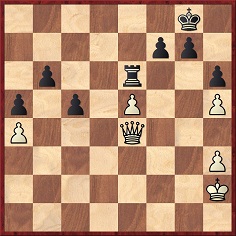
42 Kg3 Kh8 43 Qd5 g6 44 hxg6 Rxg6+ 45 Kf4 Kg7 46 h4 Re6 47 Kf5 Kf8 48 Qd8+ Kg7 49 h5 Rc6 50 Qd7 Re6 51 Qc8 Re7 52 Ke4 Re6 53 Kd5 Re7 54 Qb8 Re6 55 Qd8 c4 56 Qc7 Kf8 57 Qxc4 Re8 58 Qe4 Kg7 59 Kd6 Re6+ 60 Kd7 Kg8 61 Qa8+ Kg7 62 Qb8 Resigns.
Source: Chess Player’s Chronicle, 1848, pages 324-325.
Addition on 30 November 2024:
Eduardo Bauzá Mercére (New York, NY, USA) notes that the former game (the Scotch Gambit) was played in Berlin on 12 July 1841, as recorded on pages 44-45 of von der Lasa’s Berliner Schach-Erinnerungen (Leipzig, 1859).
Page 390 of Kings, Commoners and Knaves (see too our feature article on Jacques Mieses) recorded Morphy’s high view of Hanstein (1811-50), one of the Berlin ‘Pleiades’. This example of his play was given in the Kings, Commoners and Knaves item:
Carl Mayet – Wilhelm Hanstein
1848 (Occasion?)
Scotch Gambit
1 e4 e5 2 Nf3 Nc6 3 d4 exd4 4 Bc4 Bc5 5 O-O d6 6 c3 d3 7 Qxd3 Nf6 8 Be3 Bxe3 9 Qxe3 O-O 10 Nd4 Ne5 11 Bb3 Re8 12 Nd2 Neg4 13 Qf4 c5 14 Nb5 Nge5 15 Rad1 a6 16 Na3 b5 17 h3 Bb7 18 Bc2 Ng6 19 Qe3 Qc8 20 f4 Qc6 21 Qf2 Re7 22 Rde1 Rae8 23 Re2
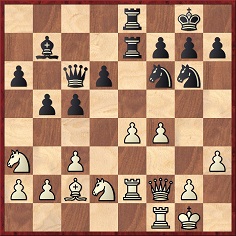
23…Nh5 24 Qe1 Nhxf4 25 Ref2 Nfh5 26 c4 b4 27 Qd1 Ng3 28 Ba4 Qc8 29 Bxe8 Qxe8 30 Nc2 Nxf1 31 Qxf1 Bxe4 32 Ne3 Bb1 33 Qxb1 Rxe3 34 Qf5 Re1+ 35 Nf1 Ne5 36 b3 Qe6 37 Qg5 f6 38 Qd2 Nc6 39 Qf4 Nd4 40 Kh1 Qe5 41 Qg4 h5 42 Qc8+ Kh7 43 Qd7 Ne2 44 Rf3 Ng3+ 45 Rxg3 Qxg3 46 Qf5+ Qg6 47 Qf3 Kh6 48 Qf4+ Qg5 49 Qf2 Qc1 50 Kg1 Rf1+ 51 Qxf1 Qxf1+ 52 Kxf1 Kg5 53 Kf2 Kf4 and Black wins.
Source: Deutsche Schachzeitung, November 1848, pages 427-428.
Presented without any remarks is the following, gleaned from Gabriel Schwartzman’s Internet site:
‘My affaire with chess started at the early age of two. … When I was four years old I played in my first tournament. … At the age of seven I held my first simultaneous exhibition. … In 1985, when I was eight years old, I received my first international invitation to Paris.’
(2239)
From Ed Tassinari (Scarsdale, NY, USA):
‘The 3 November 1958 issue of Sports Illustrated had a short piece, with a number of illustrations, on the 1958 Chess Olympiad in Munich. It was stated that Samuel Reshevsky kept a journal of his experiences at that event, and his candid remarks, regarding his feelings in losing against Unzicker, are remarkable in that such candour from the loser is rare.’
Reshevsky’s words, from page 30 of the article:
‘Suddenly he made an inobvious move I had completely overlooked. I began to perspire; my face turned red. My mind became a complete blank. I sat there a few moments gazing at the board. There was no way out. I finally reconciled myself to the fact that I was lost. I made a few more moves, then I resigned.’
We take the conclusion to the game from page 58 of the March 1959 Schweizerische Schachzeitung:
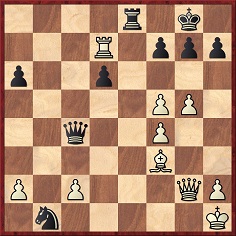
27 Qe2 Qc8 28 Rc7 Qd8 29 Qc4 d5 30 Bxd5 Nd2 31 Qc6 Rf8 32 Rxf7 Rxf7 33 g6 hxg6 34 fxg6 Kf8 35 gxf7 Ne4 36 Qe8+ Resigns.
Unzicker provided notes in the Weltgeschichte des Schachs volume on his career, published in 1962. Another set of annotations by him, from the Süddeutsche Schachblätter, was reproduced on pages 276-277 of Földeák’s book Chess Olympiads.
(2244)
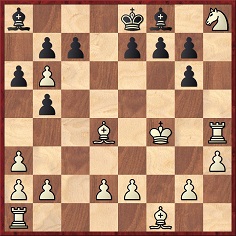
The above position is evidently illegal, but why? Or, more precisely, for how many reasons?
(2275)
The position was taken from pages 11-12 of The Problem Art by T.B. Rowland and F.F. Rowland (New Barnet and Kinstown, 1897), which used retrograde analysis to show the following units as being ‘out of place’:
White: king; rook at h4; bishop at d4; knight; pawn at a3. Moreover, the white queen is needed on the board.
Black: bishop at a8; pawn at b5.
However, Paul Janse (Leiden, the Netherlands) informs us:
‘I think counting the number of reasons for illegality is meaningless, because one such “reason”, for instance the pawn at a3, makes all argumentation about the position, in connection with chess rules, pointless. Maybe the move c2xa3 was played, the pawn capturing a piece which was not even on a3. Or, for all we know, the position in the diagram was the starting position. In that case you could say there is exactly one reason for illegality. However, it is just senseless to distinguish between impossible and impossible. Take a man, snugly living in a cottage on the sun. How many laws of nature are violated? This question is equally unanswerable.’
(2291)
It is hard to resist quoting a double rook ending which the Chess Monthly (January 1881, pages 133-134) described as having ‘such a tragi-comic finish as rarely if ever before chronicled in the annals of serious chess contests’.
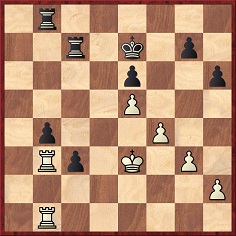
F.K. Esling v J. Wisker, ninth match game, Melbourne, 1880
Black to move.
Wisker immolated himself with 33…c2 34 Rc1 Rd8 35 Ke2 Rd4 36 Rb2 Rdc4 37 Kd2 Rd4+ 38 Ke2 Rdc4 39 Kd2 Rd7+ 40 Ke2 b3 41 Rxb3 Rd1 42 Rxd1 Re4+ 43 Kd2 Rd4+ 44 Kxc2 Resigns.
(2277)
Ever anxious to steal a march, we offer Kingpin’s first game dated 2000:
1 d4 d5 2 c4 c6 3 Nc3 e5 4 dxe5 d4 5 Ne4 Qa5+ 6 Nd2 Nd7 7 Nf3 Nxe5 8 Nxe5 Qxe5 9 Nf3 Bb4+ 10 Bd2 Qd6 11 Nxd4 Qxd4 12 Bxb4 Qxb2 13 Rb1 Qxa2 14 Rc1 c5 15 Bc3 Nf6 16 Qd6 Qa3 17 Rc2 Be6 18 f3 Rd8 19 Qg3 Qb3 20 Rc1 Qa3 21 Rc2 Qb3 22 Rc1 Qa3 23 Rc2 Qb3 Drawn.
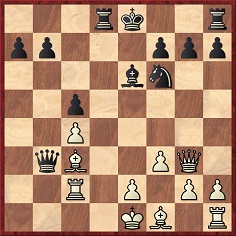
Source: Deutsches Wochenschach, 29 August 1909, pages 300-301.
(Kingpin, 1999)
As mentioned in a footnote on page 81 of A Chess Omnibus, the game was published in the German magazine with notes by its inventor, Alapin.
The following problem is by the American composer Louis H. Jokisch (1851-1938):
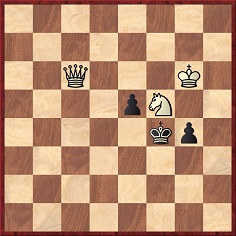
Mate in three
Key move: 1 Qa8. If the position is moved one square to the left a different problem comes about, by B.G. Laws. Its key move is 1 Qg1.
Source: page 49 of The Problem Art by T.B. Rowland and F.F. Rowland (second edition, New Barnet and Kingstown, 1897).
(Kingpin, 1999)
From page 34 of the Chess Player’s Chronicle, 1859:
‘There are now, in London only, no less than 11 periodicals which devote a column once a week exclusively to chess.’
Pages 55-62 of the Chess Player’s Annual and Club Directory of 1889 listed 85 chess clubs in London, as well as, on page 78, 14 ‘chess resorts’ (i.e. cafés and restaurants).
Among the chess resorts was The Grand Divan (Simpson’s), 101 and 102 The Strand. It was open daily from 11 a.m. to 11 p.m. (Sundays, 6 p.m. to 10 p.m.), with an admission price of 6d, or 1s with cigar and coffee. An annual subscription cost two guineas.
(Kingpin, 1999)
A footnote on page 147 of A Chess Omnibus:
A comparison between chess activity in the late nineteenth century and the late 1940s (in terms of chess ‘resorts’, clubs, magazines, etc.) appeared on pages 109-112 of the April 1947 BCM.
From Claus van de Vlierd (Oldenburg, Germany) we acknowledge receipt of a substantial list of historical errors in The Soviet Championships by B. Cafferty and M. Taimanov (Cadogan Chess, 1998).
(2281)
Wanted: information about the author of Bluff your way in Chess (Ravette Books, London, 1993), ‘B.W. Malpass’.
(Kingpin, 1998)
Owen Hindle (Cromer, England) writes:
‘On page 5 of Amos Burn The Quiet Chessmaster by R.N. Coles, there is a mention of the “premature death” of G.E.H. Bellingham, but I know of no evidence of this. In a booklet I had published last year, J.H. Blackburne The Final Years, I put forward the theory that Bellingham gave up chess early following the less than flattering review that his primer Chess received in the January 1909 BCM’.
(2283)
Owen Hindle now points out that a brief reference to Bellingham’s death was made on page 272 of the August 1949 BCM.
(2318)
Further to R.N. Coles’ incorrect reference to the ‘premature death’ of G.E.H. Bellingham (1874-1949), we now see from page 383 of the September 1939 BCM that Bellingham planned a come-back, having announced his participation in the Bath congress scheduled for 9-16 September. The event was cancelled owing to the outbreak of war.
Incidentally, page 69 of Bellingham’s 1908 book Chess quoted this remark by James Mason:
‘However bad the position, or strong the attack, in 99 cases out of a hundred, care and patience will find a way out.’
(2406)
John McCrary (West Columbia, SC, USA) sends us a copy of volume 1 of The Hall-of-Fame History of U.S. Chess, a 94-page work (published in August 1998) which investigates such issues as ‘The US Presidents (and their vices) and chess’, ‘Chess and Baseball’ and ‘Women in Early American Chess’. The last-named article quotes an interesting suggestion from pages 85-86 of the New York, 1857 tournament book that Louis Paulsen’s sister was ‘believed to be the strongest amateur of her sex in the country’.
Our correspondent’s volume should not be confused with The U.S. Chess Hall of Fame by Macon Shibut (Washington, D.C., 1995), which adopts a far less academic approach.
(2284)
Of all possible publishing mishaps, one of the most unfortunate occurred in Paul Keres 50 parties (1916-1939) by J.-A. Le Monnier (Besançon, 1979): after game nine none of the headings identified the players. An errata sheet was added to list the players of the other 41 games, their names having vanished ‘à la suite d’une fausse manœuvre’.
(2286)
From page vii of Part II of The Modern Chess Instructor by Steinitz:
‘One of the principles laid down in Part I of this work is that the Knight is stronger than the Bishop.’
The final page had an erratum:
‘On page vii of Preface top line read: The Bishop is stronger than the Knight.’
(2348)
Stefan Bücker (Nordwalde, Germany) informs us that a US bookstore operating on the Internet is asking $3,000 for a copy of the New York, 1924 tournament book which includes all the competitors’ signatures on a sheet of Alamac Hotel stationery.
In similar listings we have noted some very optimistic pricing. One dealer is prepared to sell a signed copy of Znosko-Borovsky’s The Middle Game in Chess for $1,250 (few chess collectors would probably wish to pay one twentieth of that) as well as, for $10,000, three of Chéron’s endgame books, signed by Fischer. There is also a tendency for exorbitant sums to be asked for books inscribed by lesser-lights to leading figures (most notably to Fischer).
(2308)
Page 94 of Deutsches Wochenschach, 25 April 1920 reported that since his arrival in Berlin at the beginning of the previous year A.S. Selesniev had played some 50 master games (against, among others, Bogoljubow, Réti and Spielmann) without defeat.
(2312)
The opening moves were: 1 d4 Nf6 2 c4 g6 3 Nc3 Bg7 4 e4 d6 5 f4 O-O 6 Nf3 Nbd7 7 Be2 e5 8 dxe5 dxe5 9 fxe5 Ng4 10 Bg5 Qe8 11 Nd5 Ngxe5 12 Be7 Nxf3+ 13 Bxf3 c6 14 Bxf8 Qxf8 15 Nc3 Qc5 16 Qb3 Ne5 17 O-O-O
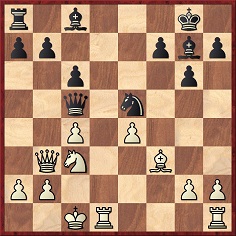
In this position [from a game which a columnist had discussed on pages 83-84 of the 5/1999 New in Chess] Samuel Rosenthal pinpointed 17…Nxc4 as an error, and gave a similar line to Pliester’s. He wrote:
‘Weak. It would be better to play 17…Be6 18 Qxb7 Re8, followed by …Nxc4 or …Bxc4; White could not defend the pawn with b3 because of …Nxf3, followed by …Bxc3.’
In his notes (La Stratégie, 15 August 1885, pages 230-231) Rosenthal disapproved of Black’s second move of the game. At move three he evoked what was later to be the Grünfeld Defence (‘If now 3…d5 4 cxd5 Nxd5 5 e4 Nxc3 6 bxc3, with a very strong centre and Black’s game is hemmed in.’). He liked 5 f4 but would have played 7 e5 instead of 7 Be2. (The pawn advance e5 was a pet move of Rosenthal’s.) Black’s seventh move, he said, lost at least a pawn, but it was difficult to suggest a good line. At move ten he indicated as better 10…f6 11 exf6 Bxf6 12 Bxf6 Nxf6 or Qxf6 13 O-O, although White would ‘maintain the extra pawn and a good position’.
(2314)
Some of today’s chess reporters may care to note how much work Amos Burn put into his weekly column in The Field. To take the 16 May 1914 issue (pages 1012-1013) as an example, the Englishman presented:
Two problems; the solutions to two previous compositions; a lengthy report (over 200 lines) on St Petersburg, 1914, including round-by-round results; eight annotated games from the tournament; an update on results (up to 14 May); a brief report on the Gambit Tournament in Baden, with the crosstable; a feature on Blackburne in Russia, with the text of a testimonial letter to him from the St Petersburg Chess Club; a replies-to-correspondents section (five items). Elsewhere in that issue of The Field was a portrait of the St Petersburg competitors and officials.
Burn’s column (actually five long columns, taking up nearly two pages of the magazine) puts to shame the ‘work’ of most modern chess journalists.
(2331)
From Tim Harding (Dublin):
‘All due credit to Amos Burn, but in my experience the chess columnists are fighting for every column inch they can squeeze from the editors and senior executives of the publications they write for. The editors of the late twentieth century are not interested in chess by the yard, unfortunately. So there is no reason to speak of the “shame” of journalists who don’t write at Burn’s length.’
We see so many column inches wasted by chess writers that the key problem/issue must surely be the amount of work invested rather than the quantity of space allotted. On the subject of space, we offered Mr Harding some here to reply to our earlier criticisms of his output (e.g. C.N. 2255). The offer was neither accepted nor even acknowledged.
(2358)
C.N. 2255 is given in The Chess Chamber of Horrors. Burn’s Field column of 16 May 1914 was reproduced in its entirety in C.N. 8309.
Alessandro Nizzola (Mantova, Italy) writes:
‘I recently discovered an unknown game by Adolf Anderssen, a loss against Dubois. It was played according to the Italian rules of castling, at the home of Löwenthal. The source is a sheet manuscript which was owned by the nineteenth-century Italian player Francesco Discart and is now in my possession.’
Adolf Anderssen – Serafino Dubois
London, 1862
Muzio Gambit
1 e4 e5 2 f4 exf4 3 Nf3 g5 4 Bc4 g4 5 O-O (Kh1, Rf1) gxf3 6 Qxf3 Bh6 7 d4 Qh4 8 Nc3 Ne7 9 Bd2 d6 10 Rae1 Nbc6 11 Nb5 Bg4 12 Qb3 O-O-O (Kb8, Rc8) 13 Bc3 f5 14 e5 dxe5 15 d5 Nd4 16 Nxd4 exd4 17 Bxd4 Rhe8 18 Re6 f3 19 g3 Qh3 20 Rf2 f4 21 Ba6 b6 22 Rxb6+1 cxb6 23 Bxb6 Nxd5
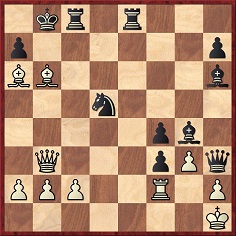
24 Bxa7+ Kc7 25 Qc4+ Kd6 and wins.
(2337)
On page 82 of A Chess Omnibus we added this note regarding 22 Rxb6+:
It seems that after 22 Bxb6 White would not stand worse.
Mr Nizzola adds:
‘I now learn that the game was published in the Nuova Rivista degli Scacchi, 1 December 1875, page 87, and that it was played on 29 June 1862. My new source is the book Serafino Dubois, il Professionista by A. Innocenti and L. Barsi (Messaggerie Scacchistiche, Brescia, 2000), as well as a letter in the June 2000 L’Italia Scacchistica (page 258) from a reader, Giovanni Lucci.’
(2414)
What has been the most prestigious line-up in a club team? A strong candidate must be the City of London’s team which played against Bermondsey Chess Club, giving knight odds, on 23 October 1874: Steinitz, Zukertort, Bird, Blackburne, Boden, MacDonnell, De Vere, Löwenthal, Potter, Hoffer, Lord and Ballard (substituted for Wisker). The City side won +9 –3 =0.
Source: The City of London Chess Magazine, November 1874, page 237.
(2350)
Not many games played by Grünfeld during the Second World War seem to have been published, but here is an unusual miniature:
Meyer – Ernst Grünfeld
Vienna, 30 November 1943
Queen’s Gambit Accepted
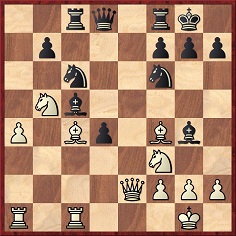
17 Bxf7+ Rxf7 18 Rxc5 Nd7 19 Qc4 Nxc5 20 Ng5 Ne5 21 Bxe5 Qxg5 22 Nd6 Be6 23 Nxf7 Kxf7 24 White resigns.
Source: Deutsche Schachzeitung, January 1944, page 21. The game was given with Grünfeld’s annotations.
(2351)
‘It is a leading maxim of the modern school, that the bishops should, as far as possible, be kept in communication with both wings.’
Chess Exemplified by W.J. Greenwell (Leeds, 1890), page 21.
(2352)
There cannot be many political figures who have written books which mention chess, yet François Mitterrand did so in the opening paragraph of his 1978 work L’abeille et l’architecte:
‘As a child I did not play cards, any more than I do today. I did play chess, which I learned at the age of about ten, because my maternal grandfather, with whom I lived for half the year, out in the country, three kilometres from the nearest hamlet, had only one opponent to hand. We spent long evenings playing, unaware of the time passing as we moved our pieces around until the king was lost, after which we retired to bed, our heads buzzing with glory or with thoughts of revenge.’
(2391)
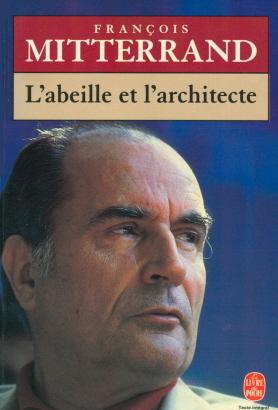
See too C.N. 6594.
‘The greatest polyhistor in the history of chess’ was W. Heidenfeld’s description of Berger (BCM, August 1970, page 233).
(2387)
An oft-published miniature:
1 e4 e5 2 f4 exf4 3 Nf3 g5 4 h4 g4 5 Ng5 h6 6 Nxf7 Kxf7 7 d4 d6 8 Bxf4 Nc6 9 Bc4+ Kg7 10 O-O Qxh4 11 Qd3 Nf6 12 e5 Nh5 13 Bg3 Qe7 14 Bh4 Qe8 15 Bf6+ Nxf6 16 exf6 mate.
The usual heading (e.g. on page 200 of Chernev’s 1000 Best Short Games of Chess) is: ‘Maurian v Amateur, New Orleans, 1866’. However, the game was published on pages 212-213 of the 15 July 1891 issue of La Stratégie as played between Maurian and B.W. May at the Café de la Régence, Paris on 3 June 1891.
(2393)
This position was published on page 335 of La Stratégie, 15 October 1896:
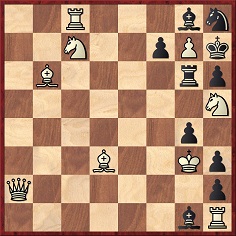
However improbable it may seem, the caption reads ‘A curious ending played recently in Havana’, the players being named as A.C. Vázquez and A. Fiol. White, it is said, announced mate in three moves. Has there ever been a more unlikely claim that a position arose in actual play?
(2413)
Page 338 of the October 1919 BCM reported that Signor Anton Mario Lanza of Milan intended to bring out an ‘Encyclopaedia of Chess’ and was seeking assistance. (When this report was briefly mentioned on page 50 of January 1999 BCM his name was abbreviated to that of a famous actor/singer: ‘Mario Lanza’.) Page 88 of the April 1953 issue of La Scacchiera had a photograph of Lanza [see below], whom it called (inaccurately) ‘the author of the world’s first chess encyclopaedia’. Whilst reporting that the work had not yet been completed, owing to Lanza’s long illness, La Scacchiera sounded a positive note of expectation. But there was soon a change of tone by the magazine, which was also the intended publisher of the opus; a frosty editorial in the November 1953 issue (page 238) concluded that, despite a claim by Lanza that compiling the encyclopaedia had required nearly 40 years’ work, no book had in fact been written.
The entry on Lanza on page 303 of Chicco and Porreca’s Dizionario enciclopedico degli scacchi (Milan, 1971) affirmed that he tried to compile the book throughout his life but was unable to finish it. Subsequently, two Italian chess bibliographies (Lineamenti di una bibliografia italiana degli scacchi and Bibliografia italiana degli scacchi) recorded that three parts of Lanza’s Enciclopedia degli scacchi had been published (i.e. a modest alphabetical incursion from A to Alborghetti).
There is also some information about Lanza in Storia degli scacchi in Italia by Chicco and Rosino (Venice, 1990). Born in Palermo in 1889, he died in Milan in 1964 without ever becoming the author of a chess book.
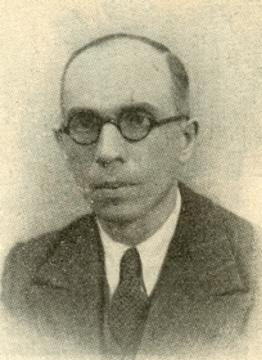
(2427)
Ed Tassinari (Scarsdale, NY, USA) writes:
‘Reshevsky and Smyslov first met over the board at Leningrad/Moscow, 1939. Their final serious games took place at the Moscow Veterans’ Tournament in 1991, and a later four-game match at 30/30, in Moscow. Thus 52 years had elapsed between first and last serious play. Is this the longest time for players of IM/GM strength? Reshevsky and Fine apparently first met in tournament play at the championship of the Western Chess Association in Minneapolis in 1932. (Shortly afterwards they also played at Pasadena, 1932. Oddly, that seems to be one of the missing games from the event; it is not given in Gordon’s tome on Reshevsky.) In 1986, they played an exhibition game (at 30/30) during the 1986 US Open Championship in New Jersey. Thus, 54 years, if one contends that the exhibition game is a valid serious encounter.’
Does anybody have the score of the Pasadena game? Fine mentions it in a footnote on page 30 of his book Bobby Fischer’s Conquest of the World’s Chess Championship.
(2429)
From Arnold Denker (Fort Lauderdale, FL, USA):
‘In 1946 at Groningen, Smyslov and I first played to an exciting draw. Fifty years later, again at Groningen and again with me having the black pieces, we drew. Regarding Reshevsky, I first played him at the Western Chess Association Meeting in Chicago in 1934, where I finished fourth after Fine and Reshevsky (equal first) and Dake. Reshevsky had been going to school to become an accountant, which was financed by Rosenwald, the head of Sears and Roebuck. Mr Rosenwald, his benefactor, insisted that he not play during school, so he was a bit out of practice, but I will never forget his marvelous knight maneuvers that helped him draw a most difficult ending with me. Considering that I was in top form after just beating Fine in match play 3-2 and 4 draws, that speaks very well for Sammy. My match with Fine was played for $50 put up by James R. Newman. The first to win three games was to be the victor. Fine won the first two games and then never won another. In the last game after I had tied the score he was an exchange down and never showed up after the adjournment. I had the Indian sign on him after that, just as Sammy had the Indian sign on me for many years, until 1948, when I beat him 2-0 in a practice match, after which he dropped out.’
Since we did not find the above-mentioned draw in various databases, it is given here, taken from S. Gordon’s 1997 book on Reshevsky:
Samuel Reshevsky – Arnold Denker
Chicago, July 1934
Nimzo-Indian Defence
1 d4 Nf6 2 c4 e6 3 Nc3 Bb4 4 e3 O-O 5 Bd3 c5 6 Nge2 Nc6 7 O-O d5 8 a3 cxd4 9 exd4 dxc4 10 Bxc4 Bd6 11 d5 exd5 12 Nxd5 Nxd5 13 Bxd5 Qf6 14 Nc3 Bf5 15 Be3 Rfd8 16 Qb3 Rd7 17 Rad1 Be5 18 Ne4 Qg6 19 f3 Rc7 20 Rc1 Rac8 21 Qa4 Bxb2 22 Rc2 b5 23 Qa6 Bd4 24 Bxd4 Nxd4 25 Qxg6 Bxg6 26 Rxc7 Rxc7 27 Rd1 Ne6 28 Bxe6 fxe6 29 Ng5 Re7 30 Rd8+ Re8 31 Rd7 a5 32 Rb7 Bd3
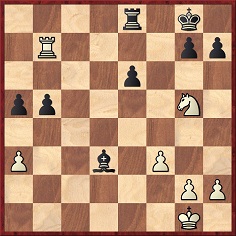
33 Nf7 Rc8 34 Nd6 Rc1+ 35 Kf2 h6 36 Nxb5 Rc2+ 37 Kg1 Ra2 38 Nd4 e5
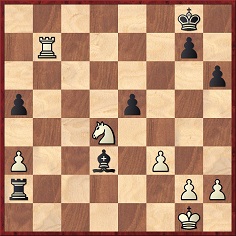
39 Ne6 g6 40 Nc5 Bc2 41 Nd7 Rxa3 42 Nf6+ Kf8 43 Rd7 g5 44 Nh7+ Ke8 45 Nf6+ Kf8 46 Nh7+ Kg8 47 Nf6+ Kh8 48 Ra7 a4 49 h3 Rc3 50 Kh2 Rc6 51 Nd7 Kg8 52 Nxe5 Re6 53 Nd7 Rd6 54 h4 gxh4 55 Ne5 Re6 Drawn.
(2438)
On the basis of Gordon’s book, we gave White’s 39th move as Nb3. Gert Ligterink (Groningen, the Netherlands) subsequently wrote to us that the move played was almost certainly Ne6, so we checked with Arnold Denker. He informed us that 39 Ne6 was indeed the move played.
(2453)
Naming racehorses after chess masters (see page 5 of the 6/2000 New in Chess) is not a novelty, and there was already a four-legged Steinitz in the nineteenth century. The Spirit of the Times of 24 April 1886 reported that T. Frère had given that name to his bay colt, and this prompted Steinitz to declare on page 113 of the May 1886 International Chess Magazine:
‘I can only express my most thankful appreciation of the unique and original compliment paid to me by Mr Frère, and I wish the utmost success to my namesake on the Turf.’
On page 331 of Chess Review, November 1952 Tartakower wrote:
‘It is well known that Capablanca was very popular in Buenos Aires; and, after I visited that city in 1931, my name often appeared in the newspapers there. Later on, we each had a racehorse named after us. It was gratifying to learn that “Tartakower” (the racehorse) chalked up more victories than his equine rival, “Capablanca”.’
(2437)
From Yasser Seirawan (Seattle, WA, USA):
‘In 1999 I chaperoned the Malaysian businessman Dato Tan Chin Nam on his visit to Seattle. He asked my permission to have a racehorse named after me, and I happily assented, asking if he had others named after leading chessplayers. Dato stated that his stable included a racehorse called Kasparov. “In that case”, I said, “just make sure my horse is faster than Kasparov”.’
(2466)
Positions are sought where a king was chased to its doom, as in the following specimen:
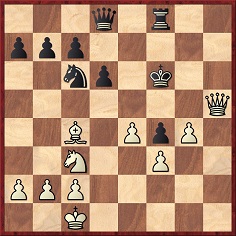
R.J. Loman-O. Müller, London, 1897
Loman played: 1 Qh6+ Ke5 2 Qe6+ Kd4 3 Qd5+ Ke3 4 Qd3+ Kf2 5 Qf1+ Kg3 6 Ne2+ Kh4 7 Qh1+ Kg5 8 Qh5+ Kf6 9 Qh6+ Ke5 10 Qe6 mate.
Source: Deutsches Wochenschach, 11 July 1897, page 227.
(2462)
From Carl Fredrik Johansson (Stockholm), the Editor of Schacknytt:
‘On 12 December 2000 the Stockholm Rapid Chess Summit was held in Rosenbad (the Swedish Prime Minister’s Office). At the inauguration ceremony four prime ministers were present: Göran Persson (Sweden), Mart Laar (Estonia), Andriz Bērziņš (Latvia) and Rolandas Paksas (Lithuania). Mr Persson and Mr Laar played a short game of chess, which proved very popular with all the photographers present. It went: 1 e4 e5 2 Nf3 Nf6 3 d3 Bd6 4 Ng5 O-O, and a draw was agreed. Are any other games between prime ministers known to exist?’
(2474)
Two positions with geometrical play:
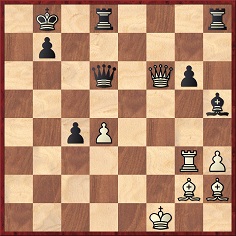
Cyril Bexley Vansittart-N.N., Rome (date?)
White played 1 Ra3 and after 1…Qxh2 announced mate in three, i.e. 2 Ra8+ Kxa8 3 Qa6+, etc.
Source: Chess Monthly, December 1885, page 122.
Now a most unusual form of perpetual check:

Görgen-Arno Faust, Sprendlingen, 1938
1…Qe1+ 2 Kxf4 Qh4+ 3 Kf5 Qh5+ 4 Ke6 Qe8+ Drawn.
Source: Deutsche Schachblätter, 15 September 1938, page 284.
(2494)
President Grévy
A head of state genuinely connected with chess was Jules Grévy (1807-91). When he was elected President of France in 1879 La Stratégie (15 February 1879 issue, pages 51-52) described him as ‘a very strong chess amateur’ and recalled that under the Empire he had often been seen at the Café de la Régence and had played many games against Jean Preti. However, he had been absent from chess for about a decade, owing to his political commitments.
The French magazine’s obituary of Grévy (15 September 1891 issue, pages 277-278) commented that his most frequent chess opponent had been Albert Clerc, counsellor at the Paris Court of Appeal, who had participated in the Paris, 1878 tournament. A game between the two was published in Le Matin of 6 October 1891, an article reproduced in La Stratégie, January 1916, pages 18-20:
Jules Grévy – Albert Clerc
Paris, 28 January 1856
King’s Gambit Accepted
1 e4 e5 2 f4 exf4 3 Nf3 g5 4 h4 g4 5 Ne5 h5 6 Bc4 Nh6 7 d4 f3 8 gxf3 d6 9 Nd3 Nc6 10 Be3 Bg7 11 c3 Qe7 12 Nf4 Bf6 13 Nxh5 Bxh4+ 14 Kd2 gxf3 15 Qxf3 Bg4 16 Ng7+ Kd7 17 Qg2 Rag8 18 Bxh6 Bg5+ 19 Kc2 Bxh6 20 Qxg4+ Kd8
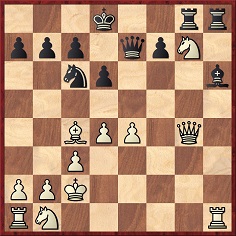
21 Rxh6 Rxh6 22 Ne6+ fxe6 23 Qxg8+ Kd7 24 Nd2 Na5 25 Rf1 Rh7 26 Bxe6+ Kc6 27 b4 Rh2 28 Bd5+ Kb6 29 bxa5+ Kxa5 30 Qg3 Resigns.
In addition to the game against Clerc, two losses by Grévy against P. Journoud were given in an article on pages 481-483 of issue 32 of Les Cahiers de l’Echiquier Français, taken from La Régence of 1860-61. Further information about Grévy may be found on pages 97-101 of the April 1887 International Chess Magazine.
(2511)
C.N. 2511 referred to the source of two games lost by the President of France, Jules Grévy (1807-91), against P. Journoud. They are now given below:
Paul Journoud – Jules Grévy
Occasion?
Scotch Gambit
1 e4 e5 2 Nf3 Nc6 3 d4 exd4 4 Bc4 Nf6 5 Ng5 Ne5 6 Qxd4 Nxc4 7 Qxc4 d5 8 exd5 Nxd5 9 O-O Be7 10 Nc3 c6 11 Nxd5 cxd5 12 Qb5+ Qd7 13 Qd3 Qf5 14 Re1 h6 15 Qe2 Qf6 16 h4 Bd7 17 b3 hxg5 18 Bxg5 Qe6 19 Qd2 Qc6 20 Rxe7+ Kf8 21 Rae1 Be6 22 R1xe6 fxe6 and White announced mate in three.
Paul Journoud – Jules Grévy
Occasion?
Sicilian Defence
1 e4 c5 2 f4 e6 3 Nf3 d5 4 e5 Nc6 5 c4 d4 6 d3 Nh6 7 Be2 Be7 8 O-O O-O 9 h3 f6 10 Nbd2 Nf5 11 Ne4 fxe5 12 fxe5 Qc7 13 g4 Ne3 14 Bxe3 dxe3 15 Qc1 Nxe5 16 Qxe3 Nxf3+ 17 Rxf3 b6 18 Rxf8+ Bxf8 19 Rf1 Bb7 20 Ng5 e5 21 Bf3 Re8 22 Be4 h6 23 Rf7 Be7 24 Rxg7+ Kh8
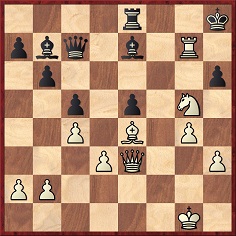
White announced mate in five.
(2873)
C.N. 2436 quoted some advice from page 67 of How to Play Chess by Charlotte Boardman Rogers (New York, 1907):
‘The object of the game is, of course, to checkmate the king, and before the first move, the player should determine in his own mind how he is going to do it and then develop the fighting qualities of his men accordingly.’
The same page of the book offers this pronouncement:
‘In the early days of chess-playing, people used to take literally weeks in which to make a single move, as they wished to study every possible situation which might develop therefrom. The chessboard would become grey with dust and all interest, as far as the spectators were concerned, would be gone.’
(2512)
Carl Walbrodt – Eugene Delmar
First match game, New York, 1893
Philidor’s Defence
1 e4 e5 2 Nf3 Nf6 3 Nc3 d6 4 d4 Nbd7 5 Be2 Be7 6 O-O c6 7 b3 Qc7 8 Bb2 Nf8 9 Qd2 h6 10 Rad1 Bg4 11 dxe5 dxe5
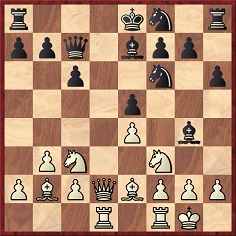
12 Nxe5 (Later examples of a similar sacrifice include Nimzowitsch-Marco, Göteborg, 1920 and Castaldi-Tartakower, Stockholm, 1937.) 12…Rd8 13 Nd3 Bd6 14 e5 Bxe5 15 Bxg4 Nxg4 16 Qe2 h5 17 h3 Ne6 18 Nxe5 Nxe5 19 Nb5 cxb5 20 Bxe5 Qc6 21 Rxd8+ Kxd8 22 Qe3 Ke7 23 Re1 Rh6 24 c4 Rg6 25 f3 bxc4 26 Rc1 Qc5 27 Qxc5+ Nxc5 28 Rxc4 Nd3 29 Bb8 f5 30 Rc3 Nb4 31 Rc7+ Kd8 32 Rxb7 Nxa2 33 Bxa7 Nc1 34 Be3 Nd3 35 Bd4 Ne1 36 Rxg7 Nxf3+ 37 Kf2 Rxg7 38 Bxg7 Nd2 39 b4 Kd7 40 Kg3 Ke6 41 Kh4 f4 42 Kxh5 f3 43 gxf3 Nxf3 44 Kg4 Nd2 45 h4 Nc4 46 h5 Nd6 47 h6 Kf7 48 Kf4 Ne8 49 Be5 Kg6 50 b5 Resigns.
Source: BCM, June 1893, pages 285-286.
Pages 306-307 of the July 1893 BCM reported that a subsequent game in the match (also with Walbrodt playing White) began 1 e4 e6 2 d4 d5 3 Nc3 Nf6 4 Bg5 Be7 5 Bxf6 Bxf6 6 e5 Be7 7 f4 c5 8 dxc5 Bxc5, after which:
‘…Walbrodt intended to continue with the Steinitz attack, 9 Qg4, but found that his king and queen had been transposed inadvertently in setting up the pieces, so that he could not make this move, for Mr Delmar insisted on the rules in Staunton’s Companion which govern this match being observed, one of which says that if more than four moves have been made before a misplacement is discovered, the position holds good. Walbrodt therefore played instead 9 Nge2, and eventually won the game.’
When selecting the above Philidor’s Defence game for publication we happened to note a discrepancy with an article on the Walbrodt v Delmar match by John S. Hilbert on pages 23-32 of issue 5 of Lasker & His Contemporaries (where a different score was given as the first match game). We have therefore raised the matter with John Hilbert, who responds as follows:
‘The error is mine, and I am not entirely sure how it came about. The correct game-score, the Philidor’s Defence game as given by you, was published in the New York Sun for 24 April 1893. Thank you for, literally, setting the score straight.
As you note, the third match-game between Walbrodt and Delmar was played under rather unusual circumstances. After eight moves it was discovered that Walbrodt had inadvertently reversed the position of his king and queen in setting up the board. Delmar insisted the game be played out with his opponent’s royalty remaining where they were. Despite this somewhat curious handicap, Walbrodt went on to win the game.
Apparently Delmar didn’t learn his lesson about how rigidly requiring rules to be enforced could boomerang. At the Buffalo tournament the following year his sixth-round opponent overslept and faced playing his first 25 moves in ten minutes. His opponent’s roommate, Walter Frere, had also overslept, and his opponent, Philadelphia’s John Welsh Young, was willing to give Frere his full time back if Delmar were prepared to do the same for his opponent. Delmar refused. His opponent, Hermann Helms, made the time-limit, and went on to win. See pages 72-73 and 76 of my book Buffalo 1901 and 1894 Chess Tournaments (Yorklyn, 1996).’
Eugene Delmar – Hermann Helms
Buffalo, August 1894
Queen’s Fianchetto Opening
1 b3 e5 2 Bb2 d5 3 Bxe5 Nc6 4 Bb2 Nf6 5 e3 Be7 6 Nf3 Be6 7 Be2 Qd7 8 d4 Ne4 9 O-O f5 10 Nbd2 Bf6 11 c4 O-O-O 12 Rc1 g5 13 cxd5 Bxd5 14 Bc4 h5 15 Bxd5 Qxd5 (It is hard to imagine what Delmar had in mind when playing his next move.) 16 Rc5 Nxc5 17 Nc4 Ne4 18 Qe2 h4 19 Ne1 g4 20 Nd3 Bg5 21 f3 gxf3 22 gxf3 Rdg8 23 Kh1 Ng3+ 24 hxg3 hxg3+ 25 Kg1 Rh2 26 Qe1 Rgh8 27 Qxg3 R2h3 28 Qg2 b5 29 e4 Qg8 30 Nf2 Rh2 31 Qg3 Bf4 32 Qxg8+ Rxg8+ 33 White resigns.
Source: Brooklyn Standard Union, 17 August 1894.
(2530)
From today’s range of chess books for beginners we believe that one stands out as the best: The Complete Idiot’s Guide to Chess by Patrick Wolff (second edition, Indianapolis, 2002). It is a 367-page paperback and costs $16.95. Written breezily but with care, the book is particularly successful in conveying the author’s zest for the game. In the Introduction (page xii) he writes:
‘… I have years of experience teaching people of all levels how to play chess. I know lots of people think chess is for high-brows, but I also know that’s nonsense. Chess is an incredibly fun game. It offers a lifetime of excitement, beauty, and challenge to anyone who takes it up. Sure chess exercises your brain: That’s what makes it so great! But it’s absolutely not just for intellectuals. Anyone can learn chess and learn to play it well, and just about everyone who does so loves it forever after.’
(2546)
From John Hilbert (Amherst, NY, USA):
‘In discussing the marathon 14th match-game between Lasker and Tarrasch in 1908, in which Tarrasch, a bishop ahead but in what was considered at the time to be a dead drawn rook and bishop vs. rook endgame, continued to play on for 50 moves despite having no chance to win, Walter Penn Shipley wrote in his 25 October 1908 Philadelphia Inquirer column:
“The continuation reminds us very much of a game played in one of the Franklin Chess Club championship tournaments between Emil Kemeny and a strong member of the Franklin Chess Club. Kemeny had a king and his opponent had king and pawn, Kemeny, however, having the opposition. Kemeny mildly suggested that the game was a draw, but his opponent remarked that he was a pawn ahead and that no doubt the game was a draw if Kemeny made the best moves, but so was the game from the start and that he proposed to continue. Kemeny had about two hours’ extra time to spare, so he remarked certainly he would be glad to continue the game, and it being his move, his clock going, he left the room, bought a newspaper, returned, [and] sat down in a comfortable chair by the window to look over the news of the day. His opponent fidgeted around for ten or 15 minutes and then called Kemeny’s attention to the fact that it was his move and that his clock was going. ‘Oh, yes’, said Kemeny, ‘I know that, but I was just a little tired; thought I would take a rest of an hour or so, and look over the paper. Before my time is run out I will make a move.’ A smile went around among the other players in the room, and about ten minutes later Kemeny’s opponent remarked that he guessed after all that the position was only a draw and he was quite content to have the game so scored. Kemeny bowed politely and said it was entirely agreeable to him to have the game scored as drawn or to have it continued.”
Shipley did not identify Kemeny’s obdurate opponent or the Franklin championship tournament in which this lesson in when enough should be enough was given. Research now rudely reveals, however, what Shipley’s good manners refrained from mentioning. Kemeny’s opponent was the strong club player Alfred K. Robinson, and the game was played in the 1894-95 Franklin championship. Kemeny himself published the game in his 16 February 1895 Philadelphia Ledger column, though with no reference to his opponent’s stubbornness. Robinson was 45 at the time the game was played, and would continue living in Philadelphia until his death in 1918. Shipley’s decision not to reveal Robinson’s identity in his 1908 column no doubt helped keep the peace at the Franklin. The position when Kemeny purchased his newspaper was:
Curiously enough, neither Robinson, who had a score of 9½-4½, nor Kemeny, who stood even better, at 13-2, was able to finish the 1894-95 Franklin championship. That year’s title went instead to D. Stuart Robinson, who finished with a score of 17-5.’
(Kingpin, 2001)
On 18 January 1889 a retired marine infantry captain named Joinaux died in his 76th year. Then, as now, his name was unknown in the chess world, but since 1853 he had been carrying out ‘un véritable travail de bénédictin’, compiling by hand an enormous chess encyclopaedia in eight parts (openings, endings, annotations, problems, endgame studies, bibliography, etc.). An overview of Joinaux’s Musée des Echecs was provided by Renault on pages 59-60 of the 15 February 1889 issue of La Stratégie, and it concluded with this incredible statement: ‘The Musée comprises about 20,000 games, all annotated by the great players, and as many problems.’
What became of the Joinaux manuscript?
(Kingpin, 2001)
When was the first instructional film on chess produced? We do not know, but it can be mentioned that the concept was put forward by Ernest C. Mortimer on page 102 of the January 1924 Chess Amateur, in a feature entitled ‘Chess and the Cinematograph’:
‘The idea, such as it is, of this article occurred to me while watching the film Armaggedon at the Tivoli in the Strand. In that film a long step forward has been taken in what may be called “the science of explanation”. By means of diagrammatic representation, which is not merely static, as on the printed page, but dynamic, the campaign in Palestine is described more simply and clearly than would be possible by any other mode. The average onlooker can pick up in an hour or so the essentials of the campaign better than by hearing any number of lectures or reading columns of despatches.
There is no doubt that this method of exposition will be perfected and applied in many ways. It seems to me to be especially applicable to the teaching of chess. The chief difficulty in popularizing chess is undoubtedly the initial difficulty of explaining the moves and powers of the pieces, which must seem complicated to the beginner however able the instructor may be.
[…] The commercial practicability of the idea is a matter entirely beyond me, but I do not see why a carefully prepared short film, How to Play Chess, should not be a popular item in a film programme. It would certainly be something new! If the scheme were taken up it might advance to explanatory films of well-known games, for the enjoyment of those who are not beginners, but this is looking too far ahead.’
(2547)
From John Donaldson (Berkeley, CA, USA):
‘Philip Woliston first came to the attention of the chess world when he won the 1939 California State Championship ahead of several prominent players. Chess Review (December 1939, page 259) wrote:
“Philip Woliston, 19-year-old Los Angeles youth, scored a smashing victory in his conquest of the California State Championship tournament which concluded 23 November. Losing only one of his eight games, he outranked a field which included Harry Borochow, state titlist since 1930, Herman Steiner of the 1931 American international team, and George Koltanowski, better known for his exploits sans voir.
Woliston, youngest competitor in the field of nine, and the youngest state champion ever to win El Dorado’s crown, has made an auspicious entry in this, his first important tournament. 1. Woliston 7-1; 2-3. Borochow and Steiner 6; 4. Koltanowski 4½; 5. Kovacs 4; 6. Fink 3; 7. Patterson 2½; 8. Bazad 2; 9. Gibbs 0.”
Later in 1939 Woliston lost a match to Steiner. The following year he played in the US Championship and Ventnor City, finishing near the bottom of the field in the former but with a respectable 50% in the latter.
Reshevsky included a victory over Woliston (1940 US Championship) in his book(s) Reshevsky’s Best Games of Chess/Reshevsky on Chess.
The name of Philip Woliston disappears after Ventnor City, 1940. He does not appear on the United States Social Security Death Index. Did he perhaps die during the Second World War? Woliston spent his high school years in Seattle (he attended the same high school as Olaf Ulvestad, but a few years later) before relocating to Los Angeles. Does anyone know what happened to him?’
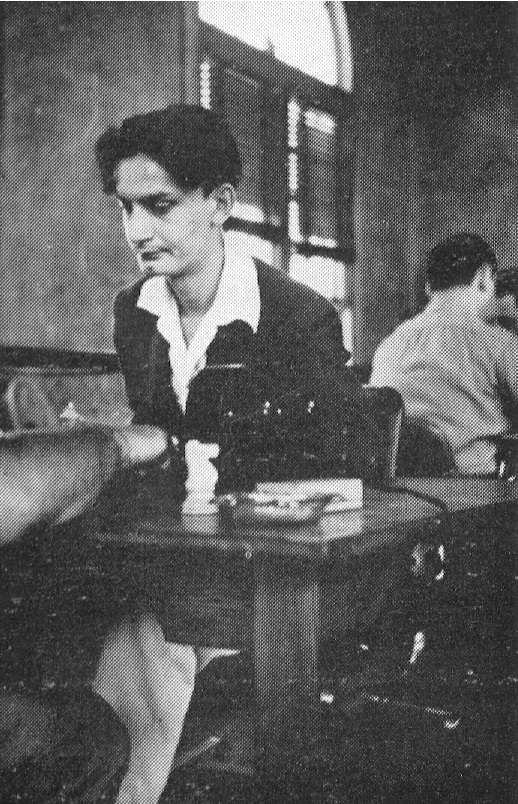
Philip Woliston
(2551)
In C.N. 2551 John Donaldson asked what became of Philip Woliston, a US player well-known some 60 years ago. Our correspondent has now provided the answer, jointly with John Hilbert, in a detailed article published on pages 26-29 of the October 2003 Chess Life. Woliston, né Philip Reinhold Geffe, is still alive, a resident of Murrieta, CA. Woliston was his mother’s maiden name.
(3063)
The Chess Scene by D. Levy and S. Reuben (London, 1974) has a considerable penchant for anecdotes whose main, or sole, interest seems to lie in whether they can be traced back to a reliable source. With regard to the ‘Absent-minded Grandmasters’ section on pages 95-96, for instance, we are moderately curious as to the origins of this epic contribution to chess scholarship:
‘Tartakover was once playing in a tournament on a very hot day. He called for a glass of iced water. The waiter prepared him a drink with lavish care, squeezing out fresh oranges. He brought it to the table where Tartakover was deep in thought. Without looking at it, Tartakover picked up the glass and poured the contents over his head.’
(2556)
A footnote on page 360 of A Chess Omnibus:
In an article about Tartakower in the Chess Café archives, Hans Kmoch wrote regarding Tartakower at the 1950 Olympiad in Dubrovnik: ‘Only occasionally did his grim sense of humor break through, as on the day he ordered water, got lemonade, and washed his face with it anyway.’ See also CHESS, February 2003, pages 35-36
A further reference is Kmoch’s obituary of Tartakower on pages 123-125 of the April 1956 Chess Review.
The position below, which occurred in the game Ståhlberg v Bogoljubow, Stockholm, October 1930, is taken from page 373 of the December 1930 Deutsche Schachzeitung. A snap question: how many passed pawns are there on the board?
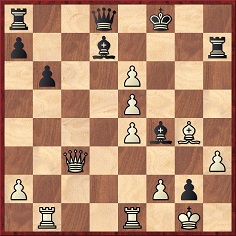
On the basis of definitions given in various reference books, the answer presumably has to be six (five white, one black), even if it is difficult to regard the units at e4 and e5 as passed pawns.
(2558)
We have been unable to find game-scores which fit in with the following report, taken from page 315 of the Chess Amateur, July 1908:
‘Referring to “hallucinations that occur in match and tournament play”, Mr Bruno Siegheim mentions in the Johannesburg Sunday Times that in one of the games of the Blackburne-Steinitz match, a check which could have won a rook was left on for several moves. The possibility was seen by everyone present in the room except the two players. Mr Siegheim adds that a still more curious incident occurred at Breslau, in an Alapin-Blackburne game. Mr Blackburne checkmated his opponent, but assuming that Herr Alapin would see the mate, Mr Blackburne did not announce it. Herr Alapin looked at the position intently, trying to find a move, and the spectators smiled and whispered. At the end of five minutes Mr Blackburne relieved his opponent’s anxiety by informing him that he had been checkmated.’
(2557)
‘Paris in 1879 was the scene of this glorious massacre. Schnitzler (White) was the winner and Alexandre (Black) his unfortunate victim.’ So writes John Walker on page 63 of 64 Things You Need to Know in Chess (London, 2002), but is it known whether these particulars are accurate?
First, a reminder of the moves:
1 e4 e5 2 d4 exd4 3 c3 dxc3 4 Bc4 cxb2 5 Bxb2 Qg5 6 Nf3 Qxg2 7 Bxf7+ Kd8 8 Rg1 Bb4+ 9 Nc3 Qh3 10 Rg3 Qh6 11 Qb3 Bxc3+ 12 Qxc3 Nf6
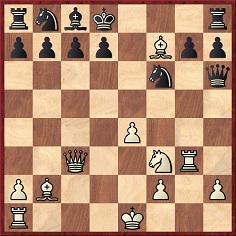
13 Rg6 hxg6 14 Qxf6+ gxf6 15 Bxf6 mate.
An eager researcher may begin by noting the lack of consensus about the occasion of this game. For instance, page 149 of Chernev’s 1000 Best Short Games of Chess had ‘Berlin, 1879’, whereas some other sources state ‘1869’. The players’ names were given with a little more information (i.e. ‘G. Schnitzler’ and ‘A. Alexandre’) in J. du Mont’s 200 Miniature Games of Chess (see pages 82, 282 and 285) and, indeed, on page 28 of John Walker’s book Chess for Tomorrow’s Champions (published in 1983 and 1995), which also used the term ‘glorious massacre’. As regards Black’s name, an eyebrow goes up, since Aaron Alexandre died in 1850. Concerning White, however, an investigator can find plenty of references to, and other games by, Georg Schnitzler by perusing the Deutsche Schachzeitung of the mid- and late-1800s. For example, he learns from page xi of the index to the 1862 volume that Schnitzler was an architect from Düsseldorf, and by checking as far as 1889 he comes across the briefest of mentions of Schnitzler’s death (in London in 1887, according to the July 1889 Deutsche Schachzeitung, page 201).
Yet there is still difficulty in locating the game-score in a dependable contemporary source, and it is a relief at least to find it in a nineteenth-century book such as Chess Sparks by J.H. Ellis (London, 1895), where (page 84) the heading was ‘Played about 1879’, ‘G. Schnitzler’ and ‘Alexandre’.
Perhaps openings books will be more helpful, thinks the sleuth. He sees the score on page 125 of Nordisches Gambit by Ingo Firnhaber (Düsseldorf, 1989) as ‘Schnitzler-Alexandre, Berlin, 1879’, whereas in the discussion of the game on pages 106-107 of Danish Gambit (Coraopolis, 1992) W. John Lutes gave ‘Paris, 1869’ and claimed that Firnhaber had put ‘Berlin, 1869’. There is also puzzlement over this remark about 5…Qg5 in Lutes’ book:
‘Alexandre’s Defense. “Recommended in 1872 by the Deutsche Schachzeitung, but clearly inferior.” du Mont: The Chess Openings Illustrated: Centre Game and Danish Gambit, 1920, page 73.’
The trouble here is that far from recommending 5…Qg5, the 1872 Deutsche Schachzeitung (April issue, page 115) gave the move a question mark. That was in the game Elson-Whiteman, played in the United States. No 1872 issue seems to contain any mention of either ‘Alexandre’ or Schnitzler.
Next, the investigator lights upon a game with 5…Qg5 (between W. Hockin and W. Searle) on page 178 of the Chess Player’s Chronicle, 1872 (where the queen move is described as ‘apparently quite untenable’), but he is still making scant headway with clarifying when and where the ‘glorious massacre’ occurred. At which point, therefore, he unceremoniously breaks off and invites fellow explorers to join in the hunt.
(2570)
‘Since the last match, the membership of the Dutch Chess Federation has doubled. Euwe gets a “fan mail” of three thousand letters a week, which keeps two secretaries at hard whole-time work.’
CHESS, 14 November 1937, page 78
(2576)
‘The following game, played in the recently-concluded Australian championship tournament, was a real “wild-wester” and the unusual conclusion only added to the general excitement. I doubt if any game has ever caused so much comment in Australia and New Zealand.’
So wrote Koshnitsky at the start of an article on pages 360-361 of CHESS, 20 June 1939. He also annotated the game on pages 13-14 of the Australasian Chess Review, 25 January 1939, and below we have incorporated into the game-score a few of his descriptive notes, as well as the punctuation, from both sources:
Alfred William Gyles – Gregory Simon Koshnitsky
Sydney, 1938
Ruy López
1 e4 e5 2 Nf3 Nc6 3 Bb5 a6 4 Ba4 d6 5 c3 Bd7 6 d3 g6 7 Nbd2 Bg7 8 Nf1 Nf6 9 Ne3 h6 10 Qe2 Ne7 11 Bc2 c5 12 a4 b5 13 O-O O-O 14 Bd2 Nh5 15 g3 Qc7 16 Bb3 Be6 (‘An impatient move. I deliberately invited complications. But I got more than I bargained for.’) 17 Bxe6 fxe6 18 Ng4 Kh7 19 d4 exd4 20 axb5 axb5 21 Rxa8 Rxa8 22 Qxb5 Rb8 23 Qc4 d5 24 exd5 exd5 25 Qa2 d3 (Given an exclamation mark in the Australian magazine, but in CHESS Koshnitsky put ‘!?’ and added: ‘Was 25…dxc3 better? Perhaps. At any rate it was safer. But the temptation to obtain the passed pawn on the sixth was difficult to resist.’) 26 Re1 c4 27 Re6 Qd7 28 Qa6! Rxb2 29 Nge5! Qb7 30 Qd6 Nf5 31 Qd8
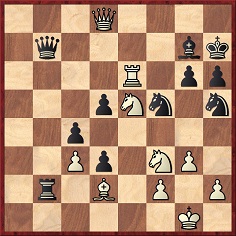
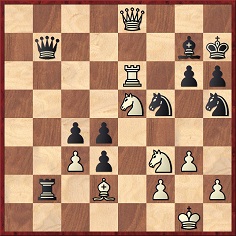
32…Nh4!! (‘Looks like a move of desperation, simply postponing the resignation for a move or two, but on closer inspection the hidden merits become apparent. Most of the onlookers thought that I was trying to bring off a “swindle”. Gyles had foreseen the move but like the others had underrated it and now was spending the precious minutes trying to find a knock-out.’) 33 gxh4 Qe4 34 Rxg6 (‘Gyles made this move after some deliberation which left only a few minutes for his next two moves. He was still under the impression that he was in the winning position …’ Koshnitsky then provided analysis to show that White had no more than a draw.) 34…Rxd2
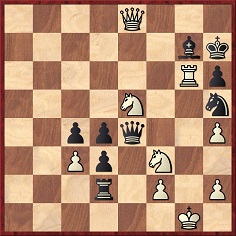
35 Nxd2 and White lost on time. (‘Although I had about ten minutes on my clock I was thinking furiously. Every spectator in the room was watching our game, but no-one noticed that Gyles had not stopped his clock. The director of play was also looking on but even he took no action. The flag fell with a sickening thud!! The director of play immediately awarded the game to me. Gyles very naturally became agitated thinking that he should have been warned that his clock was going. He was under the impression that he was in the winning position at the time. I thought that I had good chances with my queen’s-side pawns and I was sorry that the incident occurred. Apart from the director of play who was very sure of his ground, no-one was absolutely certain whether Gyles had grounds for appeal against the umpire’s decision. Gyles did appeal but withdrew his protest the following morning. I was very pleased that the incident did not alter the probable result, as Black had a forced win after his 35th move. White’s last chance to force a draw was on the 35th move, by a pretty combination found by Purdy, e.g. 35 Rxh6+!! Bxh6 (forced) 36 Ng5+ Bxg5 37 Qxh5+, drawing by perpetual check.’) In the final position Koshinitsky gave detailed analysis to demonstrate a win for Black after 35…Qe1+ 36 Nf1 Qxe5.
(2585)
José Fernández – N. Domínguez Cowan
Mexico City, 1885
Centre Counter Game
1 e4 d5 2 exd5 Qxd5 3 Nc3 Qa5 4 Bc4 e6 5 Nf3 c6 6 O-O Nf6 7 d3 Be7 8 Bd2 Qc7 9 Qe2 b5 10 Bb3 O-O 11 Rae1 Nd5 12 Bxd5 cxd5 13 Nxd5 exd5 14 Qxe7 Qxc2 15 Bb4 Nd7 16 Rc1 Qxb2 17 Ng5 a5 18 Bc3 Qxa2 19 Ne6 Qe2 20 Rfe1 Qxd3 21 Nxf8 Nxf8 22 Bxa5 Be6 23 Bb4 Ng6 24 Qb7 Re8 25 Rc3 Qd2
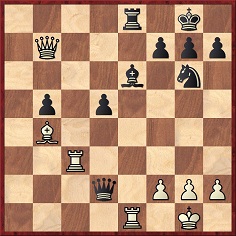
26 Rc8 Qxe1+ 27 Bxe1 Bxc8 28 White resigns.
Source: Brooklyn Chess Chronicle, 15 October 1885, page 13.
(2586)
The chess column of the Cincinnati Commercial of 1 April 1882 stated:
‘Mr John Wisker, formerly chess editor of the London Field [sic], and now one of the strongest players in Australia, is the author of a novel, The Machinations of Detherby Yarke, now publishing serially in the columns of the Federal Australasian, of Melbourne.’
Whether the oeuvre also came out in book form we have been unable to verify.
‘Two well-known chessplayers burst into the literary limelight lately. Nothing to do with chess. V.L. Wahltuch, one of England’s strongest players a decade ago, produced a little booklet, under the auspices of Printing-Craft, on contract bridge; whilst Barnie Winkelman, Pennsylvania expert, wrote a real book on Rockefeller.’
The source of the above quote is CHESS, 14 October 1937, page 45. Winkelman’s book was entitled John D. Rockefeller and was published in Philadelphia in 1937. He had already written Ten Years of Wall Street (Chicago, 1932) and was to produce John G. Johnson (Philadelphia, 1942).
Another chess expert who wrote on bridge was Gerald Abrahams, with Brains in Bridge (1962). He also brought out books on such subjects as law and political thought, as well as publishing three volumes of fiction. A list of his output is given opposite the title page of his 1974 book Not Only Chess.
From CHESS, 20 July 1939 (page 391):
‘E.G. Sergeant has produced a monumental volume on law which will inevitably become a standard work for future generations: Sergeant on Stamp Duties.’
William Fairhurst, a civil engineer, was a specialist in bridges rather than bridge, and in 1945 he wrote the book Arch Design Simplified.
(2591)
From page 20 of the January-February 1943 American Chess Bulletin:
‘Chessplayers, who have a talent for writing, do not necessarily confine themselves to the subject of chess. Browsing through the Post Headquarters Library during the Reshevsky-Kashdan game at Plattsburg, the publisher saw a copy of The Tools of War, of which James R. Newman of the Manhattan Chess Club, is the author.
Later, a column review of John G. Johnson, in the N.Y. Sun, called to mind that Barnie F. Winkelman had been busy for some time in his preparation of the manuscript for the biography of that famous Philadelphia lawyer.
Quite recently we received from Leslie Balogh Bain, publicist and broadcaster of Miami, Fla., an inscribed copy of his new book, War of Confusion. In it this chessplaying husband of a famous chess expert (Mary Bain) reveals a broad grasp of world conditions.
It is fitting to mention also in this connection that William E. Napier, now engaged in a tournament at the Washington Chess Divan, has written much on insurance and, of course, fluently and with erudition.’
Another instance comes from the obituary of T.R. Dawson on pages 107-108 of the April 1952 BCM:
‘Author and co-author of several books on rubber, he served the industry in many other capacities with distinction, and his death removes an outstanding figure in the world of rubber.’
(2601)
C.N. 2543 referred to the premature death notice of Franz Tendering, who in fact died in 1875, at the age of 27. Now we give three light games by this forgotten player:
N.N. – Franz Tendering (blindfold)
Nice, circa 1872
Scotch Game
1 e4 e5 2 Nf3 Nc6 3 d4 exd4 4 Nxd4 Bc5 5 Be3 Nxd4 6 Bxd4 b6 7 Bxg7 Qh4 8 Qf3 Qg5 9 Bxh8 Qc1+ 10 Ke2 Ba6+ 11 Qd3 Qxc2+ 12 Nd2 Bxd3+ 13 Ke1 Bxf2+ 14 Kxf2 Qxd2+ 15 Kg3 Qe3+ 16 White resigns.
Source: Deutsche Schachzeitung, March 1872, page 87.
N.N. – Franz Tendering
Nice, 1872
Giuoco Piano
1 e4 e5 2 Nf3 Nc6 3 Bc4 Bc5 4 d3 d6 5 h3 Nf6 6 O-O O-O 7 Be3 Bb6 8 b4 Be6 9 Bb3 Ne7 10 a4 a6 11 a5 Ba7 12 c4 Ng6 13 Qd2 Nh5 14 Nc3 Nhf4 15 Kh2 Qd7 16 Nd5 Bxh3 17 Nxf4 exf4 18 Bxa7 Bxg2 19 Kxg2 Qg4+ 20 Kh2 Qh5+ 21 Kg2 and ‘Black announced mate in seven moves’ (although White can hold out a little longer: 21…Nh4+ 22 Nxh4 Qg4+ 23 Kh1 Qxh4+ 24 Kg2 Qg4+ 25 Kh2 f3 26 Qg5 etc.).
Source: Deutsche Schachzeitung, May 1873, pages 136-137.
Franz Tendering – Bothe
Occasion?
King’s Pawn Opening
1 e4 e5 2 Nf3 Nc6 3 Nxe5 Nxe5 4 d4 Ng6 5 Bc4 Be7 6 O-O d6 7 f4 f5 8 Nc3 fxe4 9 f5 Nf6 10 fxg6 d5 11 Nxd5 Nxd5 12 Qh5 Nf6
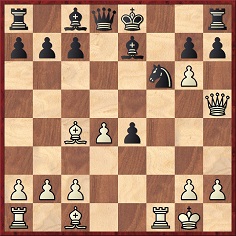
13 Rxf6 Bxf6 14 gxh7+ Kd7 15 Qd5+ Ke7 16 Qf7+ Kd6 17 Bf4+ Kc6 18 d5+ Kc5 19 b4+ Kxc4 20 d6+ Kb5 21 Qd5+ c5 22 a4+ Ka6 23 Qc4+ b5 24 Qxb5 mate.
Source: Deutsche Schachzeitung, November 1875, page 334.
(2621)
Tentative suggestion: the only area of chess literature in which no remotely worthwhile book has ever been published is quotations. The three slim volumes that we have seen (published in the US in 1972, Germany in 1992 and the US in 1998) are, in our view, devoid of value because they provide no sources for the alleged citations.
(2622)
We add to C.N. 1178 (see page 56 of Chess Explorations) a couple of games by the prodigy María Teresa Mora (1907-1980). A very early mention of her, as the first prize-winner in a junior competition, was on page 128 of Capablanca-Magazine, 30 September 1914. A few years later she became Capablanca’s pupil, and in Chapter IX of My Chess Career (1920) he stated that ‘she probably is the strongest lady player in the world, though only 15 or 17 years old’. In fact, astonishingly, she was only 12 when this assessment by Capablanca was published in My Chess Career. [See, however, C.N.s 3464, 3468 and 3477, which discussed the unclear evidence regarding her year of birth.]
María Teresa Mora – Guillermo López Rovirosa
Havana, 1921
Ruy López
1 e4 e5 2 Nf3 Nc6 3 Bb5 a6 4 Ba4 Nf6 5 O-O d6 6 d3 Be7 7 h3 O-O 8 c3 h6 9 Nh2 d5 10 Nd2 Bc5 11 Qf3 Ne7 12 exd5 Nexd5 13 Ne4 Nxe4 14 Qxe4 Qd6 15 Nf3 Nf4 16 Nxe5 Ne6 17 d4 Ba7 18 Be3 f5 19 Qd3 f4 20 Bc2 Ng5 21 Bb3+ Be6 22 Bxe6+ Qxe6 23 Bd2 c5 24 Ng6 c4 25 Nxf8 Rxf8 26 Qc2 Nxh3+ 27 gxh3 f3 28 Rae1 Qxh3 29 Qg6 Bb8 30 Qe6+ Qxe6 31 Rxe6 Kh7 32 Rfe1 Rf5 33 R1e4 Rh5 34 Bf4 Resigns.
Source: American Chess Bulletin, December 1921, page 205.
Guillermo López Rovirosa – María Teresa Mora
Havana, 1921
Four Knights’ Game
1 e4 e5 2 Nf3 Nf6 3 Nc3 Nc6 4 Bc4 Bb4 5 O-O O-O 6 d3 Bxc3 7 bxc3 d6 8 Bg5 h6 9 Bh4 Bg4 10 Qd2 Bxf3 11 gxf3 g5
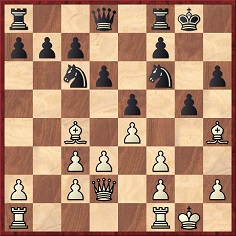
12 Kh1 Kh7 13 Bg3 Qd7 14 Rg1 Ne7 15 d4 Ng6 16 Rad1 Rad8 17 Qe3 Qc6 18 Qe2 a6 19 dxe5 dxe5 20 Rxd8 Rxd8 21 Bxf7 Qxc3 22 Bxg6+ Kxg6 23 Rd1 Rd6 24 h4 b5 25 Kg2 Qc5 26 hxg5 hxg5 27 Rxd6 cxd6 28 Qd3 Qc6 29 Qb3 Qc4 30 Qa3 Qc6 31 Qa5 g4 32 Qe1 gxf3+ 33 Kxf3 Qxc2 34 Qe3 Qxa2 35 Bh4 Qe6 36 Bxf6 Qh3+ 37 White resigns.
Source: American Chess Bulletin, January 1922, page 7.
(2629)
‘Young American shows genius for chess’ was the heading of a full-page article on page 245 of CHESS, 26 May 1956, but the prodigy was not Fischer. ‘Philadelphia has a young player of 16 who is showing every sign of developing into a world champion: Charles Kalme.’
The previous year Kalme had received high praise from Euwe after defeating him in a six-board simultaneous exhibition with clocks. The Dutchman annotated the game on page 73 of Chess Review, March 1955, and few leading players have been so generous in describing the play of a young victor.
Max Euwe – Charles Kalme
Philadelphia, 1955
Grünfeld Defence
1 d4 Nf6 2 c4 g6 3 g3 Bg7 4 Bg2 d5 5 cxd5 Nxd5 6 e4 Nb6 7 Ne2 O-O 8 O-O c6 9 Nbc3 N8d7 10 b3 e5 11 Ba3 Re8 12 d5 Nf8 13 dxc6 bxc6 14 Qc2 Be6 15 Rfd1 Qc8 16 Nc1 Bh3 17 Nd3 h5 18 Bd6 Nh7 19 f3 h4 20 Nf2 Bxg2 21 Kxg2 Ng5 22 gxh4 Ne6 23 Ne2 Nd7 24 Ng4 Nf6 25 Rac1 Nxg4 26 fxg4 Nd4 27 Nxd4 Qxg4+ 28 Kh1 exd4 29 Re1
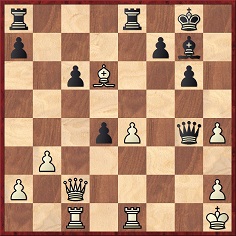
29…Rad8 30 e5 Qxh4 31 Qxc6 Bh6 32 Rcd1 Bf4 33 Re2 Qh5 34 Rde1 d3 35 Rg2 d2 36 White resigns.
Euwe concluded:
‘A baffling finish. With Black’s last six moves, he has hit the nail right on the head every time.
One indeed asks oneself: how will this young man be playing five years hence? Woe is Moscow!’
Source: Chess Review, March 1955, page 73.
Although Kalme subsequently withdrew from chess play in favour of mathematics, he became a prominent figure in the mid-1970s debate on Fischer’s conditions for defending his world title. The following biographical information was given at the time, in Chess Life & Review (November 1975, page 729):
‘Dr Kalme, 35, has a Ph.D. in Mathematics, and has taught that subject at the University of California and the University of Southern California. This year he becomes Associate Editor of Mathematical Reviews.
He earned his master title in chess at 15 and was US Junior Champion in 1955. His rating at age 20 was 2455, where it has remained since his retirement as an active player more than ten years ago.’
About two decades later he returned to the board, and John Donaldson’s report on the World Open tournament in Philadelphia (Inside Chess, 8 August 1994, page 5) commented: ‘One of the more amazing comeback stories in US chess today has to be that of Charles Kalme.’ However, since our theme here is his skill as a youngster, the concluding two games mark a return to the 1950s.
Charles Kalme – Larry Remlinger
Lincoln (US Junior Championship), 1955
Nimzo-Indian Defence
1 d4 Nf6 2 c4 e6 3 Nc3 Bb4 4 Qc2 Nc6 5 Nf3 d5 6 Bg5 dxc4 7 e3 Qd5 8 Bxf6 gxf6 9 Nd2 Qg5 10 Nxc4 Bd7 11 O-O-O Bxc3 12 Qxc3 O-O-O 13 Kb1 Kb8 14 e4 Qg6 15 f3 Bc8 16 Ne3 f5 17 exf5 exf5 18 d5 Ne7 19 f4 Rhe8 20 Bb5 Bd7 21 Bxd7 Rxd7 22 g3 Red8 23 Rd2 a6 24 Rhd1 h5 25 Qc5 Qd6 26 Qa5 h4 27 Nc4 Qf6 28 Ne5 Rd6 29 Rd3 Rb6

30 d6 Rdxd6 31 Rxd6 Rxd6 32 Nd7+ Rxd7 33 Rxd7 b6 34 Qe5 Resigns.
Sources: Chess Review, September 1955, pages 282-283 and CHESS, 26 May 1956, page 245.
James Cross – Charles Kalme
West Orange (Log Cabin Invitation Tournament), August 1959
King’s Indian Defence
1 c4 Nf6 2 d4 g6 3 Nc3 Bg7 4 Nf3 O-O 5 Bg5 h6 6 Bh4 c5 7 e3 d6 8 Be2 Bf5 9 O-O Nc6 10 d5 Nb4 11 a3 Na6 12 Nd2 g5 13 Bg3 Nc7 14 e4 Bg6 15 f4 gxf4 16 Bxf4 e6 17 dxe6 Nxe6 18 Bg3 Re8 19 Bh4 Ng5 20 Bd3 Qb6 21 Qc2 Ng4 22 Rae1
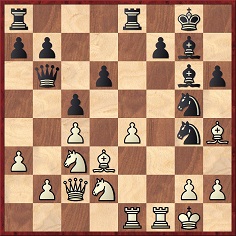
22…d5 23 Nxd5 Qd6 24 Bg3 Be5 25 Bxe5 Rxe5 26 g3 Nh3+ 27 Kg2 Rh5 28 Nf3 Ng5 29 h4 Nxf3 30 Rxf3
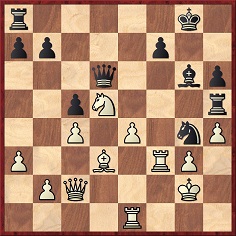
30…Rxh4 31 e5 Rh2+ 32 Kg1 Nxe5 33 Nf6+ Kh8 34 Rxe5 Rxc2 35 Rd5 Rc1+ 36 Bf1 Qe6 37 Rd2 Qxc4 38 Rh2 Qd4+ 39 Kg2 Rc2+ 40 Kh1 Rxh2+ 41 White resigns.
Source: Chess Review, October 1959, pages 302-303.
(2630)
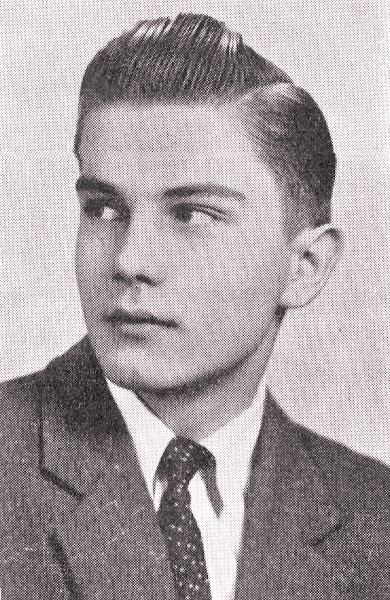
Charles Kalme
(2630)
See too pages 86-87 of Chess Life, 20 March 1961, which had a profile of Kalme in addition to the above win against Cross.
John Hilbert (Kenmore, NY, USA) sends the following text from the Scientific American, 2 July 1859, page 9:
‘Chess-Playing Excitement
The achievements of our young countryman, Paul Morphy, in vanquishing the most distinguished chess-players of Europe, have excited in our people a very pardonable degree of national pride; hence they have exhibited a strong exultant feeling in welcoming him back to his native land as the Chess Champion of the World. He has been received with high demonstrations in several cities, and public testimonials of great value have been presented to him; while at the same time poets have sung, and sages have delivered orations in his praise. At some of these exhibitions there was a considerable display of “Buncombe,” especially at the one held in Boston, where some of our scientific friends rather overdid the thing by their adulations; yet all this might be overlooked if such influences extended no further than the time and place where these effusions were uttered. But we regret to state that this is not the case, for a pernicious excitement to learn and play chess has spread all over the country, and numerous clubs for practicing this game have been formed in cities and villages. Why should we regret this? it may be asked. We answer, chess is a mere amusement of a very inferior character, which robs the mind of valuable time that might be devoted to nobler acquirements, while at the same time it affords no benefit whatever to the body.
Chess has acquired a high reputation as being a means to discipline the mind, because it requires a strong memory and peculiar powers of combination. It is also generally believed that skill in playing it affords evidence of a superior intellect. These opinions, we believe, are exceedingly erroneous. Napoleon the Great, who had a great passion for playing chess, was often beaten by a rough grocer in St Helena. Neither Shakespeare, Milton, Newton, nor any of the great ones of the earth, acquired proficiency in chess-playing. Those who have become the most renowned players seem to have been endowed with a peculiar intuitive faculty for making the right moves, while at the same time they seem to have possessed very ordinary faculties for other purposes. A game of chess does not add a single new fact to the mind; it does not excite a single beautiful thought; nor does it serve a single purpose for polishing and improving the nobler faculties.
Persons engaged in sedentary occupations should never practice this cheerless game; they require out-door exercises for recreation – not this sort of mental gladiatorship. Those who are engaged in mental pursuits should avoid a chessboard as they would an adder’s nest, because chess misdirects and exhausts their intellectual energies. Rather let them dance, sing, play ball, perform gymnastics, roam in the woods or by the seashore, than play chess. It is a game which no man who depends on his trade, business or profession can afford to waste time practicing; it is an amusement – and a very unprofitable one – which the independently wealthy alone can afford time to lose in its pursuit. As there can be no great proficiency in this intricate game without long-continued practice, which demands a great deal of time, no young man who designs to be useful in the world can prosecute it without danger to his best interests. A young gentleman of our acquaintance, who had become a somewhat skillful player, recently pushed the chessboard from him at the end of a game, declaring, “I have wasted too much time upon it already; I cannot afford to do this any longer; this is my last game.” We recommend his resolution to all those who have been foolishly led away by the present chess-excitement, as skill in this game is neither a useful nor graceful accomplishment.’
Our correspondent came upon this item by chance when searching for Paul Morphy documents in the remarkable archives the Cornell University Library.
(2632)
C.N. 2630 (see above) gave a loss by James Cross against Charles Kalme, but Cross too was highly regarded in his youth. ‘No one who plays over this game can doubt that 16-year-old James Cross is one of America’s most talented younger players. The game is played with the freshness of a youngster and the poise of a veteran.’ So commented Chess Review, December 1946, page 32 when introducing this win from the US Junior Championship:
James Cross – Paul Dietz
Chicago, July 1946
Queen’s Gambit Declined
1 d4 d5 2 c4 e6 3 Nc3 Nf6 4 Bg5 Be7 5 Nf3 O-O 6 e3 Ne4 7 Bxe7 Qxe7 8 Nxe4 dxe4 9 Nd2 f5 10 Qc2 Nd7 11 g4 Nf6 12 gxf5 exf5 13 O-O-O c6 14 Be2 Be6 15 Kb1 a5 16 Rdg1 a4 17 Rg3 Rfc8 18 Rhg1 Ne8 19 f3 exf3 20 Nxf3 a3 21 b3 b5 22 c5 Ra7 23 Ne5 Qd8 24 Bd3 Qa5 25 Bxf5 Bxf5 26 Qxf5 Qc3
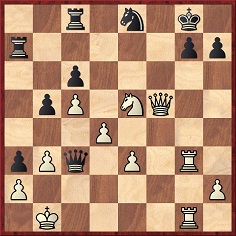
27 Rxg7+ Rxg7 28 Qf7+ Kh8 29 Qf8+ Rg8 30 Qxg8 mate.
In the game below, also from a US Junior Championship, we give as a guide the punctuation of Hans Kmoch, who provided full annotations on page 23 of the September 1948 Chess Review:
James Cross – Paul Poschel
Oak Ridge, 1948
Nimzo-Indian Defence
1 d4 Nf6 2 c4 e6 3 Nc3 Bb4 4 Qb3 Nc6 5 Nf3 a5 6 a3 a4 7 Qc2 Bxc3+ 8 bxc3! d6 9 Bg5 h6 10 Bh4 O-O? 11 e3 e5 12 Be2 Qe7 13 h3 Bd7 14 O-O Na5 15 Nd2 b6 16 Ne4 g5 17 Nxf6+ Qxf6 18 Bg3 Qe6 19 f4! e4 20 f5 Qf6 21 Qxe4 Rae8 22 Qd3 Qe7 23 Rf3 Nb3 24 Re1 Bc6 25 d5 Nc5 26 Qc2 Bb7 27 e4! f6 28 Re3 Qf7? 29 Qd1! Qd7 30 Bh5 Ra8? 31 Bg6 Ba6 32 Qh5 Kg7

33 e5!! dxe5 34 Bxe5! fxe5 35 Rxe5 Kf6 36 Qxh6 Rh8 37 Bh7+ Kf7 38 f6 Resigns.
On page 6 of the September 1947 Chess Review John Rather wrote:
‘Jim Cross of Glendale, California is tall, quiet and unassuming. At 17, he has been playing chess for only two years. Starting with Hoyle’s Games, on which so many have teethed, he learned quickly; soon he topped his school club’s ladder. When he moved to California, he attracted the attention of Herman Steiner, who is always eager to help young players. Under the chess master’s tutelage and by unremitting study of master games, Cross blossomed.’
(2636)
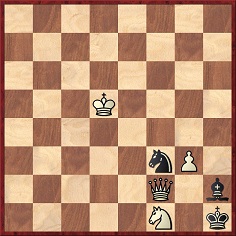
Mate in two
The composition is by P.J. Cumpe (Bohemia, 1908),
Source: Page 106 of Šach by Břetislav Soukup-Bardon (Prague, 1944).
(2638)
Which leading player won a tournament despite being the only participant not to win a single game?
The case we have in mind is Los Angeles, 1968 (Interzonal play-off tournament). The three participants, Reshevsky, Stein and Hort, played four games against each other. Reshevsky drew all eight of his games, whereas Hort and Stein’s encounters featured a win apiece and two draws. Thus all three players finished with four points, but, as page 99 of the April 1968 Chess Review reported, ‘Reshevsky won by virtue of a superior tie-break standing at Sousse’ (the previous year’s Interzonal tournament). The Review also commented regarding Los Angeles, 1968: ‘Here must be an all-time record of an important event won without a single full point by the winner.’
(2648)
On page 94 of Schach (Leipzig, 1936) H. Ranneforth offered the opening of a game (players unidentified; White gave the odds of his queen’s rook). It began 1 e4 e5 2 Nf3 Nc6 3 Bc4 Bc5 4 b4 Bxb4 5 c3 Bc5 6 O-O Nf6 7 d4 exd4 8 cxd4 Bb4 9 e5 Ne4 10 Qe2 Nc3 11 Nxc3 Bxc3 12 Ng5
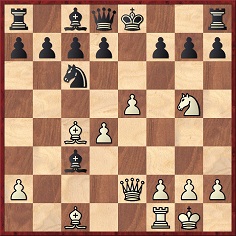
Black’s 12th move was rare, not to say unique: 12…Ba1. Ranneforth related that Black knew the theory of the opening on level terms, i.e. that 12...Bxa1 could be played, and cautiously decided to rely on his memory rather than his judgment.
(2652)
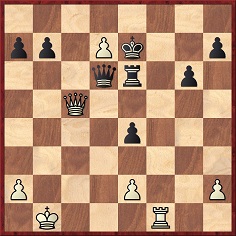
A. Edelheim-Adolf Albin, Berlin, 1899
White played 1 Rf8 and his opponent resigned.
Source: Der Schachfreund, May 1900, page 30.
(2658)
Here is a nomination for the worst move ever played: White blunders away his queen when he could have used it to give mate in one:
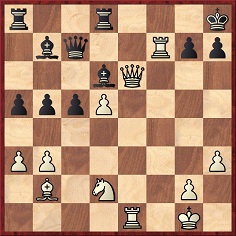
J. Loffroy-E. Anglarès, Marseilles, September 1928
Black tried the desperate 24…Bxd5, and the game continued 25 Bxg7+ Kg8 26 Rf8+ Kxg7
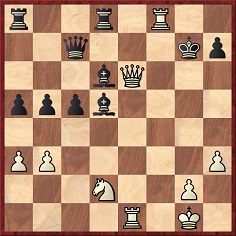
Instead of 27 Qf6 mate White now played 27 Qg8+.
Source: Les Cahiers de l’Echiquier Français, issue 20, page 128.
(2660)
On the penultimate page of unit three of Napier’s Amenities and Background of Chess-Play, the following position won by Napier was given under the heading ‘Epaulette mate’:
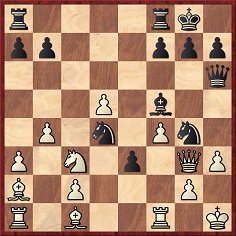
Play went: 1…Rac8 2 Bb2 Rxc3 3 Bxc3 Ne2 4 Qe1 Qxh3+ 5 gxh3 Be4+ 6 Rf3 Bxf3 mate.
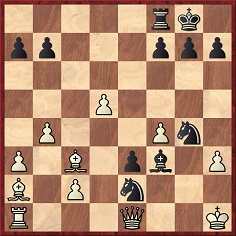
No details of the occasion were provided by Napier, but the full score (‘Amateur v Napier, Pittsburgh, 1900’) was given on page 95 of Napier The Forgotten Chessmaster by John Hilbert.
For an illustration of the more widely-acknowledged form of the ‘epaulette mate’ we turn to a game from page 382 of the 15 December 1890 issue of La Stratégie:
Jackson Whipps Showalter – Logan
Correspondence game
Evans Gambit Accepted
1 e4 e5 2 Nf3 Nc6 3 Bc4 Bc5 4 b4 Bxb4 5 c3 Bc5 6 d4 exd4 7 O-O d6 8 cxd4 Bb6 9 Nc3 Na5 10 Bg5 f6 11 Bxg8 Rxg8 12 Bh4 Bg4 13 e5 dxe5 14 Re1 Bxf3 15 Qxf3 Qxd4 16 Re4 Qd7 17 Rd1 Qf7 18 Qg4 h5 19 Qf5 Nc4 20 Rxc4 Qxc4 21 Nd5 Qc5 22 Qe6+ Kf8 23 Bxf6 Re8

White announced mate in seven moves: 24 Ne7 Qxf2+ 25 Kh1 Qxf6 26 Ng6+ Qxg6 27 Rf1+ Bf2 28 Rxf2+ Qf6 29 Rxf6+ gxf6 30 Qxf6.
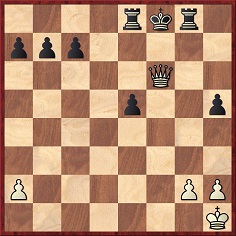
(2694)
See also Jackson Whipps Showalter.
A problem by ‘E.A.M.M. of India’ was given on page 383 of the 1853 Chess Player’s Chronicle, being described as a ‘quaint but masterly stratagem’:

Mate in six
Solution: 1 h4 hxg4 2 Nf1 Qxb8 3 Rc4 b5 4 Bxf3+ bxc4+ 5 Bb7+ gxf2 6 g3 mate.
(2701)
An unfortunate characteristic of chess books published in India is their inability to put many words, names and dates side-by-side without error. Here is the first paragraph of the Preface to One Hundred Chess Endings by Niharendu Sikdar (New Delhi, 1997):
‘The author of this Collection of Chess Studies, Shri Niharendu Sikdar is himself a composer of some standing in the field, as his Studies here will testify. The Collection is the first of its king brought out by an Indian.’
An example of the care, or lack thereof, expended on presenting the ‘kings-and-pawns-only positions’ comes on page 43, where the study is headed:
A.O. Herbstman
‘L’Eshike’
1928
The composer’s name is nearly right (Herbstmann), but ‘L’Eshike’ is not immediately recognizable as L’Echiquier. The date ‘1928’ is also wrong, since the study was first published on page 896 of the July 1930 issue of the Belgian magazine.
The reader will have less difficulty than the author in correcting ‘Pontsiani’ to Ponziani (page 85) or ‘Lecock to Locock’ (page 121) and, even, ‘K. Reihelm’ to G. Reichhelm (page 129) or Chekkarini to Ceccarini (page 142 – for some reason the Study Database 2000 has ‘Seccarini’). It may, though, be less obvious that on page 119 ‘D. Bart’ should be J.Burt. The author is a dab hand at mangling not only the composers’ names but also the sources of compositions. Thus on page 127 there is a ‘Blackburn’ study from a ‘K. Tattersoll’ book, and page 141 offers an ‘L. Kizeritsky’ co-production from a 1944 [sic] book whose title includes the word ‘ahedres’ (which is evidently the Indian-English spelling, via a Russian transliteration, of the Spanish word for chess, ajedrez). On another occasion (page 74) the entire caption information on a miniature amounts to a three-letter diminutive: ‘Ted’. (This is the well-known composition, king and two pawns on each side, by F.M. Teed which was published, with the board and colours in reverse, on page 283 of the September 1885 International Chess Magazine.)
Even so, it is in Hungarian chess books that historical facts and the English language are nowadays taking a particular drubbing. An example is Chess World Champions’ Wonderful Ways To Win by László Krizsány (Budapest, 2000), whose first paragraph (page 8) reports that Adolf Anderssen was born in 1918, while page 79 announces that Alekhine died in 1846. The success in getting Steinitz’s death-date correct (page 28) is rather diminished by the accompanying observation: ‘He never had forebear and it is to be hoped that he has have successors until end of the world.’ The entire book is like that, and the sole pleasurable aspect of our copy is that it bears an inscription by Vladislav Tkachiev.
Then there is Ernő Dede’s book Wonder on the Board (undated, but published a year or two ago by Caissa Chess Books, Kecskemét), the Foreword to which starts thus:
‘What does the chess means to the world? What does it means to us, chessplayers? I believe, that a very important part of the world!
The chess teaches many thing.
It shows how to play, fight, win but how to lose. It teaches stand the failure but even the triumph.
It shows how to think quickly and logical, make decisions and accomplish them. It teaches to respect and to get the knowledge.
The chess gives a lot of things.
Pleasure, happiness, success, victories, friends, journeys, experiences and ceratinly fiascos, defeats, what after you have to stand up from the floor …
The chess is the Life, and the Life is the Wonder! And the wonders of Life are lying here on this pages, you just have to taste them!’
The real Wonder is how such tasteless babble, untouched by human brain, came to be sold for £10.99.
(2702)
From John Roycroft:
‘I’m a positive protagonist of the spelling “Herbstman” as given by Sikdar. Spellings such as “L’Eshike” are explained, and largely excused, by faulty transliteration from, especially, Russian Cyrillic, in conjunction with lack of familiarity with other languages and sources. It is unreasonable to castigate lack of (your and my!?) Euro-centric relative linguistic and contextual omniscience in a talented but isolated enthusiast who goes into print under his own steam (brave of him!) with next to no research resources and, probably, very little in his pocket. Sikdar deserves more praise than blame. I shudder to think of the mess I would make of a Hindi or Urdu or Gujerati source.’
(2721)
A footnote on page 333 of A Chess Omnibus:
In C.N. 2721 John Roycroft described himself as ‘a positive protagonist of the spelling “Herbstman”’. Having now found both spellings in a variety of sources, we withdraw our criticism of ‘Herbstman’.
Having (re-)read the little-known magazine the Chess Weekly (edited by W.E. Napier, Magnus Smith and Charles Nugent), we offer here a sequence of gleanings.
The first is an excellent puzzle for solving and comes from page 29 of the 27 June 1908 issue of the Weekly, under the heading ‘Bystanders Vindicated’:
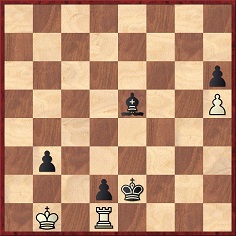
Black to play and win
‘This remarkable position arose in a game played last week at the Rice Chess Club of New York. The experts looking on there and then found a very subtle way for Black to win, but another equally tricky win has since been found by Mr Nugent.’
The solution given on page 72 of the Chess Weekly, 1 August 1908 is as follows:
‘1…Bh2 (a) 2 Rxd2+ Kxd2 3 Kb2 Ke3 4 Kxb3 Kf4 5 Kc2 Kg5 6 Kd2 Kxh5 7 Ke2 Kg4 8 Kf2 Kh3 Black wins.
(a) The win may be forced by 1…Ba1 followed by …Bd4, …Ba7 and then as above.’
The bishop moves to h2 and a1 are most elegant.
(2713 & 2735)
Below is a position (‘The “Swindle” Triumphant’) from page 44 of the Chess Weekly, 11 July 1908. ‘This pretty stratagem occurred last week in a game at the Brooklyn C.C.’ between Charles Curt (White) and Magnús Smith:
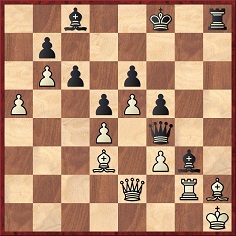
Black to play
The game went: 1…Kg7 2 Bc2 Kg6 3 Bd1 Kg5 4 Rxg3+ Qxg3 5 f4+ Kg6 6 Qh5+ Rxh5 7 Bxh5+ Kxh5 8 Bxg3 Kg4 9 Kg2
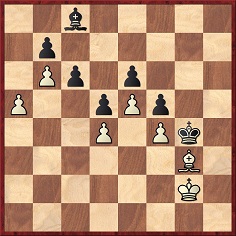
9…c5 (‘This loses at once. The ending, however, seems to be lost, play as Black may. For example, 9…Kh5 10 Kh3 Kg6 11 Be1 Kf7 12 Bb4 Kg6 13 Kh4 Kh6 14 Be7 Kg6 15 Bg5 Kh7 16 Kh5 Kg7 17 Be7 Kh7 18 Bf6 Kg8 19 Kg6 Kf8 20 Bh4 Ke8 21 Kf6 Kd7 22 Kf7 c5 23 dxc5 Kc6 24 Ke8 Bd7+ 25 Kd8, etc., which deserves a place in the books of end-play.’) 10 dxc5 d4 11 a6 and wins.
(2714)
From page 179 of the 7 November 1908 Chess Weekly:
‘In the Manhattan Chess Club there is a picture of an old man apparently trying to solve a chess problem. The position on his board is:
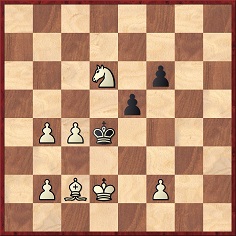
There is a mate in six here by 1 Be4 f5 2 b3 f4 (if 2…fxe4 3 knight mates) 3 c5 f3 4 Bc6 e4 5 Nf7 e3 6 fxe3 mate. Can anyone find a shorter mate? Incidentally, this is one of a very few chess pictures in which there is a sane position on the pictured board. Usually there are two white kings or a king is two or three times in check.’
The Weekly missed the point of the composition, which is a mate in four (1 Be4 f5 2 Ke1, etc.). We invite further details about it and the picture.
(2716)
‘A newspaper recently stated that the moving picture machine man had met with a failure. He tried to photograph two men playing chess.’
Source: the Chess Weekly, 26 December 1908, page 37.
The Weekly was lax in quoting precise sources, and we have no further information on the where and when of the above jape.
On page 41 of its 11 July 1908 issue the Weekly stipulated only ‘New York Times’ (without a date) when quoting the following lamentable news item:
‘After living nearly three months with four ounces of his brain removed, Joseph Ritz died yesterday. Ritz, after the operation, learned to play chess, a game he was never able to master before he shot himself.’
We shall be returning to the Weekly shortly for some rather more substantial fare. Although a valuable little magazine, it was short-lived (in contrast to the American Chess Bulletin, founded in 1904, which ran until the early 1930s and limped until 1963).
(2726)
Eduardo Bauzá Mercére has provided the following regarding the Joseph Ritz:
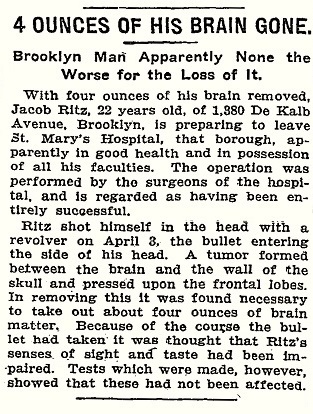
New York Times, 15 May 1908, page 1
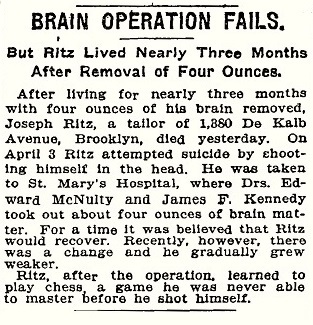
New York Times, 30 June 1908, page 1

Brooklyn Daily Eagle, 30 June 1908, page 8
Few masters have had their birth announced in a chess magazine, but here is a case that comes to mind:
‘Mr Heidenfeld, now living in Dublin, has just been presented by his wife with a son, Mark. World champion, 1998?’
Source: CHESS, 13 June 1968, page 292.
Wolfgang Heidenfeld was a fine, incisive chess writer, and below is an excerpt from a letter he wrote us from Dublin on 22 March 1978:
‘Not only am I at present collaborating with Tim Harding on an opening book for the Batsford series (my first ever, since I hate books on the openings!), but after that I may have, literarily speaking, the chance of a lifetime: the possibility of bringing out a greatly improved and enlarged version and translation of Grosse Remispartien (under the far more attractive title “Battle in the Balance”). This I have always regarded as my magnum opus – spoilt to a large extent by the skimpiness of the publishers (it is the ONLY book I have ever seen in which even the dedication is squeezed onto the first page of text!!). The matter is not 100% yet – but if it comes off, every other chess project is automatically out. The new version would require at least six months’ concentrated work.’
The English edition of Grosse Remispartien was eventually published, under the title Draw!, in 1982, the year after Wolfgang Heidenfeld’s death. Edited by John Nunn, it was of outstanding quality.
(2733)
When the above item was reproduced on page 203 of A Chess Omnibus we added this footnote:
The book on draws was a long-term project of Heidenfeld’s. On page 154 of CHESS, 11 February 1956 he wrote: ‘I am at present working on the MS of a book, “Battle in the balance”, a collection of the finest draws of modern chess, from Hamppe-Meitner, 1872 to Schmid-Castaldi, Venice 1953.’
From page 26 of the Chess Weekly, 19 June 1909:
‘Dr Lasker, in the New York Evening Post, makes the first Nugent-Black game the subject of comparison as between the old school and the modern, mildly condemning White’s old school method in playing for a trap that involves some risk.
Unquestionably the champion is again right from the purely theoretical standpoint. On the other hand, it seems to us that the advocates of the modern school too often ignore the fact that under stress of the varying exigencies of actual play, not the least of which is the time-limit, originality and subtlety of combination may count for more over the board than straining for theoretical precision, the value of which is perhaps paramount only in the post mortem.
When a game is laid on the table and the coroner’s inquest held, it is sometimes an easy matter for the jury to decide by just what sudden stroke the untimely end was brought about; and the chess lawyers are ever ready to point out that the blow might have been averted by certain more or less simple measures of precaution. But the autopsy may reveal a complication of diseases that would have proved fatal in a short time at best, and show that the sufferings of the victim must have left him slight chance to formulate the means of deferring the obsequies. Then there are as many instances where the consigned victim has most unreasonably recovered in the face of an adverse diagnosis. In a position that is declared hopeless by the doctors, the patient by some heroic measure not only saves himself from conquest but achieves what, in the circumstances, should be considered a remarkably creditable victory. There is often a resource open to the enterprising that will never be known to the fated plodder in the beaten path.’
Mention of the Nugent v Black game provides an opportunity not only to give the moves but also to highlight an oddity in the annals of match play. From page 180 of the August 1909 American Chess Bulletin:
‘The chess match of five games up between Roy T. Black, champion of the Brooklyn Chess Club, and Charles Nugent is at an end and goes on record as one of the most unusual events of its kind ever held. Only one game was played, which was won by Nugent in rather brilliant fashion, yet Black emerged winner by a score of five points to one. After the first sitting, which gave promise of a highly interesting struggle, Nugent forfeited point after point through non-appearance. Owing to other engagements, the latter was unable to live up to the schedule of dates named in the conditions to which he subscribed. We understand that the stakes, amounting to $100 a side, were duly paid over to Mr Black.’
The sole game of the match was published on the same page of the Bulletin and on pages 28-29 of the 19 June 1909 issue of the magazine that Nugent co-edited, the Chess Weekly:
Charles Nugent – Roy T. Black
First match game, New York, 9 June 1909
Bird’s Opening
(Notes by the Chess Weekly)
1 f4 d5 2 Nf3 c5 3 b3 Nc6 4 Bb2 e6 5 e3 Nf6 6 a3 Be7 7 Nc3 O-O 8 Bd3 a6 9 O-O b5 10 a4 b4 11 Ne2 Ne4 12 Ng3 f5 13 Ne5 Nxe5 14 Bxe5 Bf6 15 Bxf6 Rxf6 16 Bxe4 fxe4 17 d3 exd3 18 Qxd3 a5 19 Rfd1 Ba6 20 Qd2 Rh6

21 c4 (‘White is waiting to spring a trap when Black plays the plausible …Qh4. Unfortunately, however, he makes the wrong waiting move, although his opponent fails to take advantage of the error. 21 Rac1 served every purpose and would have given White the better game.’) 21…Qh4 (‘Black falls into the trap. Of course, he should have played 21…bxc3 22 Qxc3 Qh4 23 Kf2 d4, etc., with the superior game.’) 22 Nf5 Qxh2+ 23 Kf2 Rg6 (‘An oversight. 23…Rf8 giving up the exchange might have been tried.’) 24 Ne7+ Resigns. (‘Because Black cannot spare time to take the knight, as his queen is also threatened by Rh1.’)
(2734)
When the British Chess Federation was founded in 1904 its first President was Frank Gustavus Naumann, and page 396 of the October 1904 BCM gave some background information on him:
‘He has taken a keen interest in chess for about 30 years, having first learned the game from a pupil of a celebrated Hungarian master. It was not until 1888, however, that he began to take a hand in the constructional work of chess. Since that time he has lived in London, where he founded in 1888 a chess club which afterwards grew to considerable importance. With regard to the 15 years from 1888 to 1903, it is correct to say that during that period there was not in the South of England a chess event of any general interest which was not materially helped forward by Mr Naumann.’
His munificence was not limited to British events. For example, page 28 of the June 1904 American Chess Bulletin listed his name among the patrons of that year’s Cambridge Springs tournament.
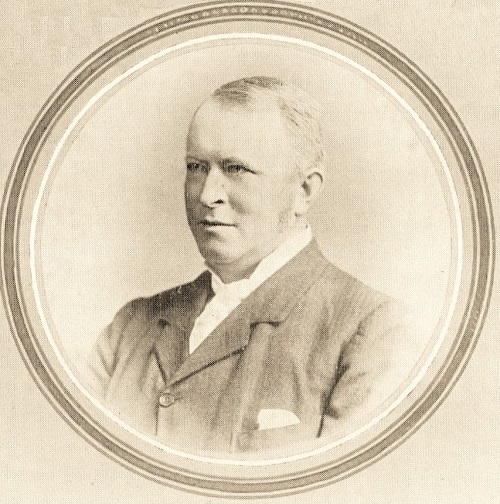
The BCM obituary (June 1915, pages 210-211) included the recollection by Burn in The Field that in the 1880s and 1890s Naumann had been ‘a frequent visitor at the historic London chess resort, Simpson’s Divan, in the Strand, one of his favourite opponents being the late Mr H.E. Bird’. In 1915 Naumann was in the United States and visited the New York tournament (held in April and May and won by Capablanca ahead of Marshall). Within days he was to perish at sea. From pages 90-91 of the May-June 1915 American Chess Bulletin:
‘The tournament just ended yielded no end of entertainment for the lovers of good chess in and around New York City, including a fair sprinkling of visitors. Among the latter was F.G. Naumann, who, it is most sad to record, was one of the passengers on the ill-fated steamship Lusitania, which sailed from New York on 1 May and was torpedoed by a German submarine in St George’s Channel on 7 May, and was reported among those who went down with the ship.’
An eerie poetry point arises from what had appeared on page 397 of the October 1904 BCM, in a discussion of Naumann’s playing style:
‘Mr Naumann is a living refutation of the theory that in a busy life there is no time for chess. There are few men who can get through more business in a day, and still fewer who can play more games of chess in an hour, than he can.’
Then came this:
‘His natural predilection is for the forward game. In fact the following lines of Chapman’s very well express his theory in this regard:
“Give me a spirit that on this life’s rough sea
Loves t’have his sail filled with a lusty wind,
Even till his sailyards tremble, his masts crack,
And his rapt ship run on her side so low
That she drinks water, and her keel plows air.”’
(2760)

See too this Lusitania page about Naumann, which states that he died at the age of 61.

A photograph caption on page 160 of Historia del ajedrez by Gabriel Mario Gómez identifies Botvinnik as Alekhine.
On the next page is a portrait of ‘Erik Elis Kases’. Numerous other names are deformed, a double example being the caption ‘Alhekine-Bogojukov’ on page 133. On successive pages thereafter, the text relates that a) there were only ten games in the 1921 world title match, b) Fine was a participant in the 1948 world championship event, half of which took place in Havana, and c) Fischer was born in New York.
For the record, Historia del ajedrez (182 pages) was published by Planeta, Buenos Aires in 1998. The ability to read Spanish is a disadvantage.
(2765)
Regarding the above-mentioned misidentification of Botvinnik as Alekhine, see C.N. 8969.
Page 139 of The Personality of Chess by I.A. Horowitz and P.L. Rothenberg (New York, 1963) described Fischer as ‘a native of New York City’.
During a literary wrangle with William Lewis, George Walker wrote as follows in a lengthy Letter to the Editor published in Bell’s Life in February 1844:
‘He appears, indeed, I fancy originally to have considered chess writing as a “snug little farm” within a ring fence, exclusively his own property, and not to be invaded by foot of other man. Such delusion is not uncommon. Have my books intrenched on this would-be monopoly? Is this the real offence?
When I printed my Chess Treatise in 1832, at three shillings, and in 1833 at five, the sole competing work being Mr Lewis’s at two pounds, I considered I had opened up new ground, and could in no respect interfere with Mr L.; yet he speedily started in opposition with a five-shilling book, called Chess for Beginners. Not liking to be cut out in my own road, I put on Chess made Easy, in 1837, at three and sixpence, when Mr L. directly answered with an abridged edition of Chess for Beginners, at half-a-crown, under the title of Chess-Board Companion. Here I gave in, for it was clear that if I carried on the war with “Chess for the Masses”, at a single shilling, my competitor would rejoin with a sixpenny “Chess for the Million”. Mr Lewis has just published a first book again, called Lessons, at seven shillings, and the Treatise at 18; in fact, he continues printing the same matter over and over again, in different sizes to suit all customers. I cheerfully admit his books have one advantage over mine, they are larger.’
Walker reproduced the full text of the letter in the fourth (1846) edition of his Treatise (pages 377-380), where he noted that Lewis had not responded.
(2777)
Josep Alió Borràs (Tarragona, Spain) has generously sent us a copy of his book Els Escacs a Tarragona, published in 1999 (in Catalan – 450 pages and 133 photographs). It is one of the most handsome volumes on local chess history that we have seen.
Mr Alió informs us:
‘On page 113 of Jeremy Gaige’s Chess Personalia A Biobibliography there is a mistake in the entry on José Salvio Fàbregas i Domingo. He was born in Tarragona on 4 December 1838 (and not on 25 May 1837 in Oviedo). My book has a six-page biography of Fàbregas and explains the relationship between him and two other chess figures born in Tarragona, Joan Carbó i Batlle (1837-1902) and Josep Pin i Soler (1842-1927). Mr Gaige does not mention the latter, who wrote the first “modern” book in Catalan: Problemes d’Escachs d’autors catalans (Barcelona, 1899).’
From an illustration on page 63 of our correspondent’s work we take a problem by J. Fàbregas which appeared in Pin i Soler’s collection:
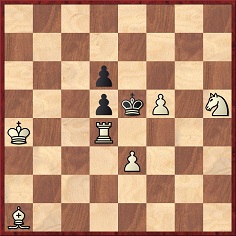
Mate in four
(2780)
From a game between Raouf Gadjily and Mel O’Cinneide, European Team Championship, Pula, 1997:

In the exchange sequence 24 d5 cxd5 25 cxd5 Black eschewed the natural line 25…Rxd5 26 Rxd5 exd5 27 Rxd5 Rc8 and blundered with ...
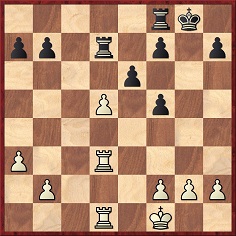
... the in-between move 25…Rfd8 (which led to 26 dxe6 Rxd3 27 Rxd3 Rxd3 28 e7 Resigns).
For a move such as Black’s 25th we offer the term Zwischenfehler.
(2784)
Our collection includes the 32-page programme for the 1945 Pan-American Chess Congress in Hollywood, signed by all 13 participants (including W. Adams, R. Fine, A. Horowitz, I. Kashdan, H. Pilnik, S. Reshevsky, H. Rossetto and H. Steiner). A curiosity is that Isaac Kashdan’s forename appears as ‘Irving’ not only in print but also in his signature:
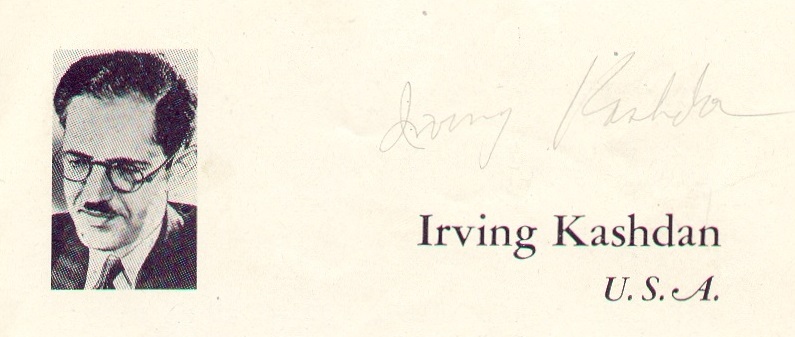
(2794)
The discrepancy remains to be explained, and now we see that on page 154 of Modern Chess Endings by Barnie F. Winkelman (Philadelphia, 1933) a chapter heading also states ‘Irving Kashdan’.
(3350)
We now note on page 14 of the January 1934 American Chess Bulletin a reference to ‘Isaac Irving Kashdan’. The February 1934 issue (page 27) referred to ‘Isaac I. Kashdan’.
(3381)
Can readers quote unusual dedications in chess books? The Chess Games of Adolph Anderssen edited by Sid Packard is dedicated ‘To the Glory of our Lord and Saviour Jesus Christ, And His holy Church’. A rare manoeuvre given on page 242:

Adolf Anderssen v Carl Mayet, Berlin, 1865
30 Nh7 Ne8 31 Nf8 Nf6 32 Nd7 Be6 33 Rxe6 Resigns.
A better chance of salvation would have been 30...Ne4, a suggestion to us from Richard Forster. He gives the following possible play: 31 Bxe4 b3 (If 31...Bxe4 32 Rxe4 Qd5 33 Qf3 Qxa2 34 Nf6+ Kf8 35 Re1 Rc8 36 Qh5 wins.) 32 Nf6+ (The only way. 32 Qe3 Bxe4 33 Qxe4 d5 draws.) 32...gxf6 33 Qh7+ Kf8 34 Re2 Qxa2 (Otherwise White wins easily. For example, 34...bxa2 35 Qh8+ Ke7 36 Bxd5+ Kd7 37 Qh3+, or 34. .Bxe4 35 Qh8+ Ke7 36 Rxe4+.) 35 Qh6+ Ke7 36 Qe3.
(Kingpin, 1997)
Page 237 of Kings, Commoners and Knaves discussed chess books with unusual dedications. Here is another case, from The Twentieth Century Retractor, Chess Fantasies, and Letter Problems by Mrs W.J. Baird (London, 1907):
‘Dedicated to
The Sun
The Glorious Orb which Animates and Beautifies
The Earth
By Giving It
Warmth, Light, and Life.’
(2804)
A case given by us in Kingpin in 1998 was a contribution from Alessandro Nizzola (Mantova, Italy):
‘To my two fathers’ – Bobby Fischer by Frank Brady (1970s edition).
We seek lesser-known instances of masters making unfavourable scores in simultaneous displays. For example, CHESS, 5 February 1955 (page 215) reported that Herman Pilnik had taken on 43 players in Zagreb, scoring +7 –19 =17. ‘Quite a good result, really’, commented CHESS unconvincingly.
(2816)
Following on from Alekhine’s reference in C.N. 2818 to ‘low-grade fighters’ (see Alekhine on Munich, 1941), we can recall few connections between chess and wrestling. The first is the following photo-feature on page 107 of CHESS, 14 November 1935:
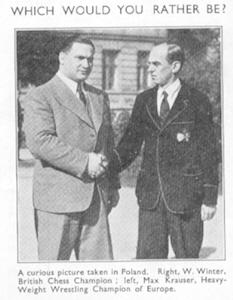
The caption in CHESS read: ‘A curious picture taken in Poland. Right, W. Winter, British Chess Champion; left, Max Krauser, Heavyweight Wrestling Champion of Europe.’
The second case involves the front cover of Chess Review, March 1956:
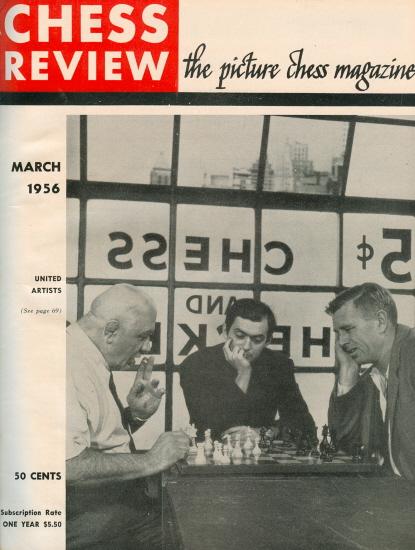
From left to right, the photograph features Kola Kwariani (‘a 250 pound New York wrestler who speaks eight languages and rates as the only chess-playing professional grappler in the country’), Stanley Kubrick and Sterling Hayden. Chess Review (page 69) called their forthcoming film Bed of Fear, but it was eventually released under the title The Killing (1956).
The obituary of F.O. Egger on page 138 of the May 1941 BCM claimed that ‘he was a celebrated athlete, and in his younger days was wrestling champion of Europe’.
(2819)
Just under a century ago [this was written in 2002] John Leng & Co., Ltd. of Dundee and London published, at one penny, an anonymous work entitled The People’s Chess Book. A model of clarity and precision, it crammed an extraordinary amount of material into a mere 40 pages. Although forgotten today, it was still bringing the author plaudits long after publication. For instance, a lengthy feature in the Chess Amateur, March 1922 (pages 188-189) and April 1922 (page 220) observed that The People’s Chess Book ‘undoubtedly represents the finest value in all chess literature for price asked. … Our children’s children will not see the like.’ (True enough. Instead, they would see multi-pound dreadfuls like Instant Chess by D. Levy and K. O’Connell.)
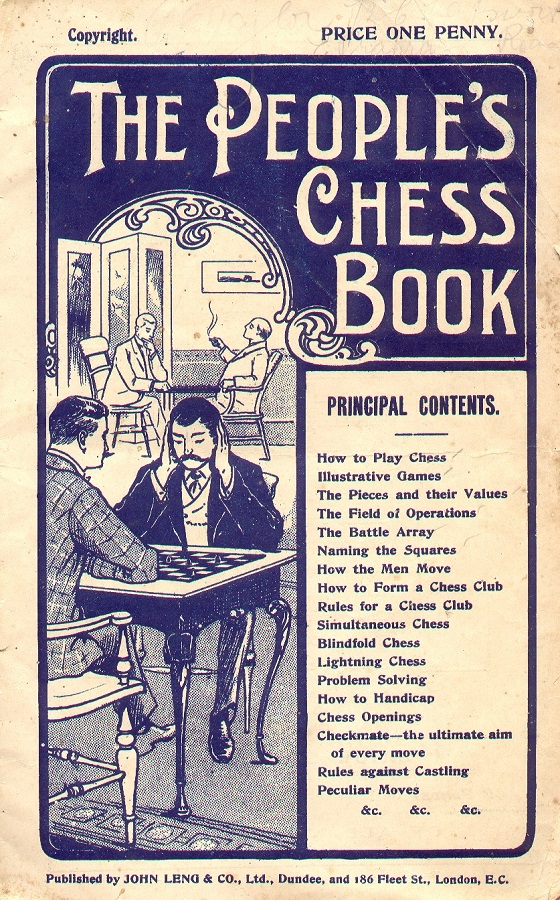
The Chess Amateur went so far as to comment, ‘Not even Capablanca’s new book [Chess Fundamentals] can say more effectively the following admirable and soundly judged considerations of modern position-play (indeed, for our part, we frankly prefer the anonymous pennyworth)’, after which it quoted extensively from the text. Another of the magazine’s comments was that ‘our author’s treatment of the opposition is extremely good for such a book as this, and is indeed more complete and advanced than we have ever seen the subject discussed outside articles devoted exclusively to the matter’.
The anonymous author of The People’s Chess Book is not unknown, although his is hardly a familiar name nowadays: F.W. Markwick (1863-1948). He was the subject of a brief news item on page 151 of the July 1943 CHESS:
‘Congratulations to F.W. Markwick, of Essex, one of the “Grand Old Men” of British Chess, who attained his 80th birthday on 14 May. Among many other achievements in play, problems and chess journalism, he holds the distinction of having written, in the early years of this century, a remarkably good introductory text-book of chess, published at the even more remarkable price of one penny.’
On page 443 of the December 1948 BCM T.R. Dawson described The People’s Chess Book as ‘easily the best cheap guide to chess that has ever been written’ and ‘far more scholarly, more accurate and more instructive than a dozen so-called “guides” in my library at 30 times the price’.
(2829)
E. Wosner – A. Distler
London League, November 1948
Caro-Kann Defence
1 e4 c6 2 d4 d5 3 e5 Bf5 4 Nf3 e6 5 Bd3 Bg6 6 O-O Nd7 7 b3 Rc8 8 Re1 c5 9 Ba3 Nh6 10 Bxg6 hxg6 11 h3 Nf5 12 dxc5 Bxc5 13 Bxc5 Nxc5 14 Nbd2 Qa5 15 a3 Qc3 16 Ra2 Nd7 17 Nf1 Nh4 18 Re3 Nxf3+ 19 Qxf3 Qc7 20 Qe2 Rh5 21 f4 Qb6 22 Kh2 Qd4 23 g3 Ke7 24 Qd2 Qc5 25 Qe2 d4 26 Rd3 Qd5 27 c4 Rxh3+ 28 Kxh3 Rh8+ 29 Kg4 f5+ 30 Kg5
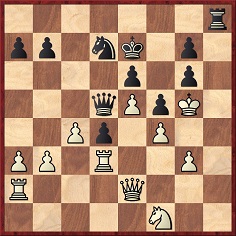
30…Nf8 31 cxd5 Rh6 32 White resigns.
Source: BCM, February 1949, page 66. ‘An excellent game by Distler, with a delightful finish.’ The magazine points out that after 31 Qh2 Qd8 32 Qxh8 Black has a discovered mate by moving the king to either f7 or e8.
(2833)
Early declarations about the practical value of chess are always welcome. On page xii of A New Treatise on Chess (London, 1833) George Walker wrote:
‘Chess will, ere long, assume that well deserved rank among the useful sciences, to which its claim has been always admitted by genius and philosophy. Fathers of families should hail it as a powerful auxiliary in training their children to the pleasures of domestic life, by depriving them of all relish for those frivolous and exceptionable amusements, in which youth too frequently finds a vicious delight.’
At a Manhattan Chess Club dinner on 19 March 1910, Emanuel Lasker gave his views, as reported on page 87 of the April 1910 American Chess Bulletin:
‘The champion in his turn spoke at length and hoped he would see the time when the study of chess might become a part of the school curriculum, not so much for the purpose of making boys and girls strong players as for the sake of initiating them into the strategic principles, which are the outcome of two thousand years [sic] of study, but which have been set forth in orderly array only since the time of Steinitz. The champion referred to chess as a playground on which the intellect may acquire useful habits of lasting benefit.’
(Kingpin, 1994)
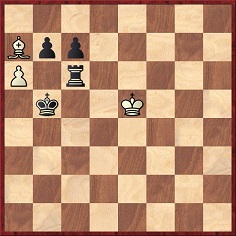
A position (White to move) from a game at the Café Kaiserhof, Berlin, which was passed on by Jacques Mieses. Play went 1 axb7 Re6+ 2 Kxe6 Kc6 Drawn.
Source: Deutsches Wochenschach, 24 January 1897, page 32.
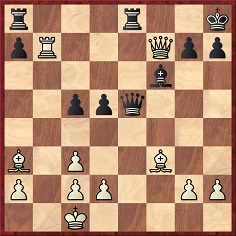
J. Foulds-G. Shories, Bradford Chess Club, Date?
The finish was: 1...Qe1+ 2 Bd1 Qxd2+ 3 Kxd2 Bg5+ 4 Kd3 Re3+ 5 Kd2 Re4+ 6 Kd3 c4 mate.
Source: Deutsches Wochenschach, 10 May 1914, page 168.
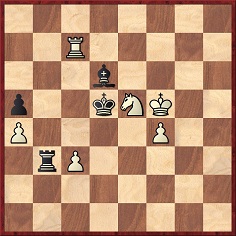
A. Speyer (Speijer)-E. de Haas (Place and date?)
1 Rd7 Kc5 2 Ke6 Rb8 3 Rxd6 (3 Nd3+ would win easily.) 3…Re8+ 4 Kd7 Re7+ 5 Kxe7 Stalemate.
Source: Tijdschrift van den Nederlandschen Schaakbond, November 1924, page 316.
(Kingpin, 1994)
As regards the first position, we gave the following footnote on page 27 of Kings, Commoners and Knaves:
A similar position had already appeared on page 212 of the July 1895 Deutsche Schachzeitung as a study by Troitzky, but with the action in the ‘North East’ part of the board. See also page 26 of A.J. Roycroft’s Test Tube Chess (and the revised edition thereof, The Chess Endgame Study), which placed Troitzky’s study in the ‘South East’. To complete the tour, page 85 of T. Schuster’s Wenn Sie am Zuge wäre ...? put the play in the ‘South West’ sector. We cannot think of any other position which has been published in all four quandrants.
Concerning the second position, on 20 October 2000 Adri Plomp (Hilversum, the Netherlands) informed us that the game was played in the Dutch national championship held in Amsterdam from 24 July to 2 August 1924 (see page 316 of the Dutch magazine which was our source).
The obscure Oliver Gambit (1 e4 e5 2 f4 exf4 3 Nf3 g5 4 h4 g4 5 Ne5 h5 6 Bc4 Nh6 7 d4 d6 8 Nxf7) is named after the New England player Benjamin Lynde Oliver (1788-1843). One of the few published games featuring the line appeared on page 67 of Chess in Philadelphia by Gustavus C. Reichhelm:
Philip Physick Randolph – Charles
Vezin
Philadelphia, 1847
King’s Gambit Accepted
1 e4 e5 2 f4 exf4 3 Nf3 g5 4 h4 g4 5 Ne5 h5 6 Bc4 Nh6 7 d4 d6 8 Nxf7 Nxf7 9 Bxf7+ Kxf7 10 Bxf4 Bh6 11 O-O Kg7 12 Nc3 Be6 13 d5 Bf7 14 Qd4+ Kg8 15 e5 dxe5 16 Bxe5 Rh7 17 Ne4 Bg7 18 Ng5 Bxe5

19 Qe4 Rg7 20 Rxf7 Rxf7 21 Nxf7 Kxf7 22 Qh7+ Ke8 23 Qg8+ Ke7 24 Qe6+ Kf8 27 Rf1+ Kg7 and White mated in three moves.
Brief information about the players was given by the BCM when it published the game on page 236 of the August 1918 issue. It may also be noted that Nxf7 one move earlier has also been called the Oliver Gambit in some sources (e.g., page 105 of The Bristol Chess Club by J. Burt).
(Kingpin, 1994)
A number of books entitled A (or The) Game of Chess have been published, but one of them had nothing to do with the royal pastime: A Game of Chess by Richard Scott (Philosophical Library, New York, 1954). Subtitled ‘A Study in Atheism’, it was described as a book ‘which examines various arguments for the existence of God, and finds them all wanting and not convincing’.

(2836)
Before Beadle’s Dime Chess Instructor goes back on the shelf, here, from page 79, are a couple of apparently unknown gamelets:
Eugene Delmar – N.N.
New York (date?)
(Remove White’s queen’s rook.)
1 e4 e5 2 Nf3 Nc6 3 Bc4 Nf6 4 Ng5 Nxe4 5 Bxf7+ Ke7 6 d3 Nc5 7 Bd5 Qe8 8 Nf7 Rg8 9 Bg5 mate.
Otho E. Michaelis – N.N.
New York (date?)
(Remove White’s queen’s rook.)
1 e4 e5 2 Nf3 Bc5 3 Nxe5 Qe7 4 d4 Bb6 5 b3 d6 6 Ba3 Qd8 7 Nf3 Bg4 8 Bd3 d5 9 O-O Nf6 10 Re1 dxe4 11 Bxe4 Bxf3 12 Bc6 mate.
(2860)
From page 32-33 of Some Problems For My Friends by D.G. McIntyre (Cape Town, 1957) we select this composition of his, which was originally published in the Natal Mercury, August 1918:

Mate in three
The book quotes Alain White’s comment: ‘I have seldom seen a problem with a solution more amusing or less apparently likely to succeed than this.’
(2882)
‘Chess booklet for sale. My once in a lifetime published chess brilliancy by Gerald Castleberry. Get three published games for 49 cents – my game as a free gift along with Anderson’s “Immortal Game” and a Morphy brilliancy. Send SASE and 49 cents to Gerald Castleberry [followed by a postal address in Bell, CA, USA].’
Respondents to this alluring advertisement (Chess Life, October 1983, page 50) received a small-format, eight-page volume by ‘USCF member G. Castleberry’, who also billed himself on the front page as:
‘author of the published statement: “In chess the sacrifice of material for positional advantage is considered brilliant strategy, if it works”.’
In reality, this is little more than a variant of the old Koltanowski quip (see CHESS, 14 January 1936, page 181), ‘If I win, then it was a sacrifice; if I lose, then it was a mistake.’
The first inside page of the Castleberry opus has ‘A Chess Player’s Poem’, 16 lines, two of which are the following deathless, and quite typical, couplet:
‘The tournament players I know I must subdue
And when I fail, it sure will be a dismal view.’
Then comes the once in a lifetime free gift brilliancy:
Gerald Castleberry – C. Fotias
California Open, 1962
Sicilian Defence
1 e4 c5 2 Nf3 d6 3 d4 cxd4 4 Nxd4 Nf6 5 Nc3 a6 6 Bc4 e6 7 O-O Be7 8 Be3 O-O 9 f4 b5 10 Bd3 Bb7 11 e5 dxe5 12 fxe5 Nfd7 13 Rxf7 Rxf7 14 Nxe6 Qc8 15 Qh5 Nf6 16 exf6 Qxe6 17 Qxh7+ Kf8 18 Qh8 mate.
That takes the reader through to the end of page 4, after which Mr Castleberry strives to place his victory in its proper historical context:
‘Some of the world’s other
Great published Chess Games
Have been Adolf Andersen’s
“Immortal Game” …’
The bare score thereof then appears, together with a misdated Morphy win, both courtesy of a Reuben Fine book whose title is twice rendered incorrectly. And with that the oeuvre draws to an upbeat conclusion (page 7):
‘Make your comment on the three published chess games in this booklet. Do you think G. Castleberry’s style is similar to the style of Anderssen [yes, a correct spelling in this instance] and Morphy? …’
Page 8 is blank, apart from the heading ‘Notes’. It is hard to imagine a ‘chess booklet’ of less importance or more self-importance.
(2884)
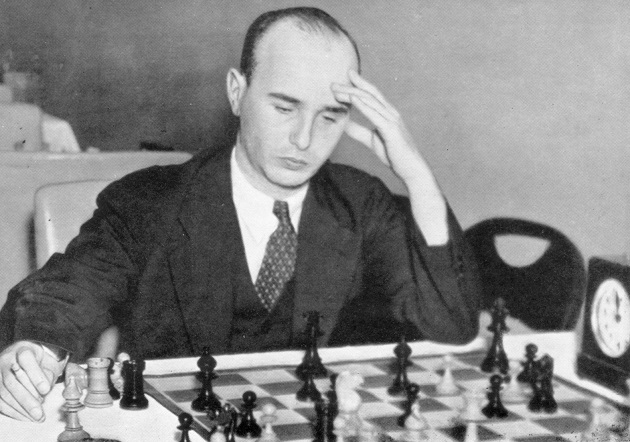
This photograph appeared in Euwe’s book Meet the Masters. On page 33 of the November 1948 CHESS a reader, Stanley Lewin, pointed out that both black bishops are on white squares.
A decade earlier the photograph had appeared in CHESS itself (14 May 1938 issue, page 305), with the caption ‘Samuel Reshevsky. A picture taken during the just concluded New York Tournament, in which he retained his US title’. We have been unable to match the position to any game.
(2903)
Below is an extract from a letter dated 16 May 1859 to George Allen from the Comte de Basterot (the author of the Traité élémentaire du jeu des échecs):
‘… who can deny that le bon public is very lazy – and even amongst chessplayers how very few there are who will really study. My little Traité was written under this impression; I love chess and my ambition was to strip the nymph Caissa of her sable robes, of her garland of poppies and shew her to the French public in the flimsy but more popular dress of a French Milliner …’
Source: ‘George Allen’s “Life of Philidor”’ by R.B. Haselden (an article on pages 107-115 of the Huntington Library Quarterly, October 1939).
(2904)
Calle Erlandsson writes:
‘Looking at the games from the 2003 Capablanca Memorial, Premier I group, I noted that 48-year-old Péter Székely of Hungary seems to have made a new drawing record. He made the long trip to Cuba to play a total of 130 moves (his opponents played 133) in the 13 rounds. Székely made a “perfect” score of +0 –0 =13, with an average of ten moves per round. His smallest number of moves in a game was six, and his toughest (?) game lasted 13 moves. He won fourth prize since he had the highest Sonneborn-Berger score of the four players on 50%.’
This is a substantial ‘improvement’ on the performance of Bilek at Słupsk, 1979, about which a correspondent, Paul Timson, wrote in C.N. 104.
(2937)
A game from pages 309-310 of El Ajedrez Español, June 1935:
1 d4 Nf6 2 c4 e6 3 Nc3 d5 4 Bg5 Nbd7 5 e3 Be7 6 Nf3 c6 7 a3 O-O 8 Qc2 Re8 9 Bd3 dxc4 10 Bxc4 b5 11 Bd3 h6 12 Bf4 a6 13 O-O Bb7 14 Rfd1 Qb6 15 a4 b4 16 a5 b3 17 Qe2 Qa7 18 Bc4 c5 19 Bxb3 cxd4 20 exd4 Rac8 21 Ne5 Ba8 22 Nxf7 Qb7 23 Nxh6+ Kf8
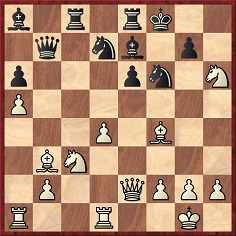
24 Bd5 exd5 25 Qe6 Ne5 26 dxe5 Bb4 27 Qh3 Bxc3 28 bxc3 gxh6 29 Qxh6+ Kg8 30 exf6 Rxc3 31 Qg6+ Resigns.
(2950)
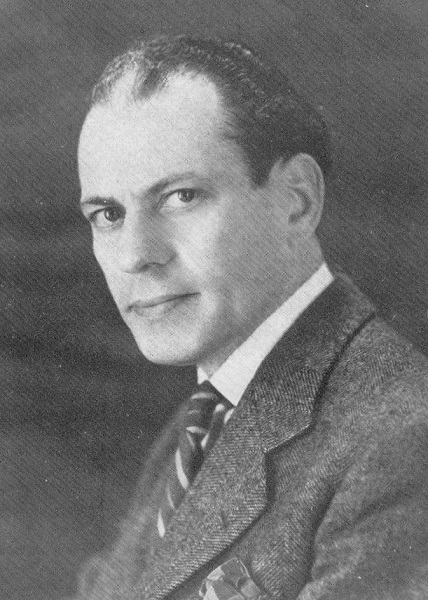
Above is the Frenchman Camil Seneca (1903-77). The year of his death saw the appearance of a coffee-table book Le grand livre des échecs co-authored by him with Adolivio Capece and published by Editions De Vecchi, Paris. In 2001, the same company brought out Le grand livre de l’histoire des échecs. Much of the content was similar (often identical) to the earlier volume, yet authorship was ascribed solely to A. Capece. Why?
(2961)
We note that in 1973, four years before the appearance of Le grand livre des échecs, the same publisher, De Vecchi, brought out Storia degli scacchi; authorship of that original Italian edition was ascribed to Adolivio Capece alone. The above-mentioned (adapted and updated) French version singled out the section on Karpov as having been written by Seneca. Adolivio Capece (Milan, Italy) informs us that he is the sole author of the book. Our collection also contains the 2001 Italian edition, which appeared as Gli scacchi nella storia e nell’arte by A. Capece.
(2975)
In the obituary section of the July 1972 BCM (pages 245-246) it was remarked concerning Professor L.S. Penrose that he ‘was first mentioned anonymously in the BCM in 1919, as the grandson of Lord Peckover, a schoolboy who could play five games simultaneously blindfold’. (We note, however, that page 367 of the November 1919 BCM incorrectly called the anonymous player a nephew of the deceased Lord, that by 1919 Penrose, who was born in 1898, was already at Cambridge University, and that his name had appeared, for instance, on page 129 of the April 1919 BCM.)
An early victory of his was published on pages 275-276 of the July 1919 Chess Amateur, with notes by his Cambridge team-mate William Winter (who described it as ‘a finely played game by Mr Penrose’):
Roland Henry Vaughan Scott (simultaneous) – Lionel Sharples
Penrose
From Gambit
Cambridge, May 1919
1 f4 e5 2 e3 e4 3 b3 d5 4 Bb2 Nf6 5 c4 Nc6 6 Ne2 Nb4 7 Ng3 Bg4 8 Qc1 dxc4 9 Bxc4 Nd3+ 10 Bxd3 Qxd3 11 Na3 Nh5 12 Kf2 Nxg3 13 Kxg3 h5 14 Qxc7 Bd6 15 Qxb7 Bxf4+ 16 Kxf4 g5+ 17 Kxg5 Rg8+ 18 Kf4 Qd6+ 19 Be5 Qh6+ 20 Kxe4 Rd8 21 Qb5+ Bd7 22 Qc5

‘Black announced mate in five moves.’
The intended finish was not specified. It may well have been 22...Bf5+ 23 Kf3 Be4+ 24 Kxe4 Qg6+ 25 Kf3 Qxg2+ 26 Kf4 Qg4 mate, but White has 24 Ke2. A forced mate offered by Fritz is 22...Bc6+ 23 Qd5 Rxd5 24 Kf3 Rxg2 25 Kxg2 Rxd2+ 26 Kf1 Bg2+ 27 Ke1 Qxe3 mate, but that is still one move too long.
L.S. Penrose went on to become a distinguished academic in a number of fields, including human genetics, and was the father of one of the finest British players, Jonathan Penrose.
(2970)
For further information about L.S. Penrose and a photograph, see C.N. 3632.
From page 126 of Modern Chess and Chess Masterpieces by H.E. Bird (London, 1887) comes a remark about 1 e4 e5 2 Nf3 Nc6 3 Bb5 Nd4:
‘I sometimes play this, but not always; it depends upon the state of mind I am in, and whether I want a lively and critical game or a steady contest – one, in fact, in which my adversary considers that I treat him with becoming respect. A well-known and esteemed reverend gentleman once objected that I would not make so silly a move against one of the greatest players.’
(2984)
This problem is taken from page 96 of Modern Chess and Chess Masterpieces by H.E. Bird (London, 1887):

Mate in four
(2985)
Black and White Evergreen by A. Matanović and J. Prokopljević (Belgrade, 2001), well-produced with many colour illustrations of high quality, is another book which has (on page 70) a position headed ‘Parr – Waitkroft, Holland 1968’ (see C.N. 2965). Page 82 offers the conclusion of what is allegedly ‘Deshapel – Laburdone, Paris 1837’.
Why are such books lavishly illustrated but not lavishly checked?
(2988)
The name Důras is sometimes spelt with a krouzek (ringlet or small circle) on the u, though often not (even in Czech sources). At our request Karel Mokrý (Prostějov, Czech Republic) has kindly provided the following information:
‘According to F.J. Prokop on page 111 of Československo ve světovém šachu (Prague, 1935), Důras ceased signing his name with the ringlet around 1914. The main Czech magazine used the ringlet until 1923.’
(2993)
From page 268 of the City of London Chess Magazine, December 1874:
‘The spirited rivalry now going on between the Metropolitan chess clubs is a most encouraging proof of a remarkable development and unexampled progress now being made in the practice and cultivation of the game in London. We feel called upon to say that what is now being done in the cause of chess, often under unfavourable circumstances, and with small means, brings into glaring contrast the apathy and brain-corroding sloth which is now the prevailing characteristic of wealthy and influential circles. Therefore chess has deserted those mansions where once it wore plush, has shaken the dust off its shoes, and the powder off its head, at the doors of those whose condescending patronage it formerly submitted to; has come as a welcome guest, not only to the middle, but to the lower classes, and can produce from the latter many a champion who can squeeze between his fingers like so much pulp the inert brains of the wealthy flâneurs who, pushing wooden dolls about on a wooden board, think they can play at chess. The ancient pastime is not intended as a means whereby persons whose misfortune it is that they are able to be indolent may waste time that is useless to themselves or to anyone else. They do nothing for chess, and chess will have nothing to do with them. Its mission henceforth is to solace and cheer the worker and the thinker.’
The writer (W.N. Potter) gave some further thoughts on class in chess on page 289 of the January 1875 issue.
(2993)
The following game, from pages 68-69 of Akademische Schachblätter, July 1903, has been supplied by Richard Forster (Winterthur, Switzerland):
H. Kuhn (Lübben) – E. Post (Cottbus)
Sagan, 20 April 1903
Evans Gambit Accepted
1 e4 e5 2 Nf3 Nc6 3 Bc4 Bc5 4 b4 Bxb4 5 c3 Bc5 6 O-O d6 7 d4 exd4 8 cxd4 Bb6 9 Bb2 Nge7 10 Ng5 d5 11 exd5 Na5 12 d6 Nxc4 13 Qa4+ Nc6 14 Re1+ Kf8 15 Qxc4 Qxg5 16 Ba3 Be6 17 d5 Ne5 18 Qc3 Bd4 19 d7+ Kg8 20 dxe6 Bxc3 21 e7
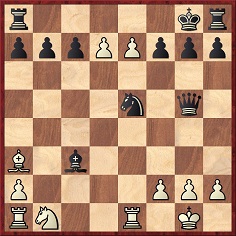
21…Qxe7 22 Bxe7 Bxe1 23 d8(Q)+ Rxd8 24 Bxd8 Ba5 25 Na3 Bb6 26 Nb5 c6 27 Rd1 Bxf2+ 28 Kxf2 cxb5 29 Bb6 Nc6 30 Bxa7 g6 31 Bc5 Kg7 32 Rd7 Rb8 33 Ba3 Ra8 34 Bb2+ Kf8 35 Rxb7 b4 36 Bf6 Rxa2+ 37 Kf1 Ke8 38 h3 Ra8 39 Rc7 Ra6 40 Rb7 Na5 41 Rb8+ Kd7 42 Bb2 b3 43 Bc3 Kc7 44 Rf8 f5 45 Rf7+ Kc6 46 Rxh7 Nc4 47 Rg7 Kd5 48 h4 b2 49 Bxb2 Nxb2 50 h5 gxh5 51 Rg5 Ke4 52 Rxh5 Nd3 53 Rh4+ f4 54 Rh3 Rg6 55 Rh8 Rg3 56 Re8+ Kd4 57 Rf8 Re3 58 Kg1 Re1+ 59 Kh2 Ke3 60 Rh8 Kf2 61 Rh3 Re3 62 Rh4 Rg3 63 Kh1 Kf1 ‘and mate in five moves’.
(3017)
Some remarks by D.J. Morgan on page 43 of the February 1956 BCM:
‘We don’t know the record for consecutive appearances as a competitor in a national championship. R.J. Loman (1861-1932) played, we believe, in 50 successive Dutch championships, from 1881 till 1930. Can this be beaten? Loman became prominent in chess circles here [i.e. in the United Kingdom], and was organist of the Dutch Church in London for 31 years.’
Can any readers corroborate this information about Loman?
(3033)
John Kuipers (Rijswijk, the Netherlands) writes:
‘Loman cannot have participated in 50 consecutive Dutch championships. Before the championships had an official status, i.e. when the Dutch Chess Federation established them from 1909 onwards, they were held 36 times. The first was in 1873 and the last in 1908. Before Loman’s year of death there were seven official championships. All in all 43 tournaments were held. Furthermore, it is not likely that Loman entered the championship already in 1873, when he was 12 years old.
In the unofficial contests Loman became national champion four times (1888, 1891, 1894 and 1897). After the Federation took over, he became champion once more, in 1912, in the ancient city of Delft, where he also lived for a while. The last time he participated was in 1929 in Amsterdam. (Sources: Vijfde Friesche Vlag Schaaktoernooi – Kamioenschap van Nederland 1973 by H. Kramer, pages 15-21, and Nederland schaakt! KNSB 100 jaar, Baarn 1974, pages 139-140.)
On page 169 of Het loopt ongenadiglijk mat, Het Schaakleven in Nederland in de negentiende eeuw [“It leads to mate mercilessly, Chess life in The Netherlands in the nineteenth century”] by H.J.G.M. Scholten (Bilthoven, 1999) it is stated:
“Rud Loman, die regelmatig tussen Londen (waar hij zich kampioen van Nederland noemde) en Amsterdam (waar hij de sterkste amateur van Londen zou zijn) heen en weer reisde, mag waarschijnlijk met het meeste recht als zodanig genoemd worden, maar international speelde hij toch niet ècht mee.” English translation: “Rud Loman, who regularly travelled between London (where he called himself champion of The Netherlands) and Amsterdam (where he would be the strongest amateur from London), probably had the most rights to be considered as such [a semi-professional chess player], but internationally he did not really play a role.”
Scholten gives Loman’s forename as Rud, but that is wrong and should read Rudolf. The writer may have meant to use the abbreviation Rud., forgetting that a full stop is required.’
(3040)
From Christian Sánchez (Rosario, Argentina):
‘The reference in C.N. 3033 and 3040 to records in national championships reminds me of the case of Franz/Francisco Benkö. He participated in his first Argentine championship in 1938, coming 20th. At the age of 92, he took part in the 2002 national championship (finishing 38th). He thus played over a span of 64 years, a likely record.’
(3046)
See too C.N. 3445.
Below is a game which the chess writer and publisher W.H. Watts won despite having a material deficit of one rook and four pawns. Computer analysis indicates a number of errors on both sides, and Watts’ own notes (the Chess Budget, 23 January 1926, pages 114-115) acknowledged that he had been lucky.
William Henry Watts – H.L. Crawford
Sussex v Middlesex match, Brighton, January 1926
Vienna Game
1 e4 e5 2 Nc3 Nc6 3 Bc4 Bc5 4 Qg4 Qf6 5 Nd5 Qxf2+ 6 Kd1 d6 7 Qxg7 Nce7 8 Nh3 Bxh3 9 Rf1 Qxg2 10 Qxf7+ Kd7 11 d4 Bxd4 12 Bh6 c6 13 Nf6+ Nxf6 14 Rxf6 Qg1+ 15 Kd2 Qg2+ 16 Kd3 d5 17 exd5 Bxb2 18 dxc6+ bxc6 19 Be6+ Kd8 20 Rd1 Bxe6 21 Rxe6 Re8
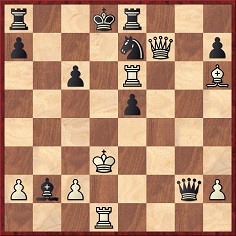
22 Kc4+ Bd4 23 c3 Qd5+ 24 Kd3 Bxc3+ 25 Ke2 Bd4 26 Bf8 Qxa2+ 27 Rd2 Qa6+ 28 Ke1 Qa1+ 29 Rd1 Qc3+ 30 Kf1 Qh3+ 31 Ke2 Qxh2+ 32 Kf1 Kc7 33 Rxe7+ Rxe7 34 Qxe7+ Kc8 35 Qe6+ Kb7 36 Qd7+ Kb6 37 Rb1+ Bb2 38 Bd6 Qh1+ 39 Ke2 Qxb1
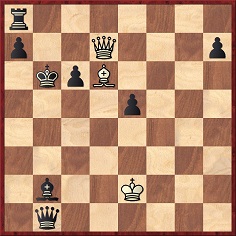
40 Qc7+ Kb5 41 Qb7+ Kc4 42 Qxc6+ Kb3 43 Qd5+ Ka4 44 Qc4+ Ka5 45 Bc7 mate.
‘A game to make one’s match captain’s hair stand on end – and it did’ (Watts).
(3052)
We are seeking the full score of a game discussed by Assiac on pages 7-8 of his book The Delights of Chess, where he gave the following position and commentary (without specifying the identity of Black or the source of the story):

‘Take this position achieved by E. Post when playing White at the Coburg Tournament of 1904. Usually, Post was a very sound and careful player, but here the potency of that open rook-file and those squinting bishops evidently went to his head, and he began to fling his pieces away with utter abandon: 1 Rxh7+ Kxh7 2 Qh1+ Bh6 3 Qxh6+ Kxh6 4 Rh1+ Bh5 5 Rxh5+ Kxh5. Here, with the heady prospect of imperishable glory beckoning, Post reached triumphantly for the S.W. corner of his realm to fetch his queen’s rook for yet another check, prior to the knight giving the coup de grâce, but he was horrified to discover that he just hadn’t got another rook. Out of sheer spite he played 6 Ne7, determined to resign (and to hide in some dark corner) if Black countered, say, 6…Rg8+. But Black was too stingy to part with even a fraction of his material wealth; and after 6…Qb7?? White had the glorious chance of 7 Bg7!! Once again fortune seemed to smile, for even a queen sacrifice such as 7…Qxg2+ 8 Kxg2 Kh4 9 Bd1 would leave the mating net unbroken. Black did find a loophole, though, by 7…Ne5 8 Bd1+ Nf3 9 Bxf8 Rxf8 10 Bxf3+ Qxf3+ 11 Kxf3, and after a lot of woodshifting the game fizzled out to a very pedestrian draw. Truly a case of much ado about nothing, but then, is it not that very ado that, win or loss or draw, gives us chessists the everlasting joy we get out of our game?’
(3053)
From page 129 of Chernev and Reinfeld’s The Fireside Book of Chess:
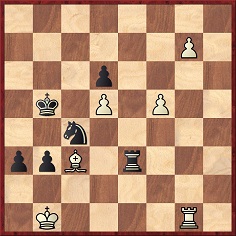
The co-authors specified no opponent or occasion, merely stating that Krogius won by 1...Rxc3 2 g8(Q) Nd2+ 3 Ka1 Rc1+ 4 Rxc1 b2+ 5 Ka2 bxc1(N)+ 6 Kxa3 Nc4 mate. They call this ‘one of the loveliest mates produced in actual play’, but what more is known about it?
(3069)
Vesa Määttä (Oulu, Finland) informs us that Eero E. Böök gave the Krogius position on page 72 of the 2/1978 issue of Suomen Shakki, describing it as from a casual game in Helsinki in January 1932 between Yrjö Verho (‘an artist, later professor’) and A.R. Krogius (1903-80). The latter was well known in Finnish chess circles during the 1920s and 1930s and won the national championship in 1932.
Our correspondent adds a game presented by Böök in the same article:
Ali Ragnar Krogius – I. Niemelä
Loviisa, July 1934
Queen’s Gambit Declined
1 d4 Nf6 2 c4 e6 3 Bg5 d5 4 e3 Nbd7 5 Nf3 Be7 6 Nbd2 O-O 7 Bd3 b6 8 Qc2 Bb7 9 cxd5 exd5 10 Ne5 Nxe5 11 dxe5 Ne4 12 h4 Nxg5 13 hxg5 g6 14 f4 c5 15 Qd1 c4
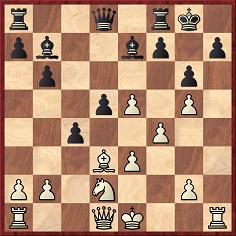
We have seen this miniature on page 339 of Schackvärlden, September 1934 and should like to locate a 1930s source for the Verho v Krogius game too.
(3088)
From page 5 of Modern Chess and Chess Masterpieces by H.E. Bird (London, 1887):
‘… Zukertort has good-naturedly and not unkindly expressed the opinion that if I had been less experimental and less hazardous in my play I might have secured higher positions in tournaments; and Mr Minchin in his great and very successful work [the London, 1883 tournament book] did me more than justice; if, however, I have had less success than some other players, I have derived more amusement and real pleasure from the combinations of the game, besides which if I am not original in chess I am nothing.’
(3085)
Some gleanings from Kings of the Chess Board by L. Steiner (Roseville, 1948):
‘If there is any possibility of not recapturing a pawn, Ragozin would always try to avoid the recapture. He would sit at the board, brooding over more artistic plans.’ (Page 26)
‘Tartakower is truly the grand (not old, as he is fresh, virile and very active) man of chess. He was always a symbol to me. I never knew an intrinsically stronger chessmaster. There were better players, as Tartakower deliberately chose inferior openings – for pure devilment at first and later as a habit. But, when he got into the inevitable jam, Tartakower played with the strength of steel, often extricating himself.’ (Page 30)
‘Although his opening repertoire is not extensive [Barcza] has analysed those openings he does favour more thoroughly than any other master I know. He analyses these openings right through to the middlegame and, incredible as it may seem, to the very endgame itself. Barcza knows exactly what types of middlegames arise from his chosen openings and what types of endgames can be expected.’ (Page 44)
(3098)
The reference to Barcza has reminded Steve Giddins of what Wolfgang Heidenfeld wrote on pages 106-107 of the April 1962 BCM regarding the start of Barcza’s game against Ólafsson at that year’s Interzonal tournament in Stockholm:
‘1 Nf3 g6 2 d4 (Unusual – for Barcza.) 2…Nf6 3 g3 (Normal – for Barcza, who still relates with pride Golombek’s remark on his opening repertoire. “Barcza”, Golombek is reputed to have said, “is the most versatile player in the opening. He sometimes plays P-KKt3 on the first, sometimes on the second, sometimes on the third, and sometimes only on the fourth move.”)’
Mr Giddins asks if any corroboration exists for Golombek’s alleged observation.
(3242)
From page 88 of Wonders and Curiosities of Chess by Irving Chernev:
‘P.F. Blake received first prize for a problem published in the Kent Mercury in 1892. The problem was later found to have a dual solution!
Stranger was the case of the problem by L. Knotek which won second prize in a composing tourney. The problem was found to have seven first moves which would solve it, in addition to the one intended by the author!’
Chernev had written similarly on pages 29-30 of his 1937 book Curious Chess Facts, the only substantive difference being the provision of a year (1925) for the Knotek composition. Regarding the Blake ‘wonder and curiosity’, the exclamation mark from Chernev was, to be sure, cheaply earned, but we decided to look for both compositions. It was easy to find that Blake won first prize in a contest organized by the Kentish (not ‘Kent’) Mercury at that time (the composition was published on page 113 of the February 1893 BCM), but there was no question of unsoundness. Concerning Ladislav Knotek, we found that in 1925 he won second prize in a Wiener Schachzeitung competition, but here too the composition had only one key move.
Consequently, we enlisted the help of two correspondents. With respect to the Blake problem, Michael McDowell (Westcliff-on-sea, England) writes as follows:
‘P.F. Blake won first prize in a tourney for two-movers run by the Kentish Mercury, the entries being published between September and December 1892. The problem (i.e. the same as the one published in the February 1893 BCM) was given in the Kentish Mercury of 16 September 1892:
Mate in two
The key, 1 Ne6, sets up a block, and there is one dual, after 1...Ra3.
Blake published three other two-movers in the Kentish Mercury between December 1891 and May 1892. All are sound, and have waiting keys and completely accurate play.
Chernev’s comment is inexplicable. Of course, there is nothing strange about older problems, even prize-winners, having cooks. The composers did not have the benefit of computer testing.’
As regards Chernev’s claim about the Knotek problem, we have received the following from Karel Mokrý (Prostějov, Czech Republic):
‘I have a book (copies of the chess column in Národní Listy) which features a selection of 150 of Knotek’s problems from 1910 to 1928. From 1925 ten problems are given, three of which won second prize. One of these was the composition in the Wiener Schachzeitung tournament mentioned by you, and the second, also sound, competed in the Slovenský národ tourney. The third was from the Lidové Noviny problem tournament. It was described as the corrected version of the problem, so it is possible that the original was the composition referred to by Chernev. The “corrected” version was:
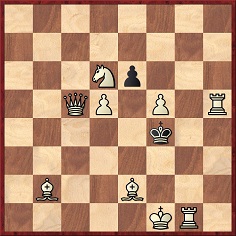
Selfmate in five moves
The solution was given as 1 Qa7, one line being 1…exd5 2 Ke1 3 Qg7 4 Rf1 5 Bd1.’
We have subjected this ‘corrected version’ of the Lidové Noviny problem to a computer check, which indicates that in addition to 1 Qa7 there are five key moves (Bg7, Bh8, Bd3, f6 and Bf6). Mr McDowell points out that a sound (computer-tested) version appeared on page 30 of Jiří Jelínek’s 1996 book The Dynamic Echo in the Bohemian Selfmate:
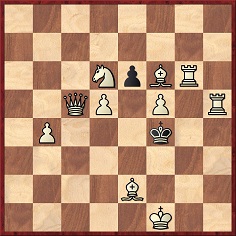
Selfmate in five moves
Solution: 1 Rg1 exd5 2 Ke1 d4 3 Qc4 Ke3 4 Rf1 d3 5 Bd1 d2; 1…e5 2 Bf3 e4/Kxf3 3 Rh4(+) Kxf3/e4 4 Bc3 e3 5 Be1 e2; 1…exf5 2 Rgh1 Kg3 3 Qc4 f4 4 Kg1 f3 5 Bf1 f2.
(3104)
The problem below (by Alain C. White, Good Companions, 1920) is certainly well known to composition specialists, yet we sought it in vain in innumerable periodicals of the time, as well as in many ‘standard’ problem books published down the years:

Mate in two
On page 94 of The Joys of Chess (New York, 1961) Fred Reinfeld wrote:
‘Though the key is a waiting move, it is anything but inactive. In fact, it has substantial claims to being the most astonishing key in the whole realm of problems.’
Unfortunately, Reinfeld’s book placed the white queen at g7, which allows 1 Qg1 mate. Peter J. Tamburro, Jr. copied the error on page 151 of his book Learn Chess from the Greats (Mineola, NY, 2000) and, on the same page, misspelt A.C. White’s first name three times.
(3135)
Taylor Kingston (Shelburne, VT, USA) draws attention to the Everyman Chess advertisement for Winning Unorthodox Openings by Angus Dunnington on page 16 of the September 2000 CHESS. The book receives this commendatory quote from ‘Teletext’:
‘An essential read for anybody trying to confuse their opponent from the outset!’
In reality, the confusion from the outset originates within the advertisement itself, which reads:
‘This objective guide covers all 16 of White’s alternatives to 1 e4, Nf3. Some of these lines have a cult following, while others are starting the game, with their own subtleties and pitfalls for the are truly off-beat. Dunnington provides the “essential to catch people with them as White, or need, as must all players, Black.’
(Kingpin, 2000)
Under the heading ‘The Save to End Saves’ pages 2-3 of Chess World, 1 January 1950 gave the conclusion of a game between C.G. Watson and G. Koshnitsky from the Australian Championship in Sydney on 3 September 1945, in which Watson ‘produced the most spectacular recovery of his whole career’. Below we quote the magazine’s punctuation and some extracts from its annotations:
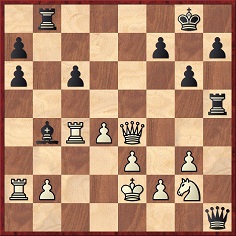
31…Qg1! (‘The obvious move was 31…Rh2, and we leave students to see how White would then at least draw.’) 32 Rxb4! Rxb4 33 Nf4 Rhb5! 34 Qe8+ Kg7 (‘Now 35 Nd3 would give a very good fight, but Watson was in acute clock trouble and therefore chose aggression at all costs.’) 35 Ne6+!? Kf6! 36 Qh8+ Kxe6 (‘Now Watson sealed a move. As he was a rook down, one heard the usual mutterings on all sides – why doesn’t he resign? – what on earth does he think he’s playing on for? – and so on. But for one thing the black king is in mid-board. For another, the official opening had caused delay, and there was only an hour for tea, so Koshnitsky was not likely to do much analyzing – in any case it looked hardly worthwhile.’) 37 d5+! Kxd5? (‘The first and chief error. He thinks anything goes. After 37…Rxd5 White had nothing.’) 38 Qf6! Qh1 (‘Quite a deep idea. His king seeks sanctuary at a8 ultimately, and he therefore protects c6 against a diagonal check when that stage arrives. But it is too subtle. Better 38…Qb1, threatening things.’) 39 b3! (‘Black had missed this. Now he seeks desperately for a means of evading the draw by perpetual check. At last he finds one.”) 39…Kc5? 40 Qe5+ Qd5??
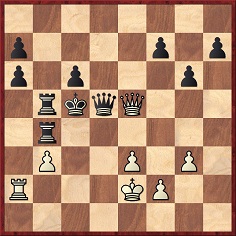
(‘White mates in four. Somehow it had not entered Black’s head that there might be a fate worse than drawing.’)
(3131)
From page 44 of The Complete Book of Chess by I.A. Horowitz and P.L. Rothenberg (New York, 1969):
‘Do not be impressed by publisher’s blurbs stressing the quantitative output of the author. It is fundamental that the greater the output by the author, the more likely is his chess product to be a crude pastiche or a rehash or an actual perversion of what already exists in much superior form.’
From the book’s back cover:
‘I.A. Horowitz … is … the author of some 30 books on chess.’
(3163)
In any short-list of the most beautiful chess books ever produced there is a guaranteed place for The Twentieth Century Retractor, Chess Fantasies, and Letter Problems by Mrs W.J. Baird (Henry Sotheran & Co., London, 1907). Its design (navy blue print) is as remarkable as the material is esoteric.
But now we have received a new book so stunning in terms of both production and content that we can only marvel at it: David DeLucia’s Chess Library. A Few Old Friends (Darien, 2003). Mr DeLucia presents items from his collection, with innumerable photographs (many in colour) and informative commentary. His possessions include a bamboo cane of Morphy’s, a gold pocket watch of Capablanca’s and a childhood accordion of Fischer’s. Books, manuscripts, letters and score-sheets are all set out with matchless elegance. The book is a 236-page hardback in a limited edition of 150 copies. Readers who find a way of procuring one of them will be fortunate indeed.
(3164)
Louis Blair (Carlinville, IL, USA) writes to us about this position from pages 88-89 of The New York Times Guide to Good Chess by I.A. Horowitz (New York, 1969):
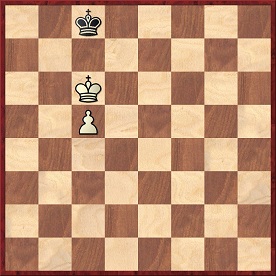
White to move
Incredibly, Horowitz asserted: ‘it is a drawn game, provided Black defends correctly’. He gave 1 Kd6 Kd8 2 c6 Kc8 3 Kc5 Kc7, disregarding the ultra-obvious 3 c7.
(3178)
A book co-edited by a well-known chess figure contained the two photographs reproduced below. Who was he?
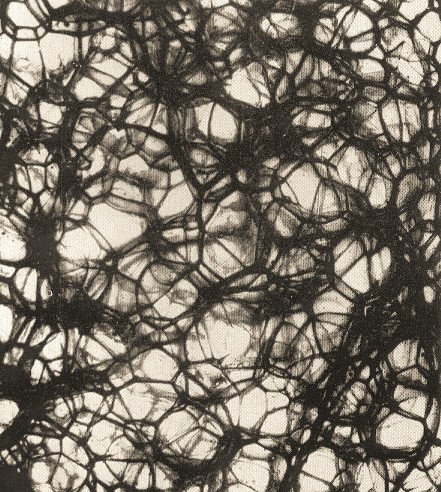
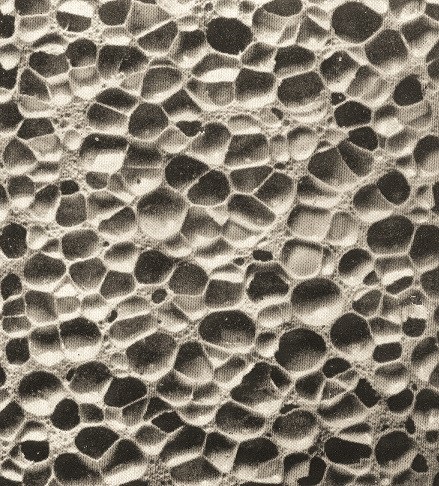
The answer is T.R. Dawson. The two photographs appeared in a book which he co-edited with P. Schidrowitz: History of the Rubber Industry (Cambridge, 1952). The illustrations are a) ‘photomicrograph (x 6) showing cross-section of foamed rubber, 1908’ and b) ‘photomicrograph (x 20) showing expanded structure’.
Page iii of the book, which appeared shortly after Dawson’s death, described him as follows:
‘Intelligence Officer of the Research Association of British Rubber Manufacturers, a man of international repute in the world of rubber, and, amongst other things, well known for his fine work in organizing and developing at Croydon the world’s greatest rubber library.’
(3181)
From Alain Pallier (Avignon, France):
‘I would like to ask for further biographical data about L. Monosson, who lived in France in the 1920s and 1930s. He was in St Petersburg in 1912 (see pages 91-92 of Complete Games of Alekhine, volume 1 by J. Kalendovský and V. Fiala). On page 6 of issue 65 of the Bulletin of the Fédération Française des Echecs (15 October 1934-15 January 1935), there is a short report on the Paris Championship of 1934:
“Le tournoi principal a vu la victoire de l’excellent joueur M. Monosson, de nationalité russe, qui n’ayant perdu aucune partie, gagne ainsi brillamment le titre de champion de Paris 1935 avec 20 points sur 24 possibles. Suivent ensuite: MM. Golbérine et Halberstadt, 18 points; MM. Anglarès et Rabinovitch, 17 points; MM. Vernay et Voisin: 14 points; Efron, 12 points et Perelmans 10 points.”
Note that a win was rewarded with three points (a draw with two and a loss with one). Monosson scored + 4 –0 =4.
Kalendovský and Fiala mention the 1931 consultation tournament in Nice (Monosson was supposed to have settled in Nice); I note that in 1932 Monosson was elected President of the Cercle de Lutèce, in Paris. (V. Halberstadt was the treasurer and C. Seneca and M. Duchamp are given as “technical advisers” in the club.) Source: Bulletin No. 57 of the Fédération Française des Echecs, December 1932, page 7.’
Here is a game which Tartakower annotated on pages 834-835 of L’Echiquier, December 1934:
L. Monosson – Golbérine
Paris Championship, 18 November 1934
Ruy López
1 e4 e5 2 Nf3 Nc6 3 Bb5 a6 4 Ba4 Nf6 5 O-O b5 6 Bb3 Be7 7 a4 Rb8 8 axb5 axb5 9 Bd5 Nb4 10 Bb3 Nxe4 11 Nxe5 O-O 12 c3 Nc6 13 Nxf7 Rxf7 14 Bxf7+ Kxf7 15 Qh5+ Kf8 16 Qxh7 Nf6 17 Qh8+ Kf7 18 Qh4 d5 19 d4 Qd7 20 Bf4 Bd6 21 Nd2 Ne7 22 Bxd6 Ng6 23 Qg5 cxd6 24 Rfe1 Qf5 25 Ra7+ Kf8 26 Qg3 Rb6 27 Ra8 Kf7 28 Qe3 Rb7 29 Qg3 Rb6 30 h3 Ne4 31 Qe3 Kf6
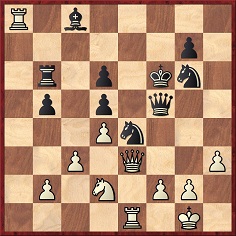
32 g4 (Tartakower gave two exclamation marks to this ‘deeply calculated’ move.) 32…Qf4 33 Qxf4+ Nxf4 34 Nxe4+ dxe4 35 Rxc8 Nxh3+ 36 Kg2 Ng5 37 d5 b4 38 Rc6 Rb5 39 Rxd6+ Ke5 40 Rg6 bxc3 41 Rxg5+ Kf4 42 Rxg7 Rxb2 43 Rc7 Resigns.
(3188)
After George Shories (or Georg Schories) died in 1934, his obituaries in the Deutsche Schachzeitung (February 1935, pages 41-42) and the Deutsche Schachblätter (1 March 1935, page 74) stated that he had been born in Berlin on 9 January 1873, whereas other sources (e.g. ‘The Chess Lovers’ Kalendar’ on page 313 of The Year-Book of Chess, 1912) gave 9 January 1874.
The BCM ignored Shories’ death but the following paragraph had appeared on page 123 of the March 1934 issue:
‘In his column, the Augsburger Schachblatt, Dr A. Seitz lately devoted a long article to Georg Schories, formerly known in England for many years as G. Shories, who on 9 January reached his 60th birthday. He mentions that after his success at the amateur tournament at Ostend [in 1907] a business postcard was addressed to him from Germany “G. Schories Chess Champion England”.’
This reminds us of a brief item on page 265 of the May 1965 CHESS under the heading ‘It had to happen’:
‘We have just received an envelope addressed:
“CHESS,
Sutton Coldfield,
Sufficient address.”’
(3193)
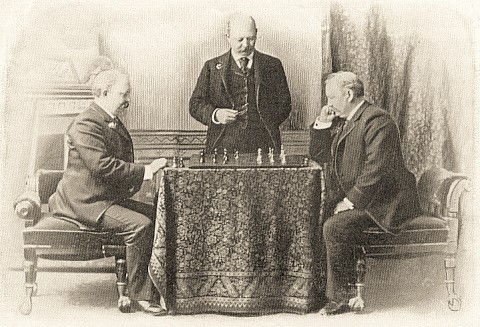
(3221)
The photograph was in the June 1897 issue of the American Chess Magazine (on the unnumbered page opposite page 30). The caption read:
‘Mr Chas. A. Gilberg, the distinguished amateur, is playing with Mr Chas. A. Gilberg, the President of the Manhattan Chess Club, while Mr Chas. A. Gilberg, the eminent problem composer, is an interested onlooker.’
(3224)
See too a photograph of P.H. Williams, first given in C.N. 2942:
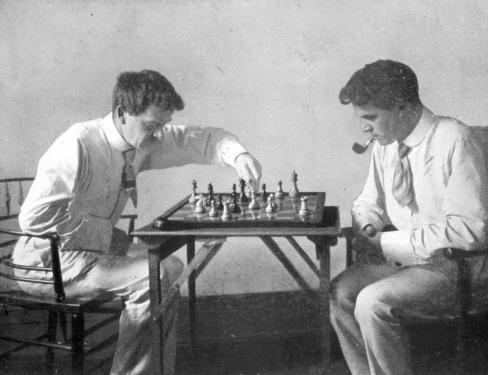
This photograph of Philip Peterson appeared in C.N. 6040:
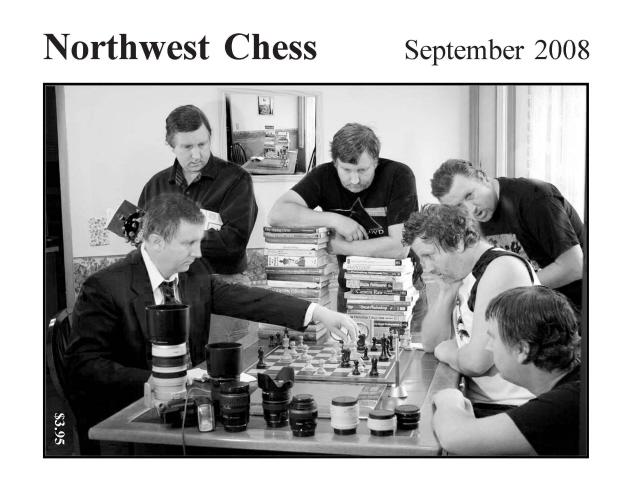
From Norsk Schakblad, March 1925, page 37:

Acknowledgement: Cleveland Public Library
(12097)
‘What I should like to see is a single volume compilation on the lines of, say, the Oxford Companion [to] Music, to do for chess what the latter does for music.’
Source: a letter by W. Unterberg on page 174 of CHESS, May 1946.
(3228)
From CHESS, September 1958, page 370:
‘John E. Almond of San Francisco announces the “very first world under-water chess championship”. In a local swimming pool, one of those with a plate-glass side-window which enables people to sip coffee whilst watching the bathers’ antics broadside-on, a metal chess board is to be sunk in a vertical position. The contestants will be timed, and dive down alternately to make moves with metal pieces.
To date, entrants consist of John Almond and a friend.’
It has yet to be ascertained whether the event went ahead.
(3237)
‘Chess as a curative for seasickness’ was the title of a brief article on page 227 of the December 1899 American Chess Magazine by Oviedo Mesick Bostwick (who was featured in play against Janowsky in C.N. 3174):
‘Several years ago I had occasion to cross the ocean to Havre on that ill-fated steamer La Bourgogne, now resting at the bottom of the sea. In the smoking cabin there were chess tables provided with Staunton men having little wooden pegs, which prevented the pieces from slipping off the boards.
… We played morning, afternoon and evening. In fact, we did nothing else during the entire voyage as, unfortunately, the weather continued stormy all the way over, and nearly all the passengers were seasick but, strange to relate, we chessplayers were not affected at all, so engrossed were we in combinations, problems, etc. from morning until night that we actually had no time for that dreaded illness.
I certainly do attribute my non-seasickness on this voyage to mental concentration upon the ancient game …’
Bostwick related that during his return journey on a different line there were no chess facilities and ‘I fell seasick and remained so for three awful days’.
(3238)
We are grateful to HarpWeek LLC for permission to reproduce a group photograph which appeared in Harper’s Weekly at the time of the New York, 1893 tournament:
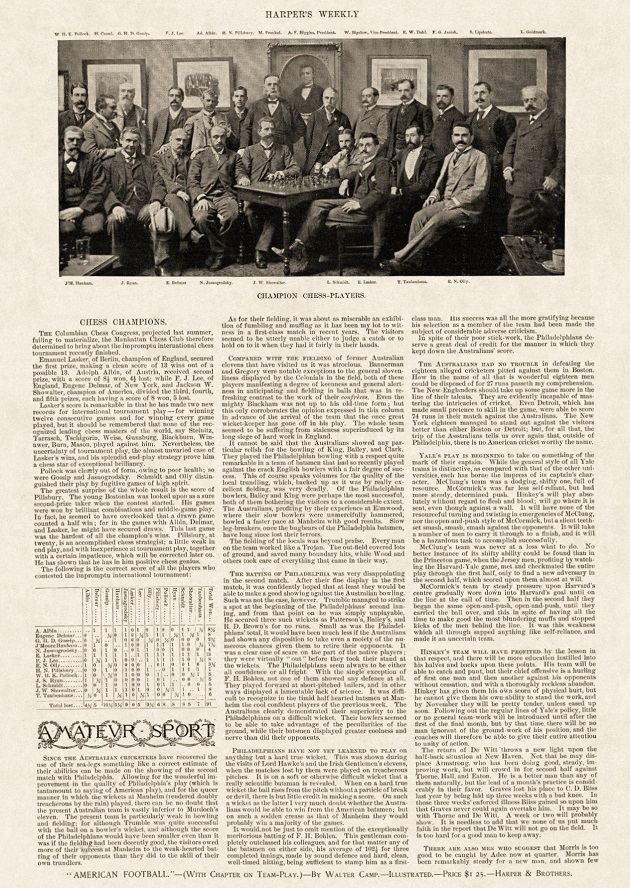
From left to right in the back row: W.H.K. Pollock, H. Cassel, G.H.D. Gossip, F.J. Lee, A. Albin, H.N. Pillsbury, M. Frankel, A.F. Higgins, W.Bigelow, E.W. Dahl, F.G. Janish, S. Lipschütz and L. Goldmark.
Front row: J.M. Hanham, J. Ryan, E. Delmar, N. Jasnogrodsky, J.W. Showalter, L. Schmidt, Em. Lasker, J. Taubenhaus and E.N. Olly.
(3240)
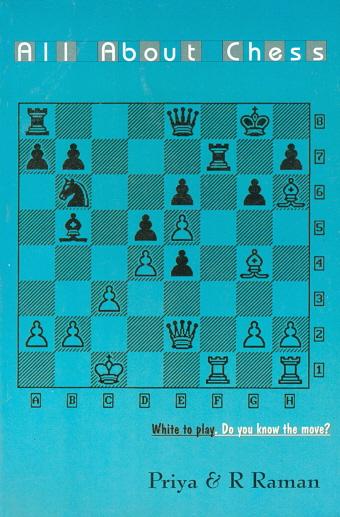
‘Is the rook same as a bishop?’, asks the back cover of All About Chess by Priya and R. Raman (Minerva Press, New Delhi, 2000). The answer, it emerges, is no, it is not same. Even so, anyone relying on this 125-page book for an introduction to chess (a game which, according to the blurb, ‘has always been the sole proprietary of aristocratic classes’) may wonder if anything is straightforward. On page 33 a pin is defined as ‘the confinement of a chessmen to the king or a piece of higher value’. A section on exchanges on page 51 advises: ‘Exchange at the right moment. Well I can hear you ask which is the right moment. Only from experience one can understand that.’ Page 53 says: ‘Do not accept the poised pawn, lest you repent of indigestion.’ The same page proffers counsel all too easily forgotten: ‘Remember that a good move in one position may be a blunder in yet another position.’ The following page advises: ‘Remember the king cannot check. So in a mad rush to checkmate your opponent do not get mated because that way you would have indirectly blocked your emergency exit also.’ From page 54 comes this too: ‘Chess is not always pure mathematics. In chess, a diagonal is equal to a side.’
On the next page we learn that ‘a bishop can hold His Majesty with the queen’, whereas page 56 states: ‘Other things being equal check eventually leads to an advantageous position – there are exceptions too.’ On page 65 the novice is warned, ‘Beware of self blocks that facilitate reflexive mates’ and ‘When your opponent advances a pawn in one file, you must advance your pawn to distract his attention’. On the next page the co-authors affirm that ‘the king is safe even at the centre when the soldiers are stationed affront’. Page 70 discusses sacrifices and offers yet another memorable maxim: ‘Sacrifice to get it back with rich dividends at overburdened locations.’
A proper introductory book on chess is still awaited from India.
(3243)
On page 7 of his book Farewell to Germany (London, 1959) Heinrich Fraenkel (who wrote on chess under the pseudonym ‘Assiac’) described his enforced departure from the fatherland:
‘Some time in 1932 I had accepted the position of Berlin correspondent for Variety, the New York show-business journal. It was a mere side job for me, even though I had to file quite a few thousand words every week. Now it so happened that a week or two after Hitler’s accession, Variety printed a Berlin news item which the new regime promptly branded as “atrocity propaganda”. It certainly wasn’t, but whatever the truth of that paragraph – it dealt with the undeniable fact that an American film executive had been beaten up by power-drunk storm-troopers combing the Kurfürstendamm for persons who appeared to them to “look Jewish” – I had not filed the story; it came from an American News Agency. However, since I was listed as the paper’s Berlin correspondent the wrath of the Gestapo descended on my head (or, more precisely, on my flat, which was completely ransacked).
Fortunately I had been warned by friends and I wasn’t at home that night. It happened to be the night after the Reichstag fire, when thousands of people were arrested for alleged conspiracy in that crime. In point of fact they were a motley assortment of persons disfavoured by the new authorities for one reason or another. Well-connected friends told me that it would be wise for me to get across the frontier almost at once. I did so and without very much trouble.
I first went to Paris for a few months and then to London.’
Heinrich Fraenkel (1897-1986) had, however, first gone to England as a schoolboy, and in 1921 he won the Major Open tournament at the British Chess Federation Congress in Malvern. His victory over the runner-up, G.M. Norman, was given on page 329 of the September 1921 BCM.
(3244)
We are no longer at all sure that our observation about Assiac and the 1921 tournament is correct.
The BCM referred to ‘Dr H.L. Fraenkel’, and it now seems to us far more likely that this was the player whose death was briefly mentioned on page 203 of the June 1948 BCM:
‘Frequenters of the Gambit, and many Western chessplayers, will be sorry to hear Dr H.L. Frankel died, after a stroke, recently. He was a first-class player and would rather succumb to a well-played attack than draw or win by an opponent’s blunder. He was never more delighted than when he had brought a subtle sacrifice to fruition. A charming opponent at any time.’
(3385)
Alan Truscott, who has written a large number of books on bridge (as well as the Foreword to Abrahams’ Brains in Bridge – see Chess and Bridge), was not a chess author but he gained some prominence as a player in the 1940s and early 1950s. The game below comes from page 274 of the December 1943 BCM; Truscott (born in 1925) was ‘the youngest member of the Croydon team’.
Alan Fraser Truscott – C.J.A. Wade
Croydon v Brighton match, Croydon, November 1943
Ruy López
1 e4 e5 2 Nf3 Nc6 3 Bb5 d6 4 d4 exd4 5 Nxd4 Bd7 6 Nxc6 Bxc6 7 Bxc6+ bxc6 8 c4 Nf6 9 Nc3 Be7 10 O-O O-O 11 b3 Nd7 12 Qc2 Bf6 13 Be3 Re8 14 Bd2 Nc5 15 f3 Bd4+ 16 Kh1 Qh4 17 Rae1 Be5 18 f4 Bf6 19 Rf3 g6 20 Nd1 Qg4 21 b4 Ne6 22 Ne3 Qh4 23 Rh3 Nd4 24 Qd1 Qxf4 25 Ng4 Resigns.
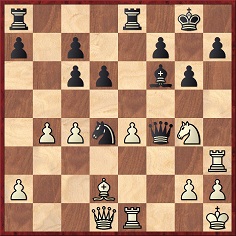
The following game was chosen by Tartakower as the runner-up in the tournament’s ‘best game’ competition:
H.G. Rhodes – Alan Fraser Truscott
Harrogate Premier tournament, August 1947
King’s Indian Defence
1 d4 Nf6 2 c4 d6 3 Nc3 Nbd7 4 g3 g6 5 Bg2 Bg7 6 e4 e5 7 d5 O-O 8 Nge2 a5 9 O-O Nc5 10 h3 Ne8 11 Be3 b6 12 a3 f5 13 exf5 gxf5 14 f4 e4 15 Rb1 Bd7 16 b4 axb4 17 axb4 Nd3 18 Bd4 Bxd4+ 19 Nxd4 Qf6 20 Nde2 Qg6 21 Kh2 Nf6 22 Nc1 Nh5 23 N3e2 Ra3 24 Qd2
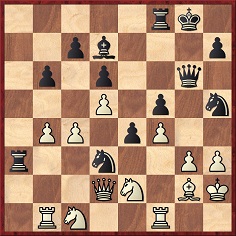
(Now comes what the BCM described as ‘the 14-move combination which won him the game’.) 24…Nxg3 25 Nxg3 Nxc1 26 Nh1 Ra2 27 Rb2 Rxb2 28 Qxb2 Nd3 29 Qd2 Kf7 30 Nf2 Nxb4 31 Nxe4 fxe4 32 f5 Qg7 33 f6 Qg6 34 Bxe4 Qxe4 35 Re1 Qc2 36 Qxc2 Nxc2 37 Re7+ Kxf6 38 Rxd7 Rf7 39 White resigns.
Sources: BCM, September 1947, page 281 and January 1948, pages 25-26.
The final game here features some intricate knight play:
Alan Fraser Truscott – Denis Victor Mardle
Oxford v Cambridge match, London, 24 March 1951
Dutch Defence
1 d4 f5 2 g3 e6 3 Bg2 Nf6 4 Nf3 d5 5 O-O Be7 6 c4 O-O 7 Nc3 c6 8 Qc2 Qe8 9 Bf4 Qh5 10 a3 Nbd7 11 b4 dxc4 12 e4 Nb6 13 Rfe1 fxe4 14 Nxe4 Nfd5 15 Bg5 Bxg5 16 Nexg5 Rf5 17 Ne4 Bd7 18 Ne5 Rff8 19 Nc5 Bc8 20 Nxc4 Rf6 21 Nd6 Rh6 22 h3 Bd7 23 Re5 g5 24 Qd2 Rg6 25 a4 Rf8 26 a5 Nc8 27 Ndxb7 Rf7

28 Nd8 Re7 29 Nxd7 Rxd7 30 Nxe6 Re7 31 Bxd5 cxd5 32 Nf4 Resigns.
Source: BCM, May 1951, page 152.
Although a number of Alan Truscott’s games from the 1940s appear in databases, he has generally been confused with a later player with the same surname.
(3279)
The illustration below shows the last paragraph of Grandmaster from Oregon by Casey Bush (Portland, 1991). This copy of ours is extensively inscribed and annotated by Dake (who sometimes referred to himself in the third person).
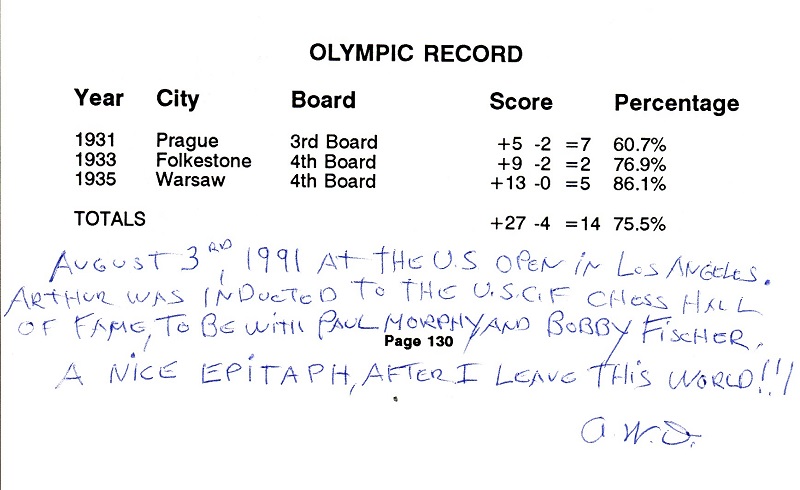
(3306)
On the front cover
A book whose front cover features a US President (George Bush) is Tactics 77 Chess Combinations by Zsuzsa, Zsófia and Judit Polgar (Budapest, 1991):
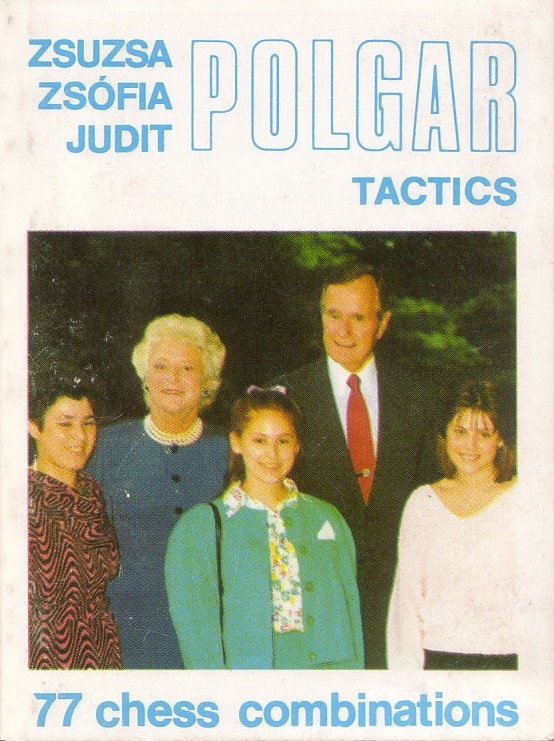
(3331)
In the position below, should White play 1 Qb7+ Kh6 2 Qxb6, etc.?
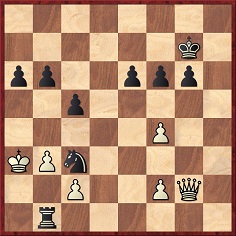
‘Thornley v Griffith, London, 1903’ is the caption on page 151 of The Basis of Combination in Chess by J. du Mont (London, 1938), and we are seeking the full game in a primary source.
(3334)
The game continued 1 Qb7+ Kh6 2 Qxb6, whereupon Black unleashed 2…Na4, described by J. du Mont as ‘a problem move … which is of unusual beauty’ and ‘a startling and imaginative surprise’. The game ended 3 Ka2 Nxb6 4 Kxb1 Nd5 5 White resigns.
(3342)
Regarding Alpha Teach Yourself Chess in 24 Hours by Zsuzsa Polgar (who, the back cover says, ‘has even defeated, at different events, world champs Anatoly Karpov and Victor Korchnoi’), Hoainhan ‘Paul’ Truong and Leslie Alan Horvitz (Indianapolis, 2002/03), Louis Blair (Carlinville, IL, USA) writes:
‘From page 232 of the book:
“An undisputed genius, Capablanca was known for his intuitive grasp of the game, especially his astonishing capacity to play endgame positions that seemed next to impossible. He reigned as world champion, after defeating Lasker, until 1927. Bobby Fischer, who wrested the championship from him after a long period of Russian domination of the game, called Capablanca ‘possibly the greatest player in the entire history of the game’.”
On page 230 the comments about Morphy and Staunton appear to be written by someone who learned about the subject by talking to Steiner and Highet (C.N. 3256).’
We add that the lack of effort and thought is also shown by the section on recommended books (pages 321-328). Instead of offering their own observations, the co-authors have often simply lifted text (up to a dozen lines) from the publishers’ blurb and presented it as their own assessments. Examples occur with volumes by John Nunn and Jonathan Rowson and, indeed, with one of our own books.
Moving on to another of the many historical mishaps, page 236 states that the Kasparov v Kramnik match in 2000 was:
‘… the first occasion in the world championship history that the defending champion has failed to win a single game.’
Curiously, the opposite mistake appears in a 2003 book from Cardoza Publishing, which asserts that Capablanca’s 1921 feat of winning the world championship without losing a game ‘has never since been repeated’. (Readers will no doubt be able to identify for themselves that book, which, incidentally, also contains the following information about Alekhine: ‘b. 1882 in Mocow’.)
Yet even Cardoza Publishing is unlikely to rival the record achieved by Alpha Teach Yourself Chess in 24 Hours on pages 230-231, where Adolf Anderssen’s name is misspelt ‘Andersen’ 13 times.
(3343)
See too Hype in Chess.
From Neil Brennen (Malvern, PA, USA):
‘I found a curious chess reference on pages 212 and 215 of James Abbott McNeill Whistler’s The Gentle Art of Making Enemies (London, 1892). In 1888 Whistler was replaced by W. Bayliss as President of the Royal Society of British Artists, and the Pall Mall Gazette (6 July 1888) listed Bayliss as “champion chessplayer of Surrey”, a description Whistler mocked in a letter to the Gazette which was reproduced in his book:
“But also Mr Bayliss takes this rare occasion of attention to assert his various qualifications for his post as head of painters in the street of Suffolk, and so we learn that he is:
‘Chairman of the Board-school in his own district’, ‘Champion chessplayer of Surrey’, ‘A Member of the Diocesan Council of Rochester’, ‘Fellow of the Society of Cyclists’, and ‘Public Orator of Noviomagus’.
As chessplayer he may have intuitively bethought himself of a move – possibly the happy one, – who knows? – which in the provinces obtained him a cup; as Diocesan Councilman he may have supposed Rochester indifferent to the means used for an end; but as Public Cyclist of the Royal Society of Noviomagus his experience must be opposed to any such bluff as going his entire pile on a left bower only.”
Do you have any examples of the chess play of either Bayliss or Whistler?’
We are aware of no chess games by Whistler, but some information can be offered here on Sir Wyke Bayliss (1835-1906), who was President of the Royal Society of British Artists from 1888 until his death. His book Olives The Reminiscences of a President (London, 1906 – published posthumously) contained numerous references to chess. An example comes from pages 15-16:
‘There is one more thing I like to recall, and that is my skill at chess. Chess was always a delight to me, and I greatly wonder that so few players are found among artists. Ruskin, indeed, was a great lover of the game, as have been many of the most distinguished men of letters. Turning, as it does, on such high faculties as imagination, analysis, synthesis, the chess board should be found in every studio. In this also, as in everything else, my father and I were chums, and while still a child I could beat everyone I knew but himself. Staunton, who was a friend, could give me only the smallest odds; he could not give me the odds of playing without smoking his pipe. I could easily play half a dozen games simultaneously without seeing the board.
Now, for the merchant, who has no cares when he leaves his office; for the parson, who has nothing to think about but his next sermon, and doesn’t think much about that; for the lawyer or doctor, who learned all they want to know in the days of their youth; for the Parliament man, who has only to stand in the lobby and feel which way the wind whistles through his brains; it is all very well to take life easily, to sing or dance, or go to the theatre, or play tennis or take a boat up the river. But for the artist – who never can lay the ghosts which haunt his brain – who, day and night and night and day, is seeing what no one else can see – visions that he is striving to crystallize into beautiful and permanent shapes, who wears his life out in honest work that makes the brain sweat; – for the artist, I say, some quiet, simple, easy, unfatiguing, refreshing recreation is needed, and I find this in chess.’
More or less the same passage had already appeared in the American Chess Magazine (October-November 1899, page 176).
From page 204 of Olives:
‘Since I used to play at the old “Westminster” with Staunton, and De Vere, and Blackburne, and Steinitz, and MacDonnell, and Löwenthal, and Wormald, and Boden, and Lyttelton, chess has always been my delight. London has never been without its chess clubs – but the memory of the “Westminster” has a special charm that can never be forgotten. Now our great city has brought chess to the position of a science, as well as an art; and every afternoon or evening men of the finest thought and brain-power gather round the little black and white squares, which represent the battle of life without bloodshed.’
One of his rare incursions into ‘serious’ chess was the 1868-69 Handicap tournament in London, and three of his games (played at odds) were given in The Transactions of the British Chess Association for the Years 1868 and 1869 by J. Löwenthal and G.W. Medley (London, 1869). These included two losses to Wisker, who also defeated him in the following miniature, taken from pages 47-48 of Chess Sparks by J.H. Ellis (London, 1895):
Wyke Bayliss – John Wisker
‘Played about 1868’
Scotch Gambit
1 e4 e5 2 Nf3 Nc6 3 d4 exd4 4 Bc4 Bc5 5 c3 Nf6 6 Bg5 h6 7 Bh4 g5 8 Nxg5 hxg5 9 Bxg5 Ne5 10 Bd5 dxc3 11 Nxc3 Bxf2+ 12 Kxf2 Nfg4+ 13 Kg1 Qxg5 14 Qe2
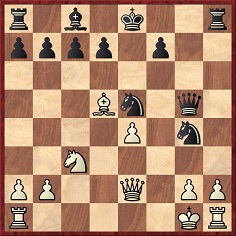
14…b6 15 Bxa8 Ba6 16 Qe1 Nf3+ 17 gxf3 Qc5+ 18 Kg2 Ne3+ 19 Kg3 Rg8+ 20 Kh3 Qh5+ 21 White resigns.
‘So far back as 1854 he frequented the chess resorts then open in London, meeting and occasionally playing with the English masters of the period from 1855’ reported his obituary on pages 187-188 of the May 1906 BCM, which gave the following game from his final years:
Wyke Bayliss – Leonard Percy Rees
Balham (London), 27 January 1903
Ponziani Opening
1 e4 e5 2 Nf3 Nc6 3 c3 Nf6 4 Qc2 Bc5 5 b4 Bb6 6 b5 Nb8 7 Nxe5 Qe7 8 d4 d6 9 Ba3 c5 10 bxc6 bxc6 11 Bd3 O-O 12 O-O Qc7 13 Nf3 Ba6 14 e5 Bxd3 15 Qxd3 dxe5 16 dxe5 Rd8 17 Bd6 Ne8 18 Ng5 Rxd6 19 Qxh7+ Kf8 20 exd6 Nxd6 21 Qh8+ Ke7 22 Qxg7 Kd8 23 Qf8+ Kd7 24 Nxf7 Resigns.
Below is a painting by Sir Wyke Bayliss of Santa Croce, Florence:
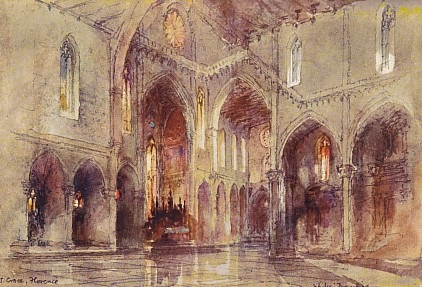
(3361)
As John Montgomerie noted when presenting the following battle on pages 11-14 of his book The Quiet Game (London, 1972), Brian Harley’s Observer column described it as ‘a fascinating nightmare’.
A. Mortlock – T.M. Wechsler
Ramsgate (Premier Tournament, Section B), 1929
Queen’s Pawn Game
1 d4 Nf6 2 Nf3 b5 3 Bg5 Ne4 4 Bh4 c5 5 dxc5 Qa5+ 6 c3 b4 7 Qd4 bxc3 8 b4 c2
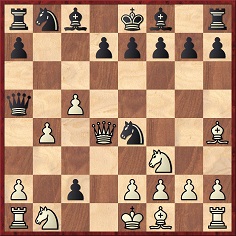
9 Nbd2 Qa3 10 Nb3 f5 11 Ne5 Na6 12 Nd3 Rb8 13 f3 Nf6 14 Bg5 Nxb4 15 Bc1 Qa4 16 e3 g6 17 Ne5 d6 18 cxd6 exd6 19 Nc4 Bg7 20 Nxd6+ Kf8 21 Qc5 Nd7 22 Qc4 Ne5 23 Qc7 Nbc6 24 Nxc8 Nf7 25 Bd3 Bxa1 26 O-O Be5 27 Qd7 Kg7
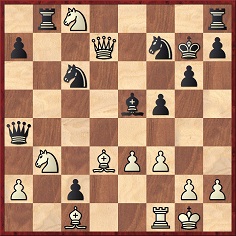
28 Nc5 Qb4 29 Ne6+ Kf6 30 Qxc6 Rbxc8 31 Nc7+ Kg7 32 Ne6+ Kf6 33 Nc7+ Kg7 34 Ne6+ Kh6 35 e4+ f4 36 Qd7 Qb6+ 37 Kh1 Qd6 38 Qxf7 Qxd3 39 Bxf4+ Kh5 40 g4+ Kh4 41 Bg3+ Bxg3 42 hxg3+ and Black resigned, with his pawn still on c2.
(3372)
Page 107 of Ideas modernas en las aperturas de ajedrez by S. Tartakower (we have the fifth edition, published in Buenos Aires in 1967) affirmed that the pawn formation e3-d4-c3 was known as ‘the Juncosa triangle’ in Spain and as ‘the Brake triangle’ in England. The reference to (José) Juncosa may be related to his advocacy of lines beginning with 1 c3, but what is the explanation for ‘Brake’?
(3392)
See too C.N. 3516 in Savielly Tartakower.
From Paul Valois (Leeds, England):
‘I have a copy of Kira Zvorykina’s autobiography Vryadakh shakhmatnoi gvardii (Minsk, 1984). She unsuccessfully challenged Bykova for the women’s world title in 1959, and the book contains a full and interesting account of the match, outlining the reasons for her defeat. But it also indicates that Zvorykina was married to Aleksei Suetin for some years. The following are the only passages relating to him in a personal way:
Page 35: “I missed the 14th USSR Women’s Championship, 1952 in Tbilisi for a very good reason: little Sasha Suetin demanded his mother’s presence.”
Page 57: “In 1953 my family and I – Suetins junior and senior – moved to Minsk.”
Page 61 (relating to the 15th USSR Women’s Championship, 1953, where competitors were forbidden to have their trainers with them): “A group of ‘curious’ people gathered outside my hotel room and listened intently to my telephone conversations with Suetin (he was on holiday in Sochi) … It did not occur to me that I had no right to make telephone calls … I had no adjourned games … I only complained to my husband about going wrong in the opening … The chief arbiter criticized me for receiving help over the telephone … warned me that I might be disqualified … I reacted simply, asking the hotel to disconnect my telephone.” [She won the tournament.]
Page 79 (regarding the Candidates’ Tournament, Moscow, 1955): “My trainer was the master M. Bonch-Osmolovsky, a Muscovite. … Suetin, who at this time was doing postgraduate study, playing in USSR Championships, writing a dissertation, was my consultant.”
There is nothing in the book about meeting him, marrying him (or divorcing him), but clearly they were husband and wife. Zvorykina has lived in Minsk ever since, but presumably Suetin moved to Moscow at some stage. According to the 1987 collection of Suetin’s games, he became Petrosian’s trainer in 1963 and in 1968 played in the Moscow Championship. The biographical summary in this book makes no reference to Zvorykina; nor do any of the reference books that I have looked at mention them as a couple. Does anyone have any more information about this relationship between two quite prominent chess persons?’
(3394)
As Michael Negele (Wuppertal, Germany) points out, chess reference books offer contradictory information about Sonja Graf’s date of birth. It is possible to find 15 February 1912, 15 May 1912, circa 1914 and 16 December 1914.
We have no solid information and can only report that in the 1994 (privately circulated) edition of Chess Personalia Jeremy Gaige gave ‘16-12-1914 BRD ???’ and mentioned that this was the date indicated on her death certificate.
(3408)
Scarcely better [than a book by Rogelio Caparrós on Capablanca] is a would-be reference book, Chess Results, 1747-1900 by G. Di Felice (Jefferson, 2004). Much can easily be written about its factual errors, but a more serious general defect is that the reader is offered no clue as to where a given crosstable or match chart came from. Incredibly, the ‘Sources’ amount to a single page (page 209), i.e. a bare list of books and other publications, such as ‘Chess’ and ‘Quebec Morning Chronicle’. No particulars are provided, and no link is made between such publications and any individual table in the book. In short, the ‘Sources’ page is worthless and so, in consequence, is much of the book for anyone wishing to check the information it provides.
(3594)
Such is Jeremy Gaige’s standing among chess cognoscenti that a lesser light may be eager somehow to out-Gaige him. G. Di Felice’s Preface to Chess Results, 1747-1900 states that the book contains more crosstables than Gaige’s Chess Tournament Crosstables, Volume 1 (Philadelphia, 1969) and so it does, but, of course, after 1969 Gaige continued to add to his archives, and at a remarkable rate. In 1984 he brought out a book of which Di Felice shows no awareness, Chess Tournaments A Checklist Vol. I 1851-1950. Tournaments for which Gaige then possessed the crosstable were marked in the checklist with an asterisk, and their number far exceeds those included in Di Felice’s book some two decades later. A sequel by Gaige, also published in 1984, dealt with tournaments from 1951 to 1980.
(3595)
Owen Hindle (Cromer, England) notes that on page 46 of Chess Results, 1747-1900 by Gino Di Felice (Jefferson, 2004) a participant in Paris, 1867 was identified as ‘Mingrelia of Dadian, Andrey’.
The player was, in fact, Baron d’André, about whom we should like to know more. Page lxii of the Paris, 1867 tournament book merely stated that he was born in Paris, while page 149 of La Stratégie, 15 July 1867 had a brief onlooker’s report from the tournament, by ‘Ernest Nivernais’ (the pseudonym of G. Demommerot):
‘Tout à l’extrémité de la salle, MM. le baron d’André et Rousseau sont aux prises. Le premier est le type achevé du gentilhomme français, toujours prêt à dire, comme à Fontenoy: Tirez les premiers, Messieurs les Anglais. La France compte peu de joueurs de sa force.’
Mr Hindle recalls that a small picture of Baron d’André appeared in the e4 square of Samuel Loyd’s ‘photographic chessboard’ presented in C.N. 3590.
(4988)
Wojtek Bartelski (Warsaw) asks for information about an event listed as follows on page 189 of Chess Results, 1921-1930 by Gino Di Felice (Jefferson, 2006):
‘BERLIN (GER), 1927 – Team Tourney
1. USSR pts. 27.5
2. Austria 21.5
3. Hungary 21
4. Denmark 16.5
5. Germany 13.5 .’
The book provides no specific source, but we can offer a report on page 137 of the May 1927 Deutsche Schachzeitung:
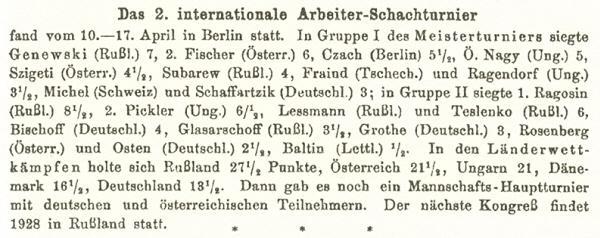
(5500)
From Rod Edwards (Victoria, BC, Canada):
‘Page 3 of Gino Di Felice’s Chess Results, 1747-1900 (Jefferson, 2004) lists a tournament at the “Cigar Divan” in London in 1840, suggesting by the numbering of the players that the (first?) four places were taken by Buckle, Bird, Williams and Tuckett, in that order. It is clear that there is an error here, at least in the date, since Bird was born in 1830. On page xii of his Chess History and Reminiscences (London, 1893) Bird wrote that he first visited Simpson’s Divan in 1846, and on page 23 of The Bristol Chess Club (Bristol, 1883) John Burt stated that Williams left Bristol for London in 1844.
The four players listed in Di Felice’s book all took part in the tournament at the Divan in London in 1849 (Chess Player’s Chronicle, 1849, pages 65-66 and 113) but did not finish in the order given in his book. However, page xii of Bird’s volume stated: “The earliest perfectly open tournaments were two on a small scale at Simpson’s in 1848 and 1849 ...”. While Bird’s memory was not always perfect, could the “London, 1840” tournament be the 1848 event referred to by Bird?’
Mr Di Felice’s book gave no source regarding the ‘London, 1840’ tournament. Indeed, it was not until the sixth volume of the series, covering 1941-46, that the need to state specific sources was recognized.
(5723)
Some tournaments deviated from the practice of awarding half a point for a draw. A notable example was Monte Carlo, 1901, and we quote from page 373 of the December 1900 issue of La Stratégie:
‘La première partie nulle comptera pour ¼ à chaque joueur et devra être rejouée; si l’un d’eux gagne la seconde elle lui sera comptée ¾ en tout; si elle est encore nulle chacun aura ½ point. Cette modification pour les nullités a été suggérée par M. le Dr E. Lasker.’
Or, as Jeremy Gaige summarized the system on page 171 of volume two of Chess Tournament Crosstables (Philadelphia, 1971):
‘Initial games, if drawn, counted ¼ and were replayed. If the replayed game was drawn, both players won another ¼. The winner of a replayed game received ½, the loser 0.’
The identical wording turned up on page 6 of Chess Results, 1901-1920 by Gino Di Felice (Jefferson, 2006).
In case of a draw at Monte Carlo, 1901 there was alternation of colours for the second game. See, for instance, A.J. Gillam’s booklet on the tournament (Nottingham, 1995) and, in particular, the discussion of the experimental scoring system on pages 67-70.
(6671)
Hayoung Wong (Bayside, NY, USA) sends the following:
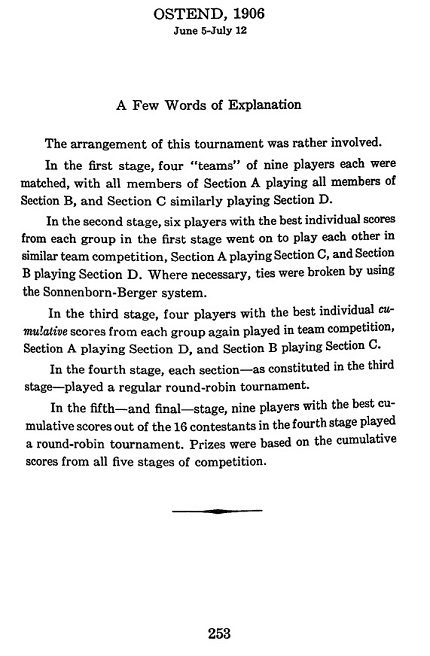
Page 253 of Chess Tournament Crosstables, volume two by Jeremy Gaige (Philadelphia, 1971)
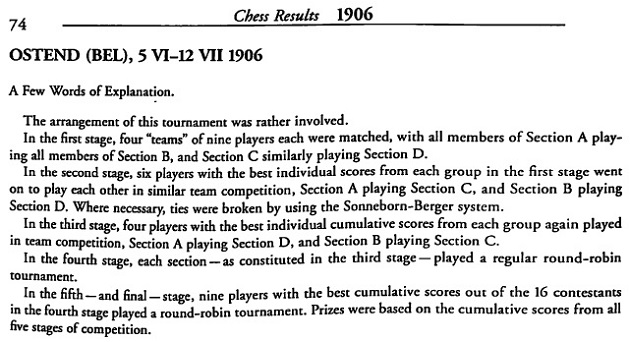
Page 74 of Chess Results, 1901-1920 by G. Di Felice, (Jefferson, 2006)
C.N. 6671 mentioned an earlier, briefer instance of duplication. The excellence of Gaige’s research has been acknowledged in the Preface to each book in the Di Felice series. C.N. 3594 criticized the absence of sources in the first volume, Chess Results, 1747-1900 (Jefferson, 2004), a defect corrected as from Chess Results, 1941-1946 (Jefferson, 2008).
(9739)
A source is helpful in this case, from page 291 of Chess Results, 1956-1960 (Jefferson, 2010):
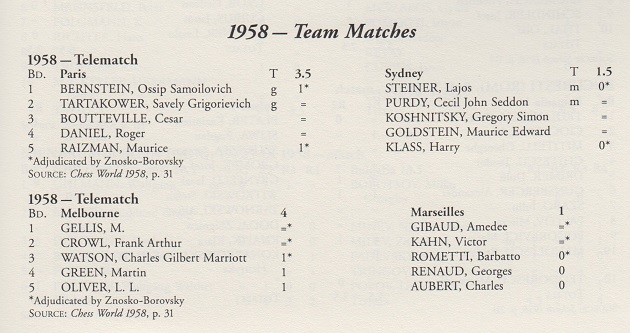
Below is what was published in the Australian magazine in 1958:
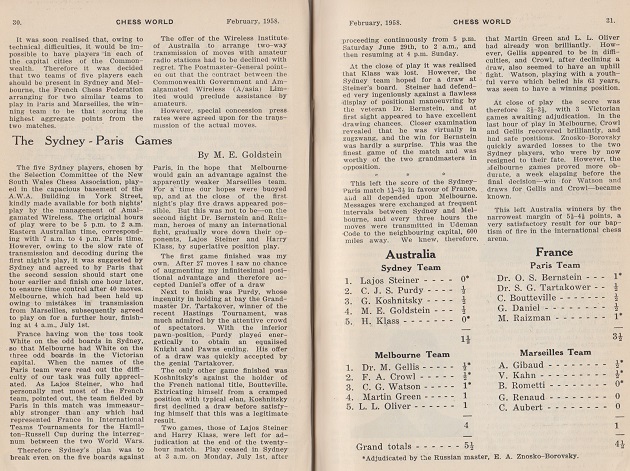
This was not a topical report but an historical article on matches played in 1946. Tartakower died in 1956.
(10072)
See also C.N.s 6450, 6563, 9881, 9887, 10571 and 11299.
Benoit Arsenault (Montreal, Canada) asks how many Russian books Ken Neat has translated into English. A further question will be whether any chess translator, past or present, has matched his tally.
(9184)
We raised the matter with Dr Neat in 1988, and his reply (C.N. 1716) was:
‘At the latest count it is 45, although this does not include those where I have revised an existing translation (often harder than starting from scratch!) or where my translation constitutes only part of a book.’
Do readers know of any magazines or websites which, systematically and comprehensively, produce authoritative reviews of new chess books?
‘Authoritative’ excludes all those easily pleased outlets making do with superficial impressions which could be written by virtually anybody. For example, a reviewer who praises The Joys of Chess by C. Hesse (Alkmaar, 2011), not realizing that it is unreliable and makes excessive, insufficiently credited use of earlier writers’ work, is unqualified to review books in, at the very least, that category. A reviewer of a new openings monograph needs proper knowledge of what has already been published on the same opening. A reviewer who imagines that all McFarland books (even the Steinitz biography by K. Landsberger) merit indiscriminate eulogies has no business publicly assessing works about chess history. Plaudits are deserved by many McFarland titles, but not all, and it is the critic’s task to make the requisite distinctions. A reviewer whose own volumes are notorious for blunders and other defects (plagiarism, for instance) should be neither reviewing nor authoring. Nor, of course, should any writer wish to quote favourable opinions received from such a reviewer. T. Harding rushing to cite R. Keene’s fulsome praise of his Blackburne book was a pathetic spectacle.
(9592)
In private e-mail messages, correspondents sometimes mention to us – and it is an increasing trend – their decision to discontinue subscribing to certain chess magazines. Such withdrawal of ‘support’ is often understandable, and we take this opportunity to ask readers to make no assumptions as to which periodicals we still see regularly.
One publication which, at least for now, we continue to acquire is the Quarterly for Chess History edited by Vlastimil Fiala. After a hiatus of nearly five years, issue 17, thicker than ever (634 pages), has just been published.
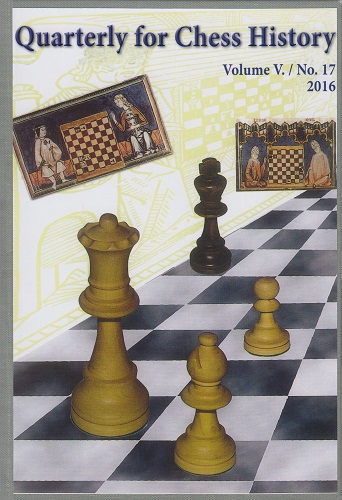
Indiscriminatingly elephantine, the Quarterly begins with a 90-page article on two years (1907-08) in the early career of F.D. Yates. The first line of the first paragraph misspells the name of the magazine itself, and the lack of a competent proof-reader and proper English-language reviser (problems left unresolved ever since the first issue was published, in 1999) is once again on show:

Another example is a paragraph about Morphy on page 323:
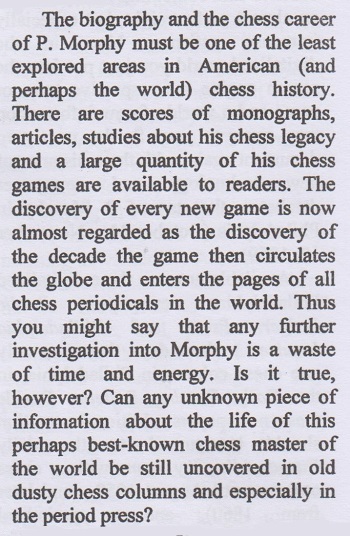
In the second line, ‘the least’ should presumably read ‘the most’, but there is still this to digest:
‘The discovery of every new game is now almost regarded as the discovery of the decade the game then circulates the globe and enters the pages of all chess periodicals in the world.’
Linguistic infelicities aside, such claims about the treatment of newly-discovered Morphy games bear no relation to reality.
Pages 524-525 unwisely give, from an 1867 newspaper, a supposed Rousseau v Conti game (see, however, Jean-Jacques Rousseau and Chess). In the Quarterly, even the title is mangled:

Pages 548-551 offer seven simultaneous games played by Samuel Rosenthal in Paris in 1874. Our selection of the best three, taken from La Stratégie, appeared in an article on pages 86-92 of the 7/1999 New in Chess (see A Forgotten Showman). The Quarterly misprints the source as ‘La Strategia’ in all seven game-scores.
A final example is the feature ‘Capablanca in Portland, April 1916’ on pages 408-413, which begins, ‘The following unknown games were played by Capablanca in Portland ...’ Four games are presented, but three of them have already been given in C.N.s 9366, 9371 and 9372. The remaining game appears as follows on pages 411-412 of the Quarterly:
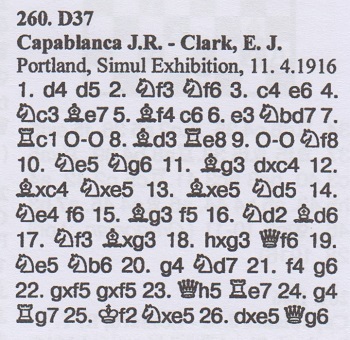
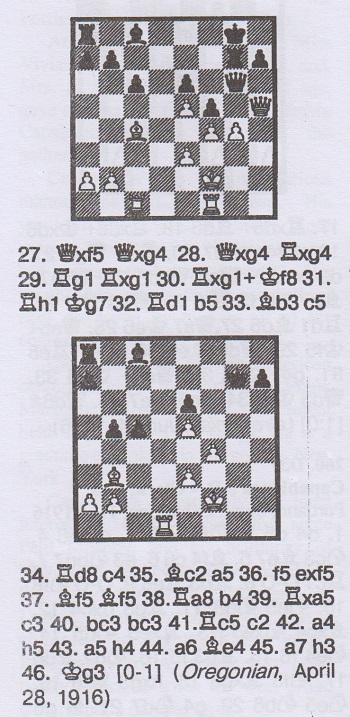
In reality:
1) The game is not unknown, having been given in, for instance, issue 689 of the Mechanics’ Institute Chess Club Newsletter (21 November 2014);
2) Black was Clarke, and not Clark;
3) The venue was San Francisco, and not Portland;
4) The result was 1-0, and not 0-1;
5) The game was published in the Sunday Oregonian of 28 May 1916 (page 3), and not 28 April 1916.
(10200)
Unperturbed by criticism (in, for instance, C.N. 10200), the Quarterly for Chess History has appeared again, as shambolic as ever.
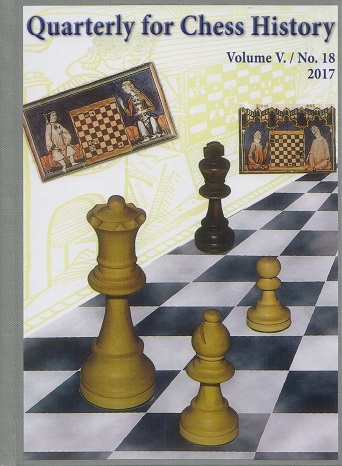
Issue 18 begins (pages 5-84) with the third part of Vlastimil Fiala’s series on F.D. Yates, taking the story all the way from July 1908 to May 1909. The Quarterly ends (pages 565-587, although pages 565-567 would have sufficed) with two book reviews, also by Fiala. Both volumes were published by McFarland, whose name is spelt three ways on page 580. The second book, published nine years ago, is different from the one billed on page 4, in the ‘Content’ [sic].
That same ‘Content’ page lists a section entitled ‘Corrections to Di Felice Chess Result’s [sic] Project’. That feature takes up nearly 30 pages, beginning on page 416 under the heading ‘Chess Reserach [sic]’ in large letters.
Immediately afterwards, Fiala, the Quarterly Editor (whose name appears 14 times in the ‘Content’ – alongside only four other contributors), provides a reminder of his own level of competence. From page 445:
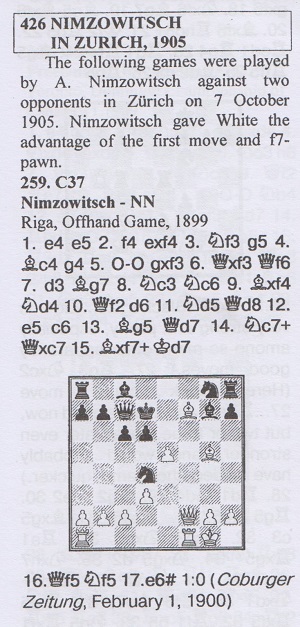
Despite the introductory word ‘games’, there is only one game-score. It was not played by Aron Nimzowitsch, or against two opponents, or in Zurich, or in 1905, or at odds.
The game, won by the master’s father, Schaie Niemzowitsch, was given in C.N. 683. As noted on page 52 of Kings, Commoners and Knaves, it was published on page 77 of Schachjahrbuch für 1899, II. Theil by Ludwig Bachmann:

The imprint page of issue 18 of the Quarterly for Chess History (printed in ‘February 2018’):
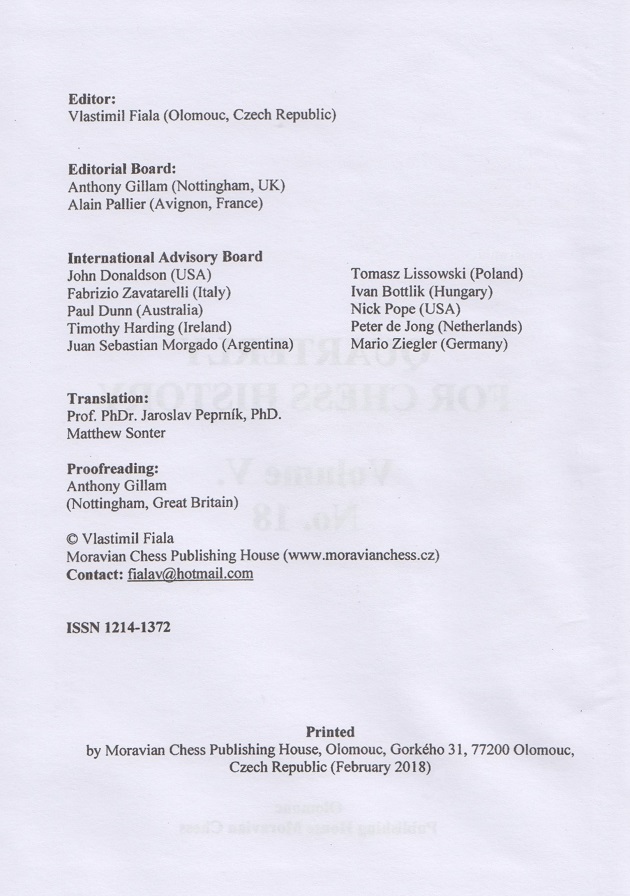
(10571)
Pages 563-571 of the latest edition (‘Spring 20/2019’) of the Quarterly for Chess History are devoted to a review-cum-demolition by the Editor, Vlastimil Fiala, of Vera Menchik by Robert B. Tanner (Jefferson, 2016). The final paragraph states that the book ‘should never have gone to print’.
As mentioned in C.N. 10191, the Menchik book is indeed very weak, but with his own track-record Vlastimil Fiala is an unsuitable person to complain, as he does on page 570, that it has ‘a large number of typos’. The review itself includes ‘J. Kaledovský’, ‘St Leonard’s’ (four times), ‘Bell’s of London Life’, ‘Sir G.H. Thomas’, ‘E. Eales’, ‘L’Echiquer’ (twice), ‘Hastings 19028/9’ and ‘Carslbad’.
Elsewhere, this new issue of the Quarterly contains, on pages 226-263, an article about Vienna, 1882 which refers to Berthold ‘English’, instead of Englisch, nine times. Pages 300-311 present some games played by Staunton in Scotland with the misspelling ‘Edinburg’ 12 times. On page 387 a game lost by Alekhine is dated ‘11.12.2930’. A sentence on page 420 refers to ‘Casablanca’ and ‘Miss M.T. Morra’.
(11232)
28 April 2016: An addition from our collection, following the death of Victor Gavrikov:
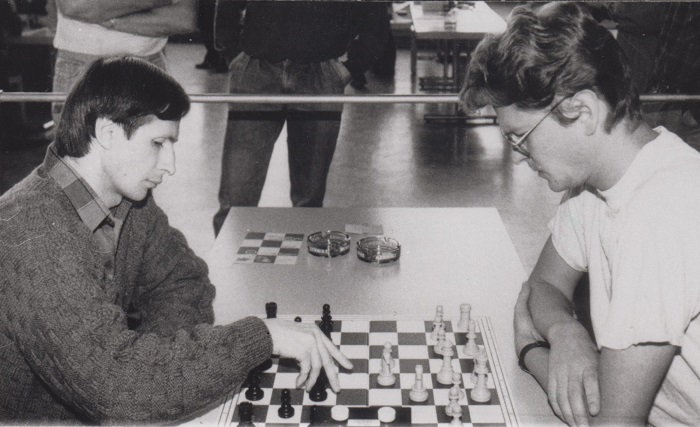
Victor Gavrikov and Roland Ekström (Schlieren, 1990)

A letter to us from D. Andrić dated 15 January 1986:
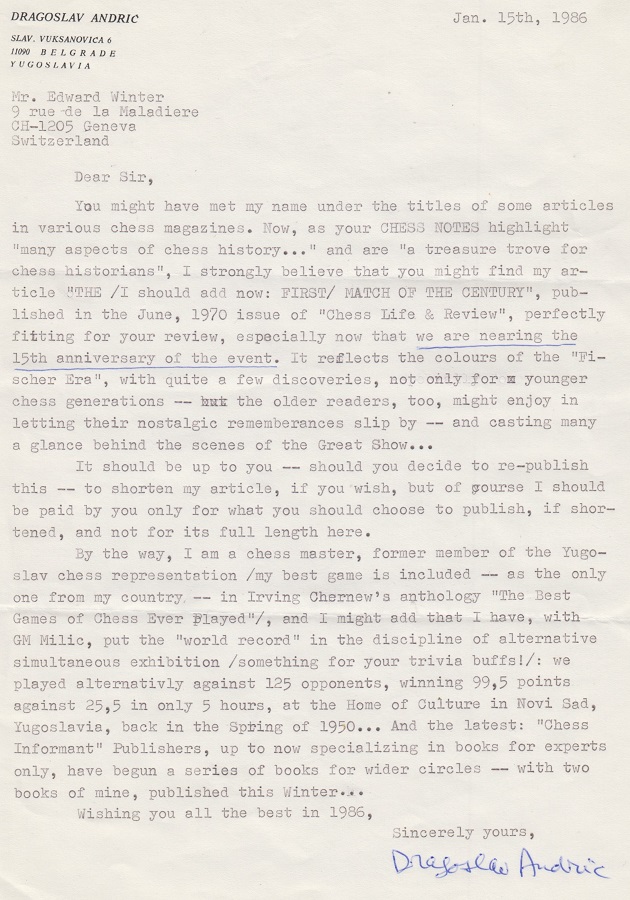
The solution to the Rautanen composition (C.N. 865 above) was given as follows in C.N. 912:
1. Rotate board 90° anti-clockwise (BK in check from WPb3) Kd5/d4
2. Rotate board 180° (BK in check from WPd3 or d4) Kf5
3. Rotate board 90° anti-clockwise (back to the original position, but now Black must move) e5
4. Rotate board 90° anti-clockwise (BK in check from WPb3 and BP now blocking d5). Mate.
The composition was described as ‘most extraordinary’ by B.P. Barnes; see pages 502-503 of The Problemist, January/February 1975.
Addition on 20 June 2024:
The privately circulated 1994 edition of Chess Personalia by Jeremy Gaige has this entry on the chess historian Joseph Abraham Leon:
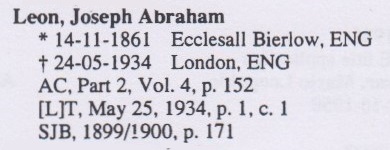
The notice of J.A. Leon’s death on page 1 of The Times, 25 May 1934:

Additional information readily available online includes the following from page 136 of The Eagle:
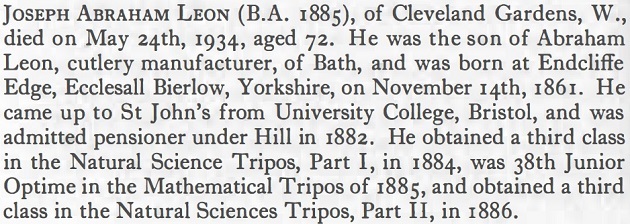
Addition on 7 January 2025:
From page 214 of The Inner Game by Dominic Lawson (London, 1993):

‘Those who say they understand chess, understand nothing.’
Did Robert Hübner ever make the same remark in writing?
Impassioned letters escalated into a plea that a chess magazine ‘should be banned (or burned - or both)’.
(12185)
After the first letter appeared in Kingpin, the magazine pointed out (in a box on page 23 of issue 16) that ‘Ida Eddis Foster, Newtown, Rochester’ is an anagram of ‘Edward Winter, Editor of Chess Notes’.
To the Chess Notes main page.
To the Archives for other feature articles.
Copyright: Edward Winter. All rights reserved.